Microsoft NKW-1X Dual-Band Tri-Mode Cellular Telephone User Manual Users guide
Microsoft Mobile Oy Dual-Band Tri-Mode Cellular Telephone Users guide
Contents
- 1. Users guide
- 2. Users Manual Revised
Users guide
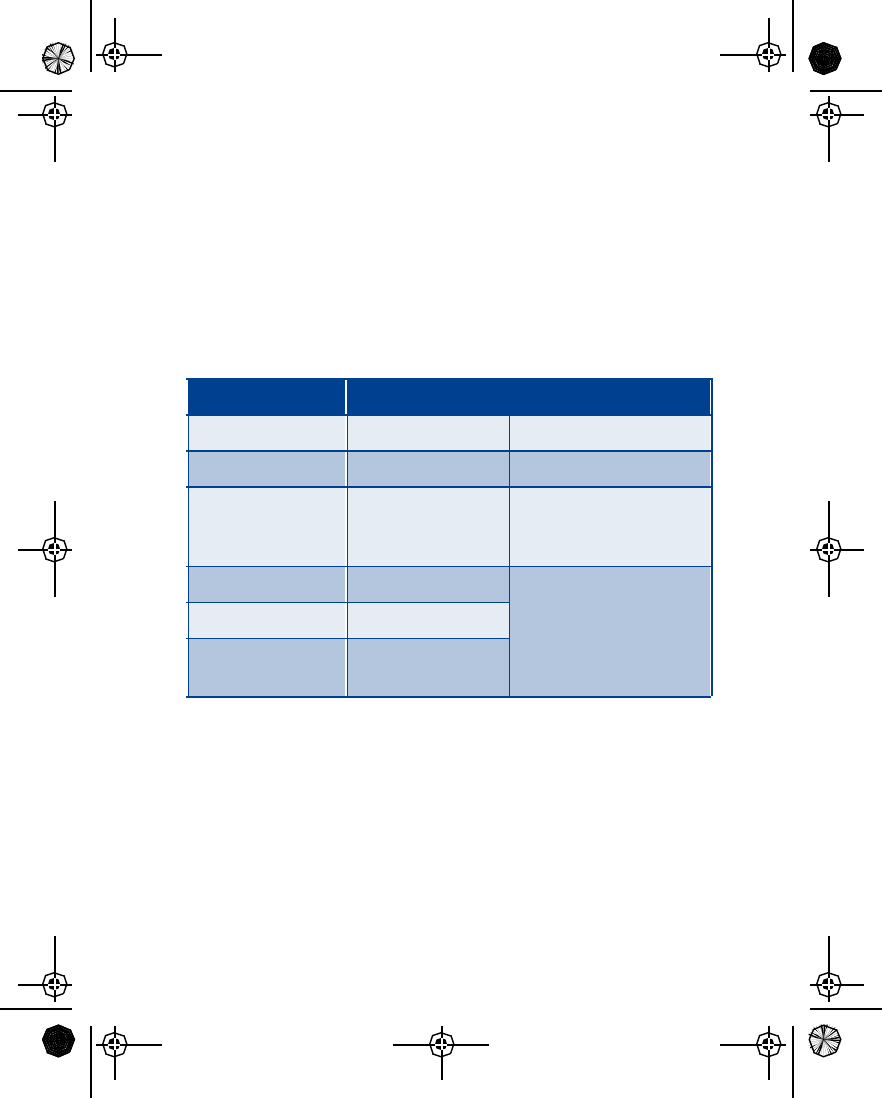
Nokia 1260
User Guide Draft
Phone notes
Notes Where to get information
My number Wireless service provider
Voice mail number
Wireless service
provider’s customer
care
Model number 1260
Type label. Located under
the battery.
Phone type NKW-1, NKW-1X
ESN (Electronic
serial number)
EN1260.2_Sept_02.book Page 1 Friday, September 6, 2002 4:39 PM
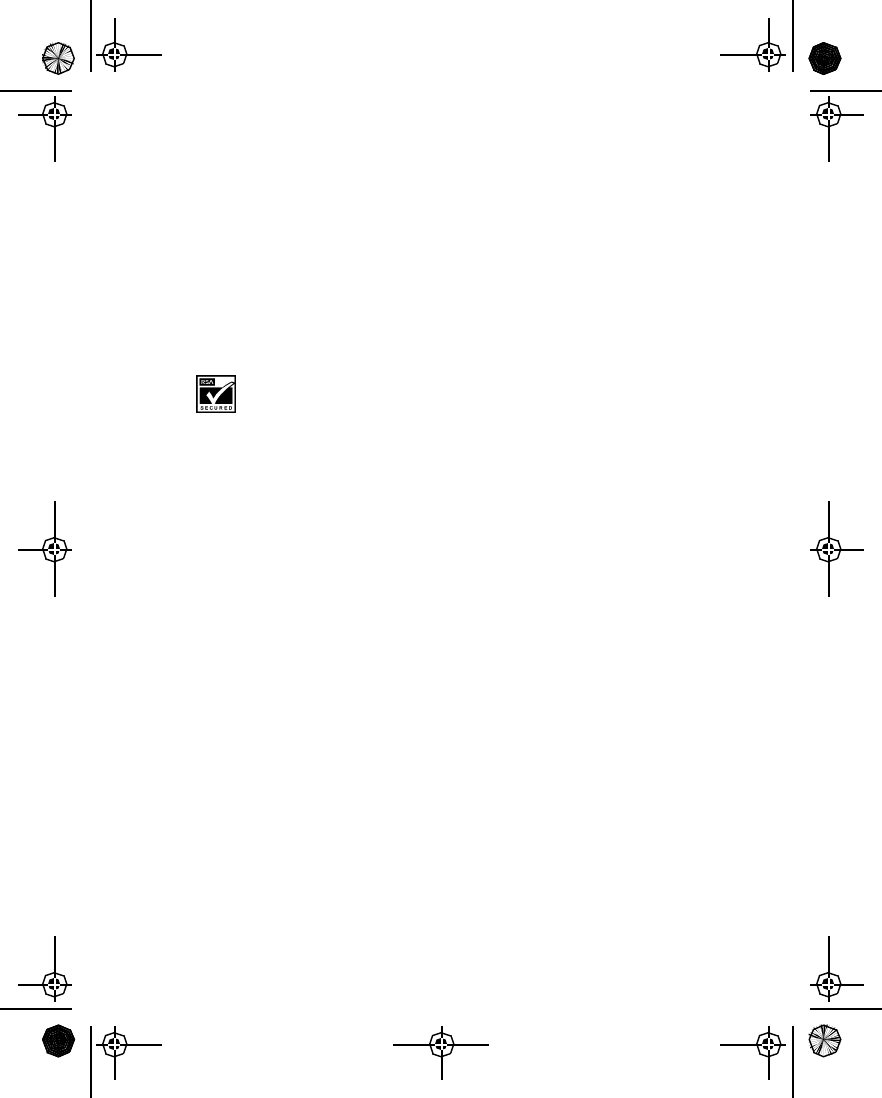
The wireless phone described in this guide is approved for use on the TDMA and
AMPS networks.
LEGAL INFORMATION
Part No. 9355371, Issue No. 2
Copyright ©2002 Nokia. All rights reserved.
Nokia, Nokia Connecting People, the Nokia Original Accessories logos, Nokia 1260,
Space Impact and Snake II are trademarks or registered trademarks of Nokia.
Printed in Canada 9/2002
US Patent No 5818437 and other pending patents.
T9 text input software Copyright ©1999-2002. Tegic Communications, Inc. All
rights reserved.
Includes RSA BSAFE cryptographic or security protocol software from
RSA Security.
The information contained in this user guide was written for the Nokia 1260 phone.
Nokia operates a policy of continuous development. Nokia reserves the right to
make changes and improvements to any of the products described in this
document without prior notice
UNDER NO CIRCUMSTANCES SHALL NOKIA BE RESPONSIBLE FOR ANY LOSS OF
DATA OR INCOME OR ANY SPECIAL, INCIDENTAL, AND CONSEQUENTIAL OR
INDIRECT DAMAGES HOWSOEVER CAUSED.
THE CONTENTS OF THIS DOCUMENT ARE PROVIDED “AS IS.” EXCEPT AS REQUIRED
BY APPLICABLE LAW, NO WARRANTIES OF ANY KIND, EITHER EXPRESS OR IMPLIED,
INCLUDING, BUT NOT LIMITED TO, THE IMPLIED WARRANTIES OF
MERCHANTABILITY AND FITNESS FOR A PARTICULAR PURPOSE, ARE MADE IN
RELATION TO THE ACCURACY AND RELIABILITY OR CONTENTS OF THIS DOCUMENT.
NOKIA RESERVES THE RIGHT TO REVISE THIS DOCUMENT OR WITHDRAW IT AT ANY
TIME WITHOUT PRIOR NOTICE.
EXPORT CONTROLS
This product contains commodities, technology or software exported from the
United States in accordance with the Export Administration regulations. Diversion
contrary to U.S. law is prohibited.
FCC/INDUSTRY CANADA NOTICE
Your phone may cause TV or radio interference (for example, when using a
telephone in close proximity to receiving equipment). The FCC or Industry Canada
can require you to stop using your telephone if such interference cannot be
eliminated. If you require assistance, contact your local service facility. This device
complies with part 15 of the FCC rules. Operation is subject to the condition that
this device does not cause harmful interference.
EN1260.2_Sept_02.book Page 2 Friday, September 6, 2002 4:39 PM
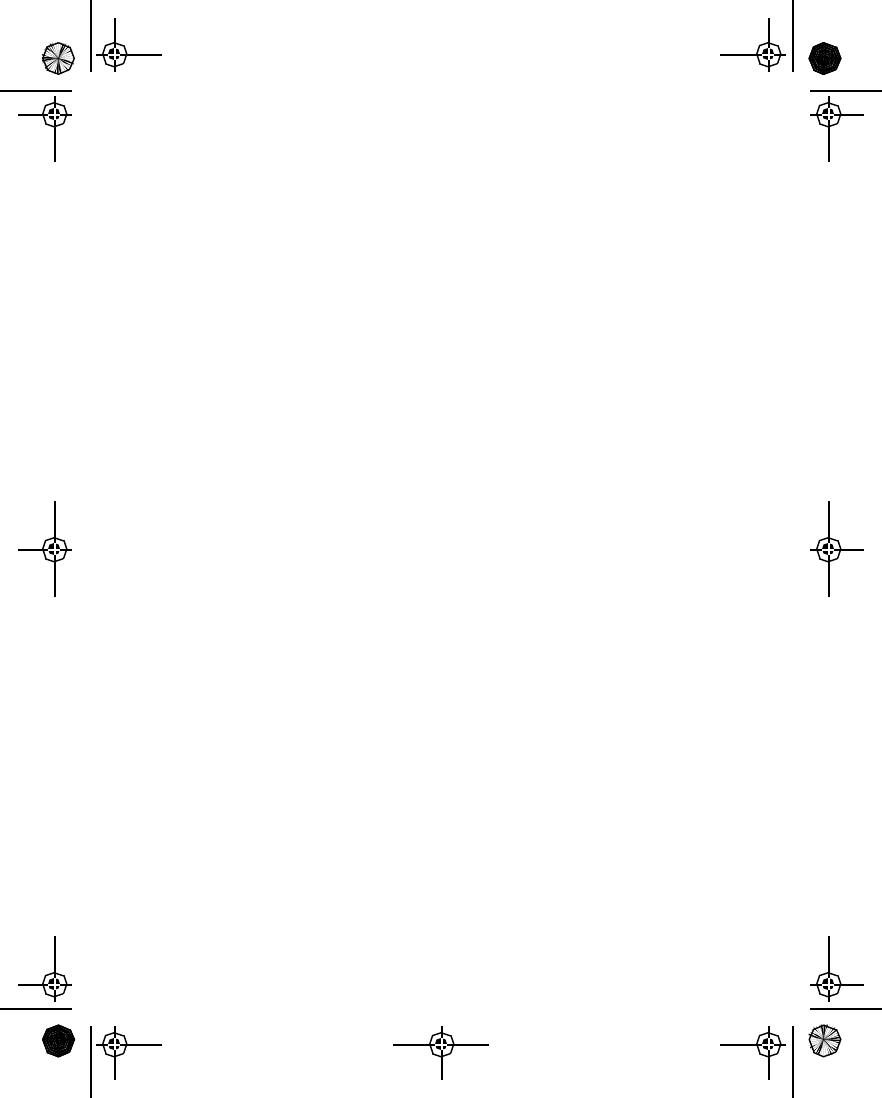
[ i ]
Contents
1Safety first . . . . . . . . . . . . . . . . . . . . . . . . . . . . . . . . . . . . 1
2Welcome and quick guide . . . . . . . . . . . . . . . . . . . . . . . . . 3
Get the most out of this guide . . . . . . . . . . . . . . . . . . . . . . . . . . .3
Understand wireless network services . . . . . . . . . . . . . . . . . . . . .6
Register your phone . . . . . . . . . . . . . . . . . . . . . . . . . . . . . . . . . . . .6
E-newsletters . . . . . . . . . . . . . . . . . . . . . . . . . . . . . . . . . . . . . . . . .6
Understand your phone . . . . . . . . . . . . . . . . . . . . . . . . . . . . . . . . .7
Set up your headset . . . . . . . . . . . . . . . . . . . . . . . . . . . . . . . . . . 12
Get started with the quick guide. . . . . . . . . . . . . . . . . . . . . . . . 13
Get help . . . . . . . . . . . . . . . . . . . . . . . . . . . . . . . . . . . . . . . . . . . . 14
3Basic operations . . . . . . . . . . . . . . . . . . . . . . . . . . . . . . . 18
Switch your phone ON or OFF . . . . . . . . . . . . . . . . . . . . . . . . . . 18
Make and answer calls. . . . . . . . . . . . . . . . . . . . . . . . . . . . . . . . 18
Check the Start screen. . . . . . . . . . . . . . . . . . . . . . . . . . . . . . . . 20
Use the selection keys . . . . . . . . . . . . . . . . . . . . . . . . . . . . . . . . 23
Scroll keys . . . . . . . . . . . . . . . . . . . . . . . . . . . . . . . . . . . . . . . . . . 23
Check in-phone help . . . . . . . . . . . . . . . . . . . . . . . . . . . . . . . . . 23
Browse phone menus. . . . . . . . . . . . . . . . . . . . . . . . . . . . . . . . . 24
Phone book menu. . . . . . . . . . . . . . . . . . . . . . . . . . . . . . . . . . . . 29
4Text entry . . . . . . . . . . . . . . . . . . . . . . . . . . . . . . . . . . . . 30
Standard text input . . . . . . . . . . . . . . . . . . . . . . . . . . . . . . . . . . 30
Enter spaces, punctuation and special characters. . . . . . . . . . 32
Write with predictive text . . . . . . . . . . . . . . . . . . . . . . . . . . . . . 34
5Phone book. . . . . . . . . . . . . . . . . . . . . . . . . . . . . . . . . . . 37
Use phone book menus . . . . . . . . . . . . . . . . . . . . . . . . . . . . . . . 37
Save names, numbers and e-mail addresses . . . . . . . . . . . . . . 38
Recall names and numbers . . . . . . . . . . . . . . . . . . . . . . . . . . . . 39
Edit a name or number. . . . . . . . . . . . . . . . . . . . . . . . . . . . . . . . 39
EN1260.2_Sept_02.book Page i Friday, September 6, 2002 4:39 PM
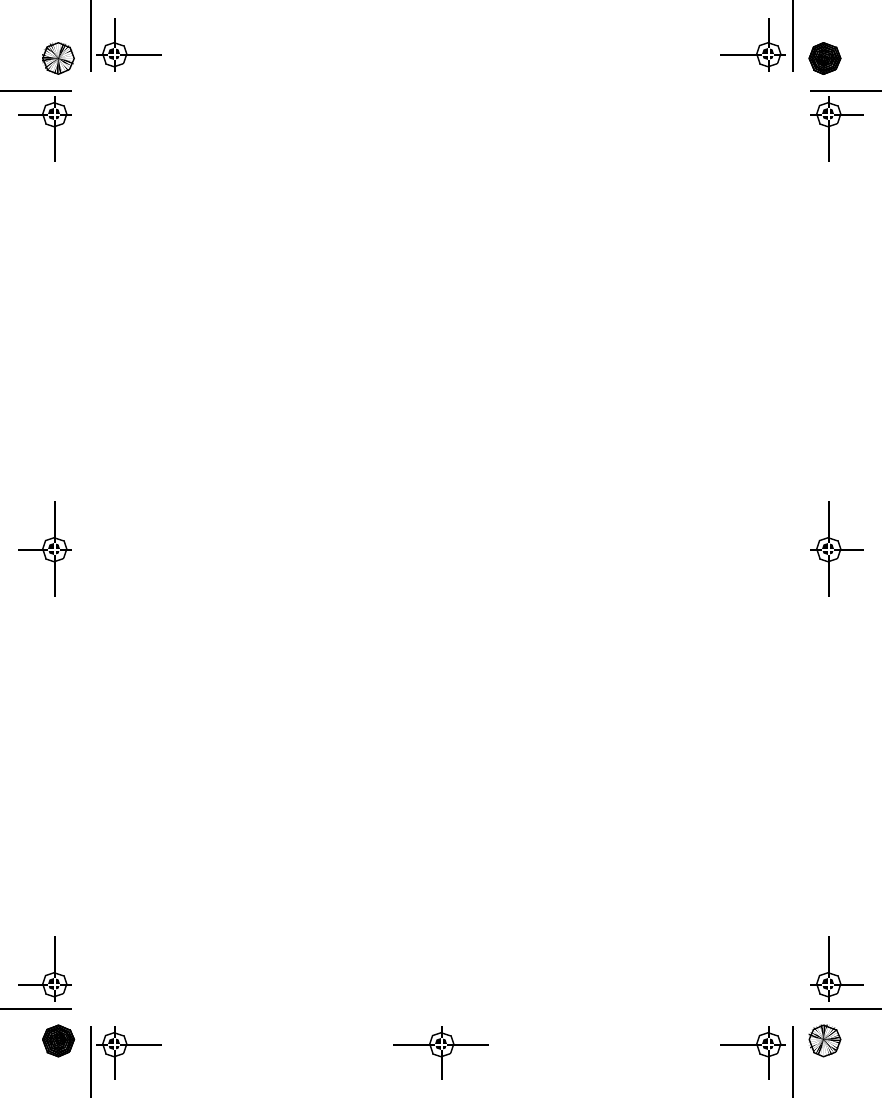
[ ii ]
Erase names and numbers . . . . . . . . . . . . . . . . . . . . . . . . . . . . . .40
Customize your phone book view . . . . . . . . . . . . . . . . . . . . . . . .40
Check memory status . . . . . . . . . . . . . . . . . . . . . . . . . . . . . . . . . .41
6Call log. . . . . . . . . . . . . . . . . . . . . . . . . . . . . . . . . . . . . . .42
Call log options. . . . . . . . . . . . . . . . . . . . . . . . . . . . . . . . . . . . . . .42
Check missed calls . . . . . . . . . . . . . . . . . . . . . . . . . . . . . . . . . . . .43
Check received calls . . . . . . . . . . . . . . . . . . . . . . . . . . . . . . . . . . .43
Check dialed calls . . . . . . . . . . . . . . . . . . . . . . . . . . . . . . . . . . . . .44
Use call timers . . . . . . . . . . . . . . . . . . . . . . . . . . . . . . . . . . . . . . .45
7Messages . . . . . . . . . . . . . . . . . . . . . . . . . . . . . . . . . . . . .47
Voice mail . . . . . . . . . . . . . . . . . . . . . . . . . . . . . . . . . . . . . . . . . . .47
Text, e-mail and picture messages . . . . . . . . . . . . . . . . . . . . . . .49
Text messages. . . . . . . . . . . . . . . . . . . . . . . . . . . . . . . . . . . . . . . .51
Picture messages . . . . . . . . . . . . . . . . . . . . . . . . . . . . . . . . . . . . .54
E-mail messages. . . . . . . . . . . . . . . . . . . . . . . . . . . . . . . . . . . . . .56
8Personalization. . . . . . . . . . . . . . . . . . . . . . . . . . . . . . . . .59
Profiles. . . . . . . . . . . . . . . . . . . . . . . . . . . . . . . . . . . . . . . . . . . . . .59
9Advanced calling features. . . . . . . . . . . . . . . . . . . . . . . . .68
Understand active-call options. . . . . . . . . . . . . . . . . . . . . . . . . .68
Use voice privacy . . . . . . . . . . . . . . . . . . . . . . . . . . . . . . . . . . . . .71
Use call forwarding . . . . . . . . . . . . . . . . . . . . . . . . . . . . . . . . . . .72
Use call waiting . . . . . . . . . . . . . . . . . . . . . . . . . . . . . . . . . . . . . .73
Use send own caller ID. . . . . . . . . . . . . . . . . . . . . . . . . . . . . . . . .74
Select a phone number . . . . . . . . . . . . . . . . . . . . . . . . . . . . . . . .75
Use automatic redial . . . . . . . . . . . . . . . . . . . . . . . . . . . . . . . . . .76
Use 1-touch dialing . . . . . . . . . . . . . . . . . . . . . . . . . . . . . . . . . . .77
Set touch tone strings . . . . . . . . . . . . . . . . . . . . . . . . . . . . . . . . .78
Select a system. . . . . . . . . . . . . . . . . . . . . . . . . . . . . . . . . . . . . . .80
EN1260.2_Sept_02.book Page ii Friday, September 6, 2002 4:39 PM

[ iii ]
10 Security . . . . . . . . . . . . . . . . . . . . . . . . . . . . . . . . . . . . . 81
Use Keyguard . . . . . . . . . . . . . . . . . . . . . . . . . . . . . . . . . . . . . . . 81
Understand the security code . . . . . . . . . . . . . . . . . . . . . . . . . . 82
Restrict calls . . . . . . . . . . . . . . . . . . . . . . . . . . . . . . . . . . . . . . . . 83
11 Special features . . . . . . . . . . . . . . . . . . . . . . . . . . . . . . . 85
Use the alarm clock . . . . . . . . . . . . . . . . . . . . . . . . . . . . . . . . . . 85
Send and receive business cards. . . . . . . . . . . . . . . . . . . . . . . . 86
Download a ringing tone . . . . . . . . . . . . . . . . . . . . . . . . . . . . . . 87
12 Prepaid services. . . . . . . . . . . . . . . . . . . . . . . . . . . . . . . . 89
Manage prepaid service . . . . . . . . . . . . . . . . . . . . . . . . . . . . . . . 89
Check your prepaid balance. . . . . . . . . . . . . . . . . . . . . . . . . . . . 90
Add money to your account. . . . . . . . . . . . . . . . . . . . . . . . . . . . 90
Call customer service . . . . . . . . . . . . . . . . . . . . . . . . . . . . . . . . . 91
Save your access numbers . . . . . . . . . . . . . . . . . . . . . . . . . . . . . 91
Expiration date . . . . . . . . . . . . . . . . . . . . . . . . . . . . . . . . . . . . . . 92
13 Games. . . . . . . . . . . . . . . . . . . . . . . . . . . . . . . . . . . . . . . 93
Start a new game . . . . . . . . . . . . . . . . . . . . . . . . . . . . . . . . . . . . 93
Snake II . . . . . . . . . . . . . . . . . . . . . . . . . . . . . . . . . . . . . . . . . . . . 94
Space impact. . . . . . . . . . . . . . . . . . . . . . . . . . . . . . . . . . . . . . . . 94
Pairs II . . . . . . . . . . . . . . . . . . . . . . . . . . . . . . . . . . . . . . . . . . . . . 95
14 Reference information . . . . . . . . . . . . . . . . . . . . . . . . . . 96
Battery statements . . . . . . . . . . . . . . . . . . . . . . . . . . . . . . . . . . . 96
Proper care and maintenance . . . . . . . . . . . . . . . . . . . . . . . . . . 97
Important safety information . . . . . . . . . . . . . . . . . . . . . . . . . . 98
Make emergency calls . . . . . . . . . . . . . . . . . . . . . . . . . . . . . . . 102
Certification information (SAR). . . . . . . . . . . . . . . . . . . . . . . . 103
Accessory safety . . . . . . . . . . . . . . . . . . . . . . . . . . . . . . . . . . . . 105
Accessories . . . . . . . . . . . . . . . . . . . . . . . . . . . . . . . . . . . . . . . . 108
EN1260.2_Sept_02.book Page iii Friday, September 6, 2002 4:39 PM

[ iv ]
Frequently Asked Questions. . . . . . . . . . . . . . . . . . . . . . . . . . . 115
Glossary. . . . . . . . . . . . . . . . . . . . . . . . . . . . . . . . . . . . . . . . . . . 118
Technical information . . . . . . . . . . . . . . . . . . . . . . . . . . . . . . . 120
Troubleshooting . . . . . . . . . . . . . . . . . . . . . . . . . . . . . . . . . . . . 121
Warranty information . . . . . . . . . . . . . . . . . . . . . . . . . . . . . . . 122
Appendix A
Message from the CTIA to all users of mobile phones . . . . . 129
Appendix B
Message from the FDA to all users of mobile phones. . . . . . .133
Index . . . . . . . . . . . . . . . . . . . . . . . . . . . . . . . . . . . . . . . . . . . . . 139
EN1260.2_Sept_02.book Page iv Friday, September 6, 2002 4:39 PM
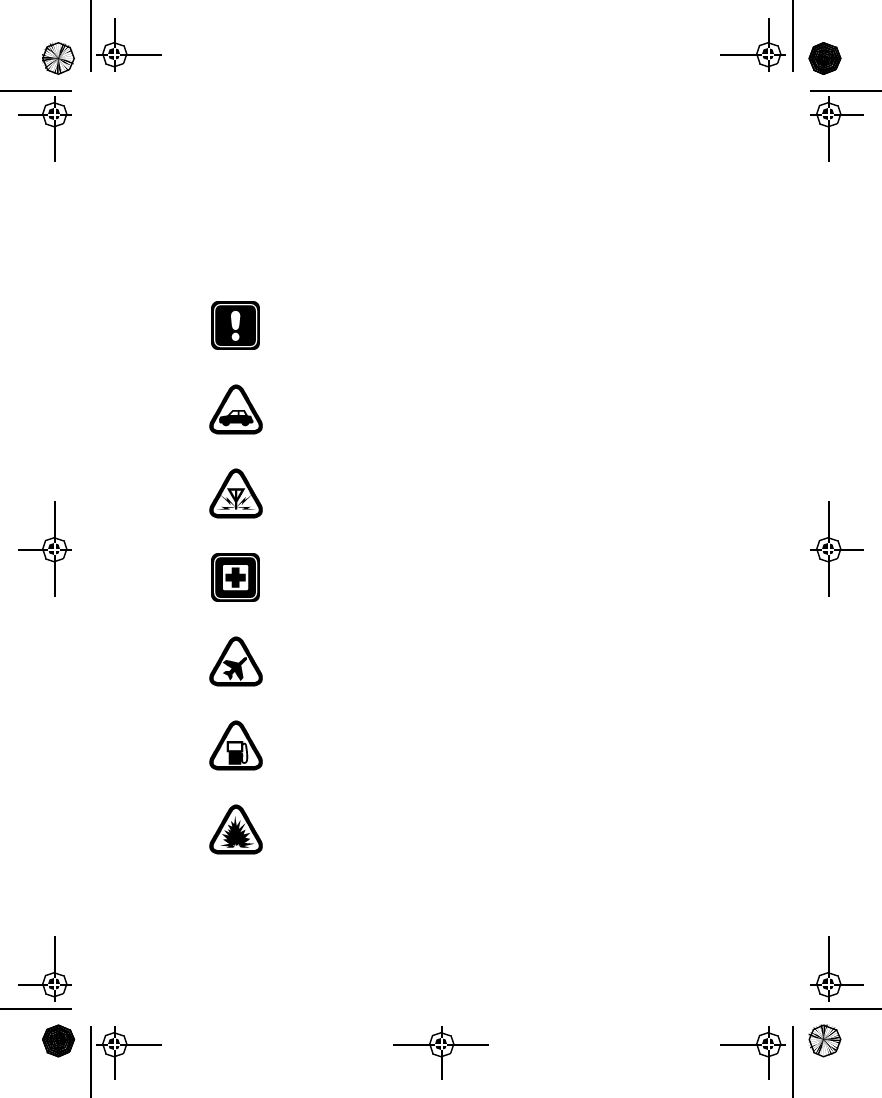
[ 1 ]
Safety first
1Safety first
Read these simple guidelines before you use your phone. Failure to comply
with these guidelines may be dangerous or illegal. See “Important safety
information” on page98 for detailed information.
Switch off where prohibited
Do not switch on the phone when wireless phone use is
prohibited or when it may cause interference or danger.
Road safety comes first
Don't use a hand-held phone while driving.
Interference
All wireless phones may get interference, which could affect
performance.
Switch off in hospitals
Follow any regulations or rules. Switch the phone off near
medical equipment.
Switch off in aircraft
Wireless devices can cause interference in aircraft.
Switch off when refueling
Don't use the phone at a refueling point. Don't use near fuel or
chemicals.
Switch off near blasting
Don't use the phone where blasting is in progress. Observe
restrictions, and follow any regulations or rules.
EN1260.2_Sept_02.book Page 1 Friday, September 6, 2002 4:39 PM

[ 2 ]
Use sensibly
Use only in the normal position. Don't touch the antenna
unnecessarily.
Qualified service
Only qualified personnel may install or repair phone equipment.
Accessories and batteries
Use only approved accessories and batteries. Do not connect
incompatible products.
Water-resistance
Your wireless phone is not water-resistant. Keep it dry.
Calling
Ensure the phone is switched on and in service. Enter the phone
number, including the area code, then press . To end a call,
press . To answer a call, press .
Emergency calls
Ensure the phone is switched on and in service. Press as
many times as needed (for example, to exit a call, to exit a
menu) to clear the display. Enter the emergency number, then
press . Give your location. Do not end the call until told to
do so.
EN1260.2_Sept_02.book Page 2 Friday, September 6, 2002 4:39 PM

[ 3 ]
Welcome and quick guide
2Welcome and quick guide
Congratulations on your purchase of a Nokia
mobile phone, a new tool for the mobile
information society.
Before you begin, you need to prepare your
phone by charging the battery and learning how
to maintain it. This chapter tells you how to set
up your phone. You will also find useful information about:
•How to use this guide
•How to understand network services
•How to contact Nokia
• GET THE MOST OUT OF THIS GUIDE
The tips that follow can help you get the most from this guide as you learn
to use your phone.
Understand the terms
This guide provides instructions for certain actions.
•Press means to briefly press and release a key. For example,
press means press the zero key for 1 second and release.
•Press and hold means to press and hold a key for 1 to 3 seconds
(depending on the feature being used), then release the key.
•Press Menu means to press (the selection key), located below
the word Menu on the phone’s screen.
•Highlighted means that an option on the screen is enclosed in a black
box. When an option is highlighted, it can be activated by pressing
.
EN1260.2_Sept_02.book Page 3 Friday, September 6, 2002 4:39 PM
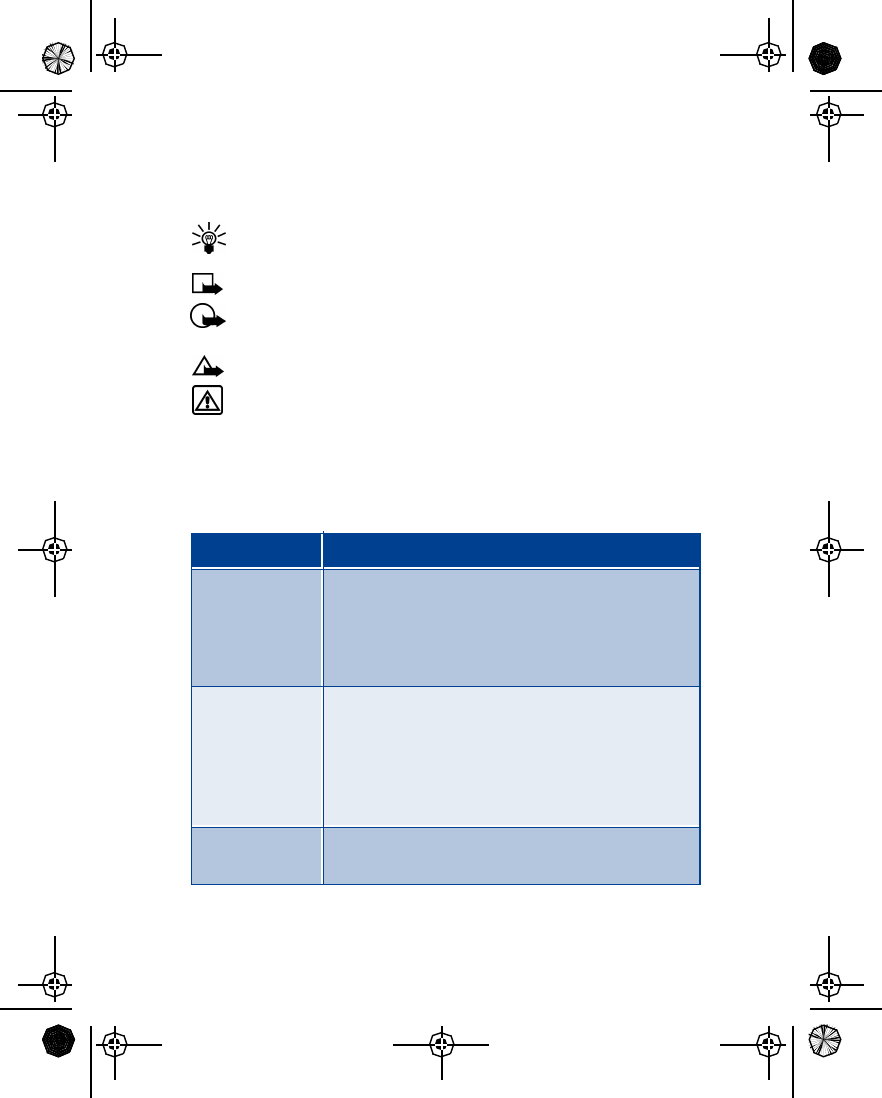
[ 4 ]
Follow graphic clues
This guide uses the following icons to alert you to important information.
Tip: Provides information about a quick way or an alternate
method for performing an action.
Note: Explains a feature or points out an important concept.
Important: Alerts you to information critical to using a feature
correctly.
Caution: Warns you when you may lose information.
Warning: Helps you avoid personal injury, damage to the phone,
or property damage.
Learn text conventions
This user guide provides text clues to help make instructions clear and
easy to follow. These clues are called conventions.
Convention What it means
bold Indicates one of the following items:
•The word or phrase appears on the phone’s
screen.
•Special text such as Notes and Warnings.
bold and blue Indicates one of the following items:
•The word is an address on the World Wide
Web.
•A definition for the word or phrase appears
in the glossary.
italic Italics indicate emphasis. Pay close attention to any
information in italics.
EN1260.2_Sept_02.book Page 4 Friday, September 6, 2002 4:39 PM

[ 5 ]
Welcome and quick guide
Access alternate formats
To request a user guide in one of the following alternate formats, call the
Nokia Customer Care Center:
•Braille
•Large print
•Audiocassette
•E-text (3.5-inch disk in Microsoft Word or WordPerfect)
Note: Alternate format user guides are available in English.
Look for updates
From time to time, Nokia may update this user guide to reflect changes
or corrections. The latest version may be available at the Nokia site on the
internet at
www.nokia.com
An interactive user guide that provides step-by-step instructions for any
of your phone features is available at
www.nokiahowto.com
Nokia Customer Care Center, USA TTY/TDD Users Only
Tel: 1-888-NOKIA-2U
(1-888-665-4228)
Fax: 1-813-249-9619
Tel: 1-800-24-NOKIA
(1-888-246-6542)
EN1260.2_Sept_02.book Page 5 Friday, September 6, 2002 4:39 PM

[ 6 ]
• UNDERSTAND WIRELESS NETWORK SERVICES
A number of features included in this guide are called Network Services.
These are special services you arrange through your wireless service
provider. Before you can take advantage of any of these Network Services,
you must subscribe to them through your service provider and obtain
instructions for their use from your service provider.
Note: Some networks may not support all language-dependent
characters and/or services.
Network services for your Nokia phone include:
•Voice mail and voice privacy
•Call waiting, call forwarding and caller ID
•Text and picture messages
•Ability to send your own number
Sign up with a service provider
Before you can use any network services, you must sign up with a wireless
service provider. Your service provider will supply descriptions of special
features and instructions for using their services.
• REGISTER YOUR PHONE
Make sure to register your phone at www.warranty.nokiausa.com or
1-888-NOKIA-2U (1-888-665-4228) so that we can serve your needs
better if you should need to call the center or have your phone repaired.
• E-NEWSLETTERS
When you register your phone, you can sign up for Nokia's e-newsletter
Nokia Connections if you would like. You will receive tips and tricks on
using your phone, accessory information, and special offers.
EN1260.2_Sept_02.book Page 6 Friday, September 6, 2002 4:39 PM

[ 7 ]
Welcome and quick guide
• UNDERSTAND YOUR PHONE
This section offers an illustrated view of your phone to help familiarize
you with its keypad, connection port and power key.
Talk key
Screen
Up scroll key
Down scroll key
Left selection key
Nibs key
End key
Microphone
Power key
Keypad
Earpiece
Connection port
Right selectionkey
EN1260.2_Sept_02.book Page 7 Friday, September 6, 2002 4:39 PM

[ 8 ]
Use the antenna
Tip: Your phone has a built-in antenna. As
with any other radio transmitting device,
do not touch the antenna unnecessarily
when the phone is switched on.
Contact with the antenna
affects call quality and may cause the phone to
operate at a higher power level than otherwise
needed.
Not touching the antenna area during a phone call
optimizes the antenna performance and the talk-time
of your phone. Normal position: Hold the phone as you
would any other telephone with the antenna pointed
up and over your shoulder.
Install and remove the battery
This section tells you how to install and remove the battery. You will need
to remove the battery when replacing it, or to view the phone’s label
(located under the battery).
INSTALL THE BATTERY
1Place the battery in the
compartment with the label
side facing up and the golden
contact area of the battery
aligned with the contact
prongs inside the phone.
2Press down on the battery
until it snaps into place.
1
2
EN1260.2_Sept_02.book Page 8 Friday, September 6, 2002 4:39 PM

[ 9 ]
Welcome and quick guide
3Align the cover over the back
of the phone, placing the end
of the cover approximately 1/4
inch past the end of the phone.
Lower the back cover onto the
phone.
4Press down slightly and slide
the cover until it locks into
place.
REMOVE THE BATTERY
If you purchase a new battery or need to access information on the
phone’s label, you may need to remove the battery.
Important: Dispose of batteries according to applicable local
regulations (for example, recycling). Do not dispose as household
waste.
1Hold the phone with the back
facing you. At the bottom corners
of the phone, press the battery
cover with your thumb and
forefinger.
2Place the thumb of your other
hand in the grove, approximately 1
inch from the top of the phone.
Apply pressure with the thumb
and slide the back cover toward you to release it, then remove it.
1/4 inch
Bottom of
phone
EN1260.2_Sept_02.book Page 9 Friday, September 6, 2002 4:39 PM
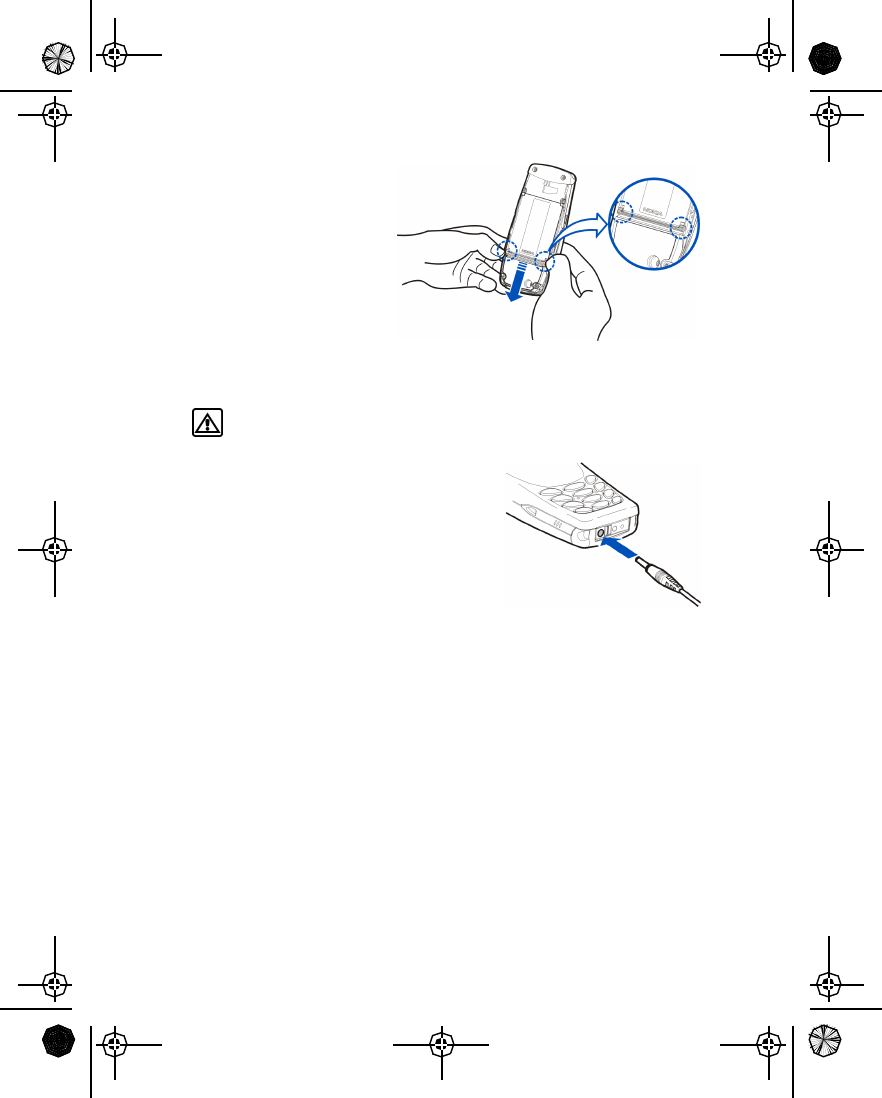
[ 10 ]
3Look for the battery latch
that runs along the end of
the battery nearest the
top of the phone.
4Place your thumbs on the
corners of the latch and
press away from the
battery.
5Once the battery is released from the latch, it will lift slightly so that
it can be removed from the phone.
Warning: Use only your hands to remove the battery. Do not use
any objects that may damage the phone or the battery.
Charge the battery
Before you begin, you need to prepare your
phone by charging the battery.
1Plug the charger into a standard wall
outlet, then connect the lead from the
charger to the bottom of the phone.
2The battery power indicator (or battery
bar) appears on the screen and starts scrolling. If the phone is on,
Charging appears also.
3When the battery bar stops scrolling, the battery charge is complete.
Battery full appears also, if the phone is on.
4Disconnect the charger from the phone.
EN1260.2_Sept_02.book Page 10 Friday, September 6, 2002 4:39 PM

[ 11 ]
Welcome and quick guide
IMPORTANT BATTERY INFORMATION
Use the following guidelines to obtain the best performance from your
battery:
•With your phone turned off, charge your new battery for three hours
before its first use. Use the battery until it is fully discharged. Repeat
this procedure twice for a total of three charging cycles.
•Battery operation time may be less than the estimated times during
the first charges. This condition is normal.
•If the battery is fully discharged, the scrolling bars may not appear
immediately when charging.
•After the first charge, you can make and receive calls during the
charging cycle, but the calls interrupt the charge. When the phone
call ends, the charge will resume.
•The bars on the screen stop scrolling and remain constant when the
phone is charged. If you leave the phone connected to the charger,
the battery receives an additional charge.
Note: The battery will accept a “trickle charge” for an additional
two hours. See “Reference information” on page96 for more
information on batteries.
•Charging time depends on the charger and battery used. See “Batteries”
on page106 for charging, talk, and standby times.
PROLONG BATTERY LIFE
For good operation times with NiMH batteries, discharge the battery from
time to time by leaving your phone switched on until it turns itself off.
Ignore any messages to recharge your battery and let the battery
completely discharge.
Important: Do not attempt to discharge the battery by any other
means.
EN1260.2_Sept_02.book Page 11 Friday, September 6, 2002 4:39 PM
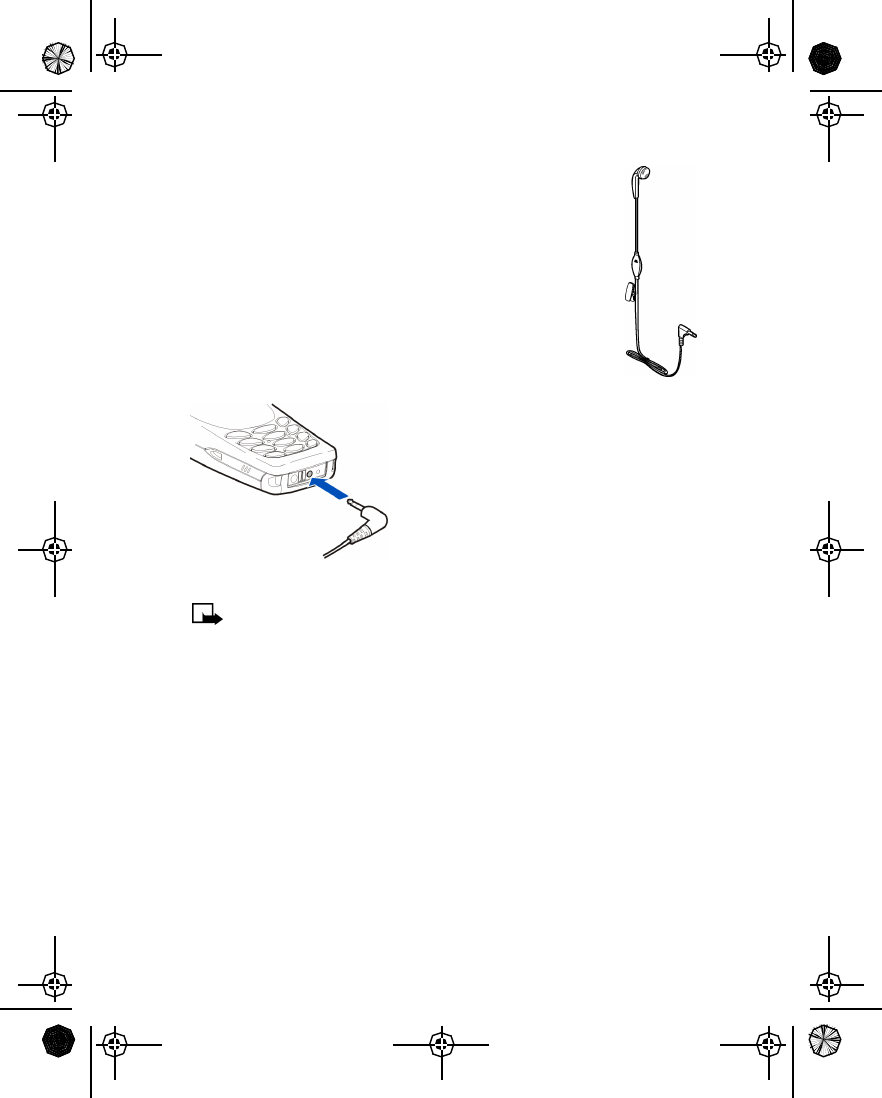
[ 12 ]
• SET UP YOUR HEADSET
Your phone is compatible with the HDC-5, HDE-2 and HDB-
5 headsets. The headset provides convenient handsfree use of
the phone.
Connect the headset
1Plug the headset jack into the bottom of your phone.
2Put the round ear plug into one ear.
Use the headset With the headset connected, you can make
and answer calls as usual.
The microphone for the headset hangs at
the side of your head. Although the
microphone may seem far from your
mouth, you can speak at a normal volume.
Note: You can set your phone to answer automatically when the
headset is connected. See “Automatic answer” on page64 for more
information.
EN1260.2_Sept_02.book Page 12 Friday, September 6, 2002 4:39 PM

[ 13 ]
Welcome and quick guide
• GET STARTED WITH THE QUICK GUIDE
Make a call Enter phone number, press .
Answer a call Press or Answer.
Answer with call waiting Press .
End a call Press .
Silence a call Press .
Redial Press twice.
Adjust call volume During a call, press for louder
or for softer.
Use the in-call menu In a call, press Options.
Use 1-touch dialing Press and hold one of keys 2 through 9.
Save a name and number Enter a number, press Save, then enter a name and press
OK .
Retrieve a name/number Press Names, select Find.
Retrieve a name/number
during a call Press Options, scroll New call, press Select, press Find,
enter first letter of the name.
Check voice mail Press and hold or call your voice mailbox number.
Send a text message Press Menu 1-1. Write the message. Press Options ( Send
will be the first option), then press Select,
enter the recipient’s number, press Send.
Send an e-mail message Press Menu 1-2. Enter the recipient’s address, press OK,
enter the subject, press OK, write the message, press
Options, scroll to Send then press Select. (You may need
to enter the gateway number your service provider gave
you.)
Read new message Press Read. If you have more than one message, scroll to
the one you want, then press Read again.
Reply to a message Press Options, scroll to Reply, then press Select.
Reply to an E-mail
message When reading the message, press Options, scroll to Reply,
then press Select.
Send a business card Retrieve a name from the phone book, press Options,
select Send bus. card, enter the recipient’s number, press
Send.
EN1260.2_Sept_02.book Page 13 Friday, September 6, 2002 4:39 PM

[ 14 ]
• GET HELP
Find your phone’s label
When you call Nokia Customer Care Center or your service provider, you
will need to provide specific information about your phone. This
information is recorded on the phone’s type label. The type label is located
under the battery inside the phone’s back cover. It contains the model and
serial numbers as well as other important information about your phone.
Please do not remove or deface the label.
Contact Nokia
If you have a question and have already checked the Troubleshooting
section (see page121), we recommend that you have the following
information available before contacting the Nokia Customer Care Center
or the service provider:
•Your phone’s model number
•ESN (Electronic serial number – located on the label under the
battery)
•Your billing address ZIP code
•The phone or accessory in question
Nokia Customer Care Center, USA Customer Interaction Centre,
Canada
Nokia Mobile Phones
7725 Woodland Center Blvd.
Suite #150
Tampa, Florida 33614
Tel:1-888-NOKIA-2U
(1-888-665-4228)
Fax: 1-813-249-9619
For TTY users: 1-800-24-NOKIA
(1-800-246-6542)
Nokia Products Ltd.
601 Westney Road South
Ajax, Ontario L1S 4N7
Tel: 1-888-22-NOKIA
(1-888-226-6542)
Fax: 1-905-427-1070
Web site: www.nokia.ca
EN1260.2_Sept_02.book Page 14 Friday, September 6, 2002 4:39 PM

[ 15 ]
Welcome and quick guide
Contact your service provider
You may want to save your service provider’s customer support telephone
number into your phone. This will let you easily contact your provider if
you have questions or issues with your phone service.
Receive accessibility information
Nokia is committed to making mobile phones easy to use for all
individuals, including those with disabilities. Nokia maintains an internet
site that is dedicated to accessibility solutions. For more information
about phone features, accessories and other Nokia products designed
with your needs in mind, visit the web site at
www.nokiaaccessibility.com
ACCESSIBLE FEATURES
This Nokia phone has many accessible features, including:
•Nibs under the five key for quick reference to the keypad
•Tactile feedback when you press a key
•Ability to send and receive short text and e-mail messages
•Convenience of 1-touch dialing
•Customizable ring tones
LPS-3 MOBILE INDUCTIVE LOOPSET
The LPS-3 Loopset is a Nokia accessory designed to make the phone more
accessible to hearing-aid users. The loopset gives hearing-impaired users
clear access to digital telephony for the first time. It allows people with
T-coil equipped hearing aids to make and receive calls without noise
interference.
To activate the Loopset, see “Accessory settings” on page63.
Note: The Loopset is sold as an accessory to the phone.
EN1260.2_Sept_02.book Page 15 Friday, September 6, 2002 4:39 PM
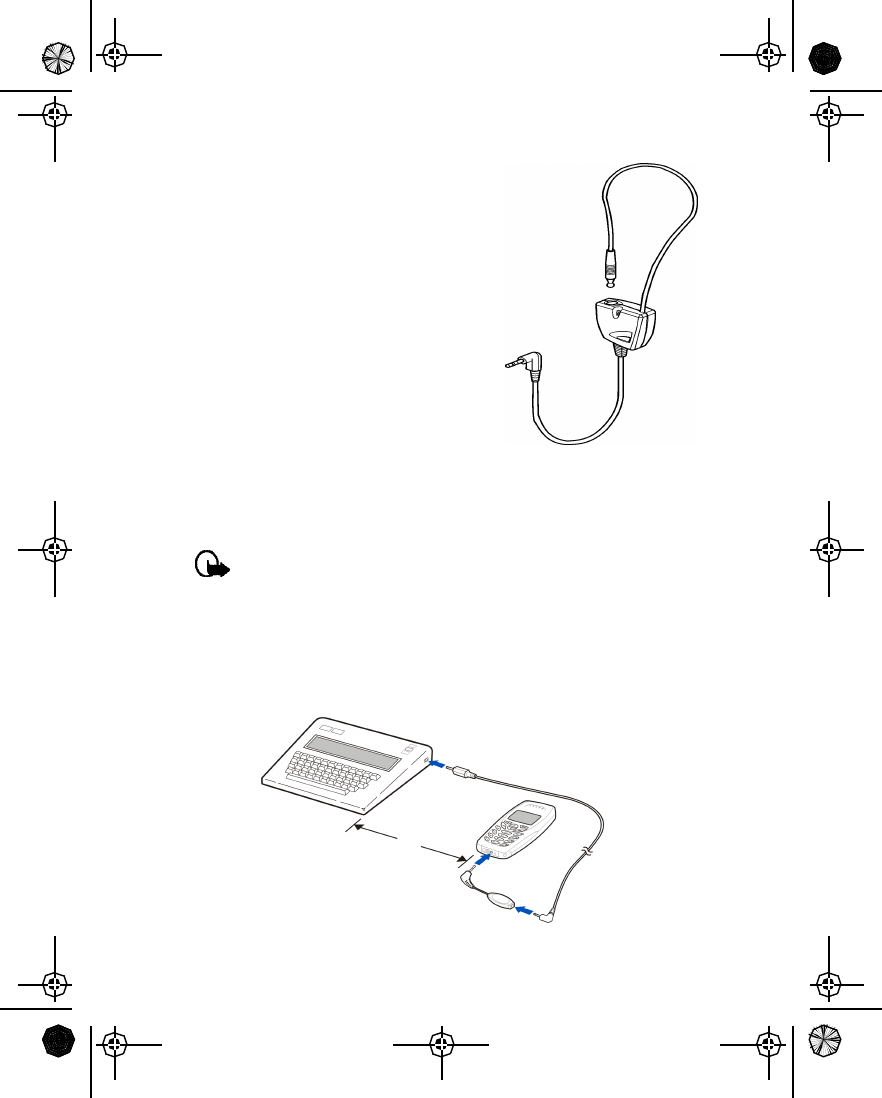
[ 16 ]
HOW THE LOOPSET WORKS
The LPS-3 Loopset uses inductive technology
to transmit sound to a hearing aid equipped
with a T-coil. The sound from the phone is
amplified more efficiently and background
noise is eliminated.
The loopset is easy to use. You wear the
loopset around your neck, connect it to your
phone, and speak directly toward the
microphone. For detailed instructions on
using the loopset, refer to the booklet that
comes with the LPS-3.
Set up the TTY/TDD profile
You can connect your phone to a TTY/TDD using the Nokia TTY/TDD
Adapter (HDA-9). In order for your phone to recognize the TTY/TDD, you’ll
need to connect the adapter to your phone..
Important: Some manufacturers of TTY/TDD devices suggest that
the phone be least 18 inches from the TTY/TDD device. When
connecting to any other device, read its user guide or contact its
manufacturer for detailed instructions and safety information.
1Connect the TTY/TDD via cable to the HDA-9 adapter.
2Plug the HDA-9 adapter into the connector on the bottom of your
phone, as shown in the illustration.
18”
EN1260.2_Sept_02.book Page 16 Friday, September 6, 2002 4:39 PM

[ 17 ]
Welcome and quick guide
3Press Menu 4-4-4-1 (Settings > Accessory settings > TTY/TDD >
Use TTY).
4Scroll to Yes, then press Select.
NOTES ABOUT TTY/TDD CALLS
•The Nokia TTY/TDD Adapter (HDA-9) is for use with compatible
TTY/TDD devices only. Check with the manufacturer of the TTY/TDD
device to ensure that the connection is compatible.
•Check with the manufacturer of the TTY/TDD device for the
connecting cable.
•TTY/TDD communications depend on network availability. Check with
your service provider for availability and description of services.
MAKE A TTY/TDD CALL
Tip: Before making a TTY/TDD call with your Nokia phone, check the
signal strength. See “Understand indicators and icons” on page21
for details.
1From the Start screen, enter the number and press .
2When the receiving party answers, begin typing your conversation on
the TTY/TDD.
RECEIVE A TTY/TDD CALL
1Make sure the TTY/TDD device is connected to your phone.
2Press to answer the call, then type your responses on the
TTY\TDD.
END A TTY/TDD CALL
Press
EN1260.2_Sept_02.book Page 17 Friday, September 6, 2002 4:39 PM

[ 18 ]
3Basic operations
This section gives a brief introduction to the phone and shows quick steps
for:
•Making and answering calls
•Adjusting the earpiece volume
•Navigating through menus
•Using menu shortcuts
You will also find information about the phone’s icons and how to use in-
phone help. The rest of this guide provides complete details on phone use.
• SWITCH YOUR PHONE ON OR OFF
Warning: Do not switch on the phone when
wireless phone use is prohibited or when it
may cause interference or danger.
Switch ON your phone
Press and hold the power key for 2 seconds.
Switch OFF your phone
Press and hold the power key.
Or, press the power key quickly. When Switch off!
is highlighted on the screen, press Select.
• MAKE AND ANSWER CALLS
There are several ways to make and answer calls on your phone. Once
learning about the basic methods, you will discover other tips throughout
this guide when reading about the phone’s features.
Power
key
EN1260.2_Sept_02.book Page 18 Friday, September 6, 2002 4:39 PM
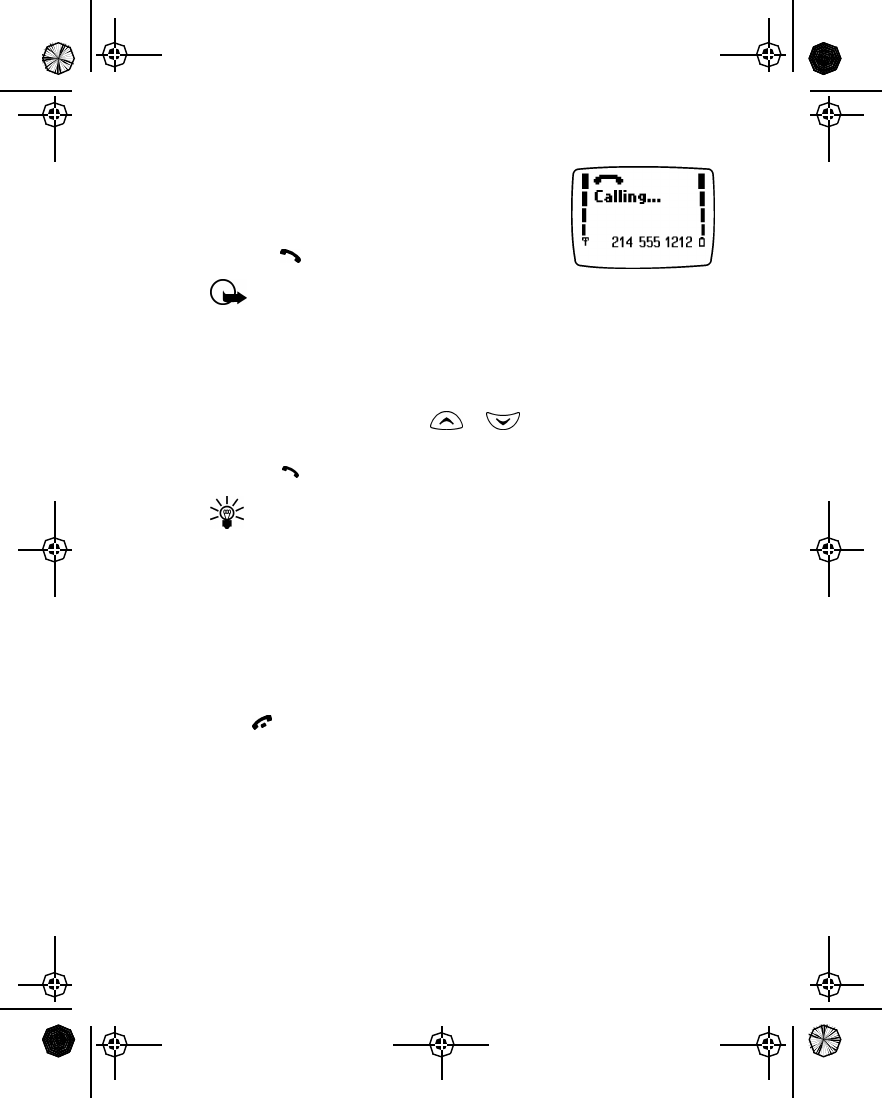
[ 19 ]
Basic operations
Use the keypad
1Enter the phone number, including area code
if needed.
2Press .
Important: Do not touch the antenna
when the phone is switched on. Contact with the antenna affects
call quality and may cause the phone to operate at a higher power
level than otherwise needed.
Use the phone book
1From the Start screen, press or and scroll to the number you
want.
2Press to make the call.
Tip: To skip ahead quickly in the list, press the number key that has
the first letter of the name. You may have to press the key more
than once to get to the correct letter.
Make a 1-touch dial call
Press and hold the key assigned to the number you wish to call.
To learn how to store a number for use with 1-touch dialing see “Assign
a key to 1-touch dialing” on page77.
End a call
Press to end the call or cancel the call attempt.
EN1260.2_Sept_02.book Page 19 Friday, September 6, 2002 4:39 PM

[ 20 ]
Answer a call
When your phone rings, press . You can press any key to answer a call
except the power key, end key, or the scroll keys.
Note: If Keyguard is active, the keypad will unlock when you have
an incoming call.
Silence an incoming call
Press or Silent to mute the ringing of an incoming call.
Redial the last-dialed number
Press two times.
Adjust the earpiece volume
You can adjust the earpiece volume during a call
by pressing the scroll keys located just below the
screen.
•Press the key to increase the volume.
•Press the key to decrease the volume.
• CHECK THE START SCREEN
When you switch on your phone, a
welcome appears, then you see the
Start screen.
The Start screen appears when the
phone is idling or standing by. Start screen
EN1260.2_Sept_02.book Page 20 Friday, September 6, 2002 4:39 PM
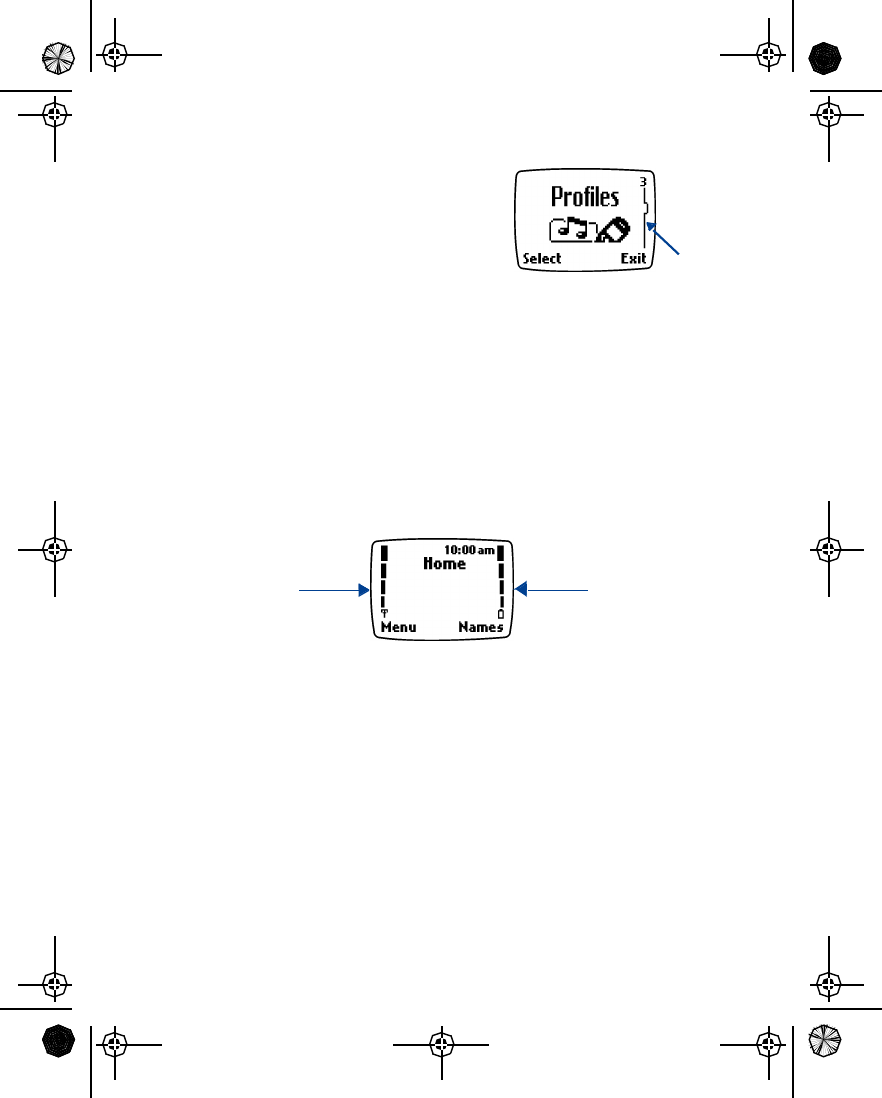
[ 21 ]
Basic operations
Understand the Scroll Bar
When you press Menu, a vertical
scroll bar appears on the right side of
the screen. This scroll bar has a tab
which moves up or down to indicate
your location in the menu.
Understand indicators and icons
You have two types of identifiers on your phone: icons and indicators.
Indicators show the status of something. The phone uses three types of
indicators: signal strength, battery power and handset volume.
Icons are graphical representations of a specific item or situation. For
example, an icon appears when you have a voice message in your mailbox.
Indicators
1Signal strength – shows the signal strength of the wireless network
at your current location. The higher the bar, the stronger the signal.
2Battery power – shows the battery charge level. The higher the bar,
the more power in the battery.
Scroll
bar
Signal
strength
indicator
Battery
power
indicator
EN1260.2_Sept_02.book Page 21 Friday, September 6, 2002 4:39 PM

[ 22 ]
Icons
Screen
Icon What it means
Active call in progress.
Silent has been selected as the current profile.
The phone’s keypad is locked to prevent any accidental key
presses.
One (or more) new voice messages waiting.
One or more new text messages waiting.
(If blinking, the text message memory is full.)
Digital service is available.
Standard text input mode for entering alpha characters.
Press to switch between uppercase and lowercase
input.
Predictive text mode for quickly entering text messages.
Press to switch between uppercase and lowercase
input.
123 mode. This icon appears when you press and hold
while entering text. You can now enter only numbers (not
alpha characters). Press and hold again to return to text
entry mode.
Special character mode. This appears when you press
while entering text. Once the characters appear, you can
select a special character by selecting Insert.
Alarm clock is set.
EN1260.2_Sept_02.book Page 22 Friday, September 6, 2002 4:39 PM

[ 23 ]
Basic operations
• USE THE SELECTION KEYS
The selection key allows you to select various
phone options.
At the bottom of the Start screen, two options
appear: Menu and Names. The selection keys
are located just below these options.
The left selection key is located under Menu.
The right selection key is located under
Names.
When you press the left selection key at the Start screen, the menu item
Messages appears. The text above the left selection key changes to Select
and the text above the right selection key changes to Exit.
When you press the right selection key at the Start screen, options for the
Names feature appear. The text above the left selection key changes to
Select and the text above the right selection key changes to Exit.
• SCROLL KEYS Use the scroll keys, located just below the
screen, to scroll through your phone’s
menus and phone book.
Note: The Accessory settings menu will not appear until after an
accessory has been connected to the phone.
• CHECK IN-PHONE HELP
Many menu items have brief help text. To view the help text, scroll to the
menu item and wait for about 15 seconds. Press More or to
continue reading the text. Press Back to exit, or wait a few seconds to
return to the current menu.
EN1260.2_Sept_02.book Page 23 Friday, September 6, 2002 4:39 PM

[ 24 ]
• BROWSE PHONE MENUS
A menu is a list of choices you can make to change settings on your phone
or use various phone features. Each menu can contain several levels of
submenus. You can use menus and submenus two ways: by scrolling or by
using a shortcut. This guide uses the shortcut method when describing
how to use the phone’s features.
Scroll through menus
1At the Start screen, press Menu, then scroll through the menus using
the and keys.
2Use the scroll and selection keys to navigate the submenus; press
to return to the Start screen.
For example, when you see (Menu > Profiles > Silent) the scrolling
method is: press Menu, scroll to Profiles and press Select, scroll to Silent
and press Options.
Return to the previous menu level
You can return to the previous menu level by pressing the selection key
labeled Exit or Back. You can return to the Start screen from any menu
level by .
Use shortcuts
Menus and options are numbered so that you can quickly find your way to
an option. The numbers appear in the top right corner of the screen and
show your location in the menu.
1Press Menu.
2Within 3 seconds, enter the first number of the menu function you
want to access. Repeat until you have entered all the numbers.
For example, to select the Silent profile, press Menu 3-2-1.
EN1260.2_Sept_02.book Page 24 Friday, September 6, 2002 4:39 PM

[ 25 ]
Basic operations
MENU TIPS
•You can scroll upward to quickly access the last option in a menu list.
•You can return to the previous menu level by pressing Back.
•To exit a menu and return to the Start screen, press . If you
leave a menu by pressing , you cancel any changes you made.
•Some menus may not appear. Ask your service provider for details.
Menu shortcuts
1MESSAGES
Write message. . . . . . . . . . . . . . . . . . . . . . . 1-1
Write e-mail . . . . . . . . . . . . . . . . . . . . . . . . 1-2
Inbox . . . . . . . . . . . . . . . . . . . . . . . . . . . . . . 1-3
Outbox. . . . . . . . . . . . . . . . . . . . . . . . . . . . . 1-4
Archive . . . . . . . . . . . . . . . . . . . . . . . . . . . . . 1-5
Erase all. . . . . . . . . . . . . . . . . . . . . . . . . . . . 1-6
Picture messages. . . . . . . . . . . . . . . . . . . . . 1-7
Voice messages . . . . . . . . . . . . . . . . . . . . . . 1-8
Listen to voice messages . . . . . . . . . 1-8-1
Voice mailbox number . . . . . . . . . . . 1-8-2
2CALL LOG
Missed calls. . . . . . . . . . . . . . . . . . . . . . . . . 2-1
Received calls . . . . . . . . . . . . . . . . . . . . . . . 2-2
Dialed calls . . . . . . . . . . . . . . . . . . . . . . . . . 2-3
Clear call lists . . . . . . . . . . . . . . . . . . . . . . . 2-4
All . . . . . . . . . . . . . . . . . . . . . . . . . . . 2-4-1
Missed . . . . . . . . . . . . . . . . . . . . . . . . 2-4-2
EN1260.2_Sept_02.book Page 25 Friday, September 6, 2002 4:39 PM
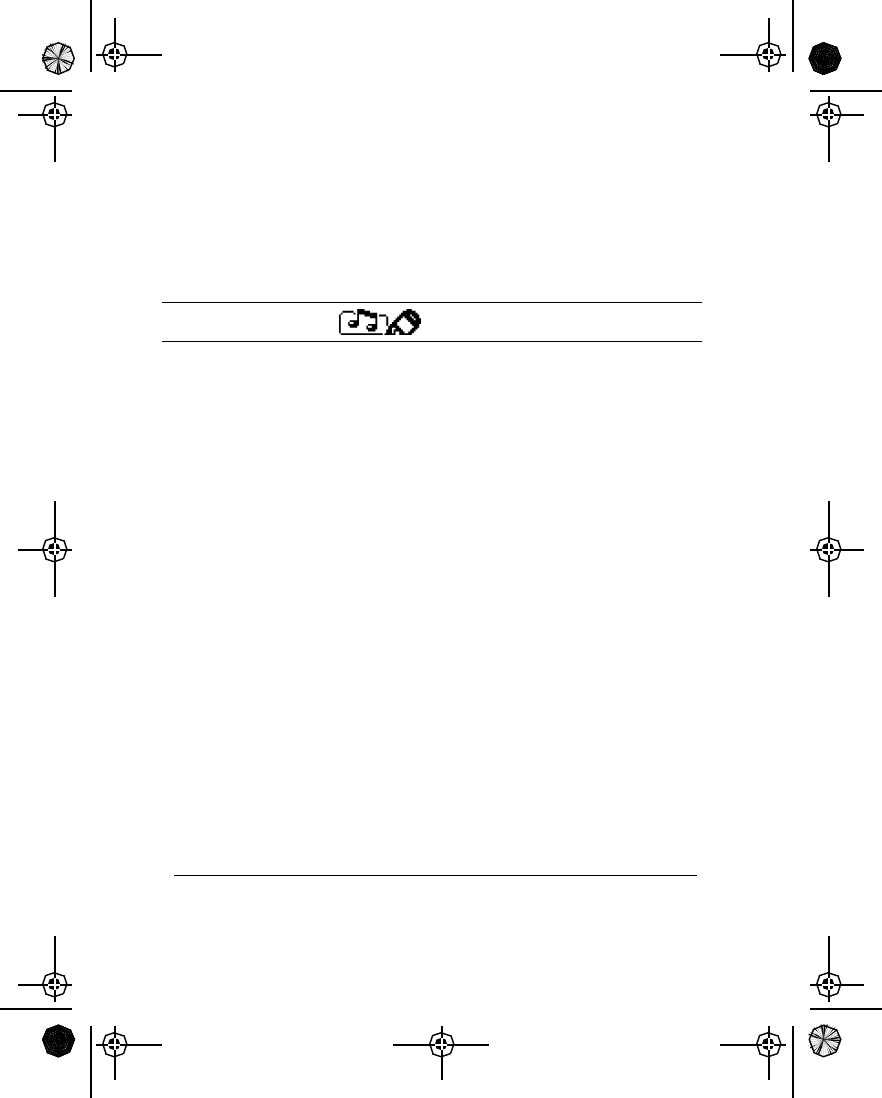
[ 26 ]
Received . . . . . . . . . . . . . . . . . . . . . . .2-4-3
Dialed . . . . . . . . . . . . . . . . . . . . . . . . . 2-4-4
Call timers . . . . . . . . . . . . . . . . . . . . . . . . . . 2-5
Duration of last call. . . . . . . . . . . . . . 2-5-1
Duration of all calls. . . . . . . . . . . . . . 2-5-2
Clear timers . . . . . . . . . . . . . . . . . . . . 2-5-3
3PROFILES
Normal . . . . . . . . . . . . . . . . . . . . . . . . . . . . .3-1
Select . . . . . . . . . . . . . . . . . . . . . . . . . 3-1-1
Customize. . . . . . . . . . . . . . . . . . . . . . 3-1-2
Ringing options . . . . . . . . . . . . 3-1-2-1
Ringing tone. . . . . . . . . . . . . . . 3-1-2-2
Ringing volume . . . . . . . . . . . . 3-1-2-3
Message alert tone . . . . . . . . .3-1-2-4
Keypad tones . . . . . . . . . . . . . . 3-1-2-5
Warning tones . . . . . . . . . . . . .3-1-2-6
Profile name1
Silent . . . . . . . . . . . . . . . . . . . . . . . . . . . . . . 3-2
Select . . . . . . . . . . . . . . . . . . . . . . . . . 3-2-1
Customize. . . . . . . . . . . . . . . . . . . . . . 3-2-2
Meeting . . . . . . . . . . . . . . . . . . . . . . . . . . . . 3-3
Select . . . . . . . . . . . . . . . . . . . . . . . . . 3-3-1
Customize. . . . . . . . . . . . . . . . . . . . . . 3-3-2
Outdoor . . . . . . . . . . . . . . . . . . . . . . . . . . . . 3-4
Select . . . . . . . . . . . . . . . . . . . . . . . . . 3-4-1
Customize. . . . . . . . . . . . . . . . . . . . . . 3-4-2
Pager. . . . . . . . . . . . . . . . . . . . . . . . . . . . . . . 3-5
Select . . . . . . . . . . . . . . . . . . . . . . . . . 3-5-1
Customize. . . . . . . . . . . . . . . . . . . . . . 3-5-2
1The Profile name option is available for Silent, Meeting, Outdoor and
Pager. The Normal profile cannot be renamed.
EN1260.2_Sept_02.book Page 26 Friday, September 6, 2002 4:39 PM
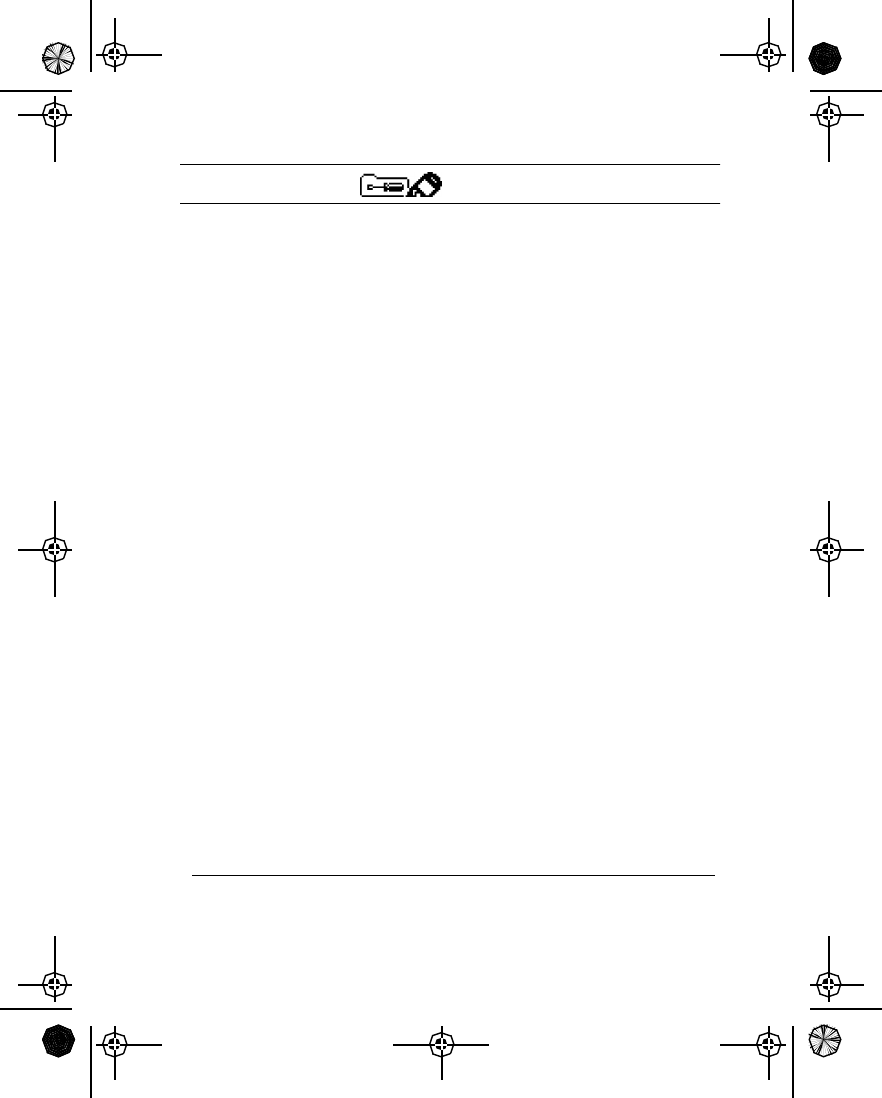
[ 27 ]
Basic operations
4SETTINGS
Time settings. . . . . . . . . . . . . . . . . . . . . . . . 4-1
Alarm clock . . . . . . . . . . . . . . . . . . . . 4-1-1
On. . . . . . . . . . . . . . . . . . . . . . . 4-1-1-1
Off. . . . . . . . . . . . . . . . . . . . . . . 4-1-1-2
Clock . . . . . . . . . . . . . . . . . . . . . . . . . 4-1-2
Show/Hide clock. . . . . . . . . . 4-1-2-1
Set the time . . . . . . . . . . . . . 4-1-2-2
Time format . . . . . . . . . . . . . 4-1-2-3
Auto update of time . . . . . . . . . . . . . 4-1-3
Call settings. . . . . . . . . . . . . . . . . . . . . . . . . 4-2
Automatic redial . . . . . . . . . . . . . . 4-2-1
Current call timer . . . . . . . . . . . . . . . 4-2-2
Phone settings. . . . . . . . . . . . . . . . . . . . . . . 4-3
Language. . . . . . . . . . . . . . . . . . . . . . 4-3-1
Touch tones. . . . . . . . . . . . . . . . . . . . 4-3-2
Manual touch tones . . . . . . . . 4-3-2-1
Touch tone length. . . . . . . . . . 4-3-2-2
Welcome note . . . . . . . . . . . . . . . . . . 4-3-3
Restore factory settings . . . . . . . . . . 4-3-4
Accessory settings1. . . . . . . . . . . . . . . . . . . 4-4
Headset . . . . . . . . . . . . . . . . . . . . . . . 4-4-1
Handsfree . . . . . . . . . . . . . . . . . . . . . 4-4-2
Loopset. . . . . . . . . . . . . . . . . . . . . . . . 4-4-3
Security settings . . . . . . . . . . . . . . . . . . . . . 4-5
Call restrictions. . . . . . . . . . . . . . . . . 4-5-1
Change security code. . . . . . . . . . . . 4-5-2
Network services. . . . . . . . . . . . . . . . . . . . . 4-6
Voice privacy. . . . . . . . . . . . . . . . . . . 4-6-1
Call forwarding . . . . . . . . . . . . . . . . . 4-6-2
Call waiting . . . . . . . . . . . . . . . . . . . . 4-6-3
Send own caller ID . . . . . . . . . . . . . . 4-6-4
1The Accessory settings menu will not appear until after an accessory
has been connected to the phone.
EN1260.2_Sept_02.book Page 27 Friday, September 6, 2002 4:39 PM
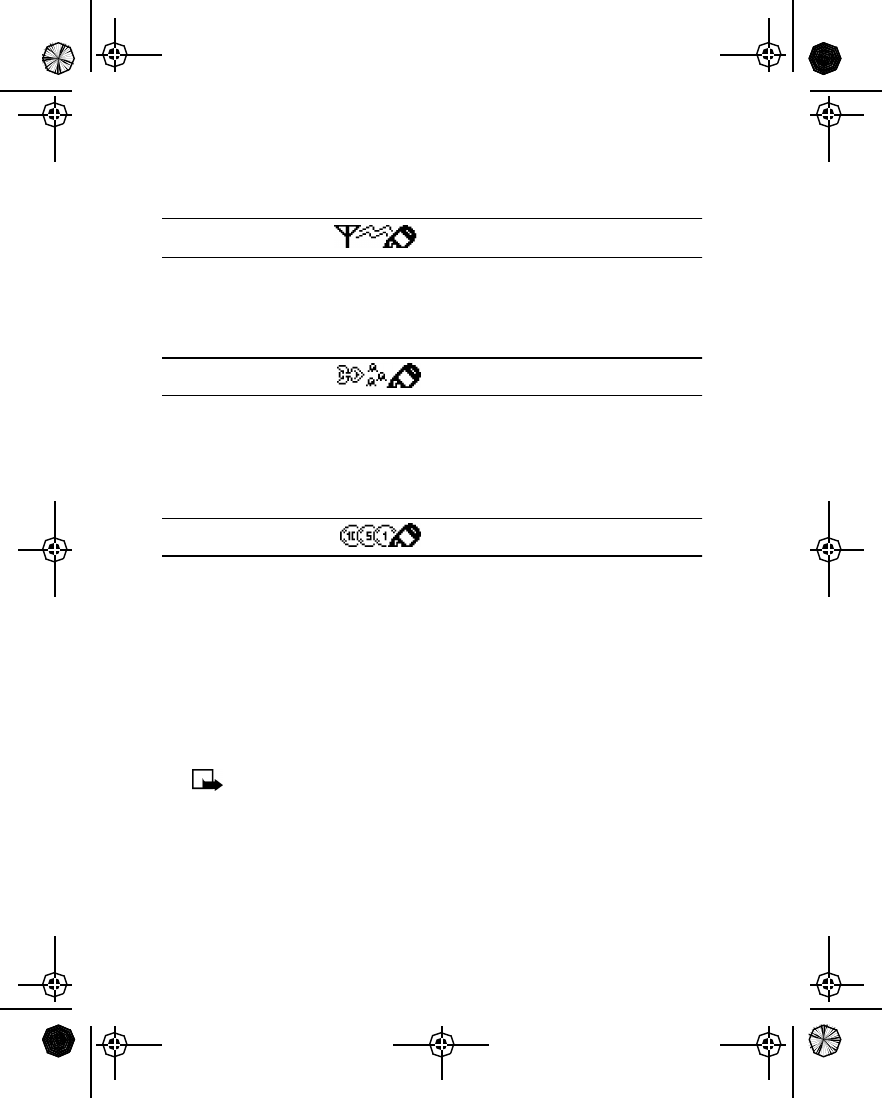
[ 28 ]
Network feature setting . . . . . . . . . . 4-6-5
Own number selection . . . . . . . . . . .4-6-6
5SYSTEM
Automatic. . . . . . . . . . . . . . . . . . . . . . . . . . . 5-1
Manual . . . . . . . . . . . . . . . . . . . . . . . . . . . . .5-2
New search. . . . . . . . . . . . . . . . . . . . . . . . . . 5-3
6GAMES
Snake II. . . . . . . . . . . . . . . . . . . . . . . . . . . . .6-1
Space Impact . . . . . . . . . . . . . . . . . . . . . . . . 6-2
Pairs II. . . . . . . . . . . . . . . . . . . . . . . . . . . . . . 6-3
Settings . . . . . . . . . . . . . . . . . . . . . . . . . . . . 6-4
7 PREPAID
Check account balance . . . . . . . . . . . . . . . . 7-1
Add money to account . . . . . . . . . . . . . . . . 7-2
Call customer service . . . . . . . . . . . . . . . . .7-3
Save access phone numbers . . . . . . . . . . . . 7-4
Balance phone number. . . . . . . . . . .7-4-1
Replenish phone number . . . . . . . . . 7-4-2
Customer service phone number . . .7-4-3
Expiration date. . . . . . . . . . . . . . . . . . . . . . . 7-5
Note: The Prepaid menu is visible only when Prepaid service is
available in your network and/or activated on your account. Please
contact your service provider for more information on Prepaid
services.
EN1260.2_Sept_02.book Page 28 Friday, September 6, 2002 4:39 PM
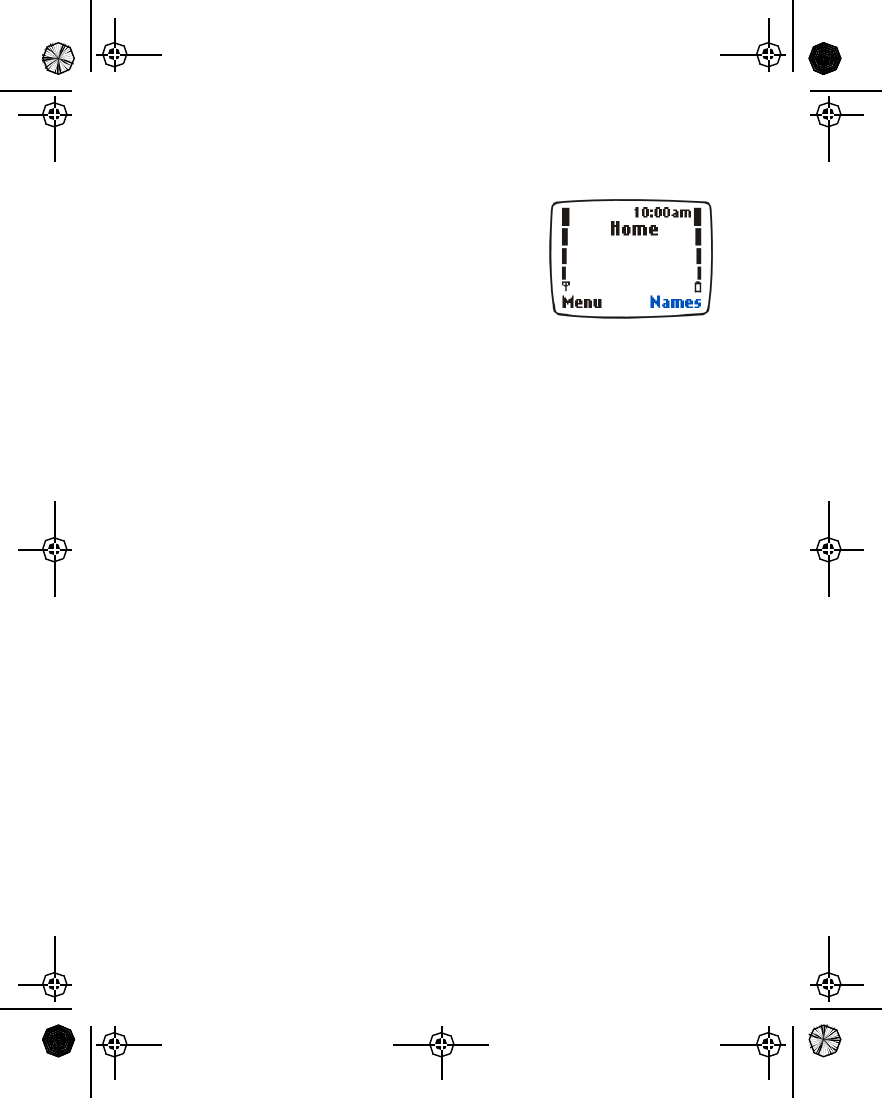
[ 29 ]
Basic operations
• PHONE BOOK MENU
For access to the phone book and its menus:
•Switch back to the Start screen.
•Press Names.
These options are available:
Find
Add new
Erase all
Options
Phone book view
Name list
Name+number
Name only
Memory status
1-touch dialing
EN1260.2_Sept_02.book Page 29 Friday, September 6, 2002 4:39 PM
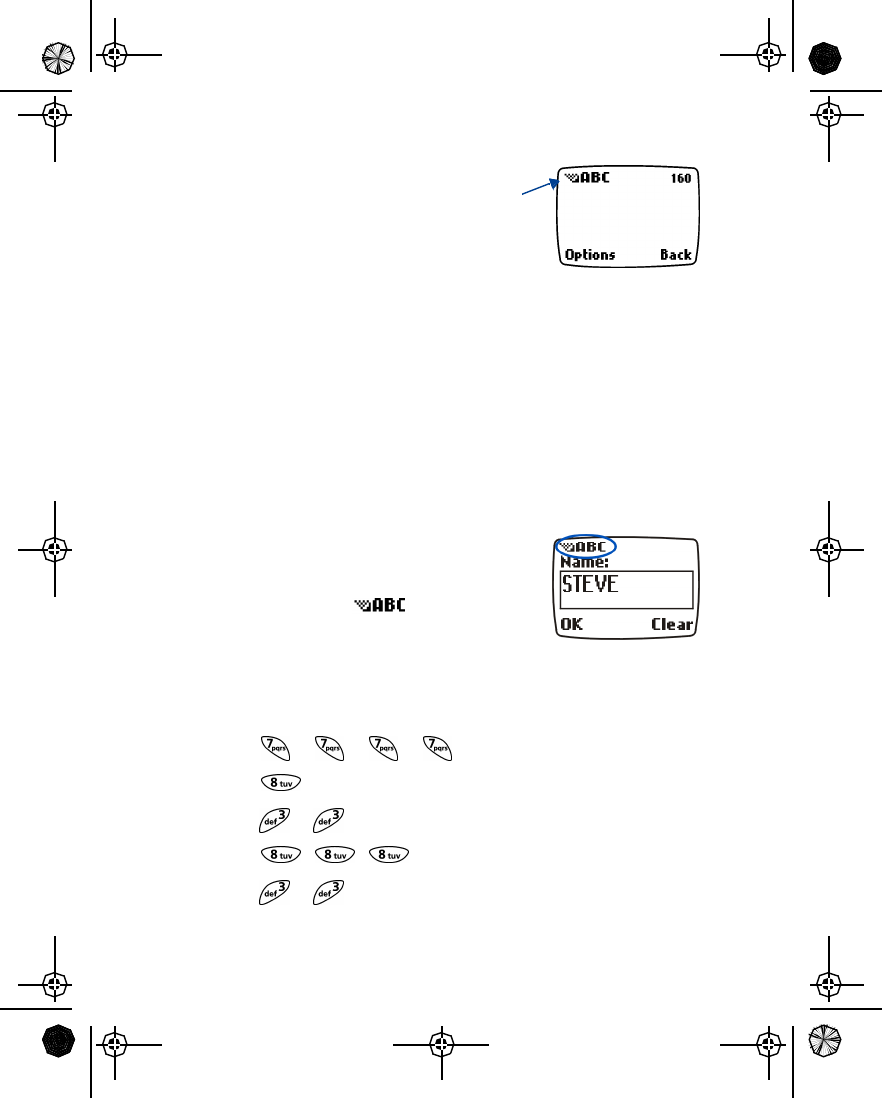
[ 30 ]
4Text entry
There are two ways to enter letters
and numbers into your phone:
•Standard text input - for
making entries in the phone book.
•Predictive text input - for writing text messages, picture messages,
and e-mails. For more detail, see “Write with predictive text” on
page34.
• STANDARD TEXT INPUT
Standard text input is used when entering text into information prompts.
You can use this method for all text entry, but predictive text input is the
faster method for writing messages.
Enter letters (ABC mode)
When you add new names to the phone book,
your phone automatically switches to the ABC
mode and displays the icon.
1Find the key that has the letter you want to
enter.
2Press the key as many times as needed for the letter to appear on the
screen. For example, to enter the name STEVE:
Press S
Press T
Press E
Press V
Press E
Current
entry
method
EN1260.2_Sept_02.book Page 30 Friday, September 6, 2002 4:39 PM
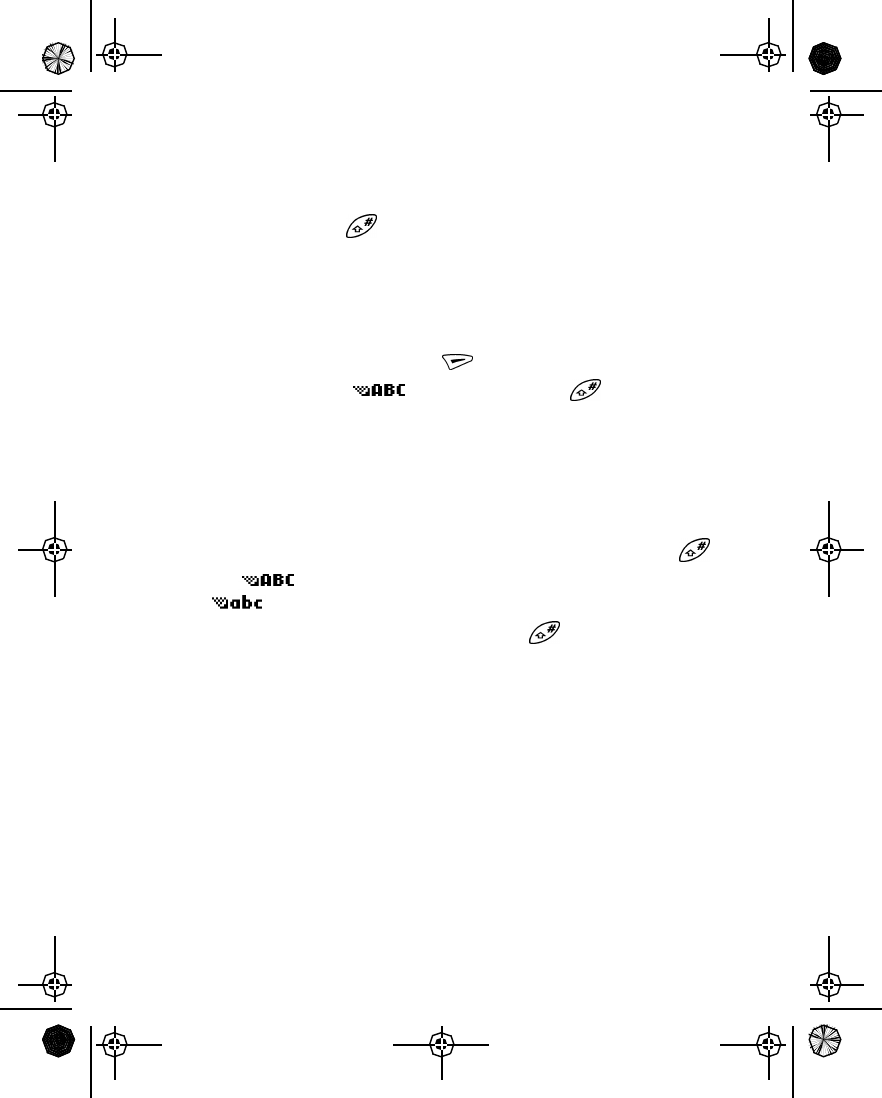
[ 31 ]
Text entry
Enter numbers (123 mode)
To enter numbers:
1Press and hold to switch to 123 mode. Press the appropriate
number key to enter a number.
OR
While in ABC mode, press and hold the corresponding number key
until the number appears.
If you make a mistake, press (Clear) to erase that character.
2To return to the mode, press and hold again for two
seconds.
ERASE MISTAKES
If you make a mistake, press Clear as needed to erase one or more
characters. Press and hold Clear to erase the entire field of characters.
CHANGE FROM CAPITAL (UPPERCASE) LETTERS
To switch between capital (uppercase) and lowercase letters, press .
The icon in the upper left corner of the screen switches to
, indicating that you can now enter lowercase letters.
To switch back to capital letters again, press .
EN1260.2_Sept_02.book Page 31 Friday, September 6, 2002 4:39 PM
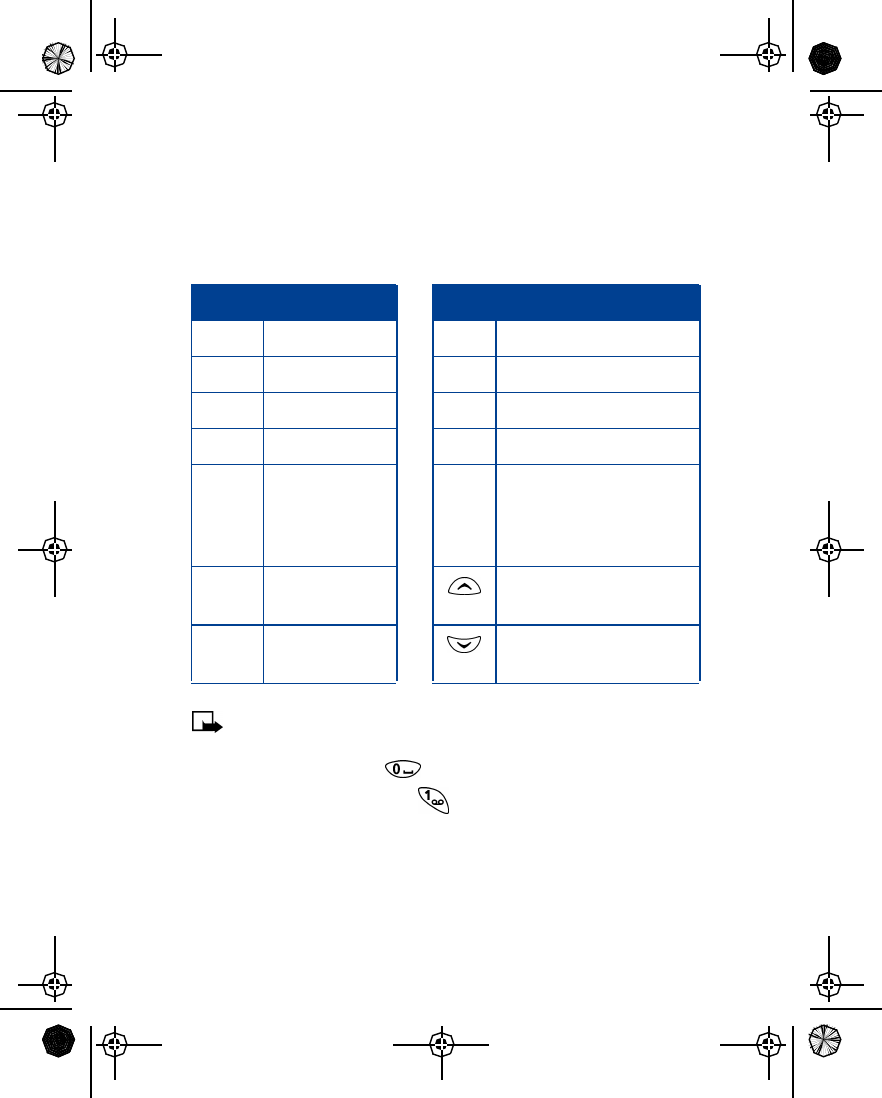
[ 32 ]
• ENTER SPACES, PUNCTUATION AND SPECIAL
CHARACTERS
Depending on the selected display language, the following characters
may be available when entering characters from the keypad:
Note: Some networks may not support all language-dependent
characters and/or services.
•To enter a space, press once.
•To enter punctuation, press repeatedly until the character you
want appears.
Key Characters Key Characters
1. , ’ ? ! @ ~ / “ - 18T U V 8
2A B C 2 9W X Y Z 9
3D E F 3 0Enters an empty space or 0.
4G H I 4 *Special characters
5J K L 5 #Changes letter case; long
press toggles between text
input mode and number
input mode
6M N O 6 Moves cursor to the left of
character.
7P Q R S 7 Moves cursor to the right of
character.
EN1260.2_Sept_02.book Page 32 Friday, September 6, 2002 4:39 PM
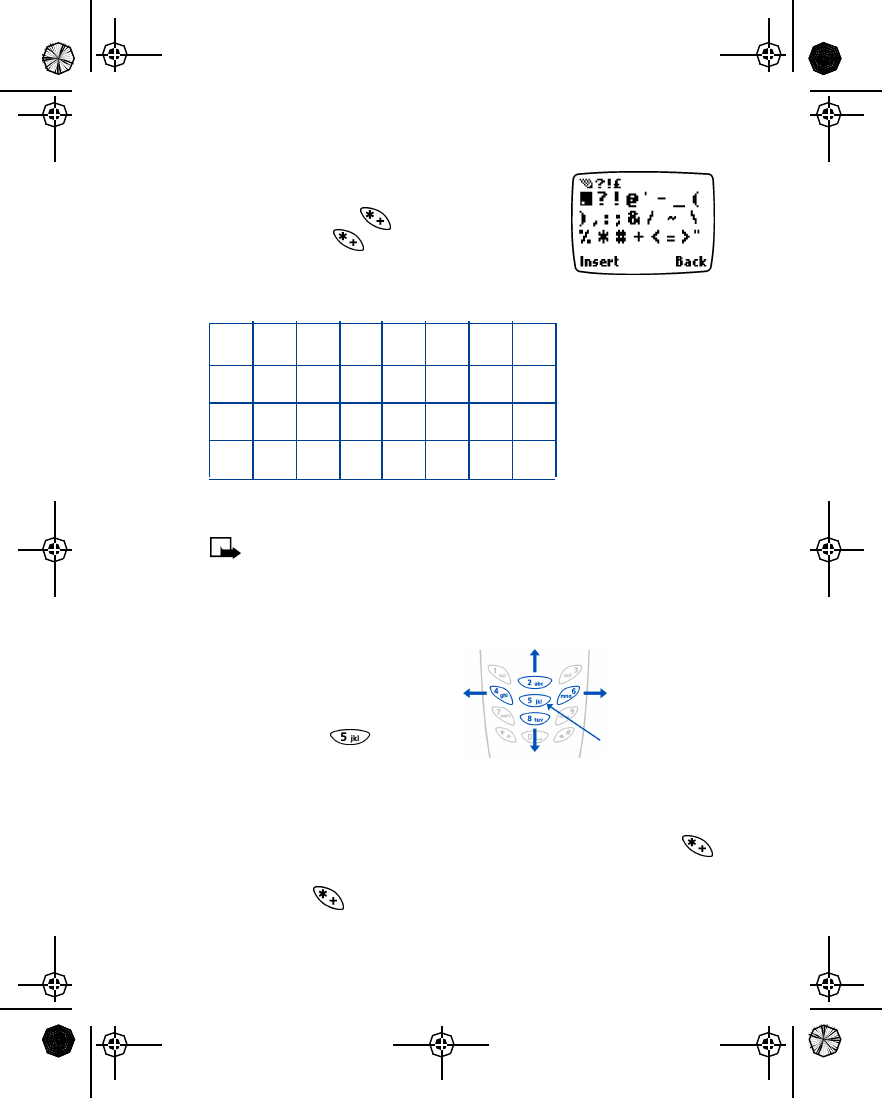
[ 33 ]
Text entry
Use special characters
While entering text, press (or press and hold, if
predictive text is on) to display special
characters. Press again to cycle through all
characters:
Use scroll keys to select the character you want, then press Insert.
Note: The order and availability of special characters may vary
depending on your service provider.
Use four-way scrolling
Navigate special
characters using the 2,
4, 6, and 8 keys much
as you would a joystick.
Once a character is
highlighted press
to insert the character
into your message.
Use symbols in names and numbers
•To enter a symbol while adding a name to the phone book, press .
•To add a special character for creating a number string in the number
box, press . See “Set touch tone strings” on page78.
.?!@‘-_(
),:;&/~\
% * #+<=>“
£$¥¤§¡¿
Scroll up
Scroll rightScroll left
Scroll down
Insert
character
EN1260.2_Sept_02.book Page 33 Friday, September 6, 2002 4:39 PM
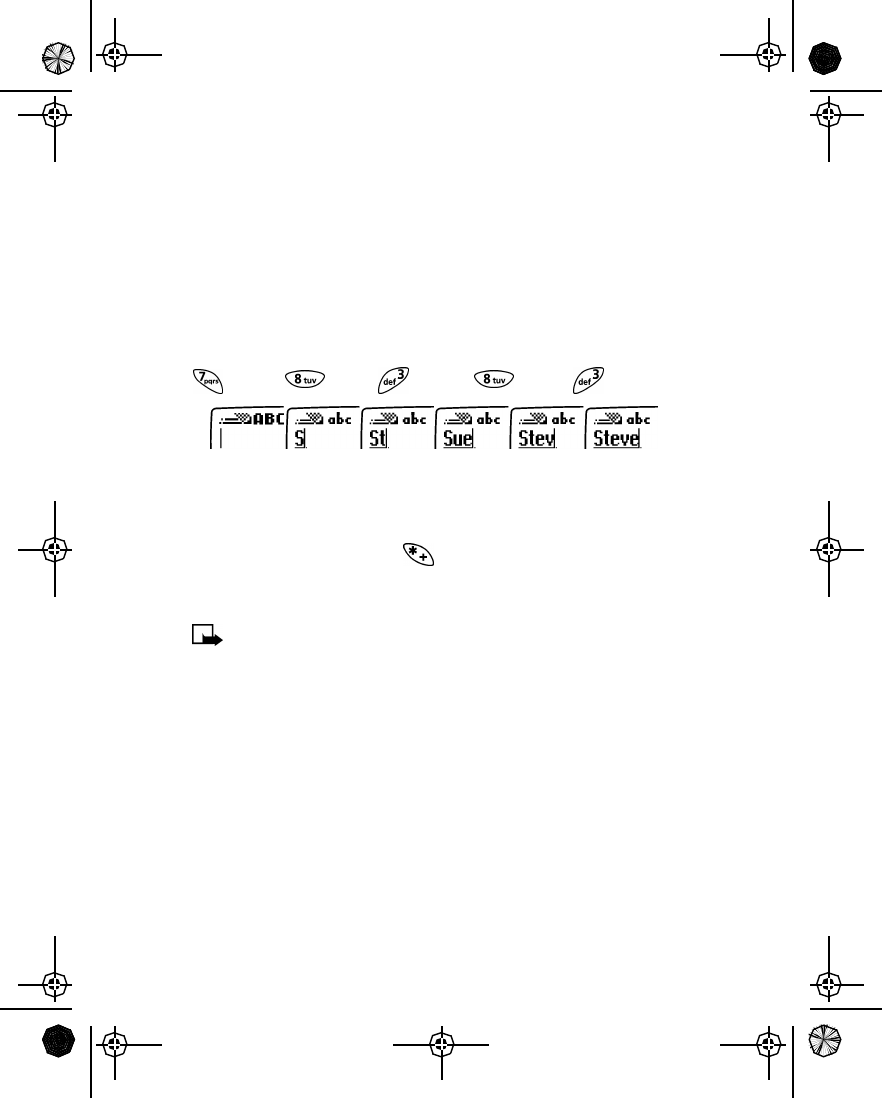
[ 34 ]
• WRITE WITH PREDICTIVE TEXT
Predictive text input allows you to write messages much faster than the
standard text method. With predictive text input, you only need to press
each number key once for each letter. Your phone uses a built-in
dictionary to predict or guess what you are writing. You can also add new
words to the dictionary.
Understand predictive text input
To write Steve with the English dictionary selected, press:
(for S) (for t) (for e) (for v) (for e)
Since the displayed word changes after each key stroke, disregard the
word until you have keyed in all the characters. If the finished word is not
the one you wanted, press the key until your word appears. If it does
not appear you will have an option to spell your word using standard text
input.
Note: Predictive text input may not be available for all languages.
Turn on predictive text input
1Press Menu, then press Select.
2Scroll to Write message, then press Select.
3Press Options, scroll to Predictive text, then press Select.
4Scroll to the language you want, then press Select.
T9 prediction on appears.
The display shows the above words for each key pressed.
EN1260.2_Sept_02.book Page 34 Friday, September 6, 2002 4:39 PM
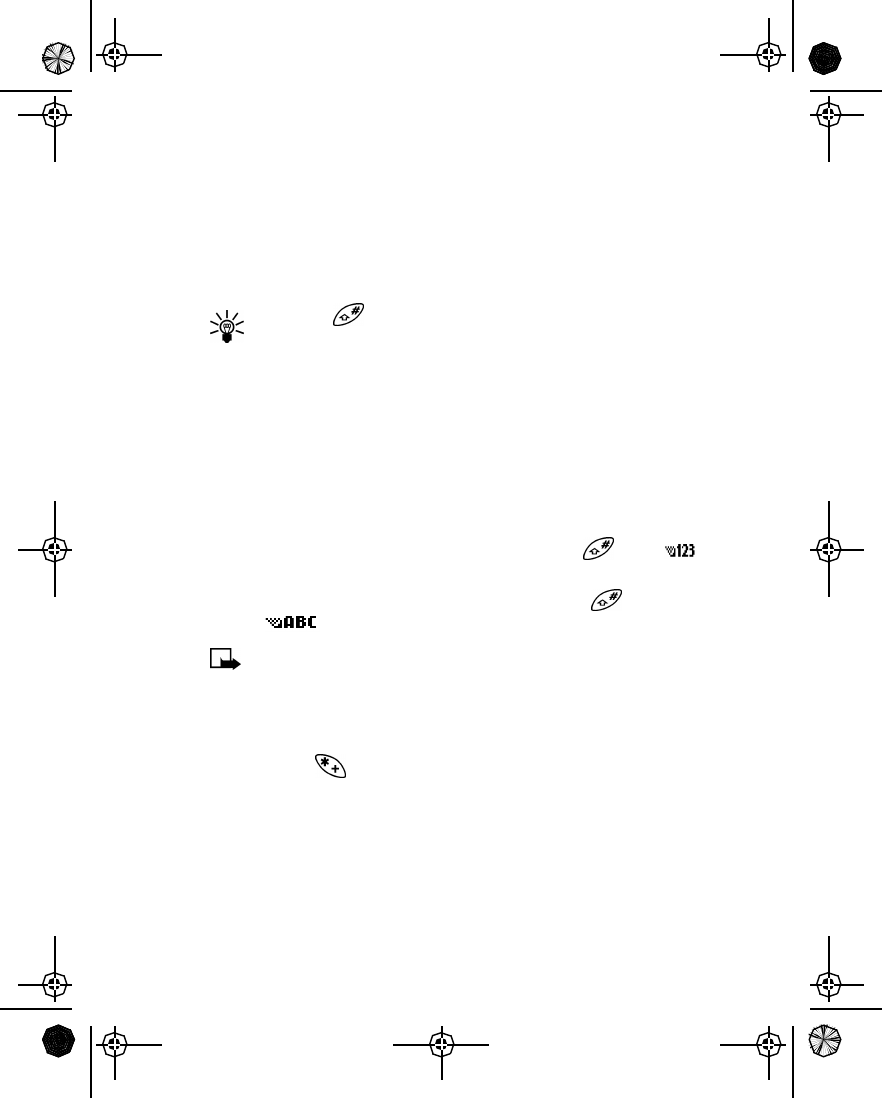
[ 35 ]
Text entry
Turn off predictive text input
1While writing a text message, press Options.
2Scroll to Predictive text, then press Select.
3Scroll to Prediction off, then press Select.
T9 prediction off appears.
Tip: Press to turn predictive text on and off.
Save a word in the dictionary
If the word Options changes to Spell, the word you intended to write is
not in the dictionary. You can add the word to predictive text.
1Press Spell and enter the word(s) using standard text entry.
2Press OK to save the word(s).
Enter numbers
1To add a number to the message, press and hold until
appears on the screen.
2Enter the numbers you want, then press and hold to return to
the method.
Note: You can also enter numbers from the Options menu (Insert
number), or by a long press of the number key.
Enter punctuation and special characters
There are two ways to enter punctuation when using predictive text.
Press and hold to access the special characters list. See “Use special
characters” on page33 for more information.
You can also enter symbols from the Options menu:
1From the message screen, press Options.
2Scroll to Insert symbol and press Select.
3Scroll to the symbol you want and press Insert.
EN1260.2_Sept_02.book Page 35 Friday, September 6, 2002 4:39 PM

[ 36 ]
Change the case
Predictive text uses sentence case, but you can manually change between
upper and lower case by pressing .
Tip: You can switch between uppercase and lowercase standard
text input and uppercase and lowercase predictive text input by
repeatedly pressing .
Write compound words
1Write the first part of the word and press
to accept it.
2Write the last part of the compound word
and press to enter the word and a
space.
Clear the screen
To clear the text screen, press and hold (Clear). You can also use the
Options menu by selecting the Clear text option.
Delete information
To delete information when using predictive text, press ( Clear). Press
and hold the clear key to delete text more quickly.
EN1260.2_Sept_02.book Page 36 Friday, September 6, 2002 4:39 PM

[ 37 ]
Phone book
5Phone book
Your phone includes a phone book that
can store a maximum of 200 entries
(names and associated phone
numbers). In addition, the phone book
can store an e-mail address for a
name.
•An entry in the phone book can
consist of a number only or a name and a number.
•You cannot enter the same name twice. If you try to save a name that
is already in the phone book, the phone asks if you want to replace
the existing name.
• USE PHONE BOOK MENUS
The phone book has several menus from which you can choose. These menus
appear when you press Names. Use the scroll keys to move to the menu
you want to use.
Find Allows you to search for a specific entry.
Add new Allows you to add a new contact to your phone
book.
Erase all Allows you to erase names and numbers one by one
or all at once.
Options Takes you to a new menu list which includes the
phone book’s memory status and scrolling view.
1-touch dialing Allows you to assign up to eight keys for speed
dialing.
Phone book
EN1260.2_Sept_02.book Page 37 Friday, September 6, 2002 4:39 PM
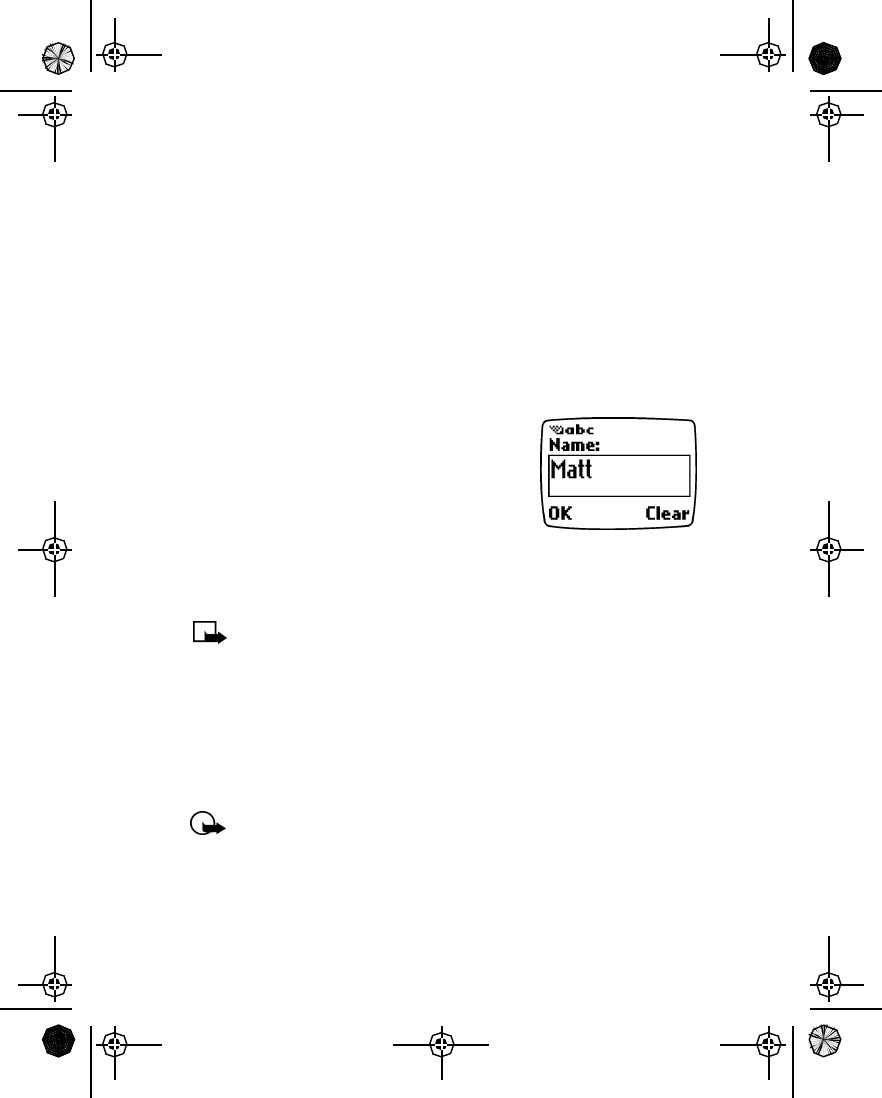
[ 38 ]
• SAVE NAMES, NUMBERS AND E-MAIL ADDRESSES
For information on entering text, see “Standard text input” on page30.
Quickly save a name and number
This method is called quick save.
1Enter the phone number using the keypad.
2Press Save.
3Enter a name and press OK.
Save an entry using the phone book menu
1Press Names to enter the phone book.
2Scroll to Add new and press Select.
3Enter a name and press OK.
4Enter a number and press OK.
Save an e-mail address
Once you have added a contact to your phone book, you can add an e-
mail address to that contact.
Note: E-mail addresses can only be added to existing contacts.
For instance, you cannot enter an e-mail address until you
have selected a name or number.
1Find the name to which you want to add an e-mail address.
2Press Details, then press Options.
3Scroll to E-mail address, then press Select.
4Enter the e-mail address, and press OK.
Important:If you have selected the Name+number phone book
view, you will not need to press Details.
EN1260.2_Sept_02.book Page 38 Friday, September 6, 2002 4:39 PM
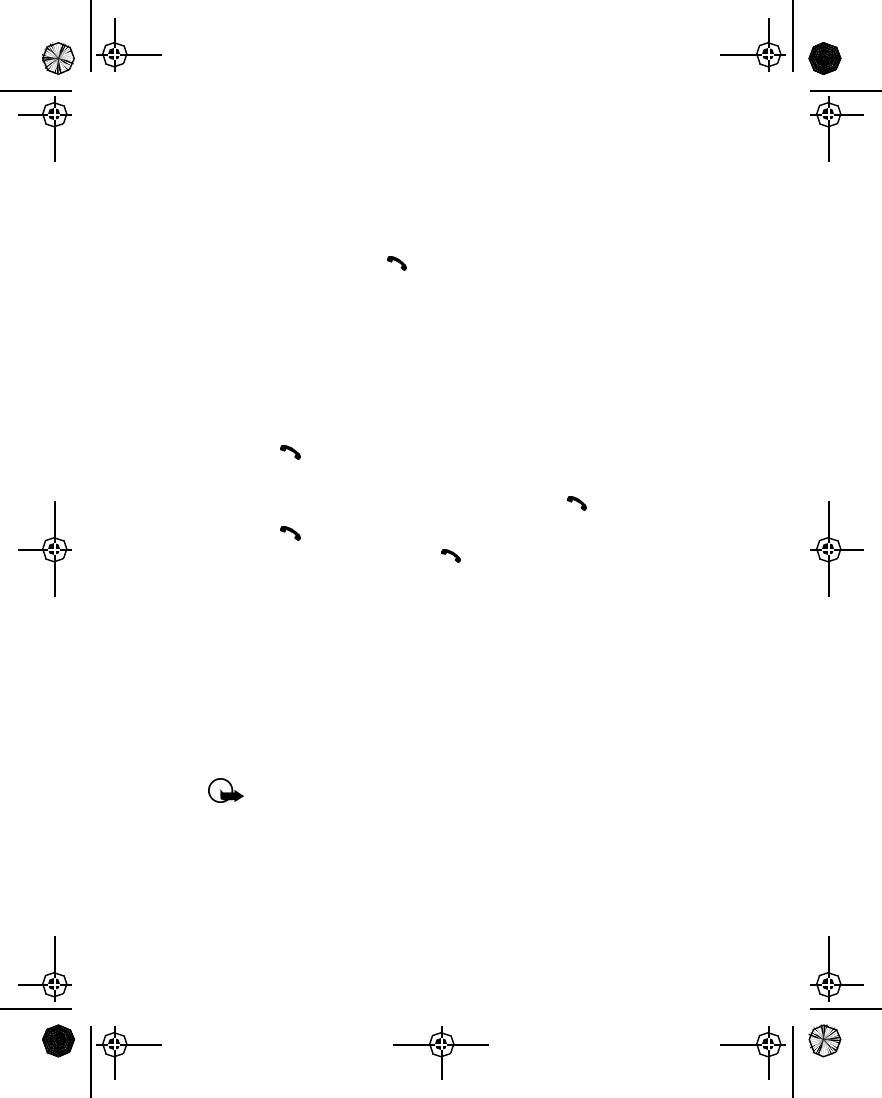
[ 39 ]
Phone book
• RECALL NAMES AND NUMBERS
1At the Start screen, press Names.
2Select Find and enter one or two letters of name you want to recall.
3Press OK, then press to dial the number.
You may have to scroll to the appropriate entry in a list if you have
stored names that are similar to each other.
Recall information with shortcuts
You may want to use some of these shortcuts, or alternate methods for
recalling a number.
•Press Names, enter the first letter of the name, scroll to the name, and
press to dial the number.
•At the Start screen, press the scroll keys to enter your list of names,
scroll to the name you want to dial, and press .
•Press to access a list of your last ten dialed calls, scroll to the one
you want to dial, then press again.
• EDIT A NAME OR NUMBER
You can edit a name, a number, or both.
1Recall the name or number you wish to edit.
2Press Details, then press Options.
3Scroll to Edit and press Select.
4Edit the name or number and press OK.
Important: If you have selected the Name+number phone book
view, you will not need to press Details.
EN1260.2_Sept_02.book Page 39 Friday, September 6, 2002 4:39 PM
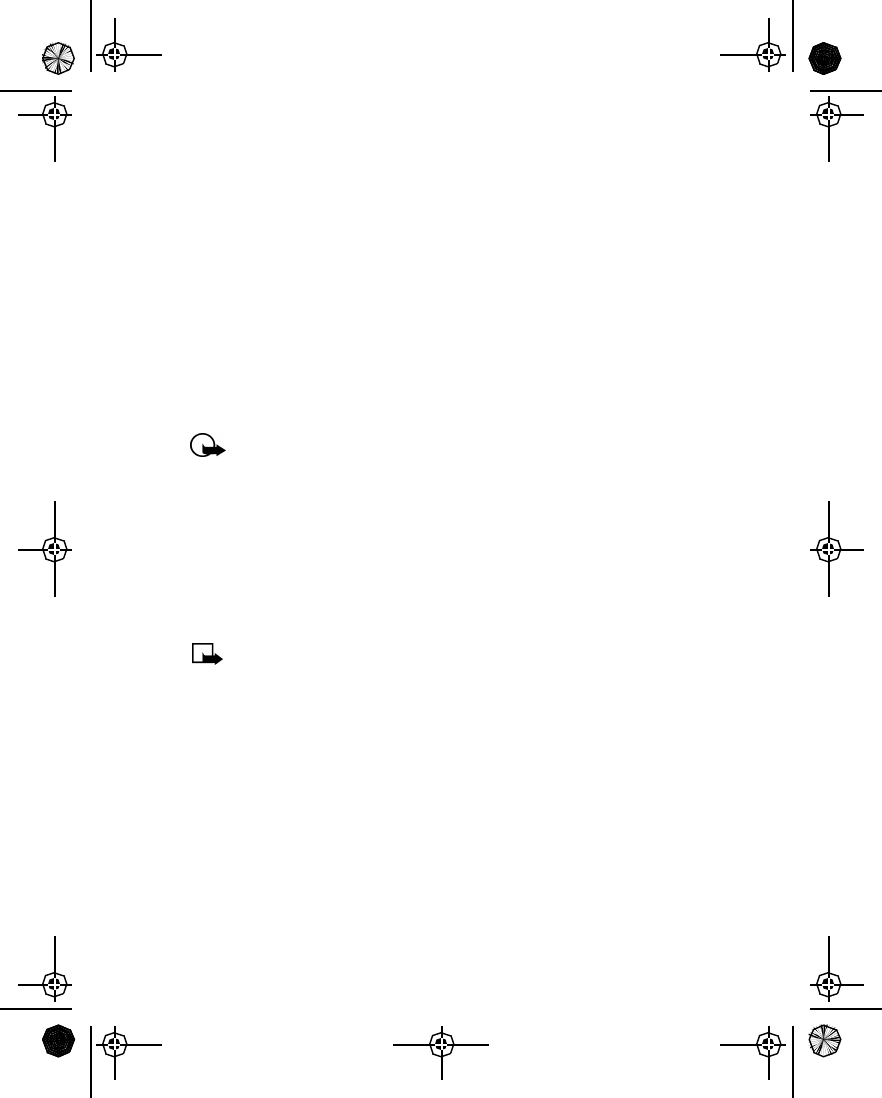
[ 40 ]
• ERASE NAMES AND NUMBERS
Erasing stored names and numbers removes them from your phone.
Once you erase an item, you can restore it only by re-entering it.
Individual entries
1Recall the phone book entry you want to erase.
2Press Details, then press Options.
3Scroll to Erase, and press Select.
The message Erase? appears.
4Press OK.
Important: If you have selected the Name+number phone book
view, you will not need to press Details.
Entire contents
1Press Names, scroll to Erase all, and press Select.
2Scroll to Erase all and press Select.
3When you see the message Are you sure?, press OK.
4Enter your security code and press OK.
For information on your security code, see “Understand the
security code” on page82.
• CUSTOMIZE YOUR PHONE BOOK VIEW
You can change how the information in your phone book looks on your
screen. There are three different ways to view your phone book. In all
views, you can use the scroll keys to move up and down through the list
of names.
EN1260.2_Sept_02.book Page 40 Friday, September 6, 2002 4:39 PM

[ 41 ]
Phone book
Select your scrolling view
To change the way you view names and numbers in your phone book:
1Press Names.
2Scroll to Options and press Select.
3At Phone book view, press Select.
4Scroll to the view you want and press Select.
Important: If you have selected the Name+number phone book
view, you will not need to press Details when working with phone
book options.
• CHECK MEMORY STATUS
You can check how much of your phone book’s memory is free and how
much has been used.
1Press Names and scroll to Options.
2Press Select.
3Scroll to Memory status and press Select.
Choice What it does
Name list Displays three names on the screen at a time.
Name+number Only one name and its corresponding number appears
on the screen at a time.
Name only Displays individual names only. You can view the
corresponding phone number by pressing Details and
then scrolling up or down.
EN1260.2_Sept_02.book Page 41 Friday, September 6, 2002 4:39 PM

[ 42 ]
6Call log
Your phone provides a call log that registers
information about calls you make and receive.
The call log keeps track of the following:
•Missed calls
•Received calls
•Dialed calls
Note: This function only works in digital networks and only when
caller ID is enabled.
• CALL LOG OPTIONS
When you view the missed calls, received calls, or dialed calls list and
press Options, the following choices may appear.
Note: Not all options will appear each time. Also, the order of
options may vary.
Choice What it does
Call time Shows the time when the call was connected. (You
must first set the phone’s clock)
Send message Allows you to write a short text message to the
person who called you or to whom you called.
Edit number Allows you to edit the displayed number and save it
with a name to your phone book.
Save Allows you to enter a name for the number and save
both to your phone book.
Erase Allows you to delete the number from the call list.
EN1260.2_Sept_02.book Page 42 Friday, September 6, 2002 4:39 PM
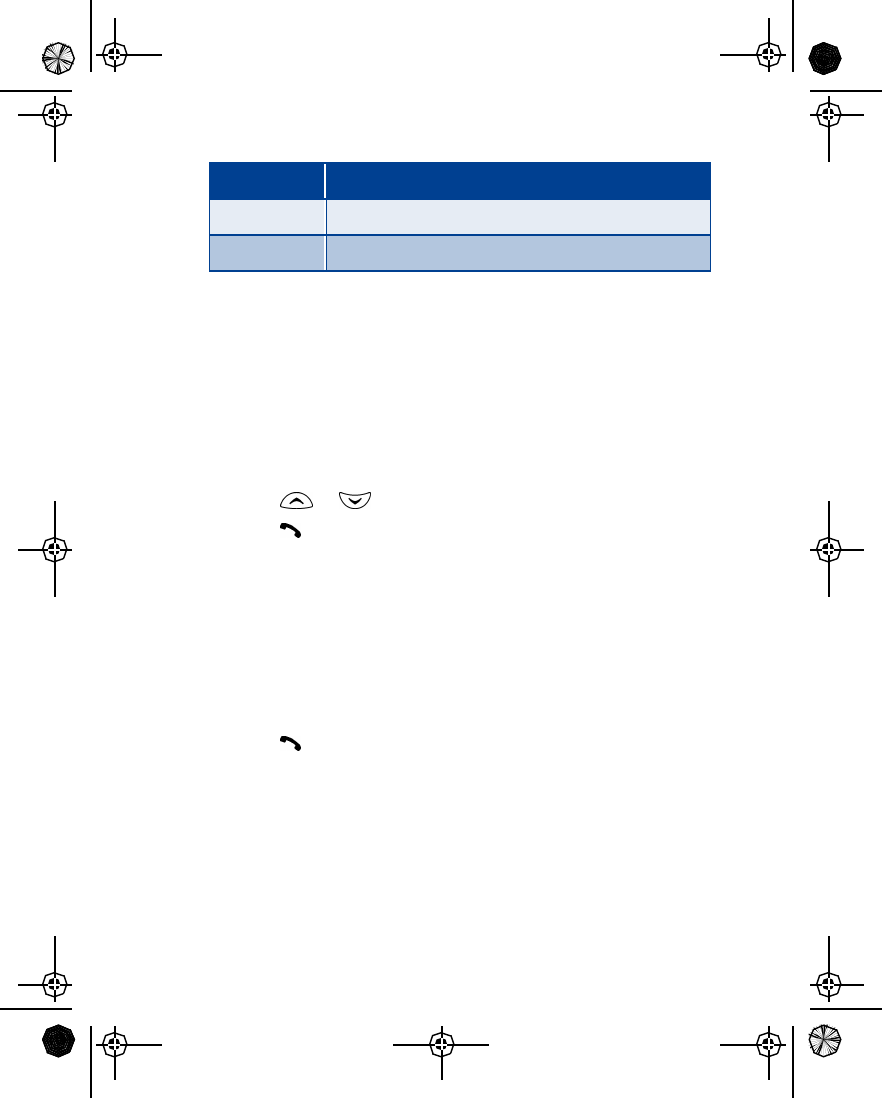
[ 43 ]
Call log
• CHECK MISSED CALLS
If you do not answer a call, the message Missed calls appears on your
phone’s screen, along with the number of calls missed. Your phone stores
the last ten numbers associated with calls you have missed.
To check missed calls:
1Press Menu 2-1 (Menu > Call log > Missed calls).
2The phone displays a list of the numbers of the calls you missed.
3Press or to scroll through the list.
4Press if you want to dial the number.
• CHECK RECEIVED CALLS
Your phone stores the last ten numbers associated with calls that you
have answered. To check this list of numbers:
1Press Menu 2-2 (Menu > Call log > Received calls).
2Scroll through the list of received numbers and highlight your
selection.
3Press if you want to dial the number.
View number Allows you to view the number.
Call Dials the number from the call log.
Choice What it does
EN1260.2_Sept_02.book Page 43 Friday, September 6, 2002 4:39 PM
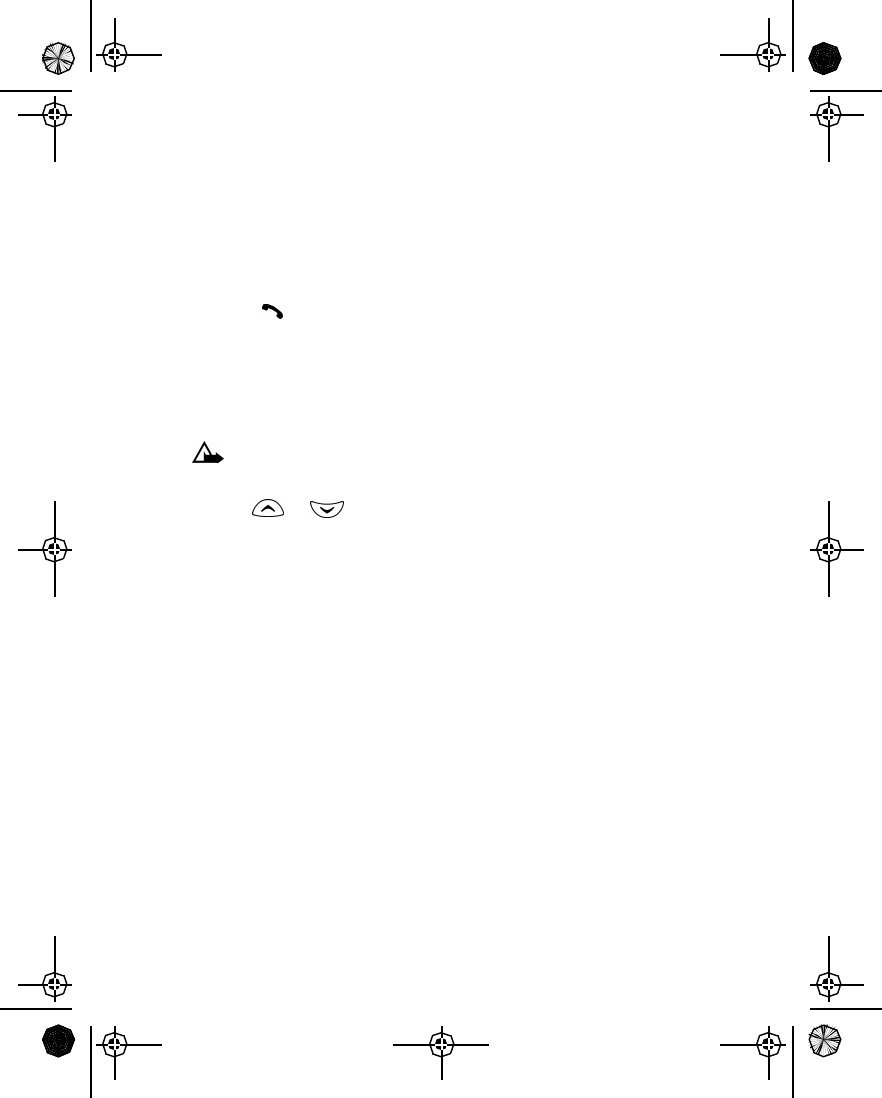
[ 44 ]
• CHECK DIALED CALLS
Your phone stores the last ten numbers associated with calls that you
have dialed. To check this list of numbers:
1Press Menu 2-3 (Menu > Call log > Dialed calls).
2Scroll through the list of dialed numbers and highlight your selection.
3Press if you want to dial the number.
Clear call lists
Your phone uses call lists to track numbers for incoming, outgoing, and
missed calls. You can erase some or all of the numbers that appear in the
call log.
Caution: You cannot undo this operation.
1Press Menu 2-4 (Menu > Call log > Clear call lists).
2Use or to scroll through the options list.
The list includes: All, Missed, Received, and Dialed.
3Stop at the appropriate option and press Select.
The All option clears every number in every list, whereas the other
options clear only the numbers associated with that option. For example,
the Dialed option clears only the numbers associated with calls you
previously dialed.
EN1260.2_Sept_02.book Page 44 Friday, September 6, 2002 4:39 PM
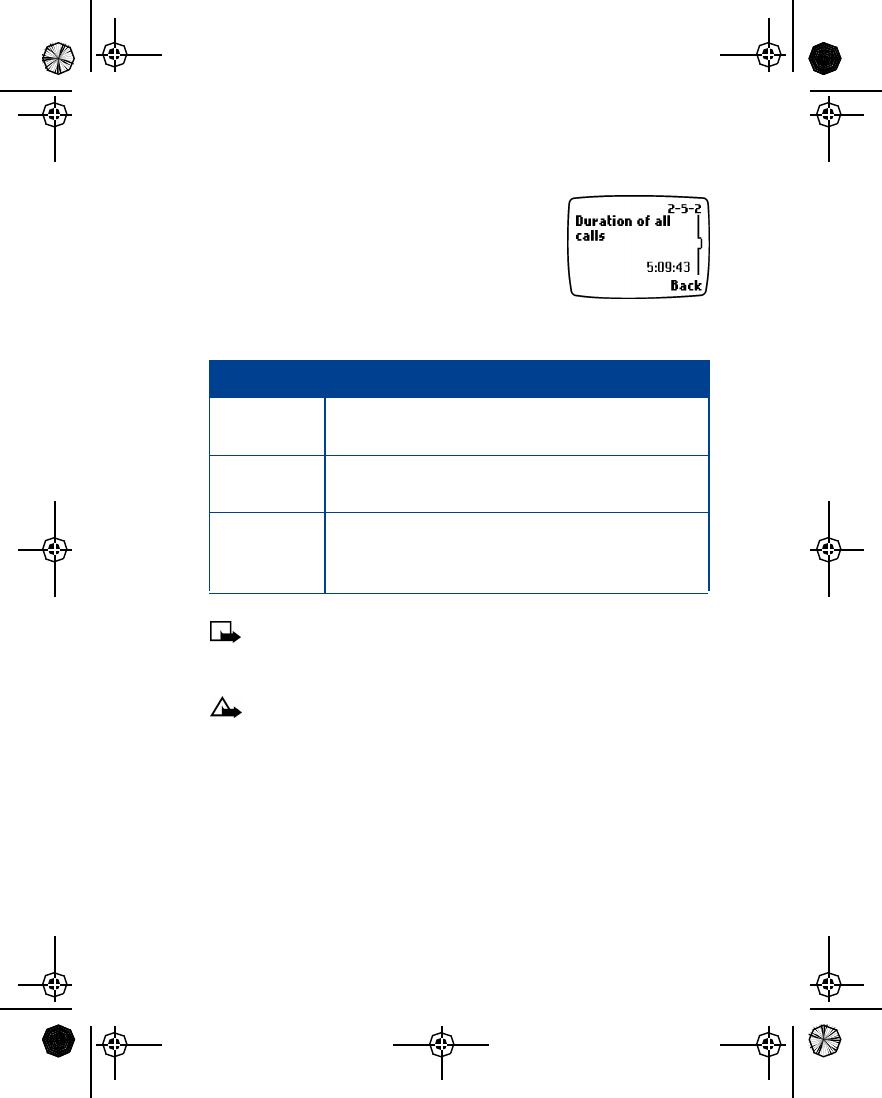
[ 45 ]
Call log
• USE CALL TIMERS
Your phone tracks the amount of time you spend
on each call. To obtain information about time
spent on phone calls:
1Press Menu 2-5 (Menu > Call log > Call
timers).
2Scroll through the options described below:
Note: The actual time invoiced for calls by your service provider
may vary, depending upon network features, rounding-off for
billing, and so forth.
Caution: If you select the Clear timers option, the action cannot
be undone. If you use the call timers to log the amount of time
spent on calls, you may want to record the information in the call
timers before you clear them.
Option What it does
Duration of
last call Shows the call duration of the last call.
Duration of
all calls Shows the call duration of all calls that have been
made and received since you reset the timers.
Clear timers Clears all call timers for the currently selected phone
number. Your phone includes separate timers for each
number used.
EN1260.2_Sept_02.book Page 45 Friday, September 6, 2002 4:39 PM
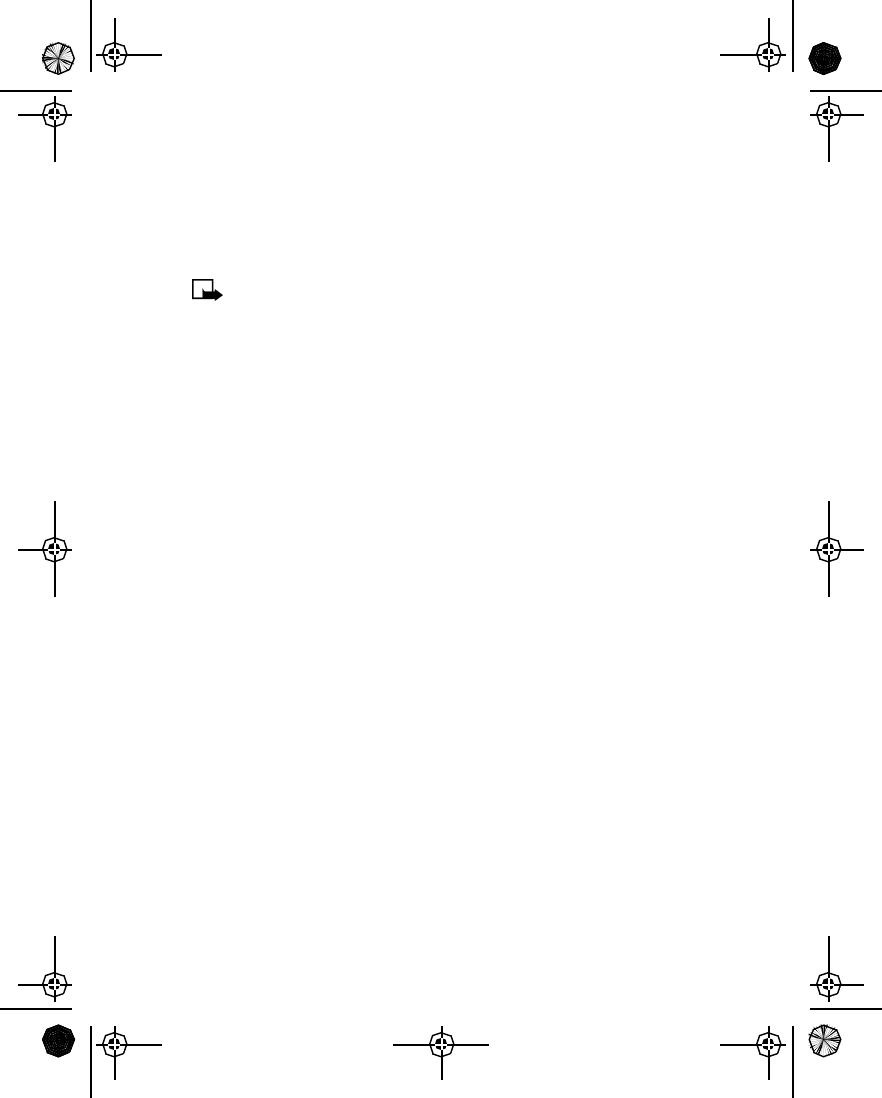
[ 46 ]
Clear call timers
1Press Menu 2-5-3 (Menu > Call log > Call timers > Clear timers).
The Security code box appears.
2Enter your security code and press OK.
For information on your security code, see “Understand the
security code” on page82.
Turn on a current call timer
You can set your phone to show the running elapsed time while a call
is active.
1Press Menu 4-2-2 (Menu > Settings > Call settings > Current
call timer).
2Scroll to On and press Select.
From this point on, the timer is active during each call you make or
receive. The time appears on the phone’s screen.
3After a call has ended, press any key on the phone’s keypad to clear
the current call time from the screen.
EN1260.2_Sept_02.book Page 46 Friday, September 6, 2002 4:39 PM

[ 47 ]
Messages
7Messages
You can use mobile messages to keep in touch
with friends, family and business associates.
Your phone allows you to do the following:
•Voice mail
•Send and receive text messages
•Send and receive picture messages
•Communicate with e-mail
Not all messaging features are available in all wireless networks. Contact
your service provider for availability and subscription information.
• VOICE MAIL
Voice mail provides a way for callers who miss
you to leave a message that you can retrieve
later. To use voice mail, you must sign up for the
feature with your wireless service provider.
Check for messages
Your phone beeps when you receive a voice
message. Also, the message New voice message appears on your phone’s
screen, along with the icon.
If you receive more than one voice mail message, your phone may show the
number of messages that you have received. The wireless network
provider determines the type of indication you will receive.
Note: To use voice mail, you need to learn the voice mail system’s
various greetings, passwords, and prompts. Your service provider
can provide instructions.
EN1260.2_Sept_02.book Page 47 Friday, September 6, 2002 4:39 PM
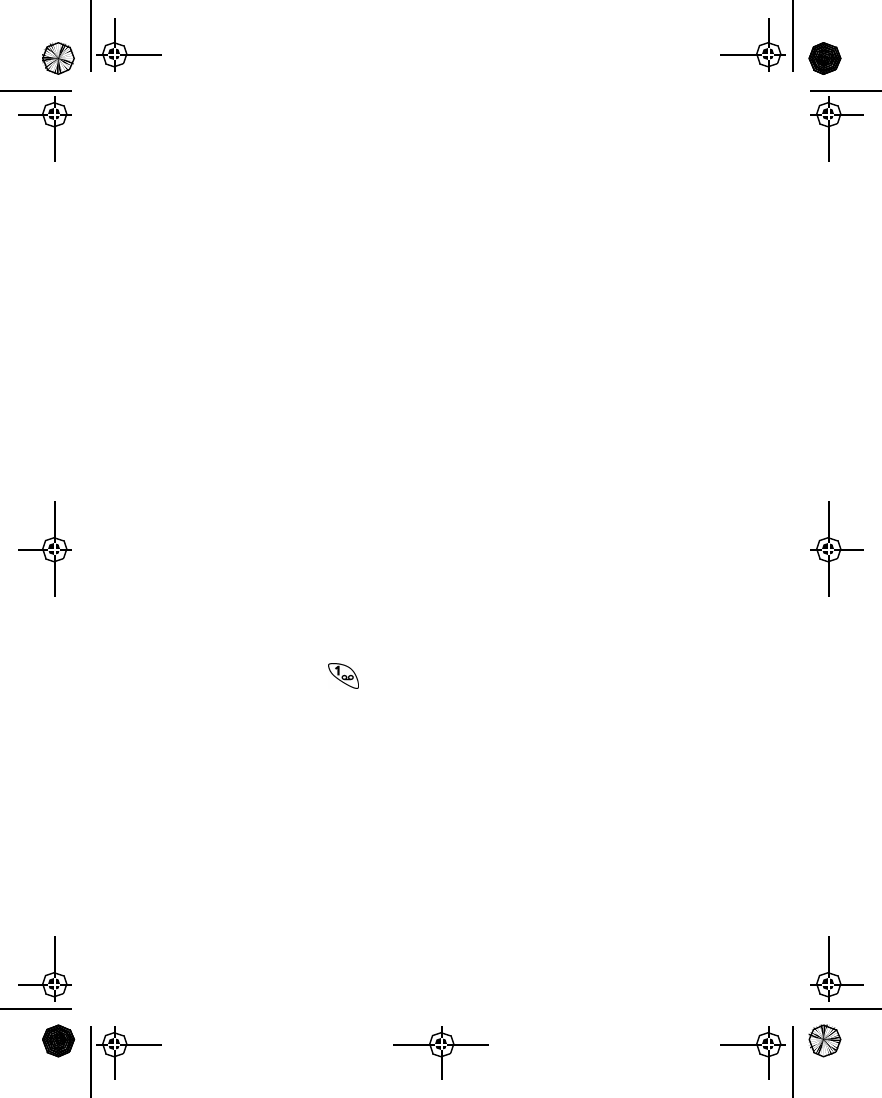
[ 48 ]
Save the voice mailbox number
As part of your network’s voice mail feature, your service provider gives
you a voice mailbox phone number. Save this number in your phone to
make getting your voice messages quick and convenient.
1Press Menu 1-8-2 (Menu > Messages > Voice messages > Voice
mailbox number).
2Enter your voice mailbox phone number.
3Press OK.
Your voice mailbox number can be up to 32 digits long and is used until
you change it. Therefore, if your phone number changes, the voice mail
number will probably change also. For further information, contact your
service provider.
Listen to your voice messages
The way you listen to your voice messages depends on your service provider.
Call your service provider if you have any questions.
1When your phone alerts you to new voice messages, press Listen and
follow the instructions given on the phone.
2If you’d rather listen to your messages later, press Exit.
3To listen to your voice messages:
Press and hold .
OR
Press Menu 1-8-1 (Menu > Messages > Voice messages > Listen to
voice messages).
Follow the prompts to review your messages.
EN1260.2_Sept_02.book Page 48 Friday, September 6, 2002 4:39 PM
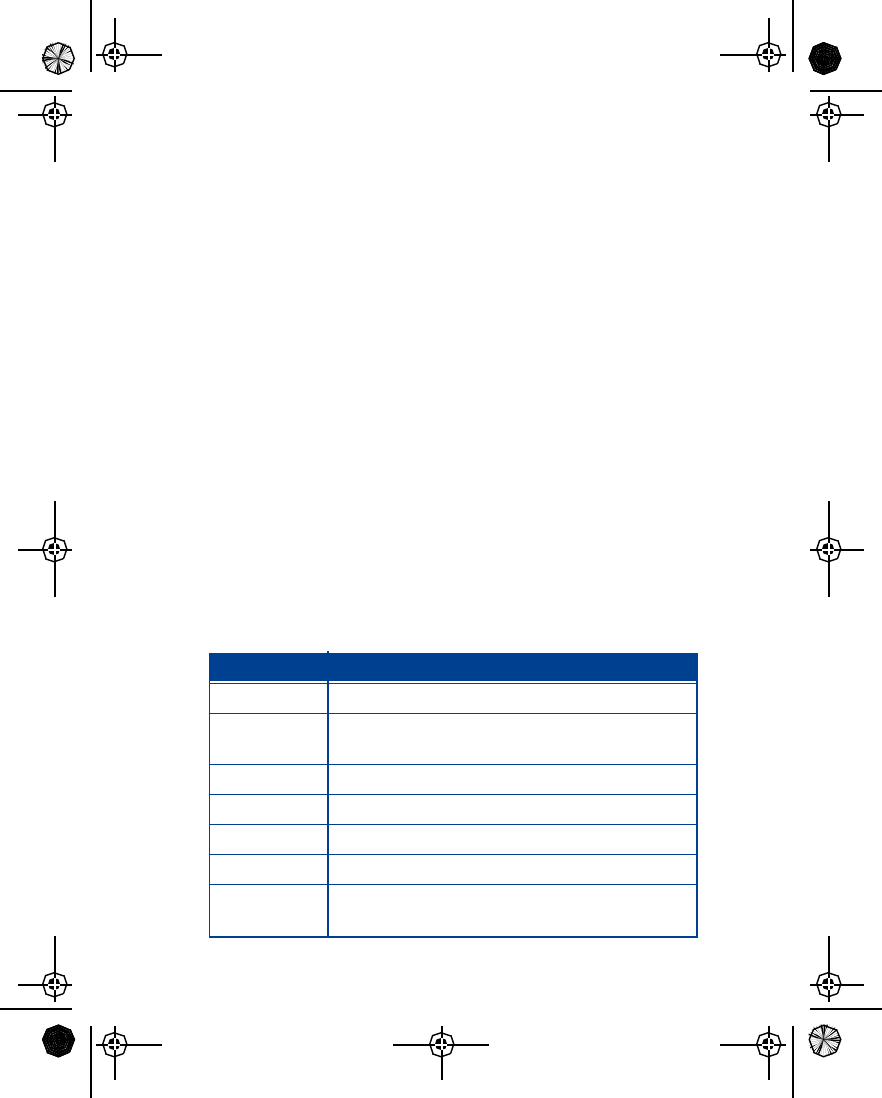
[ 49 ]
Messages
• TEXT, E-MAIL AND PICTURE MESSAGES
Your phone is capable of a variety of messaging services including text
messages (SMS or Short Message Service), picture messages, and e-mail
messages. Messaging services are network dependent features. Consult
your service provider for information.
Understand messaging
Message recipients: The phone to which you send a text message must
support text messages. The recipient may not receive the SMS text message
you send if the recipient’s account is with a different service provider or
of a different protocol.
Message length: The maximum length of a sent or received message is
160 characters. Your phone has space for several messages, depending on
the length of each message. The maximum length of a message also may
depend on the capabilities of the network from which the message
originated.
Options when working with messages
There are several options available when working with text, picture and
e-mail messages. The order and availability of options may vary
depending on the messaging function and your service provider.
Option Description
Send Attempts to send the text message to the recipient.
Settings Allows you to set Urgent, Read receipt, Reply req.,
and Callback no. options for the message.
Save Saves the message in the archive folder.
Clear text Clears the text in the message editor.
Exit editor Takes you back to the Write message menu.
Predictive text Allows you to turn predictive text on and off.
Insert word If predictive text (T9) is activated, you can manually
spell a word and insert it into your message.
EN1260.2_Sept_02.book Page 49 Friday, September 6, 2002 4:39 PM
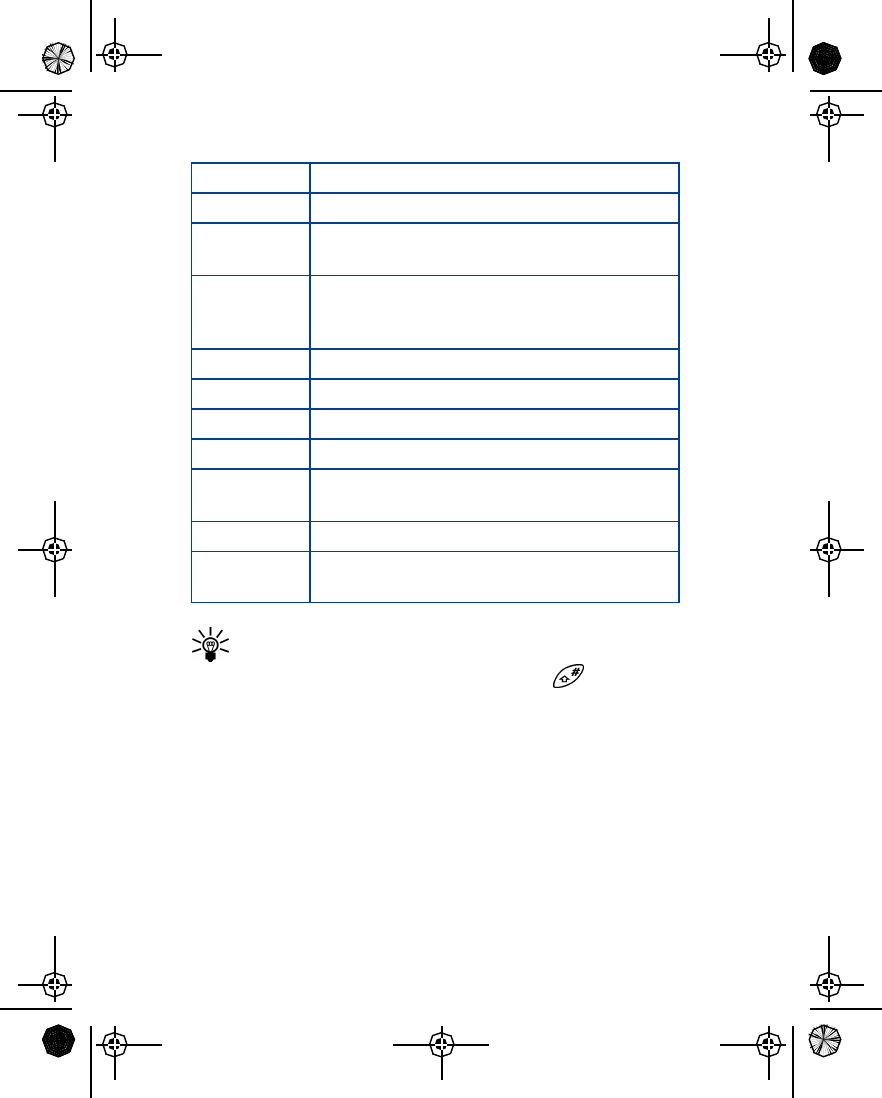
[ 50 ]
Tip: When writing messages, you can switch between uppercase
and lowercase standard text input and uppercase and lowercase
predictive text input by repeatedly pressing .
Organize messages using folders
Your phone has folders for managing text messages. Text message folders
are located under the Messages menu.
THE INBOX FOLDER
The inbox stores messages you receive. Messages remain in the inbox until
you delete them or save them in the archive folder. You can forward or
reply to messages in your inbox.
Insert number Allows you to insert numbers into the message.
Insert symbol Allows you to access the list of special characters.
Matches Lists alternative word choices while using
predictive text.
Details Available when viewing a picture message. This
option allows you to view the name and number of
the sender.
Preview Previews your picture message before sending.
Edit text Allows you to add text to a picture message.
Erase Allows you to erase a picture message.
Forward Allows you to forward a picture message.
Use number Allows you to use the number associated with a
picture message.
Edit recipient Allows you to edit the e-mail address.
Edit subject Allows you to edit the subject of an e-mail
message.
EN1260.2_Sept_02.book Page 50 Friday, September 6, 2002 4:39 PM

[ 51 ]
Messages
THE OUTBOX FOLDER
The outbox stores messages you have written, sent, edited and forwarded.
Messages in the outbox are not saved messages. As you send new
messages, old messages will automatically be removed from the outbox.
If you want to save a message you have sent, read the message while it is
in the outbox and use the options menu to save it to the archive folder.
THE ARCHIVE FOLDER
The archive folder stores messages you have saved. You can save
messages to the archive folder from the inbox and the outbox. You can
reply to or forward saved messages.
ERASE MESSAGES FROM FOLDERS
You can erase all messages located within a specific folder.
1Press Menu 1-6 (Menu > Messages > Erase all).
2Scroll to one of the following options, then press Select.
All read
Inbox
Archive
Outbox
3Enter your security code, then press OK.
Note: For information on your security code, see “Understand the
security code” on page82.
• TEXT MESSAGES
You can use your phone to send and receive
short text messages if your service provider
offers the message feature and if you subscribe to
the service.
EN1260.2_Sept_02.book Page 51 Friday, September 6, 2002 4:39 PM

[ 52 ]
Write and send a text message
When writing text messages, use the predictive text method for faster
text entry. For details, see “Write with predictive text” on page34.
1Press Menu, select Messages, then select Write message.
The message screen appears.
2Enter a message of up to 160 characters.
A counter in the upper right corner of the screen shows the number
of characters remaining.
3When you’ve finished writing the message, press Options, scroll to
Send, then press Select.
4Enter or recall the recipient’s phone number, then press Send.
Sending message appears.
Note: When sending messages via the SMS network service, your
phone may display the words “Message Sent”. This is an indication
that the message has been sent by your phone to the message
center number programmed into your phone. This is not an
indication that the message has been received at the intended
destination. For more details about SMS services, check with your
service provider.
Read a text message
When you receive a text message, the phone beeps and displays Message
received and the indicator in the upper left corner of the screen.
1Press Read to view the message.
2Use the scroll keys to view the whole message, if necessary.
3Once you’ve finished, press to return to the Start screen, or press
Options for other choices, such as Reply or Forward.
When the phone displays Message received, pressing Exit moves the new
message to the inbox, and returns you to the Start screen. To read the
message later, press Menu 1-3 (Menu > Messages > Inbox). If you have
EN1260.2_Sept_02.book Page 52 Friday, September 6, 2002 4:39 PM
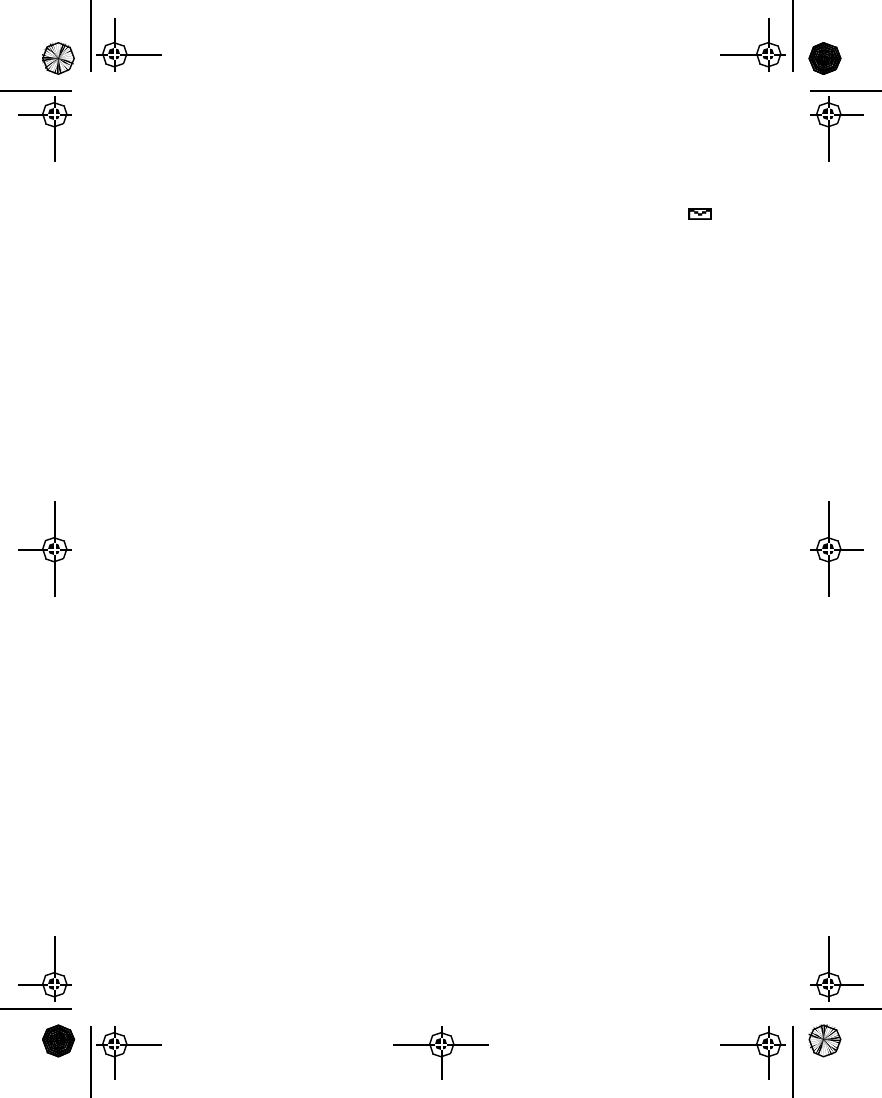
[ 53 ]
Messages
more than one new message, scroll to the message you want to view.
Messages in the inbox are listed in the order they are received, with the
most recent message listed first. Unread messages are indicated by .
Respond to a text message
There are many options available for working with text messages. For a
list of options and their descriptions, see “Options when working with
messages” on page49.
REPLY TO THE MESSAGE
1When reading the message, press Options.
2Scroll to Reply, then press Select.
3Choose to reply As message or As e-mail, then press Select.
When replying as e-mail, see “Send an e-mail message” on page56.
When replying as message, see “Write and send a text message” on
page52.
FORWARD THE MESSAGE
1When reading the message, press Options.
2Scroll to Forward, then press Select.
3Choose to forward As message or As e-mail, then press Select.
When forwarding as e-mail, see “Send an e-mail message” on
page56. When forwarding as message, see “Write and send a text
message” on page52.
SAVE A MESSAGE
1When reading the message, press Options.
2Scroll to Save, then press Select.
The message will be moved to the archive folder.
EN1260.2_Sept_02.book Page 53 Friday, September 6, 2002 4:39 PM

[ 54 ]
ERASE A MESSAGE
1When reading the message, press Options.
2Scroll to Erase, the press Select.
3Erase message? appears, press OK.
WHEN YOUR MEMORY IS FULL
When your phone’s message memory is full, one or more messages of the
lowest priority are automatically deleted. When you receive an emergency
message, messages may be deleted from any of your message folders.
If you have more messages waiting at the network, blinks on the
Start screen. You can erase old messages to create space for new
messages.
• PICTURE MESSAGES
Your phone offers five picture messages that
you can use to send pictures and text to your
friends and family. You can also save a new
picture by replacing an existing picture. For
possible message options, see “Options when
working with messages” on page49.
Each picture message is made up of several text messages. Therefore,
sending one picture message may cost more than sending one text
message. Contact your service provider for pricing information.
Note: This function can be used only if it is supported by your
network operator or service provider. Only phones that offer
picture message features can receive and display picture messages.
Note: The actual invoice for calls and services from your service
provider may vary, depending upon network features, rounding-off
for billing, taxes, and so forth.
EN1260.2_Sept_02.book Page 54 Friday, September 6, 2002 4:39 PM

[ 55 ]
Messages
Send a picture message
1Press Menu 1-7 (Menu > Messages > Picture Messages).
2Scroll to the picture you want to send. Press Show.
The picture appears. To choose a different picture, press Back and
scroll to another picture.
3Press Options and scroll to Edit text. Add a text message to send with
the picture.
After you enter the text, you have several options. To view a list of
possible options, see “Options when working with messages” on
page49.
4To send the picture and message, press Options.
5Scroll to Send, then press Select.
6Enter or recall the recipient’s phone number, then press Send.
Sending message appears.
PREVIEW A PICTURE MESSAGE BEFORE SENDING
After writing text for your picture message, you can preview the message
before sending it.
1Press Options.
2Scroll to Preview, then press Select.
3After viewing the message, press Back.
Receive a picture message
1When your phone displays Picture message received, press Show and
the message appears.
2If the picture has a text message with it, scroll up or down to see the
entire message.
EN1260.2_Sept_02.book Page 55 Friday, September 6, 2002 4:39 PM
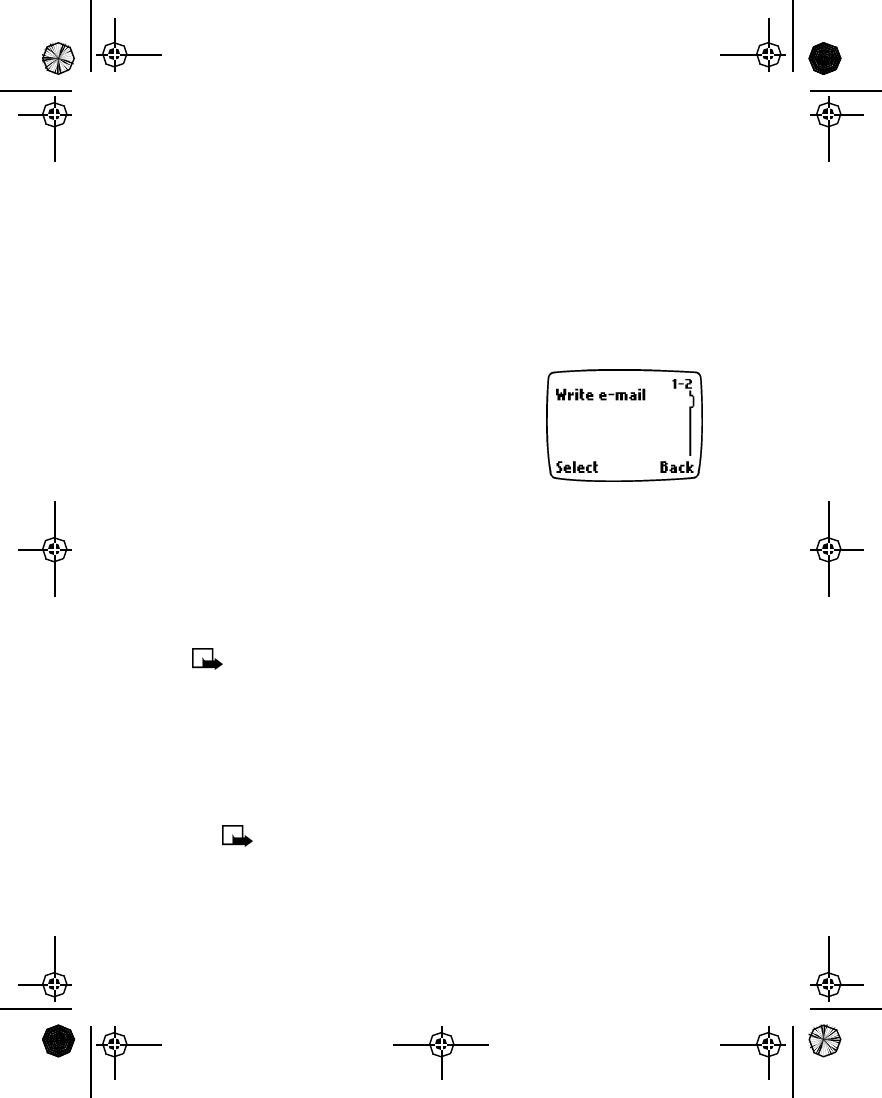
[ 56 ]
Save a picture message
1Press Show to view the message.
2Press Save.
You will have the option to replace a current message.
3Scroll to the picture you want to erase, then press Replace.
• E-MAIL MESSAGES
You can send e-mail up to 160 characters in
length to anyone with an
e-mail address.
•Messages sent to you by e-mail arrive as
regular text messages. You can use all the
options described earlier to save, reply to, or
forward a message.
•Contact your service provider to get the e-mail address and gateway
number for your phone, and for more information on using e-mail.
Send an e-mail message
1Press Menu 1-2 (Menu > Messages > Write e-mail).
Note: If you get a prompt asking you to enter your e-mail gateway
number, you must obtain this number from your service provider.
2At the prompt, enter your recipient’s e-mail address or press Find to
look through and select a saved e-mail address from your phone list.
Press OK.
3At the prompt, enter a subject for your e-mail message. (You are not
required to enter a subject.) Press OK when you are finished.
Note: Predictive text is not available when entering an e-mail
address or a subject line for your e-mail.
EN1260.2_Sept_02.book Page 56 Friday, September 6, 2002 4:39 PM

[ 57 ]
Messages
4A screen will appear allowing you to enter the text of your message.
Your total message, including the address and subject line, can be up
to 160 characters. There is a running total of remaining characters in
the top right corner of the screen.
5After you finish entering the text of your e-mail, press Options and
scroll to Send, then press Select.
Receive an e-mail message
When you receive an e-mail message, the phone makes a sound and
displays Message received and the indicator in the upper left corner
of the screen.
To read the message, press Read.
When reading a received e-mail message, you can choose other options,
such as Reply and Forward. See “Options when working with messages”
on page49.
Edit an existing e-mail message
You can edit an e-mail message by replying to the message or forwarding
it. You can edit messages from any folder.
Reply to an e-mail message
1When reading the message, press Options.
2Scroll to Reply, then press Select.
3Choose to reply As message or As e-mail, then press Select.
When replying as e-mail, see “Send an e-mail message” on page56. When
replying as message, see “Write and send a text message” on page52.
EN1260.2_Sept_02.book Page 57 Friday, September 6, 2002 4:39 PM

[ 58 ]
Forward an e-mail message
1When reading the message, press Options.
2Scroll to Forward, then press Select.
3Choose to forward As message or As e-mail, then press Select.
When forwarding as e-mail, see “Send an e-mail message” on page56.
When forwarding as a message, see “Write and send a text message” on
page52.
EN1260.2_Sept_02.book Page 58 Friday, September 6, 2002 4:39 PM
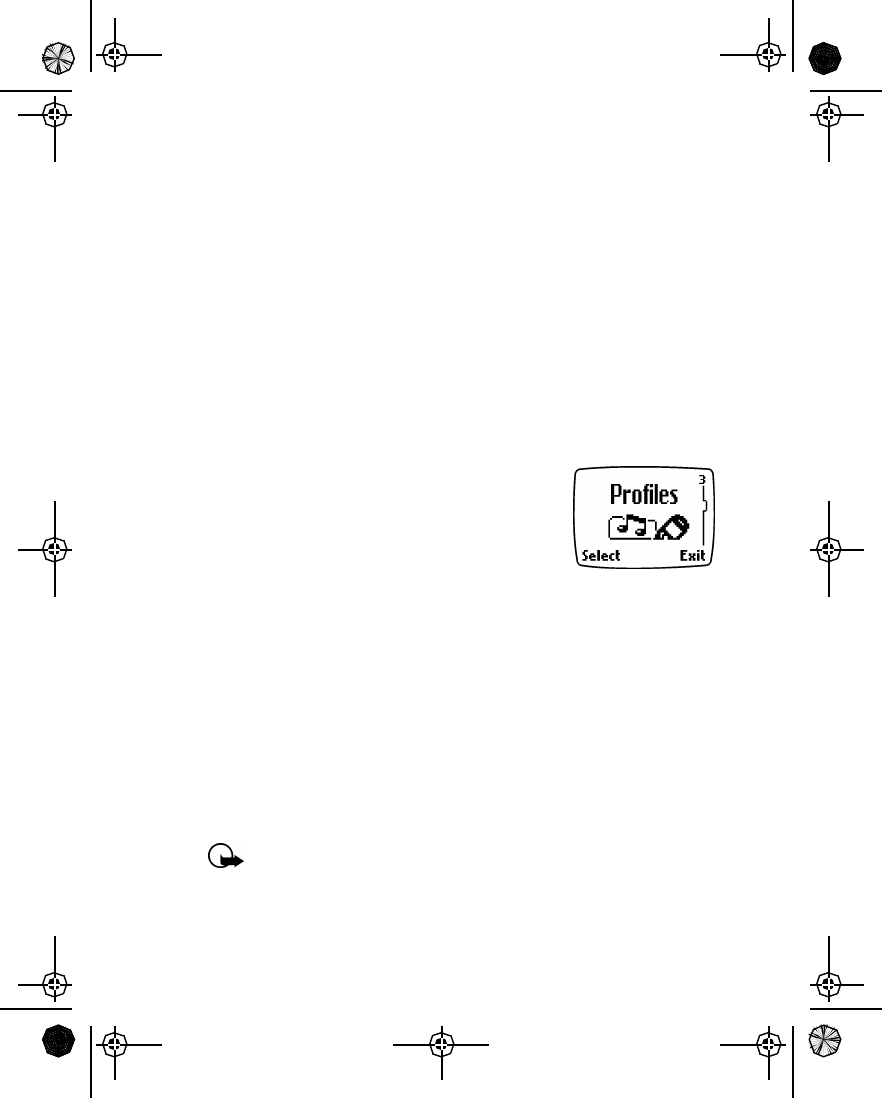
[ 59 ]
Personalization
8Personalization
The Nokia 1200 series can be easily customized to fit your lifestyle. The
display language, ringing tones, audio, and accessory settings (among
others) can all be modified to suit your needs.
Your phone has various profiles which allow you to customize ringing and
alert tones for different environments. Once you modify the profiles, you
can activate the profile that is appropriate for your surroundings. For
example, you can select the Silent profile while at the movies or select
the Outdoor profile when at a sporting event.
• PROFILES
Profiles let you set your phone’s sound settings to
match your environment, whether it’s a meeting or
a soccer game. Just pick the profile that suits your
current environment: Normal, Silent, Meeting,
Outdoor or Pager.
You can customize any of the profiles and set your
own preferences for the following settings:
•Ringing options
•Ringing tone
•Ringing volume
•Message alert tone
•Keypad tones
•Warning tones
•Profile name (not available in the Normal profile)
Important: You can select a default profile for each of these
accessories: Headset, Handsfree and Loopset. To learn more about
accessories, see “Accessory settings” on page63.
EN1260.2_Sept_02.book Page 59 Friday, September 6, 2002 4:39 PM
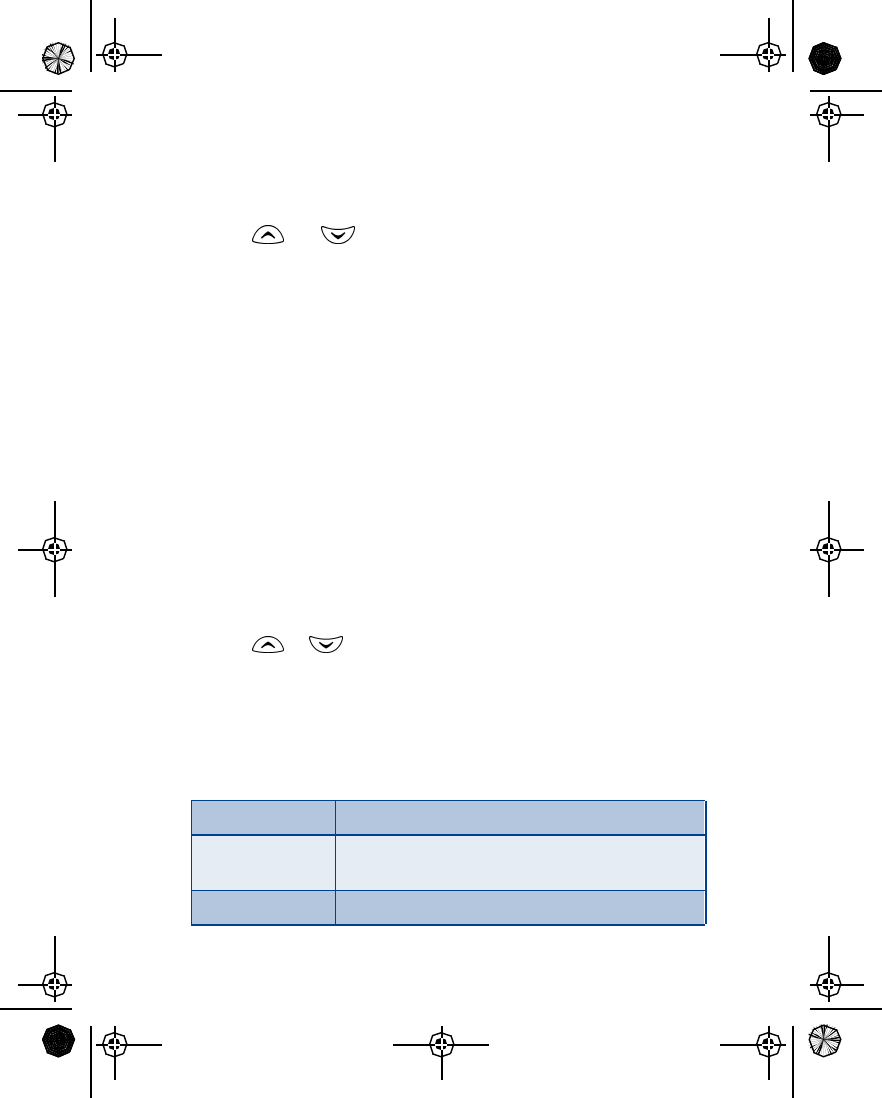
[ 60 ]
Select a profile
1Quickly press and release the Power key.
2Use and to move to the profile you want to use.
Profile names are highlighted as you scroll through them.
3Press Select to activate a profile.
Customize a profile
1Press Menu 3 (Profiles).
2Scroll to the profile you want to customize, then press Options.
3Scroll to Customize, then press Select.
4Use the scroll keys to display each of the profile options. Once you
find the option you’d like to customize, press Select.
SET THE RINGING OPTIONS
You can choose the type of ring your phone uses to notify you of an incoming
call. This setting does not affect any incoming text message alert tones.
1Press Menu 3 (Menu > Profiles).
Your phone lists each profile.
2Use or to scroll to the desired profile in the list for which
you want to set the ringing options, and press Options.
3Scroll to Customize and press Select.
4Scroll to Ringing options and press Select.
5Scroll to one of the ringing options, as described below, and press
Select.
Ring The phone rings normally.
Ascending Ringing volume increases (gets louder) if the phone
is not answered.
Ring once The phone rings once to indicate an incoming call.
EN1260.2_Sept_02.book Page 60 Friday, September 6, 2002 4:39 PM
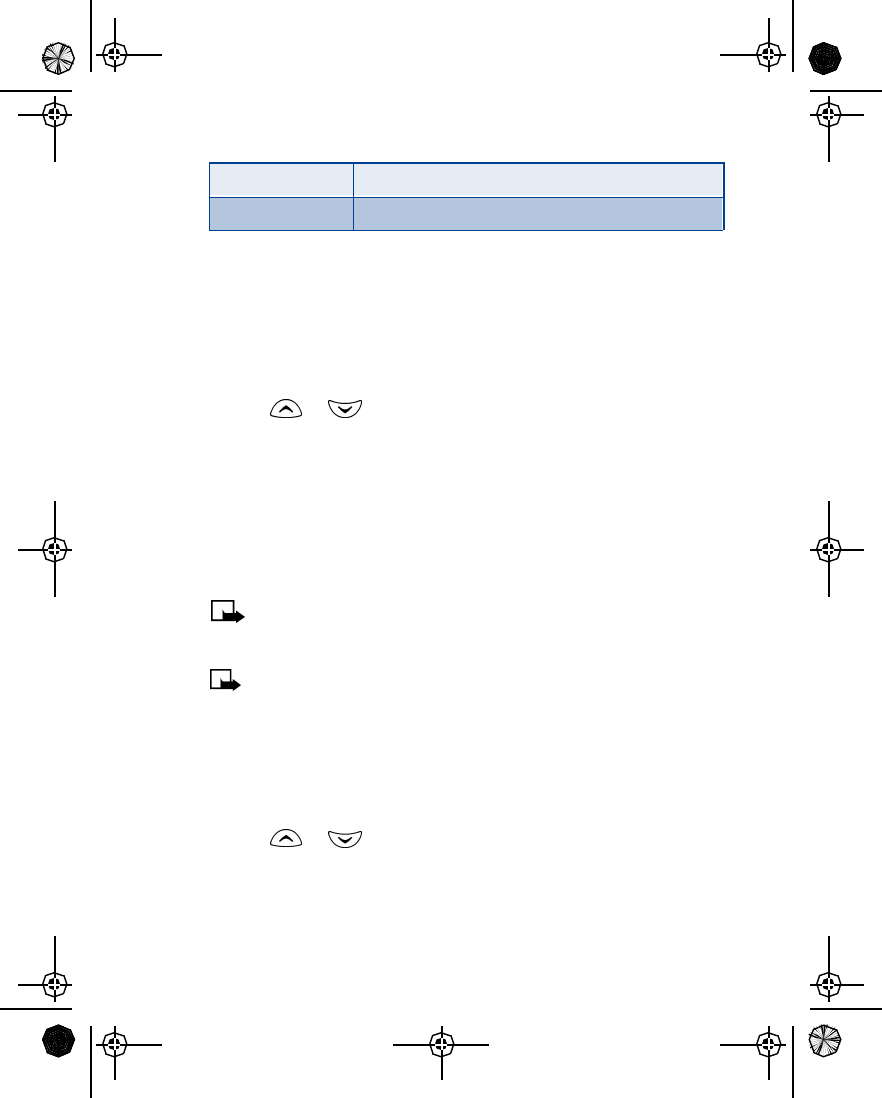
[ 61 ]
Personalization
SET THE RINGING TONE
The ringing tone is the sound your phone makes when you receive a call.
You can set the ringing tone to a specific sound or tune to personalize how
the phone rings.
1Press Menu 3 (Menu > Profiles).
Your phone lists each profile.
2Use or to scroll to the profile for which you want to set
the ringing tone.
3Press Options.
4Scroll to Customize and press Select.
5Scroll to Ringing tone and press Select.
6Scroll through the options, and when you hear the tone you want to
use, press Select.
Note: If you have already chosen a ringing option of either Silent
or Beep once, the ringing tones are already turned off. See “Set the
ringing options” on page60 for details.
Note: As you scroll through the ringing tones, you can listen to a
sample of each if your current ringing option is not set to Silent.
SET THE RINGING VOLUME
You can set the default ringing volume for incoming voice calls and message
alert tones.
1Press Menu 3 (Menu > Profiles).
2Use or to scroll to the profile you will set, and press
Options.
3Highlight Customize and press Select.
Beep once The phone beeps once to indicate an incoming call.
Silent The phone makes no sound.
EN1260.2_Sept_02.book Page 61 Friday, September 6, 2002 4:39 PM
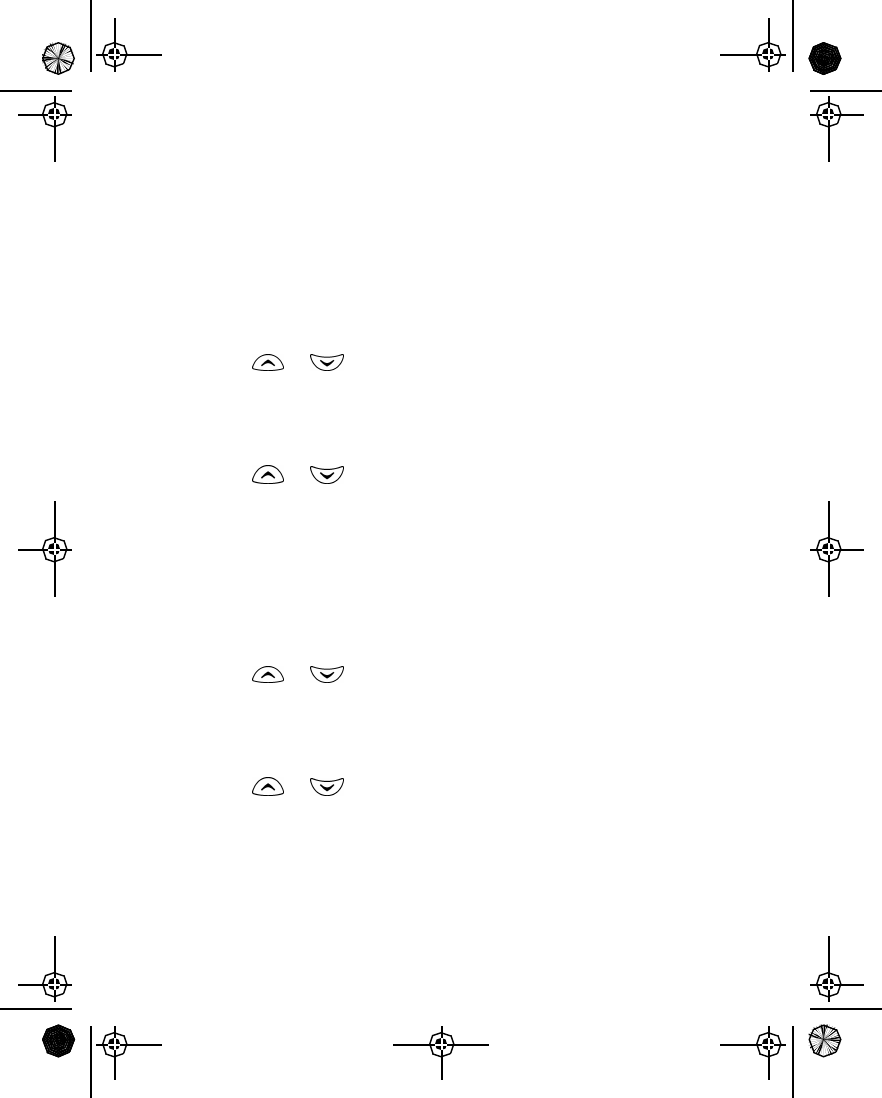
[ 62 ]
4Scroll to Ringing volume and press Select.
5Scroll through the options. When you hear the right volume level,
press Select.
SET THE MESSAGE ALERT TONE
You can set your phone to use a certain tone to indicate an incoming text
message.
1Press Menu 3 (Menu > Profiles).
2Use or to scroll to the profile for which you want to set
the message alert tone, and press Options.
3Select Customize and press Select.
4Scroll to Message alert tone, then press Select.
5Use or to scroll through your choices.
The phone plays samples of each choice as you scroll to it.
6When you find the tone you want, press Select.
SET KEYPAD TONES
Keypad tones set the volume of the tone you hear when you press your
phone’s keys.
1Press Menu 3 (Menu > Profiles).
2Use or to scroll to the profile for which you want to set
the keypad tones, and press Options.
3Select Customize and press Select.
4Scroll to Keypad tones and press Select.
5Use or to scroll to one of the levels and press Select.
•If you choose Off, no keypad tones are heard.
•If you chose the Silent profile in step 2, the keypad tones are
turned off.
EN1260.2_Sept_02.book Page 62 Friday, September 6, 2002 4:39 PM
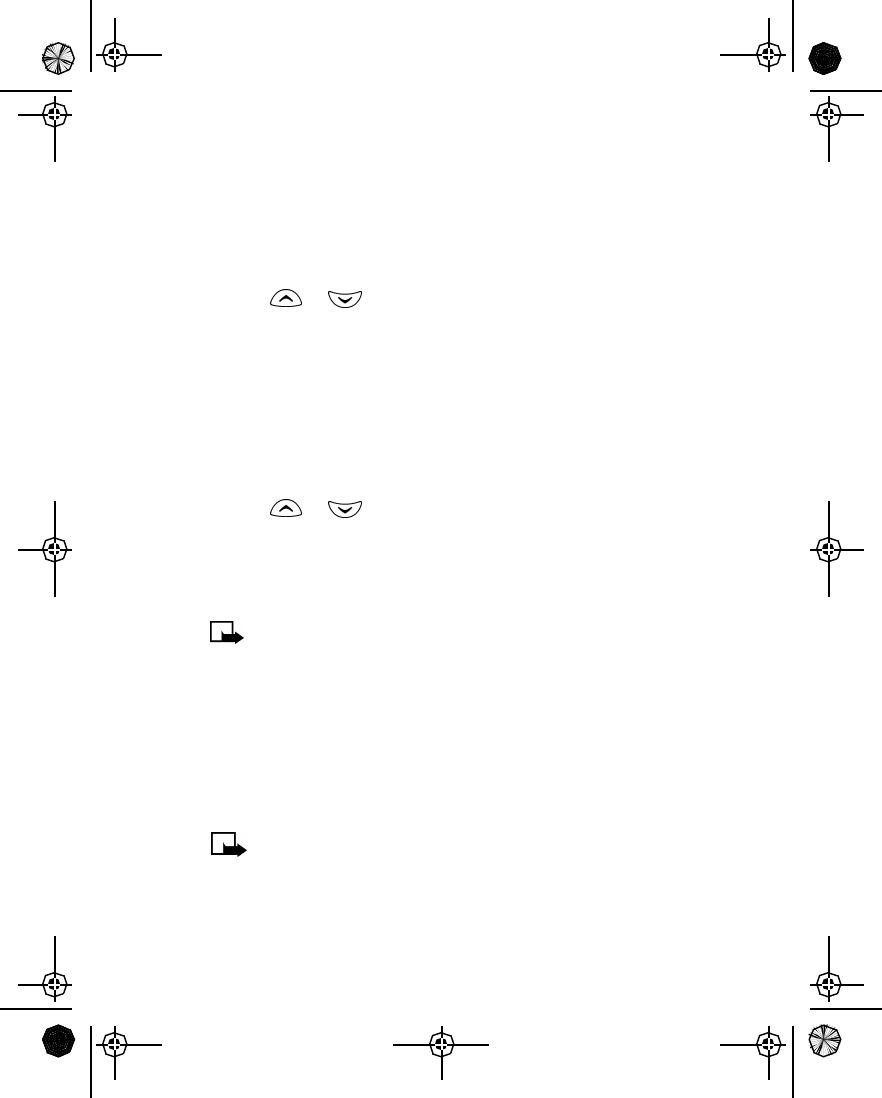
[ 63 ]
Personalization
SET THE WARNING TONES
Warning tones include the sounds your phone makes during error conditions,
during confirmations, when the battery is low, and when you need to
recharge the battery.
1Press Menu 3 (Menu > Profiles).
2Use or to scroll to the profile for which you want to set
the warning tones, and press Options.
3Select Customize and press Select.
4Scroll to Warning tones, then press Select.
5Scroll to On or Off and press Select.
Rename a profile
1Press Menu 3 (Menu > Profiles).
2Use or to scroll to the desired profile and press Options.
3Scroll to Customize, then press Select.
4Scroll to Profile name, then press Select.
5Enter the new name and press OK.
Note: You cannot rename the Normal profile.
Accessory settings
You can use your phone with these Nokia accessories:
•Headset (HDC-5, HDE-2, HDB-5)
•Handsfree Car kit (CARK125 and PPH-1)
•Loopset (LPS-3)
•TTY/TDD Adapter (HDA-9)
Note: You can select a default profile that will be associated with
each accessory, such as Normal. However, the Accessory settings
menu will not appear until after an accessory has been connected
to the phone at least once.
EN1260.2_Sept_02.book Page 63 Friday, September 6, 2002 4:39 PM
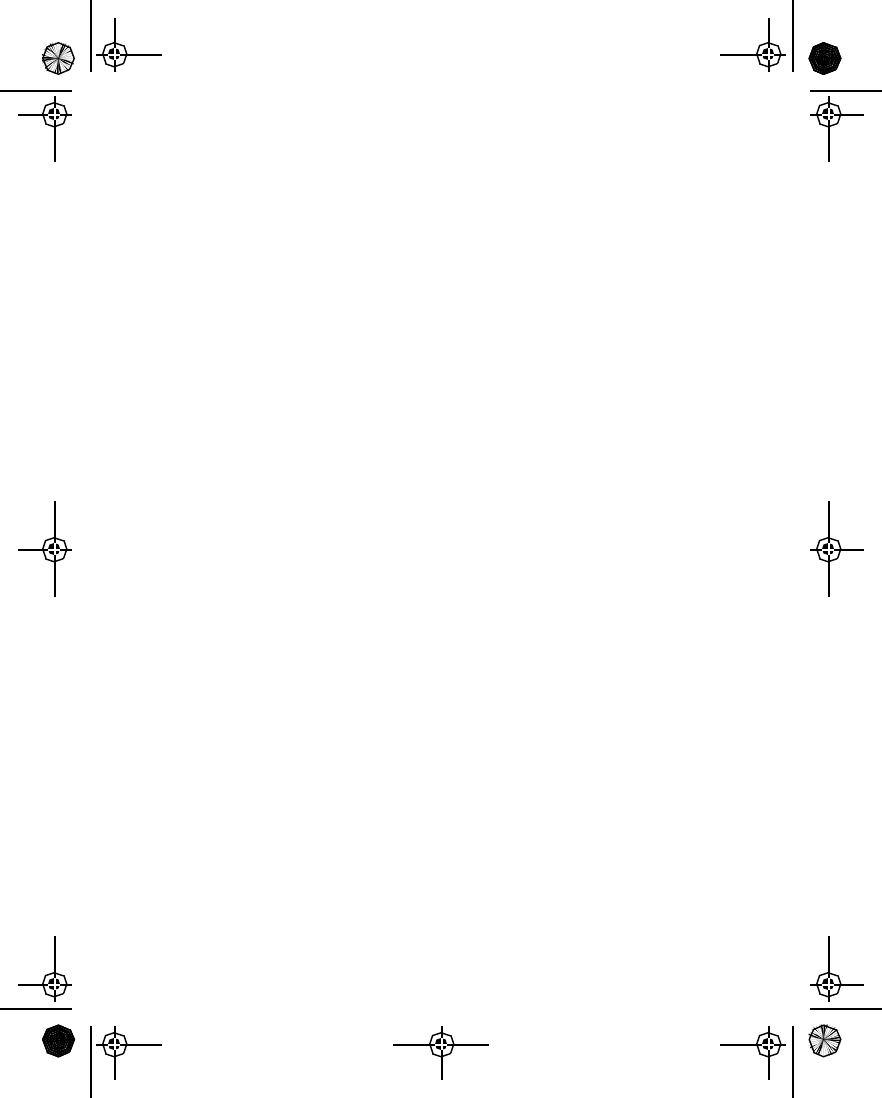
[ 64 ]
SET UP THE LOOPSET
When you want to use the loopset, you will have to activate the accessory
setting.
1Attach the loopset to the phone.
2Press Menu 4-4-3 (Settings > Accessory settings > Loopset).
3Scroll to Use loopset, then press Select.
4Scroll to Yes, then press Select.
AUTOMATIC ANSWER
This feature lets your phone answer incoming calls after just one ring
when an accessory is connected to the phone.
1Press Menu 4-4 (Settings > Accessory settings).
2Scroll to Headset, Handsfree, or Loopset, then press Select.
3Scroll to Automatic answer, then press Select.
4Scroll to On and press Select.
SET THE LIGHTS (CAR KIT ONLY)
When your phone is connected to a car kit, you have a choice of having
the phone lights on (a) continuously or (b) only when you use it.
1Press Menu 4-4-2-3 (Menu > Settings > Accessory settings >
Handsfree > Lights).
2Choose one of the following options, then press Select:
•On - The lights will remain on while the phone is connected to
the car kit.
•Automatic - The lights will turned on only when the phone is
being used.
EN1260.2_Sept_02.book Page 64 Friday, September 6, 2002 4:39 PM
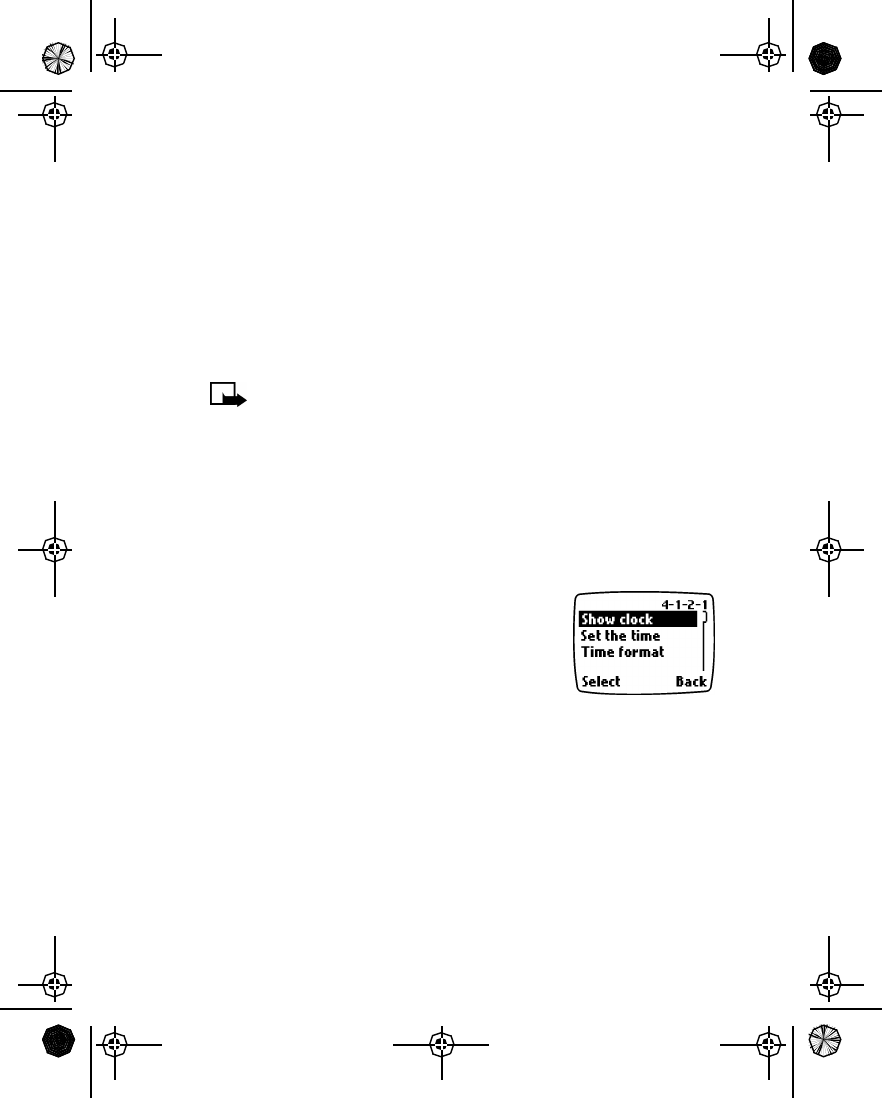
[ 65 ]
Personalization
SET THE DEFAULT PROFILE
When you use the headset, car kit or loopset, you have the option of
selecting a default profile. You can use the currently selected profile (for
example, Normal) or you can choose from the list.
1Press Menu 4-4 (Settings > Accessory settings).
2Scroll to Headset, Handsfree or Loopset, then press Select.
3Scroll to Default profile, then press Select.
4Scroll to the profile you want, then press Select.
The Active profile uses the current profile setting you have
selected for your phone.
Set the display language
You can choose your phone’s display language.
1Press Menu 4-3-1 (Settings > Phone settings > Language).
2Scroll to the language you want, then press Select.
Set the clock
Your phone contains a real-time clock that can be
set two different ways: the clock can use the time
information provided by the wireless system, or it
can be set manually. Once the time is set, you can
display the clock on the Start screen.
For added convenience, the clock is connected to
an alarm clock. See “Use the alarm clock” on page85 for additional
information.
SELECT THE TIME FORMAT
You can choose whether your clock shows time in an am/pm format or a
24-hour format.
1Press Menu 4-1-2-3 (Menu > Settings > Time settings > Clock >
Time format).
2Scroll to 24-hour or am/pm and press Select.
EN1260.2_Sept_02.book Page 65 Friday, September 6, 2002 4:39 PM

[ 66 ]
SET THE CLOCK USING AM/PM FORMAT
1Press Menu 4-1-2-2 (Menu > Settings > Time settings > Clock >
Set the time).
2Enter the time using an hh:mm format and press OK.
For example, to set your clock to 8:40, enter 08:40.
3Scroll to am or pm and press OK.
SET THE CLOCK USING 24-HOUR FORMAT
1Press Menu 4-1-2-2 (Menu > Settings > TIme settings > Clock >
Set the time).
2Enter the time using an hh:mm format and press OK.
For example, to set your clock to 8:40, enter 08:40 (for am) or 20:40
(for pm).
3Press OK.
Automatic update of time
You can set your phone to update the time from the network when you
turn the phone on. If the clock in your phone is 30 seconds or more off
the network time, the phone will automatically update to reflect the
network time.
Note: Auto update time is a network dependent feature. Contact
your service provider for details and availability.
1Press Menu 4-1-3 (Settings > Phone settings > Auto update of
time).
2Scroll to one of the following options, then press Select.
•On: Updates the time automatically.
•Confirm first: Requires you to confirm that you want the update.
You can accept or decline the update.
•Off: Prevents the time from being automatically updated.
EN1260.2_Sept_02.book Page 66 Friday, September 6, 2002 4:39 PM

[ 67 ]
Personalization
Display the clock
1Press Menu 4-1-2 (Settings > Time settings > Clock).
2Scroll to Hide clock or Show clock (only one choice appears,
depending on the current setting).
3Press Select.
Add a welcome note
You can add a welcome note that your phone displays briefly each time
you turn it on.
1Press Menu 4-3-3 (Settings > Phone settings > Welcome note).
2Enter a note, then press Options.
3Scroll to Save, then press Select.
To erase the welcome note, follow steps 1-2, scroll to Erase, then
press Select.
Restore factory settings
If you have made changes to your phone’s profiles (settings), you can
restore them to their original or factory settings. The memory, timers,
language selection, and security code are not reset. However, profile and
accessory settings are reset.
1Press Menu 4-3-4 (Menu > Settings > Phone settings > Restore
factory settings).
2At the prompt, enter your five-digit security code and press OK.
EN1260.2_Sept_02.book Page 67 Friday, September 6, 2002 4:39 PM

[ 68 ]
9Advanced calling features
This chapter covers advanced calling features, including:
•Options available while in an call.
•Managing two calls at the same time.
•Network services such as call forwarding
Not all features that are described are available in all wireless networks.
Contact your service provider for availability of network services.
• UNDERSTAND ACTIVE-CALL OPTIONS
Your phone allows you to use a number of
features during a call; however, you may not be
able to use all options at all times. Also, the order
of in-call options may vary.
Note: Many in-call options are network
dependent features. To use these options, you may need to contact
your service provider.
During a call, press Options to see the in-call menu choices:
Menu
Options What it does
Lock keys Allows you to lock the phone’s keypad during a call.
Mute Mutes the phone’s microphone. This option can affect
the microphones of accessories connected to the
phone.
End all calls Ends all active calls.
Touch tones Sends touch tones.
EN1260.2_Sept_02.book Page 68 Friday, September 6, 2002 4:39 PM

[ 69 ]
Advanced calling features
Access menus
You can access your phone’s menus while in a call.
1Press Options.
2Scroll to Menu, then press Select. To exit the menus, press Exit.
Note: Do not press the key to exit the menus or you will end
your call.
Make a new call
To make a new call while already in a call, dial the number, then press .
End all calls
Press the key.
Access the phone book
You can access information in the phone book during a call.
1Press Options.
2Scroll to Names, then press Select.
Save a name and/or number
You can save a name and number during a call.
1Enter the number you want to save.
2Press Options, scroll to Names, then press Select.
3Scroll to Add new, then press Select. Add the name and number as
you normally would.
New call Allows you to make a call while you have a call in
progress.
Menu Allows you to access the menus.
Names Allows you to access the phone book.
Menu
Options What it does
EN1260.2_Sept_02.book Page 69 Friday, September 6, 2002 4:39 PM

[ 70 ]
Mute the phone’s microphone
While in a call, you can mute the phone’s microphone.
•Press Options, scroll to Mute, press Select.
OR
•Press (Mute).
Use conference call
While in a call, you can call another number to add a third party to the
call.
Note: Conference calling is a provider dependent feature. Contact
your service provider for availability and details.
CONFERENCE A CALL
1While in a call, you can either dial the number you want to add and
press .
OR
Press Options, scroll to New call, press Select, enter the phone
number, and press OK.
2When the third party answers, press to connect all three parties.
DISCONNECT THIRD PARTY
While all three parties are connected, pressing the key disconnects
the third caller, keeping the second party’s call active.
DISCONNECT SECOND PARTY
If you wish to disconnect with the second party and remain connected to
the third party, have the second party terminate the call on his/her end.
EN1260.2_Sept_02.book Page 70 Friday, September 6, 2002 4:39 PM
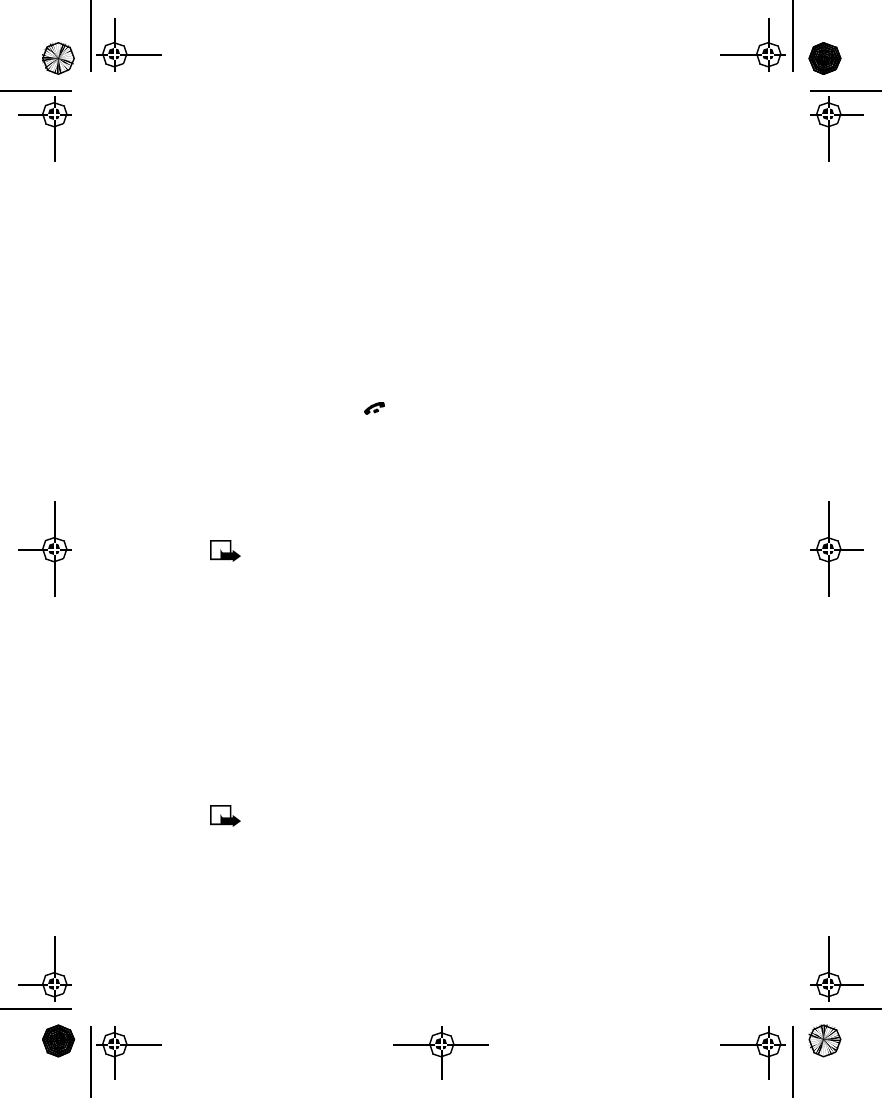
[ 71 ]
Advanced calling features
RECALL A NUMBER FROM THE PHONE BOOK DURING A CALL
If you don’t remember the number of the second party you want to
include in the conference and the number is in your phone book, you can
recall the number.
1When prompted to enter the phone number, press Find.
2Locate the number in your phone book, then press Select. The number
will appear in the number prompt.
3Press OK to call the number.
END A CONFERENCE CALL
To end all calls, press .
• USE VOICE PRIVACY
The voice privacy feature encrypts the voice channel so that people
cannot eavesdrop on your phone conversations.
Note: Voice privacy is a network dependent feature. Contact your
service provider for more information on this feature.
TURN VOICE PRIVACY ON/OFF
1Press Menu 4-6-1 (Menu > Settings > Network services > Voice
privacy).
2Scroll to On or Off and press Select.
During a call, voice privacy becomes active and notifies you with a beep.
A notification message also appears on the screen.
If you turn this feature on and voice privacy becomes inactive, your phone
beeps and displays the message Voice privacy not active.
Note: Use caution when sending confidential information if voice
privacy is not active.
EN1260.2_Sept_02.book Page 71 Friday, September 6, 2002 4:39 PM
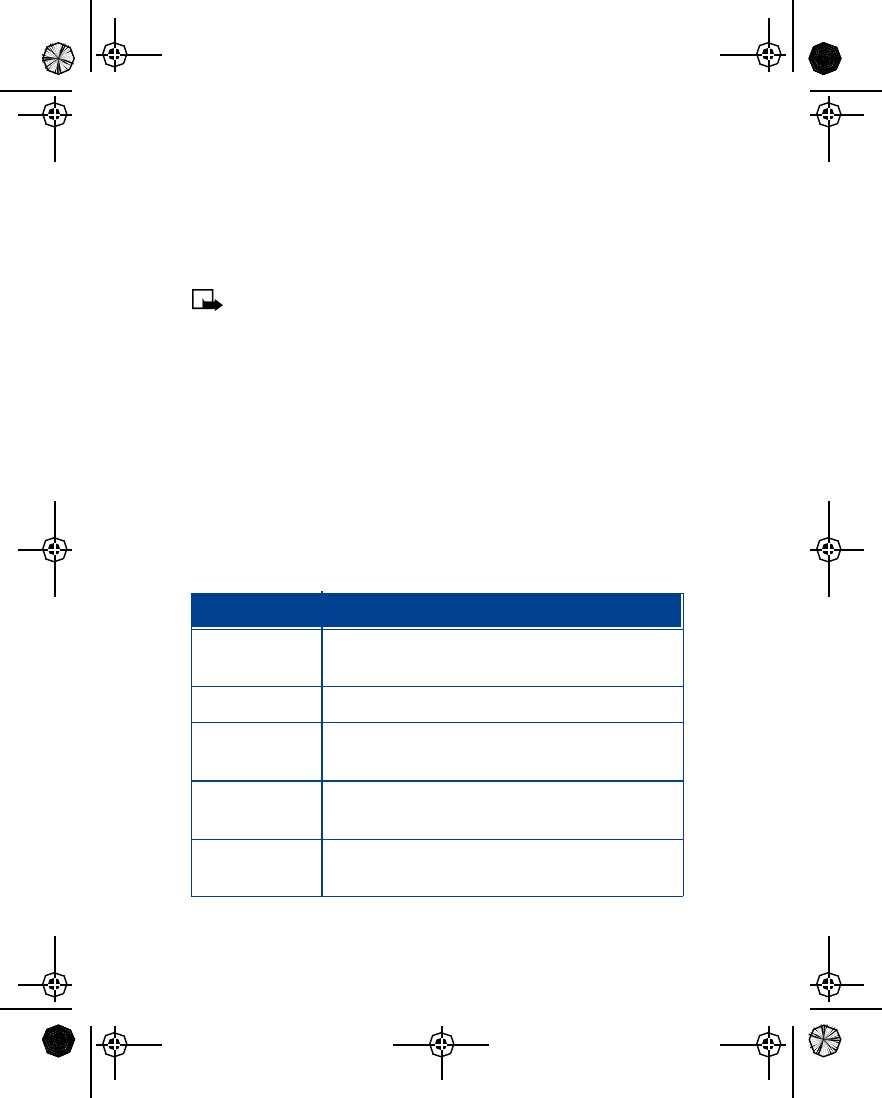
[ 72 ]
• USE CALL FORWARDING
With call forwarding, you can forward incoming calls to another phone
number. Before you can use call forwarding, you must first store the
feature codes. Once call forwarding has been activated, Call forwarding
appears as a menu option.
Note: Call forwarding is a network dependent feature. Some
networks require that call forwarding activation is done manually.
Contact your service provider for availability and full details.
Learn about call forwarding feature codes
Your network requires separate codes for activating and cancelling the
various types of call forwarding. Your carrier can provide you with the
necessary feature codes for these network services.
Once you store these feature codes in your phone, they are sent
automatically to the network when you select one of the call forwarding
options from your phone’s menu.
Your phone can store the following types of feature codes:
Option What it does
Forward all calls Forwards incoming calls to the number you
specify.
Forward if busy Forwards incoming calls when you’re in a call.
Forward if not
answered Forwards incoming calls to another number when
you are unable to answer.
Forward if out
of reach Forwards incoming calls to another number when
the phone is out of the network or switched off.
Cancel all call
forwarding Cancels all active call forwarding options.
EN1260.2_Sept_02.book Page 72 Friday, September 6, 2002 4:39 PM
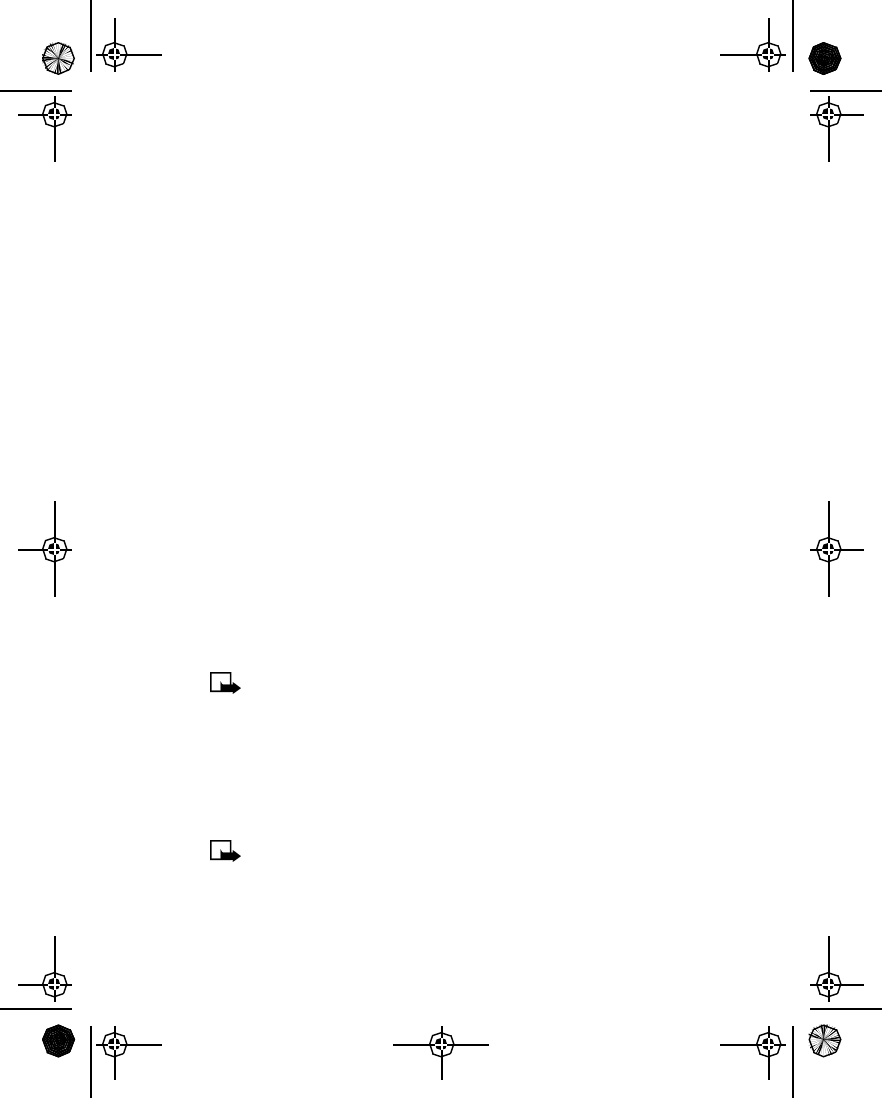
[ 73 ]
Advanced calling features
Store the call forwarding feature code
Before you can activate call forwarding, you must contact your service
provider to obtain the feature codes.
1Press Menu 4-6-5 (Menu > Settings > Network services). The
Feature code prompt appears.
2Enter the feature code your service provider gave you. Press OK.
3Scroll to Call forwarding and press Select.
4Scroll to the call forwarding option you want and press Select.
5Scroll to Activate and press Select.
Activate/cancel call forwarding
After you store the correct feature codes, you can activate (or cancel) call
forwarding as follows:
1Press Menu 4-6-2 (Settings > Network services > Call forwarding).
2Scroll to the desired call forwarding option, then press Select.
3Highlight Activate and press Select.
4Enter the number to which you want your calls forwarded (or press
Find to recall a number from the phone book).
5Press OK.
Note: When canceling call forwarding follow steps 1-2.
• USE CALL WAITING
During a call, call waiting beeps to let you know that someone else is
calling you. Depending on your caller ID setup, the phone might also
display the number of the incoming call. Once call waiting has been
activated, Call waiting appears as a menu option.
Note: Call waiting is a network dependent feature. In some
networks the call waiting code must be activated manually.
Contact your service provider for availability and full details.
EN1260.2_Sept_02.book Page 73 Friday, September 6, 2002 4:39 PM

[ 74 ]
Store the call waiting feature code
1Press Menu 4-6-5 ( Menu > Settings > Network services > Network
feature setting). The Feature code prompt appears.
2Enter the feature code issued by your service provider and press OK.
3Scroll to Call waiting and press Select.
4Scroll to Activate and press Select.
Activate call waiting
1Press Menu 4-6-3 (Menu > Settings > Network services > Call
waiting).
2Scroll to Activate and press Select.
Manage calls
Call waiting works with both local and long distance calls.
•To answer an incoming call, press .
•To switch from one call to another, press .
•To end both calls, press .
• USE SEND OWN CALLER ID
This feature allows you to block caller ID when you call someone (your
number will not be displayed on their caller ID). This feature is only
effective when calling a number equipped with caller ID.
Note: This feature is available only when supported by the
wireless network and may not function if you are roaming.
Important:This feature works on a call-by-call basis. You must
enable this feature each time you want to block the sending of
your own number to the recipient’s caller ID.
EN1260.2_Sept_02.book Page 74 Friday, September 6, 2002 4:39 PM
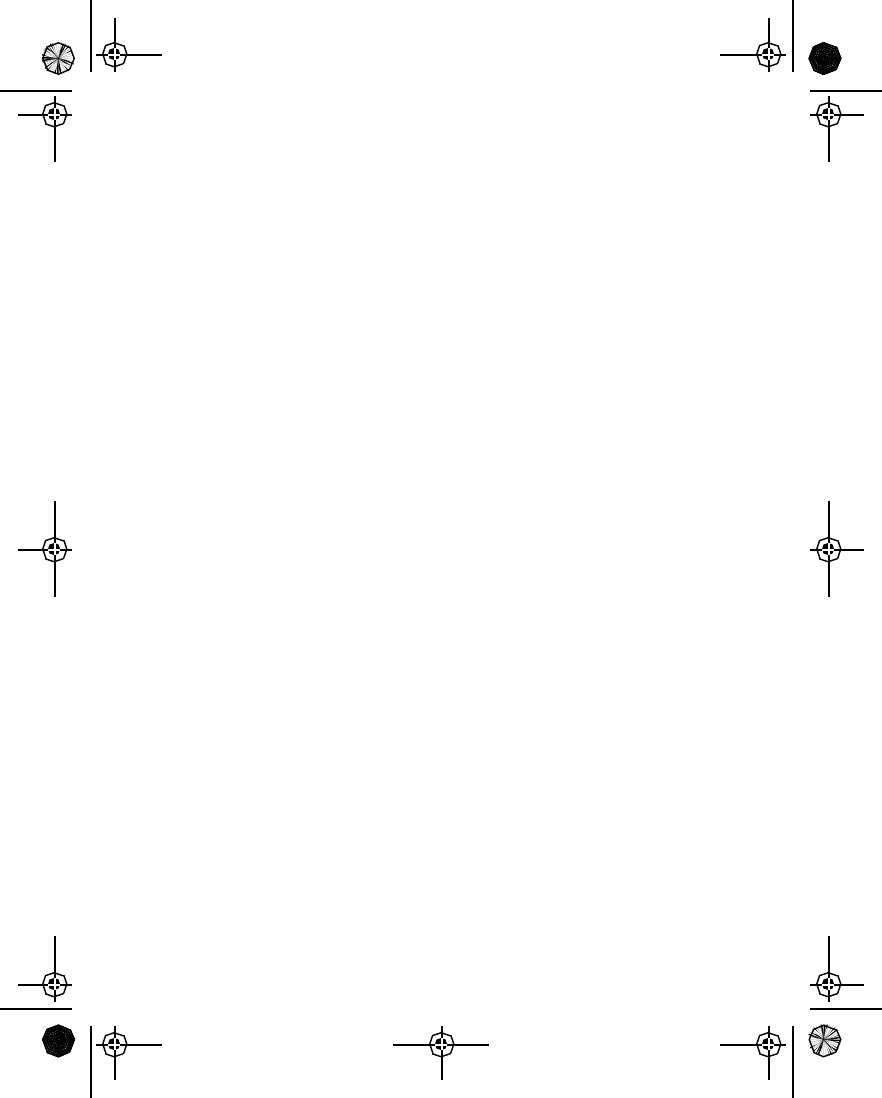
[ 75 ]
Advanced calling features
STORE THE FEATURE CODE
Before you can use the Send own caller ID call feature, you must store
the feature codes for activating this feature. Once the code is stored in
your phone, it is sent automatically to the network when you select this
option from your phone’s menu.
1Press Menu 4-6-5 ( Settings > Network services > Network feature
setting). The Feature code prompt appears.
2Enter the feature code issued by your service provider and press OK.
3Scroll to Send own caller ID, then press Select.
4Select Yes.
PLACE A CALL WITHOUT SENDING YOUR NUMBER
1Press Menu 4-6-4 (Settings > Network services > Send own caller
ID).
2Scroll to No, then press Select.
3Enter the desired phone number, then press OK (or press Find to recall
a phone number from the phone book).
The phone automatically inserts the feature code into the dialing string
and dials the phone number. The phone you are calling will not display
your phone number through caller ID.
• SELECT A PHONE NUMBER
Your service provider programs your phone number and system
information into your phone’s memory when your phone is first activated.
Your phone can hold up to three numbers. This means that your phone can
be activated in three different service areas. For example, your phone
could be activated in Dallas, Chicago, and New York. Each service area
would assign a different phone number or account to your phone.
You must select a phone number for your home system. Only one phone
number can be active at a time. If you travel outside your home system,
you can choose another number. One phone number is usually enough if
EN1260.2_Sept_02.book Page 75 Friday, September 6, 2002 4:39 PM
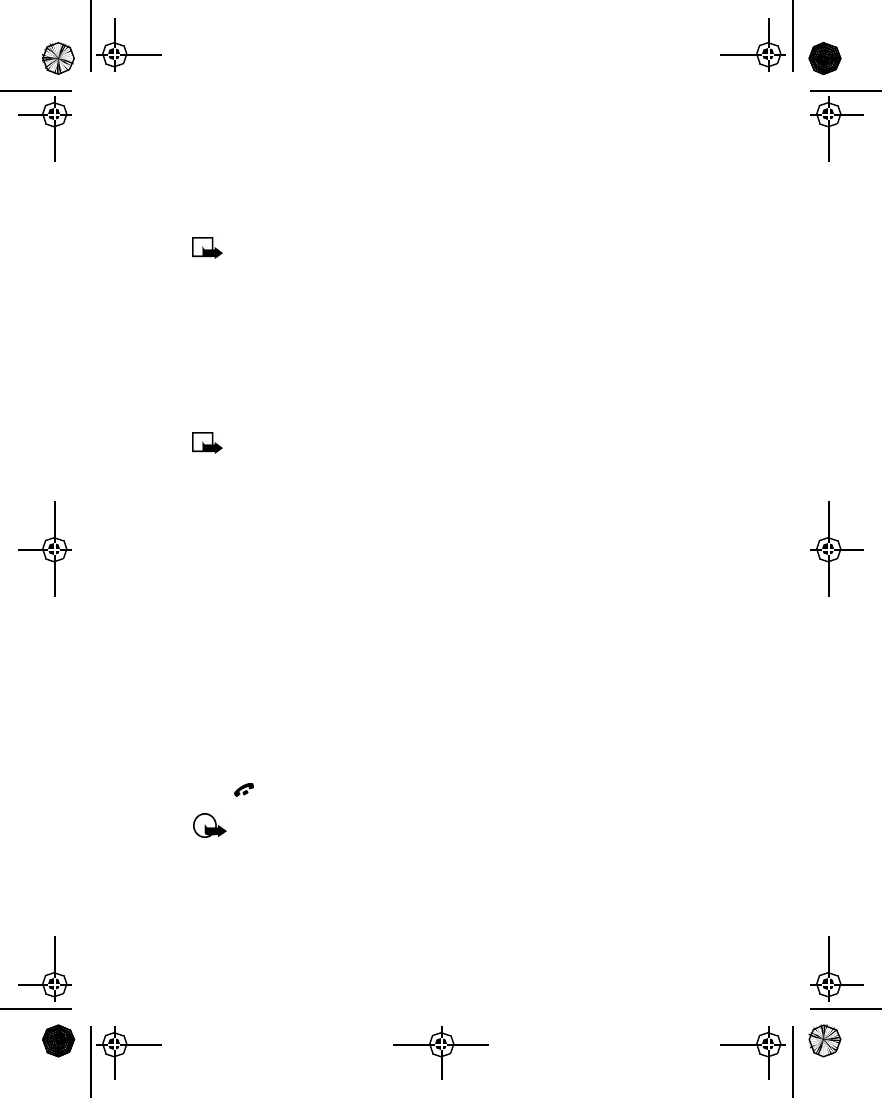
[ 76 ]
your service provider has service or roaming agreements for each area in
which you wish to use your phone. Contact your service provider for
details.
Note: Phone number selection is a network dependent feature.
Some networks may not support more than one number. Contact
your service provider for availability and full details.
Select the phone number
1Press Menu 4-6-6 (Menu > Settings > Network services > Own
number selection).
2Scroll to the phone number you want to use and press Select.
Note: The first phone number on this list is selected. You need at
least one active number to make calls. You cannot change from
one phone number to another during a call.
• USE AUTOMATIC REDIAL
There are times when you may not be able to place a call (example: due
to the high volume of traffic on the wireless network). When the wireless
network is busy or unavailable, Automatic redial instructs your phone to
retry the call.
ACTIVATE AUTOMATIC REDIAL
1Press Menu 4-2-1 (Settings > Call settings > Automatic redial).
2Scroll to On and press Select.
If the system is busy, your phone makes three additional call attempts. If
you want to stop the automatic redial process before the last attempt,
press or Quit.
Important: This feature does not automatically retry a number
when the number you are calling is busy.
EN1260.2_Sept_02.book Page 76 Friday, September 6, 2002 4:39 PM
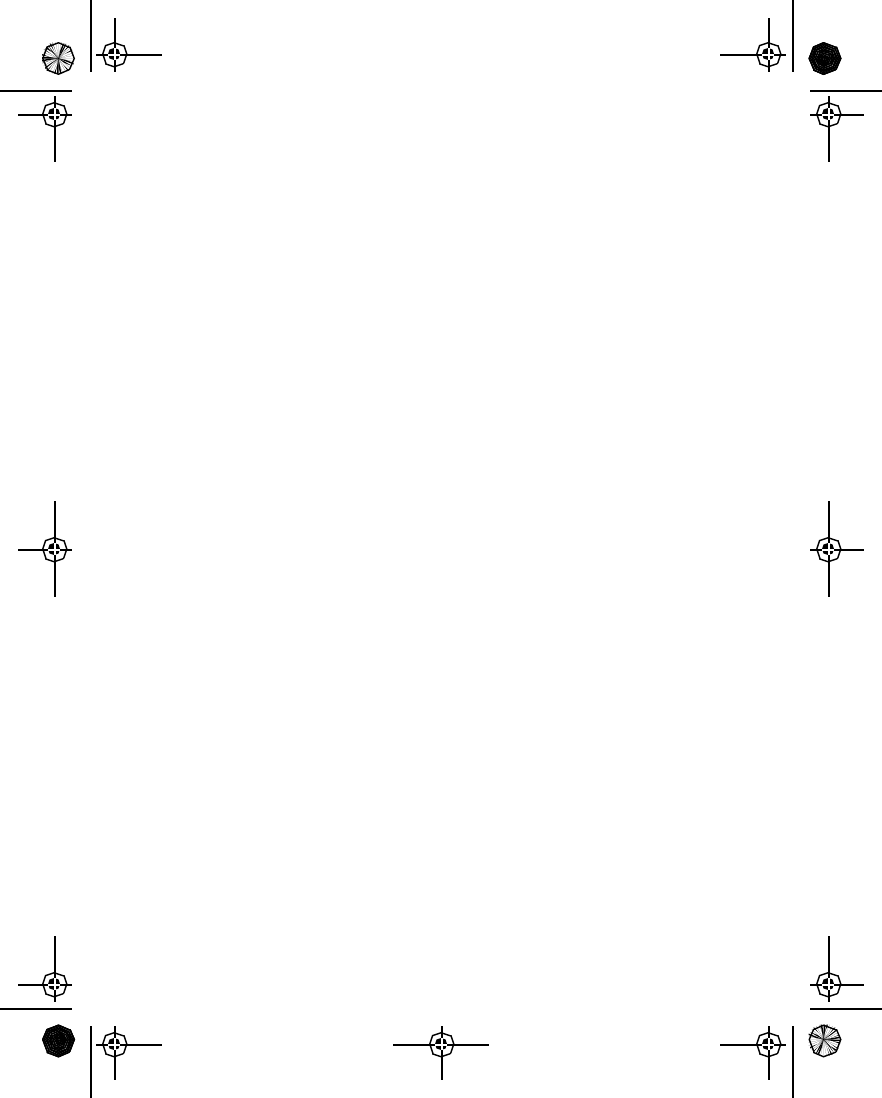
[ 77 ]
Advanced calling features
• USE 1-TOUCH DIALING
You can assign a name from your phone book to a 1-touch dial location,
using your phone’s keys 2 through 9. (The “1” key is used exclusively to
dial your voice mailbox.) Once assigned, the phone number you associate
with that key is dialed automatically when you press and hold the key.
Assign a key to 1-touch dialing
1Press Names, scroll to 1-touch dialing and press Select.
2Scroll to a number that has the message (empty) and press Assign.
3Scroll to the name and number to which you want to assign this key
and press Select. Repeat these steps as many times as necessary.
4To call a number using 1-touch dialing, press and hold the appropriate
key for a few seconds.
Change 1-touch dialing numbers
You can change the 1-touch dialing key assignments at any time.
1Press Names, scroll to 1-touch dialing and press Select.
2Scroll to the key you want to change and press Options.
3Scroll to Change and press Select.
4Scroll through the phone book until you reach the new number you
want to select and press Select.
Erase 1-touch dialing numbers
You can erase 1-touch dialing key assignments at any time.
1Press Names, scroll to 1-touch dialing and press Select.
2Scroll to the key you want to erase and press Options.
3Scroll to Erase and press Select.
4Press OK to confirm.
EN1260.2_Sept_02.book Page 77 Friday, September 6, 2002 4:39 PM
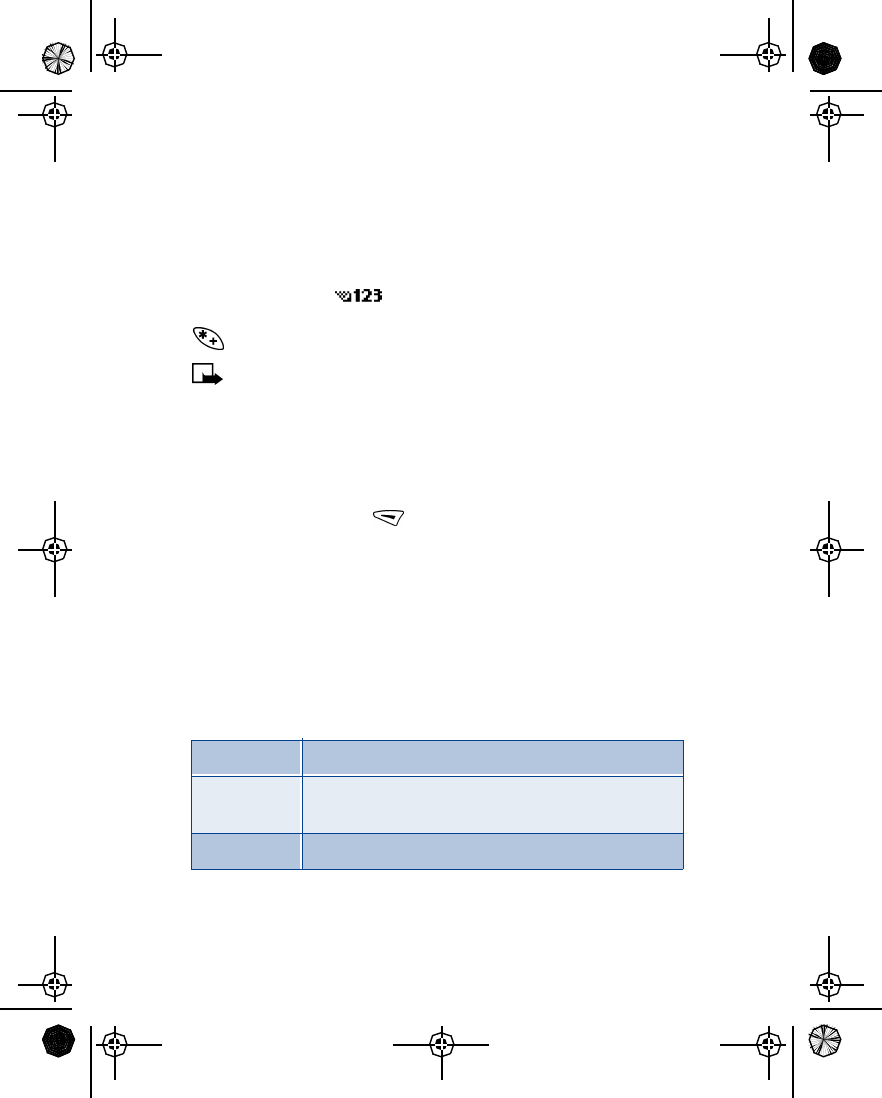
[ 78 ]
• SET TOUCH TONE STRINGS
Your phone allows you to create special sets of numbers known as touch
tone strings which will dial a series of digits after a “wait” or a “pause.”
For example, you can program your phone to send your account number
while you are banking by phone.
You must be in the mode to enter these characters. Enter the
numbers as usual. When you want to insert the special characters, press
repeatedly to switch among *, +, p, w characters.
Note: Use caution when sending confidential information if voice
privacy is not active.
pCreates a pause when a number is dialed. The numbers you enter after
this special character are automatically sent as touch tones after a
2.5-second pause.
wCreates a wait when a number is dialed. This means that your phone
waits for you to press before it sends the number as touch tones.
* Sends command strings to the network. Contact your service provider
for details.
+ Use this character as a prefix for dialing international numbers.
Set manual touch tones
1Press Menu 4-3-2-1 (Menu > Settings > Phone settings > Touch
tones > Manual touch tones).
2Select one of the following options, then press Select:
Continuous Sounds tone for as long as you press and hold a key.
Fixed Sets the tone length to 0.1 second, regardless of how
long you press a key.
Off Turns off the tones. No tones are sent.
EN1260.2_Sept_02.book Page 78 Friday, September 6, 2002 4:39 PM
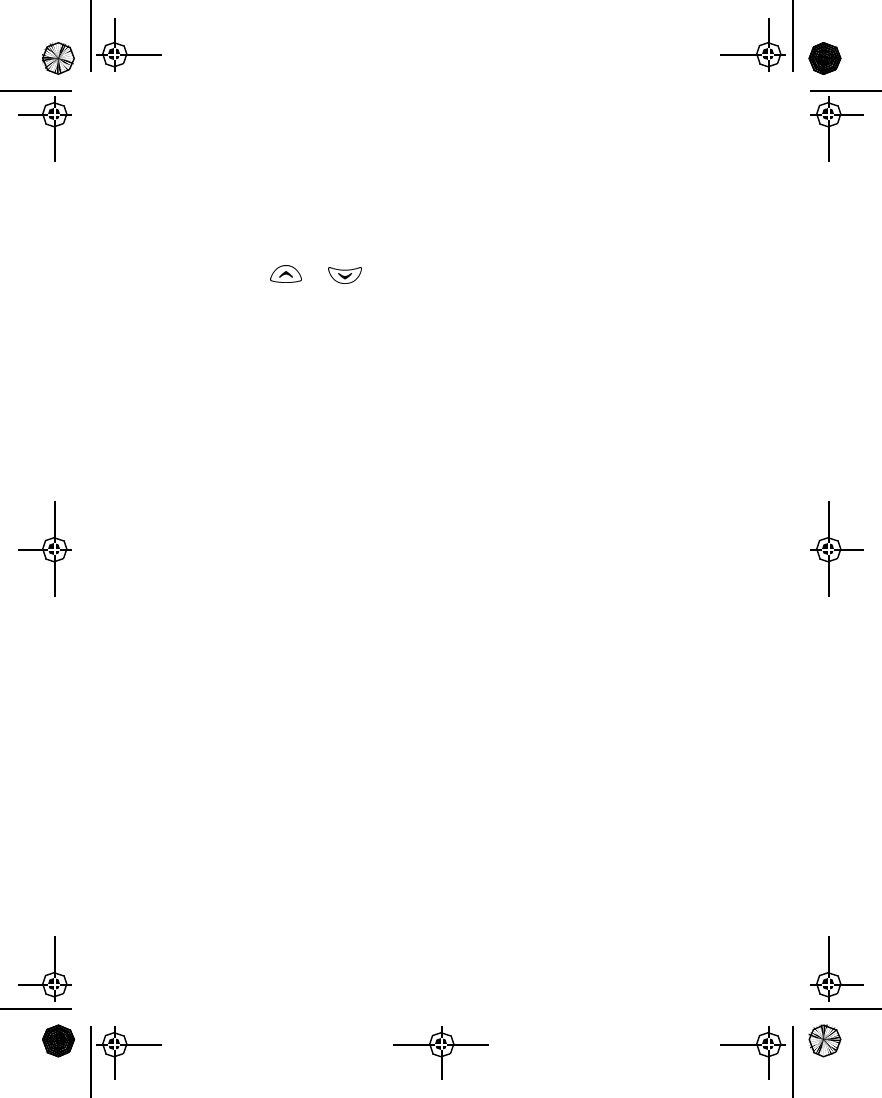
[ 79 ]
Advanced calling features
Set touch tone length
You can also set the length of each touch tone.
1Press Menu 4-3-2-2 (Menu > Settings > Phone settings > Touch
tones > Touch tone length).
2Use or to scroll to Short or Long. Short sets the tone
length to 0.1 second. Long sets the tone length to 0.5 second.
3Press Select.
Store touch tone strings
You can store touch tone strings the same way that you store names and
numbers in your phone book. You can store an entire sequence of digits
and send it as touch tones for frequently used strings of numbers.
STORE TOUCH TONE STRINGS WITH PHONE NUMBERS
1Enter the phone number that you want associated with a touch tone.
2Enter the touch tone character where needed (p, w, or *).
3Enter the touch tone string.
4Store the number as you normally would.
SEND A TOUCH TONE STRING
1Press Menu 4-3-2-1 (Menu > Settings > Phone settings > Touch
tones > Manual touch tones).
2Make sure that the setting is not set to Off. If it is, scroll to one of the
other options and press Select.
3Then, during your call, press Options, scroll to Touch tones and
press Select.
4Enter the touch tone string or recall the string from the phone book,
and press Tones.
If you send touch tones while in the analog mode, be careful not to send
confidential information.
EN1260.2_Sept_02.book Page 79 Friday, September 6, 2002 4:39 PM
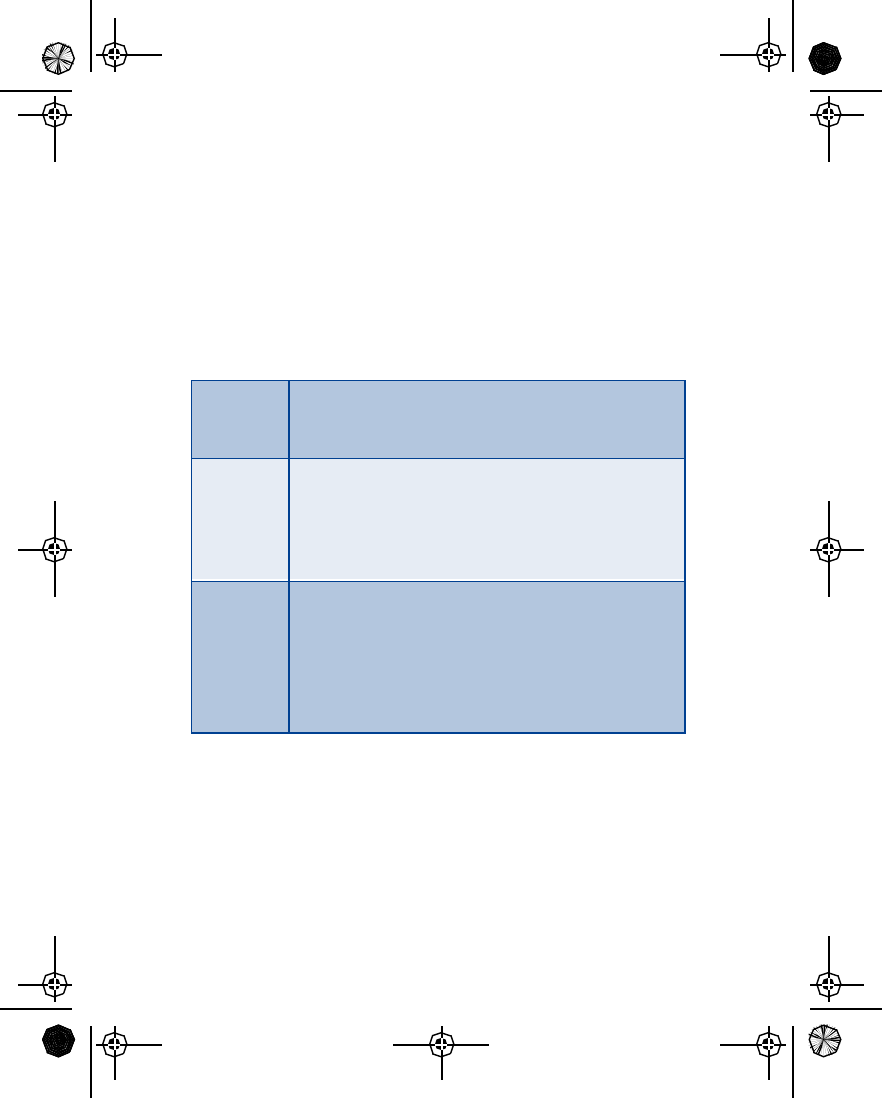
[ 80 ]
• SELECT A SYSTEM
Your phone can operate in residential, private, and public systems (such
as your home system). You can choose how your phone selects a network
to use. Your phone may not show the options described here. For
information, contact your service provider.
Search for a network
Press Menu 5 (Menu > System).
You have the following three options.
Automatic Your phone automatically searches for available networks
and chooses the appropriate one. Every time you turn on
your phone, it resets to Automatic.
Manual The phone searches for networks and then shows a list
of the ones that are available. If an available network is
found, the word Available: appears on the screen followed
by the name of the network. To choose the network listed,
press OK.
New search Your phone begins a new search for both private and
residential systems. When it finds the best system
available, the phone shows the system name.
If the phone doesn’t find another system, the question
Perform an extended search? will appear. Press OK if
you wish to continue searching.
EN1260.2_Sept_02.book Page 80 Friday, September 6, 2002 4:39 PM

[ 81 ]
Security
10 Security
Your phone is equipped with different security features that allow you to
do the following:
•avoid making accidental calls
•prevent unauthorized users from changing certain feature settings on
your phone
•restrict outgoing or incoming calls
• USE KEYGUARD
Keyguard disables your keypad to prevent accidental
key presses.
LOCK THE KEYPAD
To lock the keys, press Menu then .
UNLOCK THE KEYPAD
To unlock the keys, press Unlock then .
Note: When Keyguard is on, calls may be
possible to emergency numbers (for example, 911 or other official
emergency number). Key in the emergency number and press .
The number is displayed only after you have keyed in its last digit.
EN1260.2_Sept_02.book Page 81 Friday, September 6, 2002 4:39 PM
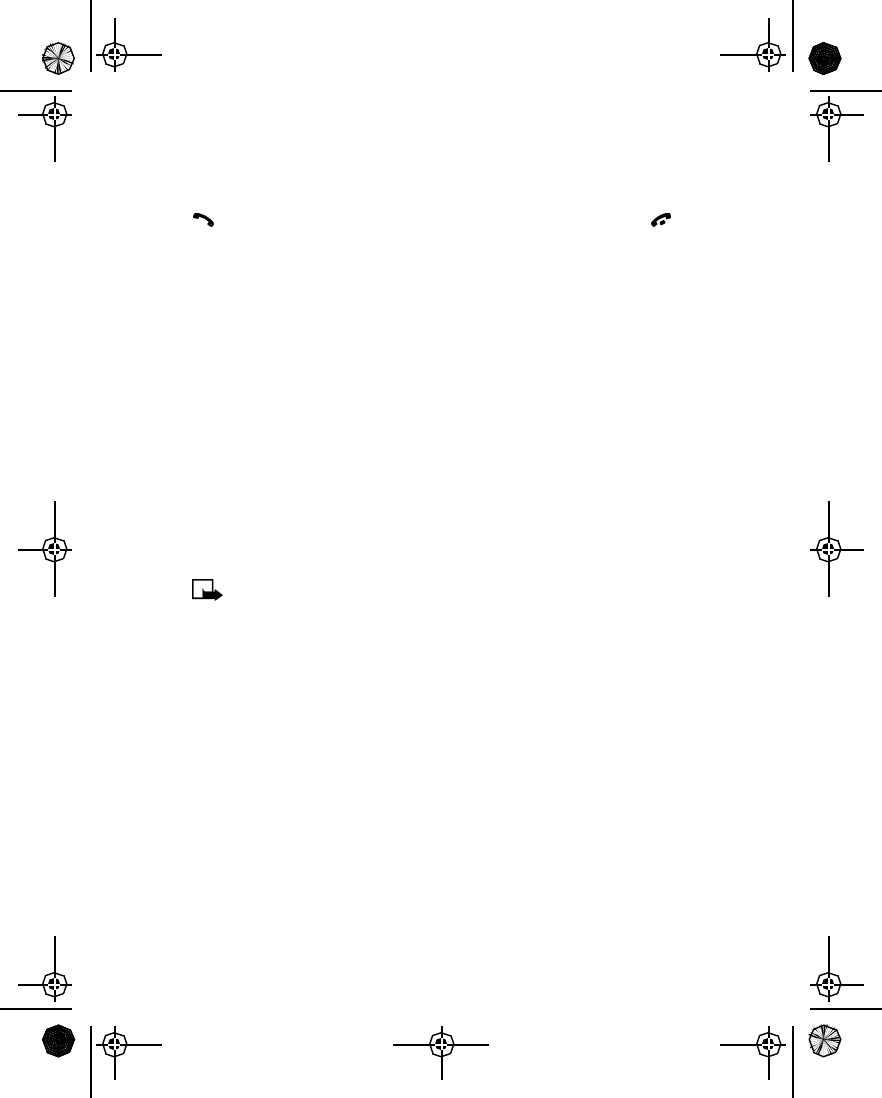
[ 82 ]
Answer a call while Keyguard is active
You can answer calls when Keyguard is activated by pressing Answer or
. If you are connected to a headset or loopset, press and hold to
end the call.
NOTES ABOUT KEYGUARD
•After you end the call, Keyguard automatically becomes active again.
•If you need the phone’s lights while Keyguard is on, press the Power
key to quickly switch the lights on for 15 seconds.
•Connecting your phone to a car kit automatically disables Keyguard.
• UNDERSTAND THE SECURITY CODE
The Security code prevents unauthorized users from changing certain
important feature settings on your phone. When the phone requires this
code, it displays a prompt asking you to enter a Security code. The
five-digit default Security code that comes with your phone is 12345.
Nokia recommends that you change the default code immediately.
Note: If you enter an incorrect security code five times in a row,
the phone will not accept the correct code for 5 minutes.
Change your security code
1Press Menu 4-5-2 (Menu > Settings > Security settings > Change
security code).
2At the Security code prompt, enter your five-digit default security
code (12345) or your current security code and press OK.
3At the Enter new security code prompt, enter your new five-digit
security code and press OK.
4At the Verify new security code prompt, enter your new security code
again and press OK. The confirmation Security code changed
appears.
EN1260.2_Sept_02.book Page 82 Friday, September 6, 2002 4:39 PM
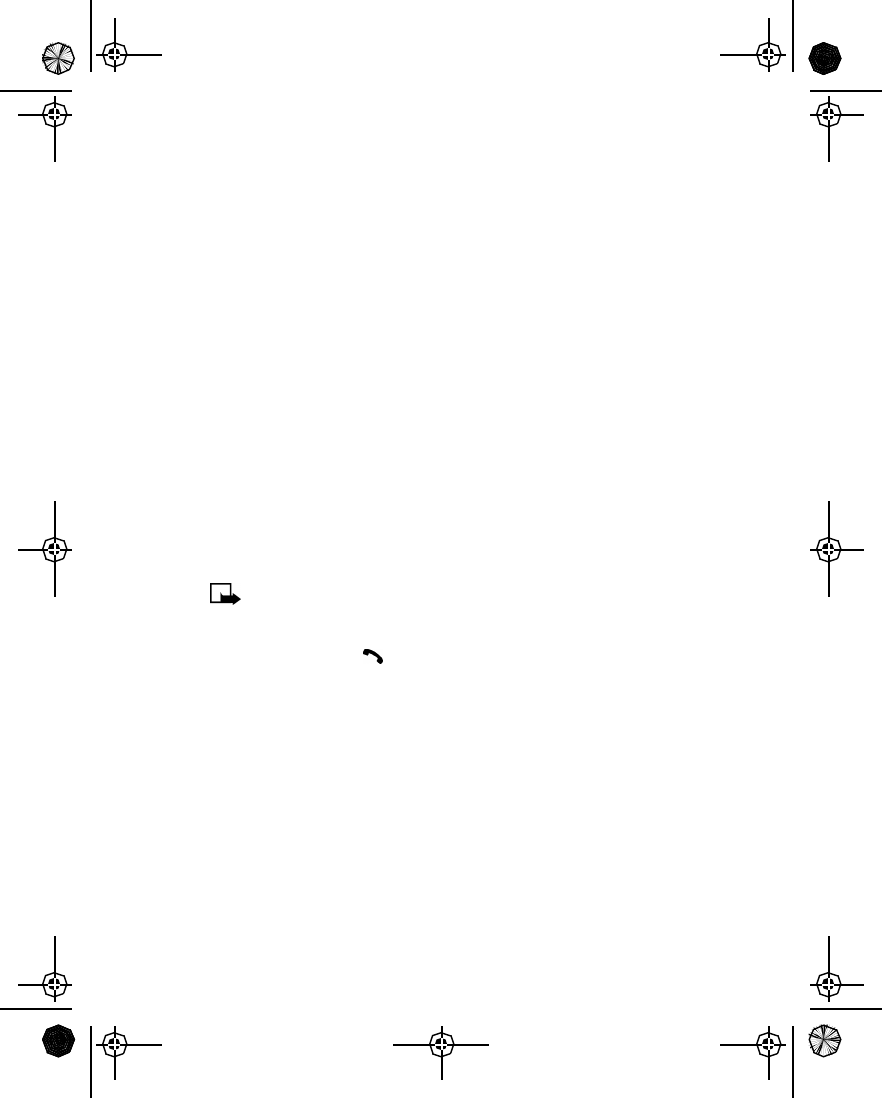
[ 83 ]
Security
Keep your security code secret and stored in a safe place away from your
phone. If you have changed your security code and don’t remember the
new code, contact your service provider.
• RESTRICT CALLS
You can create your own list of restrictions to restrict incoming and
outgoing calls. To restrict the calls, you apply the appropriate restriction
as desired. The maximum number of call restrictions you can define is ten.
Before you define restrictions for outgoing calls, Add restriction is the
only available option. After you use the Add restriction option to add at
least one restriction, the following options become available:
•Select: Allows you to select call restrictions from the outgoing
calls list.
•Add restriction: Allows you to add a new restriction.
•Edit: Allows you to edit an existing call restriction.
•Erase: Allows you to erase an existing call restriction.
Note: When calls are restricted, calls may be possible to the
emergency number programmed into your phone (for example, 911
or other official emergency number). For example, you could dial
911 and press .
Add a number to the call restriction list
1Press Menu 4-5-1-1 (Menu > Settings > Security settings > Call
restrictions > Restrict outgoing calls).
2Enter your security code, then press OK.
3Scroll to Restrict outgoing calls, then press Select.
4Scroll to Add restriction and press Select.
EN1260.2_Sept_02.book Page 83 Friday, September 6, 2002 4:39 PM
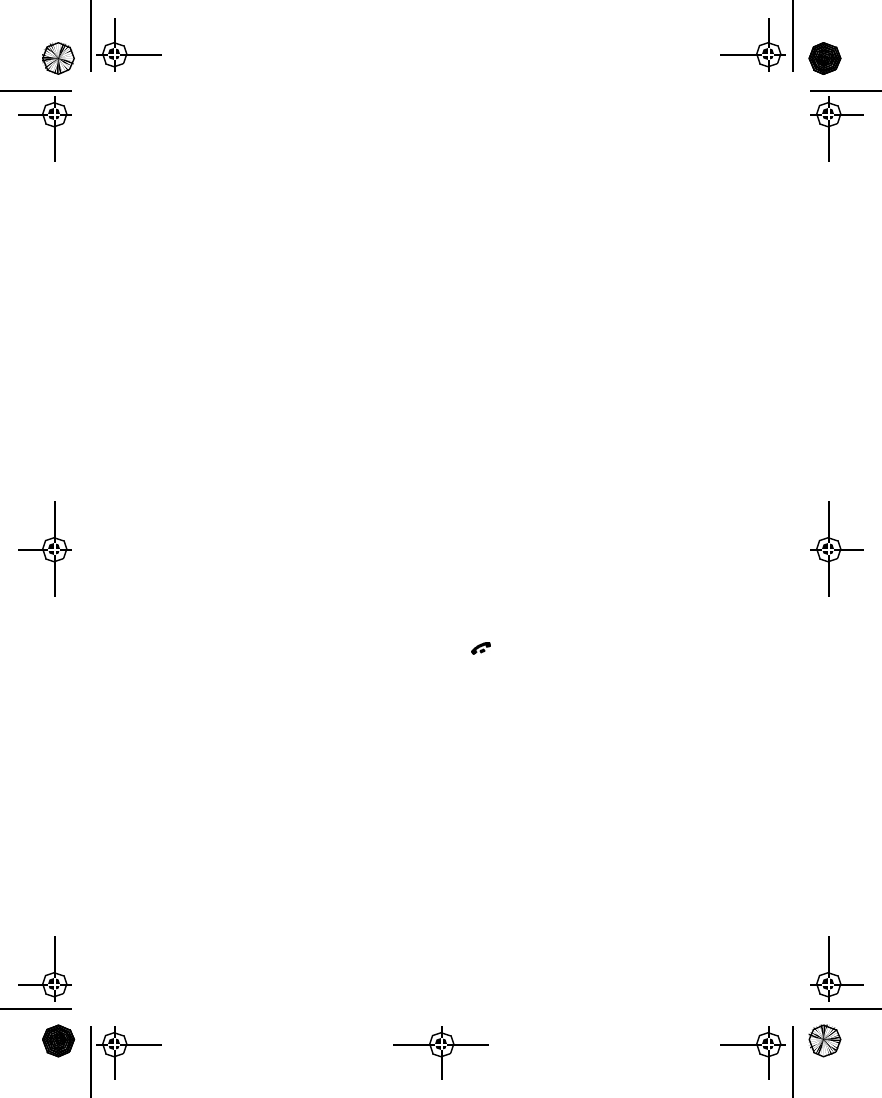
[ 84 ]
5At the number prompt, enter the number you want to restrict, and
press OK.
For example: If you want to restrict all long distance calls that begin
with 1, enter 1. If you want to restrict all calls that begin with 972,
enter 972.
6Enter a name for the restriction, then press OK.
If you press OK without entering a name, the number will be used.
Restrict outgoing calls
1Press Menu 4-5-1-1 (Menu > Settings > Security settings > Call
restrictions > Restrict outgoing calls).
2Enter your security code, then press OK.
3Scroll to Restrict outgoing calls, then press Select.
4Scroll to Select to choose from your list of call restrictions.
To deactivate a call restriction, highlight the restriction and press
Unmark.
5Scroll to the restriction you want to activate and press Mark.
6Press Back. At Save changes?, press Yes.
To return to the Start screen, press .
Restrict all incoming calls
1Press Menu 4-5-1-2 (Menu > Settings > Security settings > Call
restrictions > Restrict incoming calls).
2Enter your security code, then press OK.
3Scroll to Restrict incoming calls, then press Select.
4Press Mark to restrict all incoming calls.
EN1260.2_Sept_02.book Page 84 Friday, September 6, 2002 4:39 PM
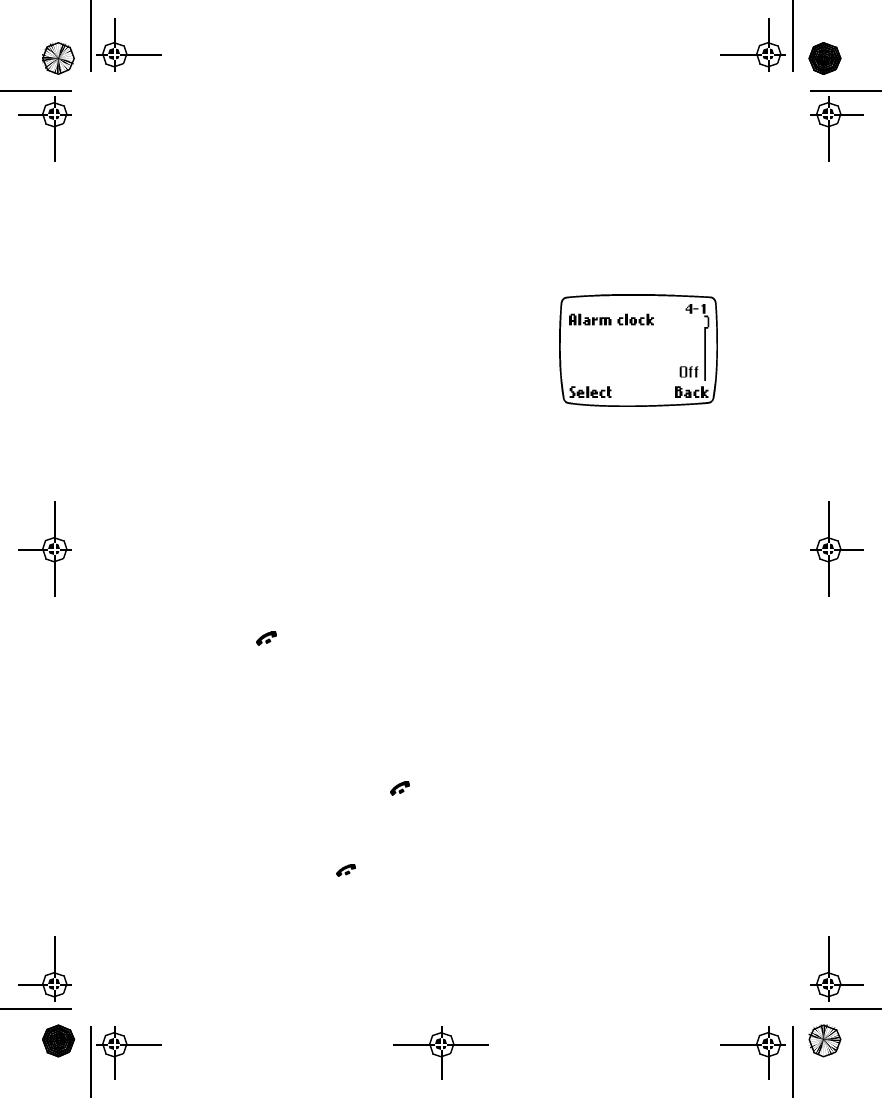
[ 85 ]
Special features
11 Special features
This section describes several special features, including transmission of
business cards, downloading ringing tones, and setting the alarm clock.
• USE THE ALARM CLOCK
The alarm clock feature is based on your
phone’s internal clock and sounds an alert at a
time you specify. The alarm clock works even if
you turn your phone off.
Set the alarm clock
1Press Menu 4-1-1 (Settings > Time settings > Alarm clock).
2Enter the alarm time in hh:mm format, then press OK.
3Select either am or pm, then press Select.
Step 3 is necessary only if you have selected am/pm format.
Respond to the alarm
At the time of the alarm, the phone sounds an alert tone. Pressing Stop
or the key stops the alarm from sounding, and returns you to the Start
screen.
SNOOZING
There are several ways you can enable the Snooze feature:
1Press the Snooze selection key.
2Press any key except .
3Allow the alarm to sound for one minute.
Once snooze is enabled, the alarm will sound again in ten minutes. If you
press Stop or the key while snoozing, the alarm will be turned off.
EN1260.2_Sept_02.book Page 85 Friday, September 6, 2002 4:39 PM
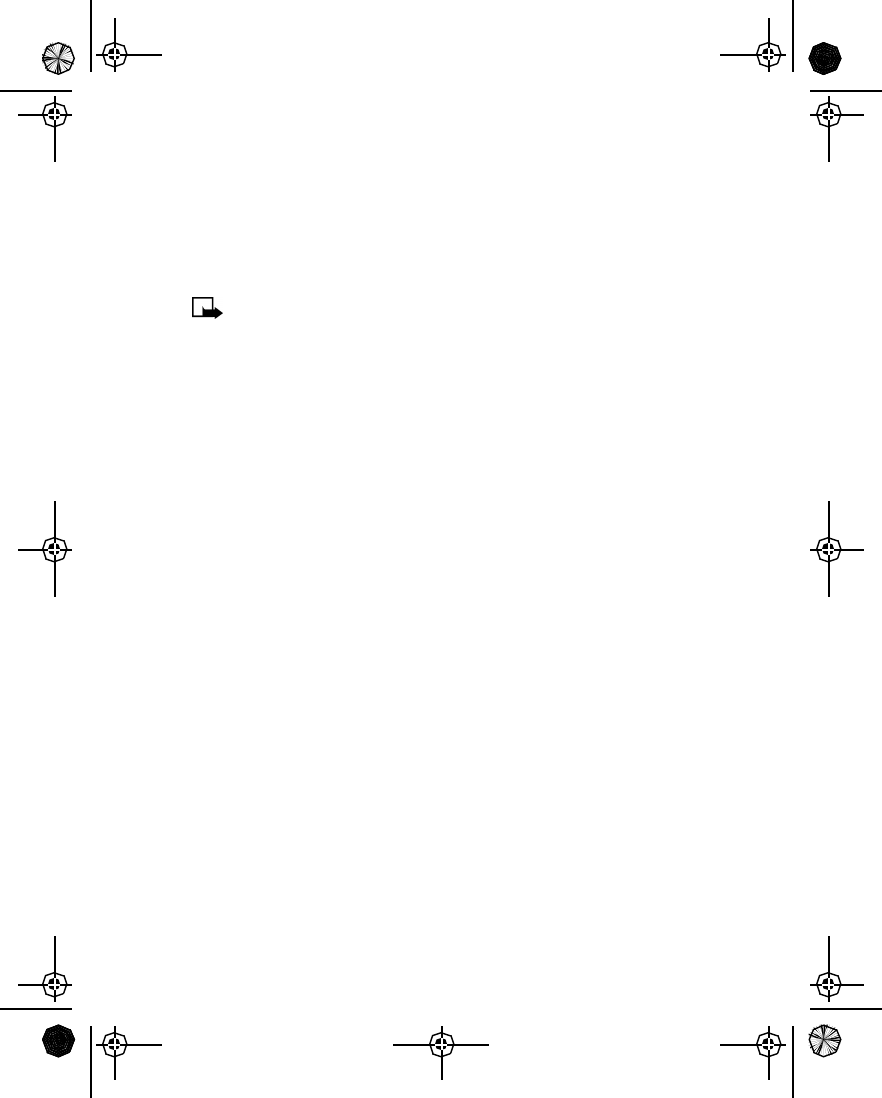
[ 86 ]
Alarm when phone power is off
If the alarm time is reached while the phone is off, the phone switches
itself on and starts sounding the alarm tone. If you press Stop, the phone
asks whether you want to activate the phone for calls. Press No to switch
off the phone or Yes to make and receive calls.
Note: Do not press Yes when wireless phone use is prohibited or
when it may cause interference or danger.
Turn off the alarm clock
1Press Menu 4-1-1 (Settings > Time settings > Alarm clock).
2Scroll to Off and press Select.
• SEND AND RECEIVE BUSINESS CARDS
Your phone can send or receive electronic business cards consisting of a
name, phone number and e-mail. You can save received business cards in
your phone book.
Send a business card
1Find the name in your phone book.
2Press Options and scroll to Send bus. card.
3Press Select.
4Enter or recall the phone number to which you want to send the
business card and press Send.
EN1260.2_Sept_02.book Page 86 Friday, September 6, 2002 4:39 PM

[ 87 ]
Special features
View a received business card
When you receive a business card, the phone displays Business card
received.
1When your phone displays Business card received, press Options.
2Show is selected. Press Select.
3Scroll through the available information.
Save a viewed business card
1After viewing the business card, press Back, scroll to Save and press
Select.
2At the Name: prompt, edit the name if desired, then press OK.
3At the Number: prompt, edit the number if desired, then press OK.
4At the E-mail address prompt, edit the e-mail address if desired, then
press OK.
Delete a viewed business card
After viewing the business card:
1Press Back.
2Scroll to Discard, then press OK.
3At Discard business card?, press OK.
• DOWNLOAD A RINGING TONE
You can download up to ten ringing tones to replace the personal entries
in your list of ringing tones. For details about this service, please contact
your wireless service provider.
Notification of a received ringing tone
If you have this service and your phone receives a downloaded ringing
tone, your phone displays Ringing tone received.
EN1260.2_Sept_02.book Page 87 Friday, September 6, 2002 4:39 PM

[ 88 ]
Listen to received ringing tones
1When your phone shows Ringing tone received, press Options.
2Playback is selected. Press OK.
The phone plays the ringing tone.
3To stop playing the ringing tone, press Quit.
Note: An incoming call or pressing any key stops the ringing tone
from playing.
Save a received ringing tone
1After listening to the ringing tone, press Quit.
2Scroll to Save tone. Press OK.
3Choose which ringing tone you want to replace – either an empty
Personal location, if any are remaining, or a previously downloaded
tone.
Discard a received ringing tone
1After listening to the ringing tone, press Quit.
2Scroll to Discard tone. Press OK.
EN1260.2_Sept_02.book Page 88 Friday, September 6, 2002 4:39 PM
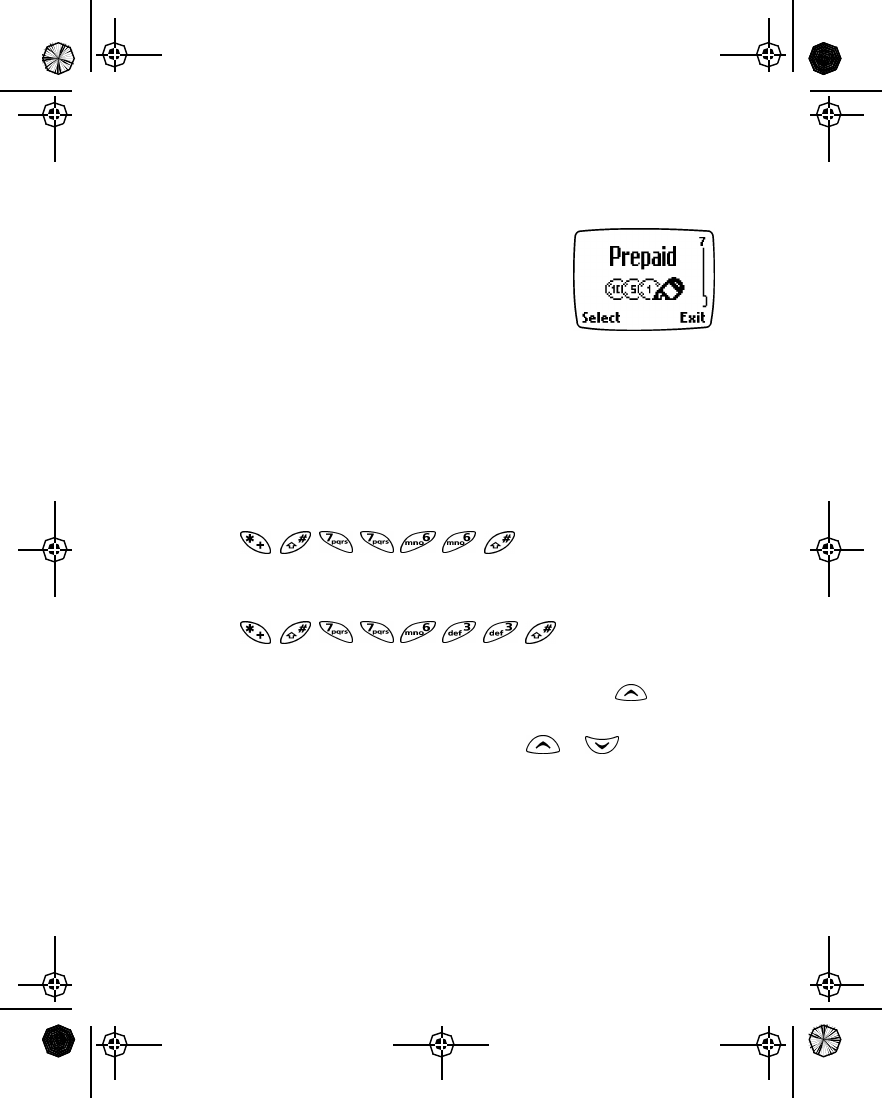
[ 89 ]
Prepaid services
12 Prepaid services
With prepaid service, you buy wireless network
services in advance. Your phone works the same
way it did before, with some additional features.
Prepaid service may not be available from your
wireless service provider. Contact your service
provider for details.
• MANAGE PREPAID SERVICE
After you sign up with your service provider for prepaid service, you can
activate the Prepaid menu in your phone. This menu appears on your
screen only if you’ve activated the service.
ACTIVATE PREPAID
To activate prepaid services, enter the following sequence:
(*#7766#)
DEACTIVATE PREPAID
To deactivate prepaid services, enter the following sequence:
(*#77633#)
USE THE MENU
•To use the prepaid menu, press Menu and then press to go
immediately to Prepaid.
•Once you select the prepaid menu, press or to scroll
through prepaid options.
EN1260.2_Sept_02.book Page 89 Friday, September 6, 2002 4:39 PM
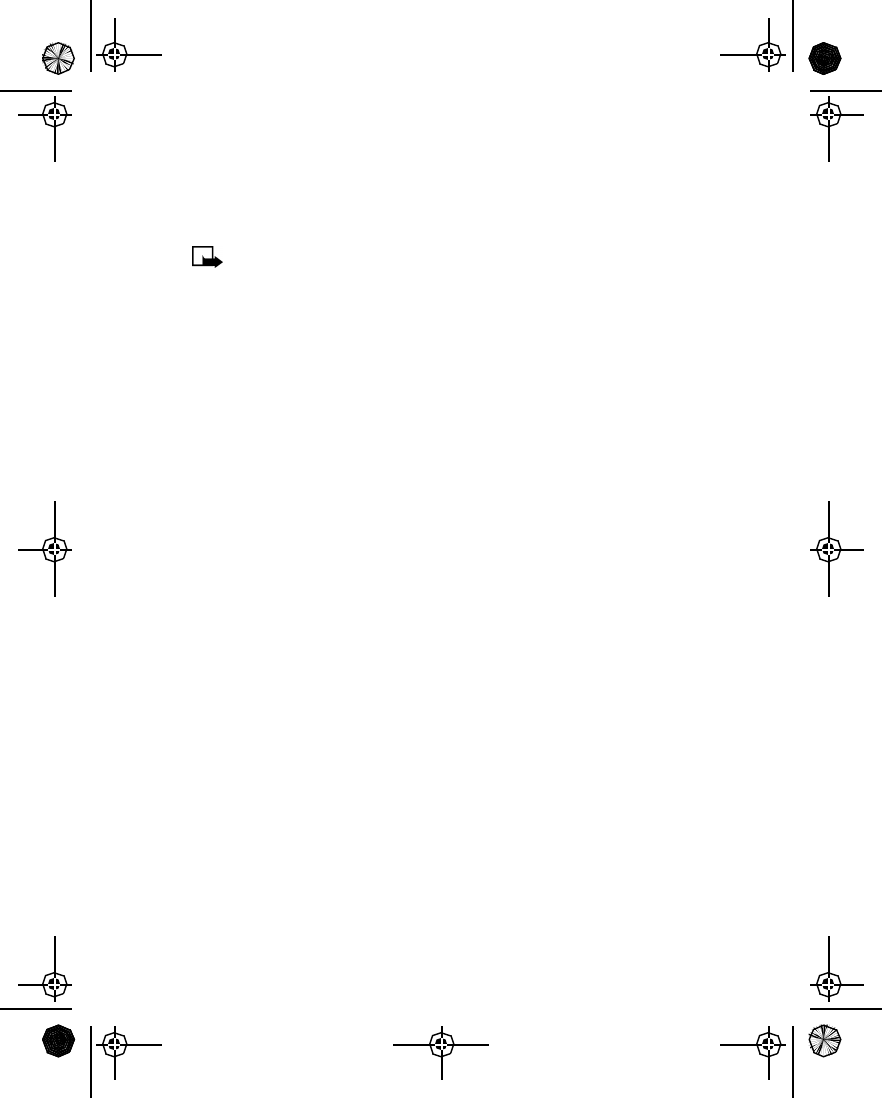
[ 90 ]
• CHECK YOUR PREPAID BALANCE
You can check the balance remaining in your prepaid account. Contact your
service provider for the access number used to check the balance.
Note: When no more charging units or currency units are left,
calls may only be possible to the emergency number programmed
into your phone (for example, 911 or other official emergency
number).
1Press Menu 7-1 (Menu > Prepaid > Check account balance).
2At Balance number, enter the balance number and press OK.
If you have already saved the balance number under Save access
phone numbers, the phone will initiate a call to the saved number.
3The phone calls the balance number. Follow the prompts you hear
from the operator.
• ADD MONEY TO YOUR ACCOUNT
Call the access number your service provider gave you to add money to
your account. For convenience, see For convenience, see “Save your access
numbers” on page91.
1Press Menu 7-2 (Menu > Prepaid > Add money to account).
2At Replenish no., enter the replenish number and press OK.
If you have already saved the replenish number under Save access
phone numbers, the phone will initiate a call to the saved number.
3Follow the prompts you hear from the operator.
EN1260.2_Sept_02.book Page 90 Friday, September 6, 2002 4:39 PM
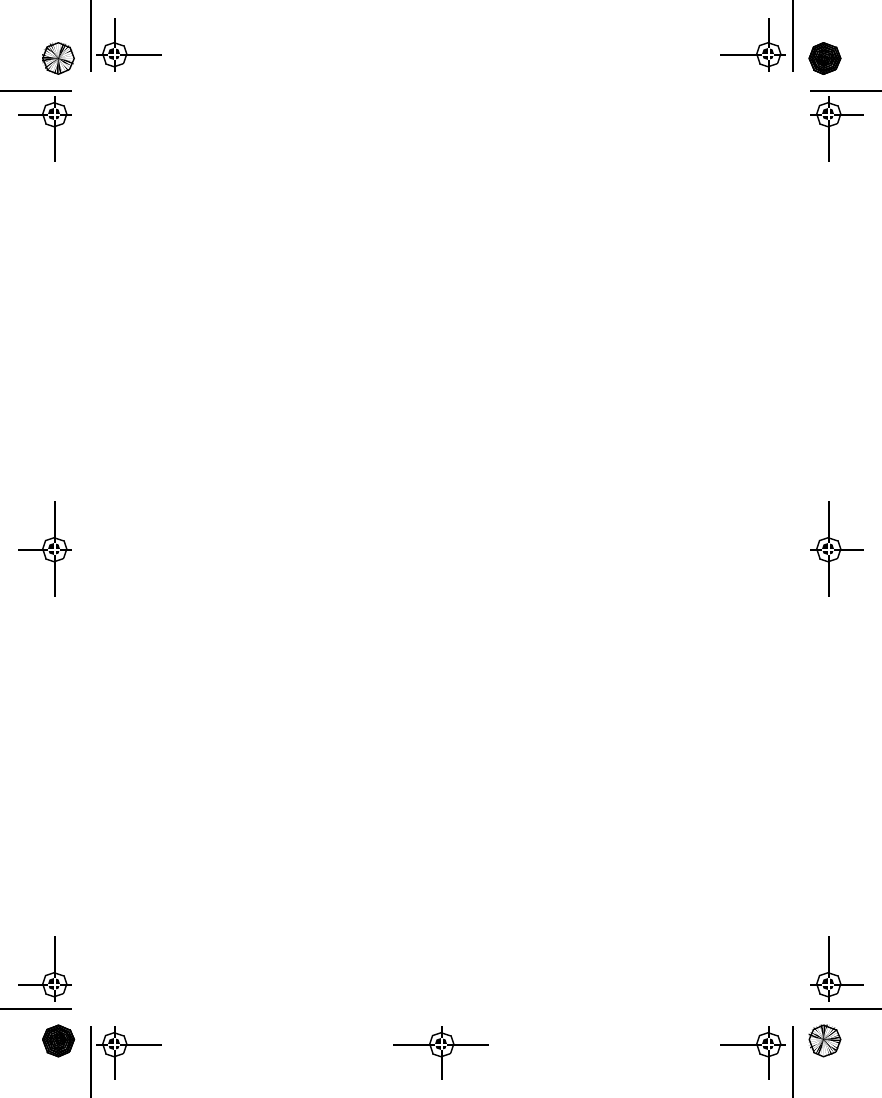
[ 91 ]
Prepaid services
• CALL CUSTOMER SERVICE
You can call the customer service number for your prepaid account.
Contact your service provider for the access numbers.
1Press Menu 7-3 (Menu > Prepaid > Call customer service).
2Enter the customer service number your service provider gave you,
then press OK.
If you have already saved the customer service number under Save
access phone numbers, the phone will initiate a call to the saved
number.
The phone calls the customer service number. Follow the prompts you
hear from the operator.
• SAVE YOUR ACCESS NUMBERS
You can check your prepaid balance, add money to your account, and call
customer service. To do that, you first need to save the correct access
numbers in your phone. Contact your service provider for the access
numbers.
1Press Menu 7-4 (Menu > Prepaid > Save access phone numbers).
2At Save access phone numbers, press Select.
3Scroll to Replenish phone number, press Select, enter the replenish
number your service provider gave you, then press OK.
4Scroll to Balance phone number, press Select.
5Enter the balance number your service provider gave you, then press
OK.
6Scroll to Customer service phone number, then press Select.
7Enter the customer service number your service provider gave you,
then press OK.
EN1260.2_Sept_02.book Page 91 Friday, September 6, 2002 4:39 PM

[ 92 ]
• EXPIRATION DATE
You can store and edit the expiration date of your prepaid credit each
time you add money to your account. You enter and change this date
manually.
1Press Menu 7 (Menu > Prepaid).
2Scroll to Expiration date, then press Select.
3Enter your expiration date, then press OK.
To simply view the current expiration date that you have entered, press
Menu 7-5.
EN1260.2_Sept_02.book Page 92 Friday, September 6, 2002 4:39 PM
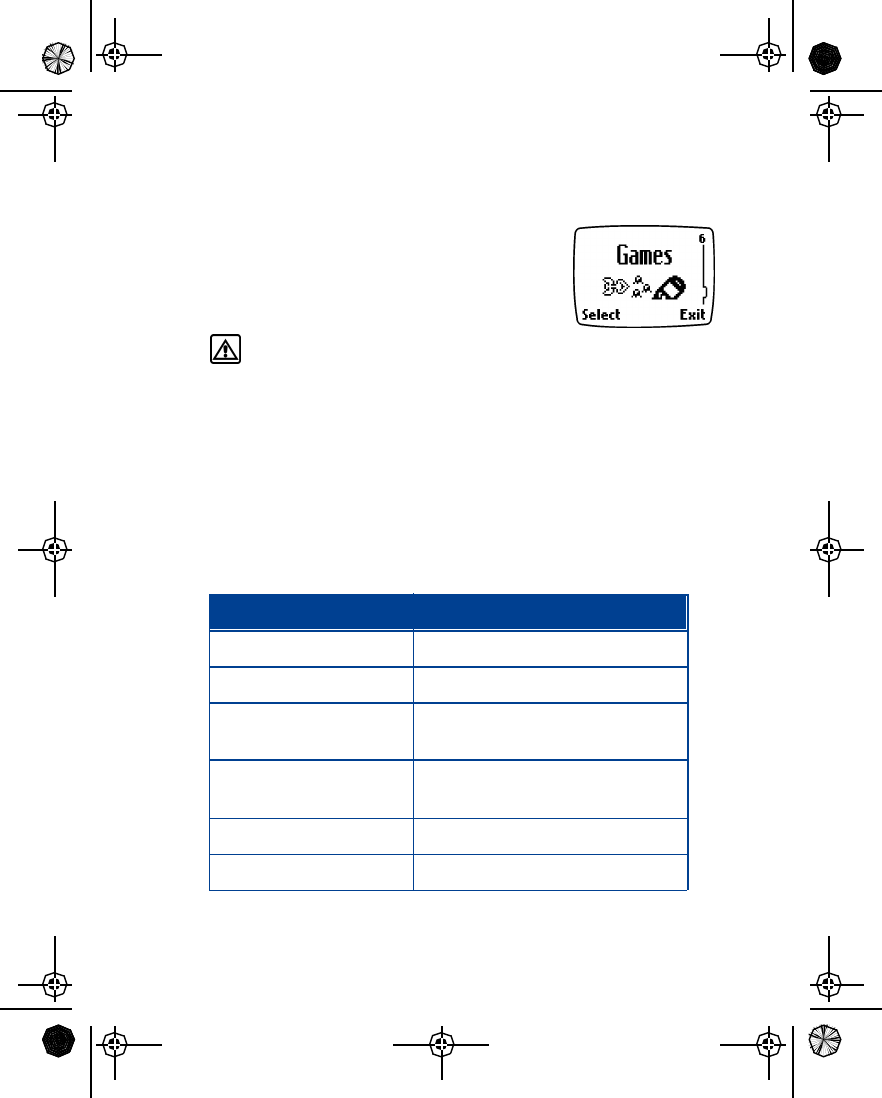
[ 93 ]
Games
13 Games
You can use your phone for communication and
some serious fun. Your phone offers three games:
Snake II, Space impact, and Pairs II.
Note: Your phone must be switched on to
use this function. Do not switch on the phone when wireless phone
use is prohibited or when it may cause interference or danger.
• START A NEW GAME
1Press Menu 6 (Menu > Games) and press Select.
2Scroll to the desired game and press Select.
3Select New game, and press Select.
Additional options under each game include:
Option What it does
Continue Continue a game that was stopped.
New Game Start a new game.
Level
(Snake II and Pairs II only) Choose the game’s difficulty level.
Mazes
(Snake II only) Choose among different maze
designs.
Top score Display the top score.
Instructions Learn how to play the game.
EN1260.2_Sept_02.book Page 93 Friday, September 6, 2002 4:39 PM

[ 94 ]
Please visit Nokia games services on the Internet for more hints and tips
at www.nokia.com.
GAME SETTINGS
Game sounds and lights can be turned on or off. To access the settings
menu press Menu > Games > Settings.
• SNAKE II
Feed the snake with as many goodies as possible and watch it grow. Press
Menu 6-1.
To turn the snake toward the food, press , , and .
The longer the snake’s tail grows, the higher your score. You can choose
to have a clear field, or select from five different mazes. If the snake runs
into its own tail or the surrounding wall, found in one of the maze levels,
the game is over.
• SPACE IMPACT
Use your weapons to survive alien attacks. When you defeat all the
enemies, you progress to the next level. Press Menu 6-2.
To move up and down, press and .
To move to the left and right, press and .
To fire the main weapons, press or .
To fire the bonus weapons, press or .
Time trial (Pairs II only)To advance to the next level, you
must pair up all tiles before the
dynamite fuse runs out.
Puzzle (Pairs II only)Reveal pictures to find pairs with as
few tries as possible.
Option What it does
EN1260.2_Sept_02.book Page 94 Friday, September 6, 2002 4:39 PM

[ 95 ]
Games
• PAIRS II
The object of the game is to uncover the pictures to find pairs in as few
tries as possible. Press Menu 6-3 and choose between Time Trial and
Puzzle.
Move the cursor with keys , , and .
To reveal the pictures, press .
When playing in Time trial mode, you must match all the pairs before the
dynamite fuse runs out in order to advance to the next level.
EN1260.2_Sept_02.book Page 95 Friday, September 6, 2002 4:39 PM
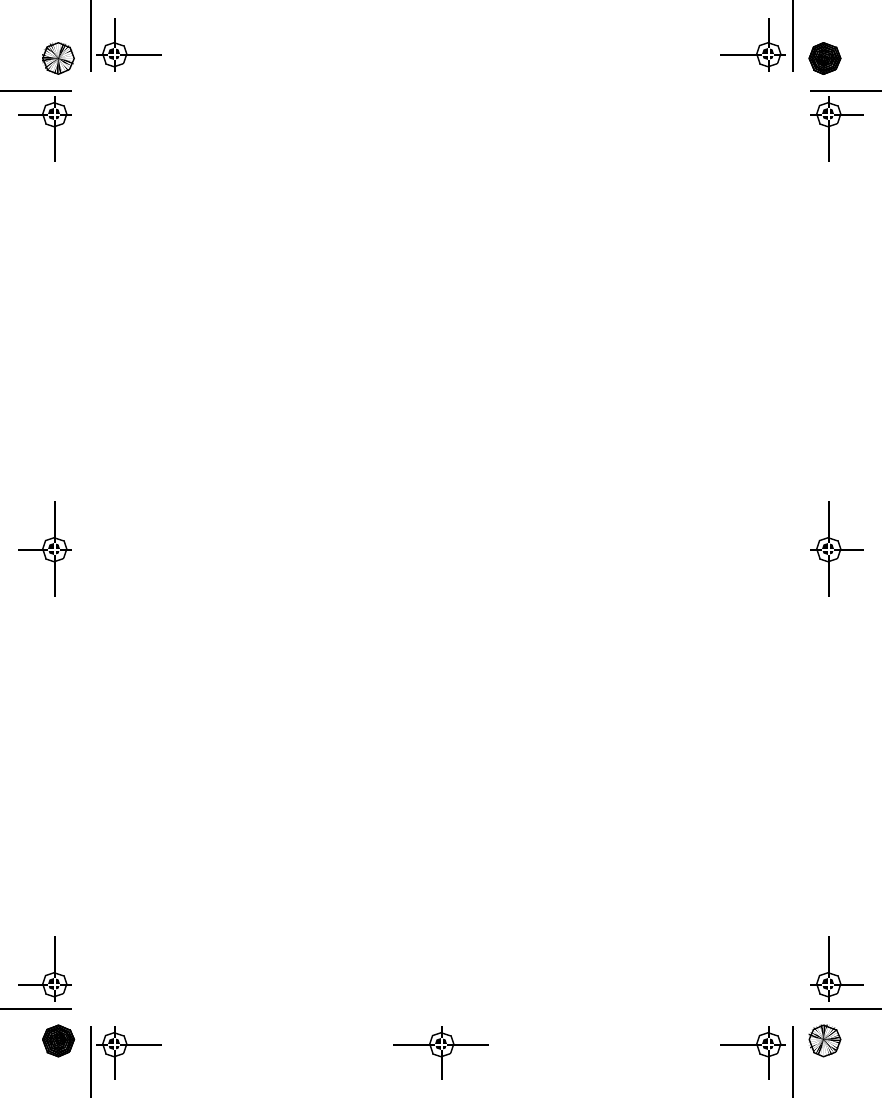
[ 96 ]
14 Reference information
This section provides information about your phone’s batteries,
accessories, chargers, safety guidelines and technical information. Be
aware that the information in this section is subject to change as
batteries, chargers, and accessories change.
• BATTERY STATEMENTS
Charging and Discharging
Your phone is powered by a rechargeable battery.
Note that a new battery's full performance may be achieved only after
two or three complete charge and discharge cycles!
The battery can be charged and discharged hundreds of times but it will
eventually wear out. When the operating time (talk time and standby
time) is noticeably shorter than normal, it is time to buy a new battery.
Use only batteries approved by the phone manufacturer and recharge
your battery only with the chargers approved by the manufacturer.
Unplug the charger when not in use. Do not leave the battery connected
to a charger for longer than a week, since overcharging may shorten its
lifetime. If left unused, a fully charged battery will discharge itself over
time.
Temperature extremes can affect the ability of your battery to charge;
allow it to cool down or warm up first.
For good operation times with NiMh batteries, discharge the battery from
time to time by leaving your phone switched on until it turns itself off (or
by using the battery discharge facility of any approved accessory available
for your phone). Do not attempt to discharge the battery by any other
means.
Use the battery only for its intended purpose.
Never use any charger or battery which is damaged or worn out.
EN1260.2_Sept_02.book Page 96 Friday, September 6, 2002 4:39 PM

[ 97 ]
Reference information
Do not short-circuit the battery. Accidental short-circuiting can occur
when a metallic object (coin, clip, or pen) causes direct connection of the
+ and - terminals of the battery (metal strips on the battery), for example,
when you carry a spare battery in your pocket or purse. Short-circuiting
the terminals may damage the battery or the connecting object.
Leaving the battery in hot or cold places, such as in a closed car in summer
or winter conditions, will reduce the capacity and lifetime of the battery.
Always try to keep the battery between 59°F and 77°F (15°C and 25°C). A
phone with a hot or cold battery may temporarily not work, even when
the battery is fully charged. Batteries' performance is particularly limited
in temperatures well below freezing.
Do not dispose of batteries in a fire!
Dispose of batteries according to applicable local regulations (for
example, recycling). Do not dispose of as household waste.
Note: For information on how to charge and recharge your battery,
refer to “Important battery information” on page11.
• PROPER CARE AND MAINTENANCE
Your phone is a product of superior design and craftsmanship and should
be treated with care. The suggestions below will help you to fulfill any
warranty obligations and to enjoy this product for many years:
•Keep the phone and all its parts and accessories out of the reach of
small children.
•Keep the phone dry. Precipitation, humidity and all types of liquids or
moisture can contain minerals that will corrode electronic circuits.
•Do not use or store the phone in dusty, dirty areas. Its moving parts
can be damaged.
•Do not store the phone in hot areas. High temperatures can shorten
the life of electronic devices, damage batteries, and warp or melt
certain plastics.
EN1260.2_Sept_02.book Page 97 Friday, September 6, 2002 4:39 PM
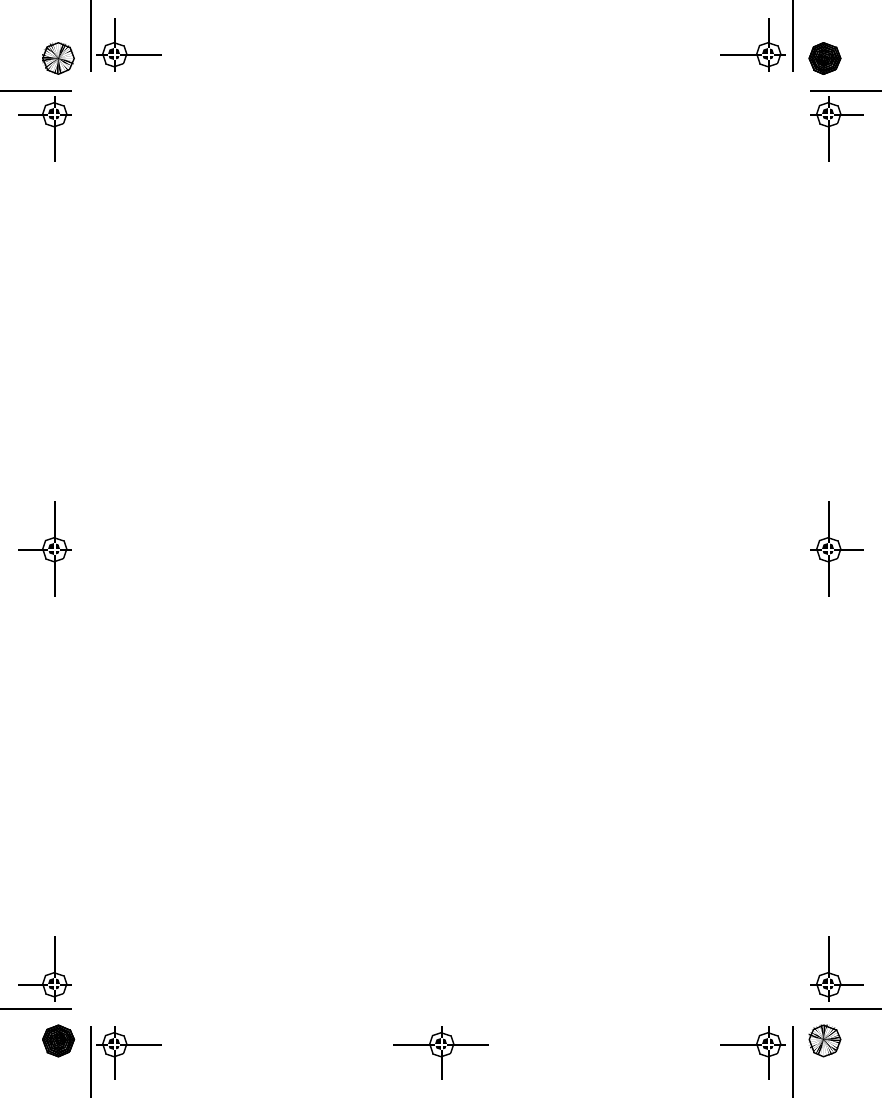
[ 98 ]
•Do not store the phone in cold areas. When it warms up (to its normal
temperature), moisture can form inside and may damage electronic
circuit boards.
•Do not attempt to open the phone. Nonexpert handling may damage
it.
•Do not drop, knock, or shake the phone. Rough handling can break
internal circuit boards.
•Do not use harsh chemicals, cleaning solvents, or strong detergents
to clean the phone.
•Do not paint the phone. Paint can clog the moving parts and prevent
proper operation.
•Use only the supplied or an approved replacement antenna.
Unauthorized antennas, modifications, or attachments could damage
the phone and may violate regulations governing radio devices.
All of the above suggestions apply equally to your phone, battery, charger
or any accessory. If any of them are not working properly, take them to
your nearest qualified service facility. The personnel there will assist you,
and if necessary, arrange for service.
• IMPORTANT SAFETY INFORMATION
This section provides additional safety information. A brief overview of
safety can be found in “Safety first” on page1.
Traffic safety
Do not use a hand-held telephone while driving a vehicle. Always secure
the phone in its holder; do not place the phone on the passenger seat or
where it can break loose in a collision or sudden stop.
Remember road safety always comes first!
EN1260.2_Sept_02.book Page 98 Friday, September 6, 2002 4:39 PM

[ 99 ]
Reference information
Operating environment
Remember to follow any special regulations in force in any area and
always switch off your phone whenever it is forbidden to use it, or when
it may cause interference or danger.
Use the phone only in its normal operating positions.
Parts of the phone are magnetic. Metallic materials may be attracted to
the phone, and persons with a hearing aid should not hold the phone to
the ear with the hearing aid. Always secure the phone in its holder,
because metallic materials may be attracted by the earpiece. Do not place
credit cards or other magnetic storage media near the phone, because
information stored on them may be erased.
Electronic devices
Most modern electronic equipment is shielded from radio frequency (RF)
signals. However, certain electronic equipment may not be shielded
against the RF signals from your wireless phone.
PACEMAKERS
Pacemaker manufacturers recommend that a minimum separation of 6
inches (20 cm) be maintained between a hand-held wireless phone and a
pacemaker to avoid potential interference with the pacemaker. These
recommendations are consistent with the independent research by and
recommendations of Wireless Technology Research. Persons with
pacemakers:
•Should always keep the phone more than 6 inches (20 cm) from their
pacemaker when the phone is switched on
•Should not carry the phone in a breast pocket
•Should use the ear opposite the pacemaker to minimize the potential
for interference.
•If you have any reason to suspect that interference is taking place,
switch off your phone immediately.
EN1260.2_Sept_02.book Page 99 Friday, September 6, 2002 4:39 PM
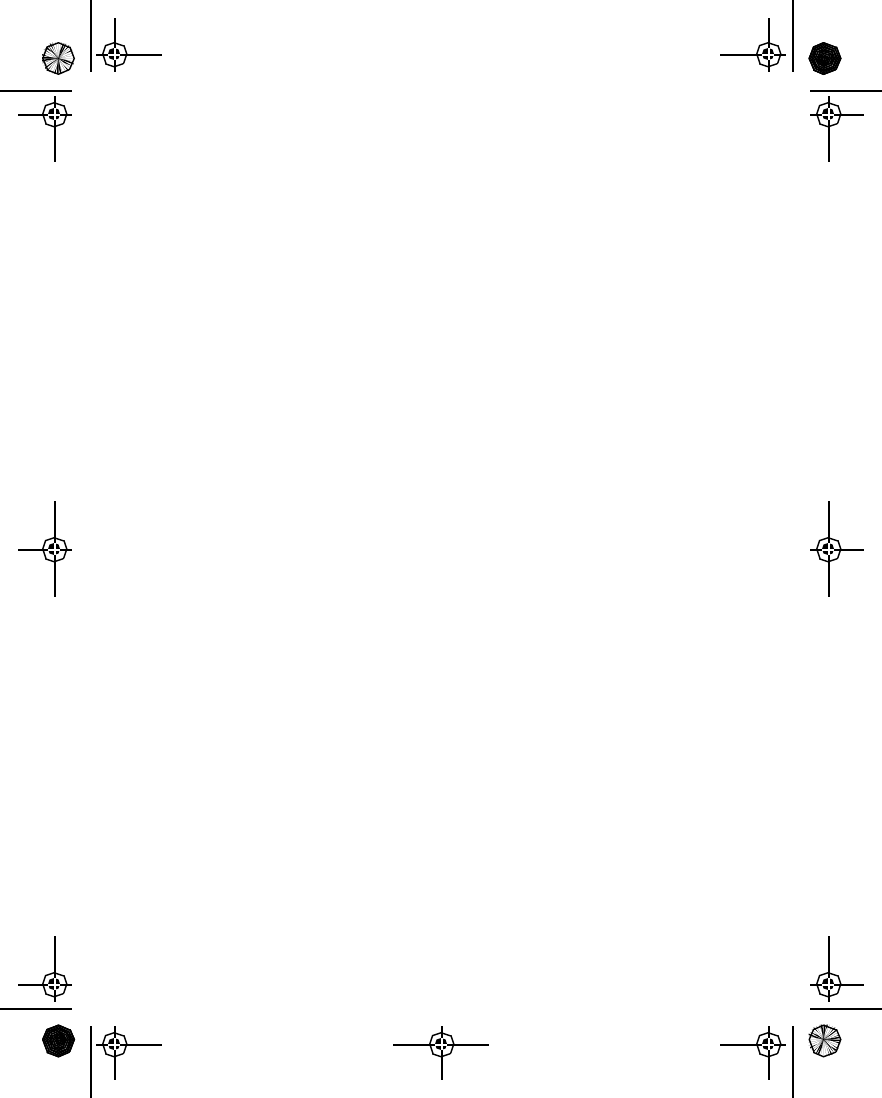
[ 100 ]
HEARING AIDS
Some digital wireless phones may interfere with some hearing aids. In the
event of such interference, you may want to consult your service provider.
Other medical devices
Operation of any radio transmitting equipment, including cellular phones,
may interfere with the functionality of inadequately protected medical
devices. Consult a physician or the manufacturer of the medical device to
determine if they are adequately shielded from external RF energy or if
you have any questions. Switch off your phone in health care facilities
when any regulations posted in these areas instruct you to do so.
Hospitals or health care facilities may be using equipment that could be
sensitive to external RF energy.
Vehicles
RF signals may affect improperly installed or inadequately shielded
electronic systems in motor vehicles (for example, electronic fuel
injection systems, electronic antiskid/antilock braking systems, electronic
speed control systems, air bag systems). Check with the manufacturer or
its representative regarding your vehicle. You should also consult the
manufacturer of any equipment that has been added to your vehicle.
POSTED FACILITIES
Switch your phone off in any facility where posted notices so require.
Potentially explosive atmospheres
Switch off your phone when in any area with a potentially explosive
atmosphere and obey all signs and instructions. Sparks in such areas could
cause an explosion or fire resulting in bodily injury or even death.
Users are advised to switch off the phone when at a refuelling point
(service station). Users are reminded of the need to observe restrictions on
the use of radio equipment in fuel depots (fuel storage and distribution
areas), chemical plants, or where blasting operations are in progress.
EN1260.2_Sept_02.book Page 100 Friday, September 6, 2002 4:39 PM
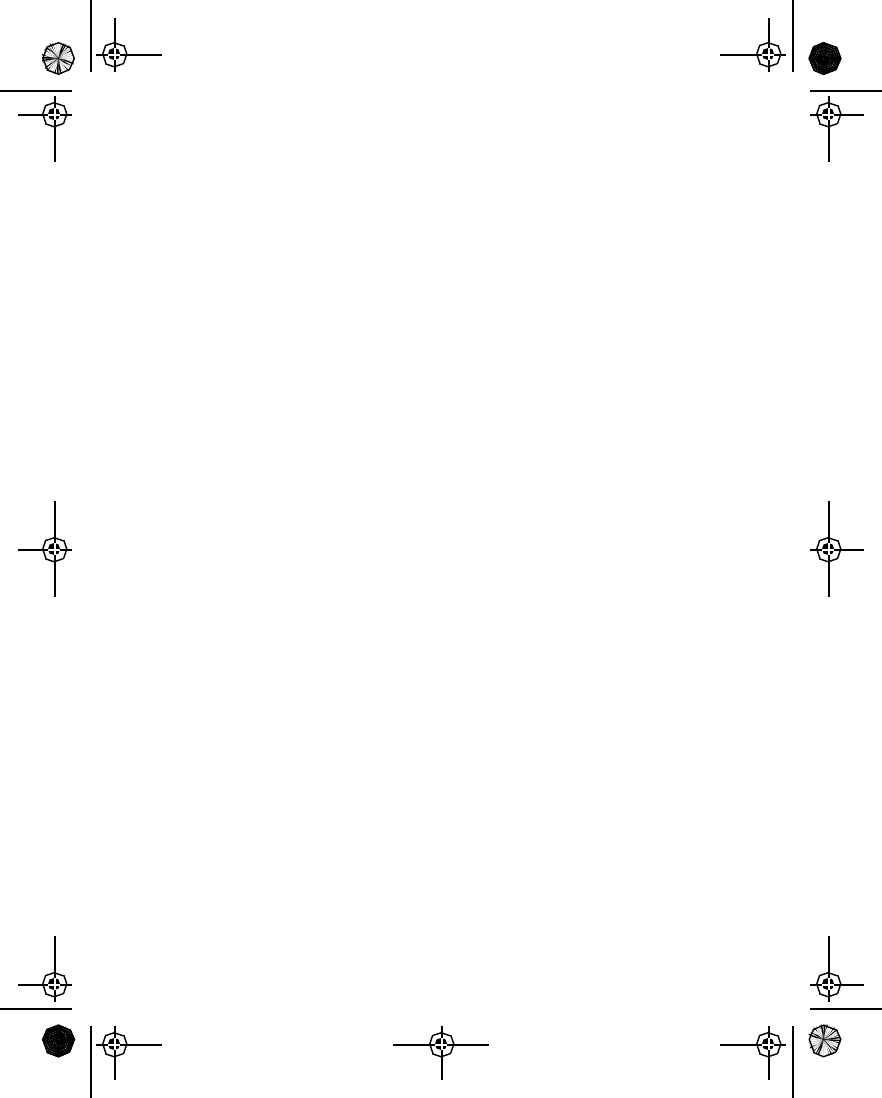
[ 101 ]
Reference information
Areas with a potentially explosive atmosphere are often but not always
clearly marked. They include below deck on boats; chemical transfer or
storage facilities; vehicles using liquefied petroleum gas (such as propane
or butane); areas where the air contains chemicals or particles, such as
grain, dust, or metal powders; and any other area where you would
normally be advised to turn off your vehicle engine.
Vehicles
Only qualified personnel should service the phone or install the phone in
a vehicle. Faulty installation or service may be dangerous and may
invalidate any warranty which may apply to the unit.
Check regularly that all wireless phone equipment in your vehicle is
mounted and operating properly.
Do not store or carry flammable liquids, gases or explosive materials in the
same compartment as the phone, its parts or accessories.
For vehicles equipped with an air bag, remember that an air bag inflates
with great force. Do not place objects, including both installed or portable
wireless equipment in the area over the air bag or in the air bag
deployment area. If in-vehicle wireless equipment is improperly installed
and the air bag inflates, serious injury could result.
FCC regulations prohibit using your phone while in the air. Switch off your
phone before boarding an aircraft. The use of wireless telephones in an
aircraft may be dangerous to the operation of the aircraft, disrupt the
wireless telephone network, and may be illegal.
Failure to observe these instructions may lead to suspension or denial of
telephone services to the offender, legal action or both.
EN1260.2_Sept_02.book Page 101 Friday, September 6, 2002 4:39 PM
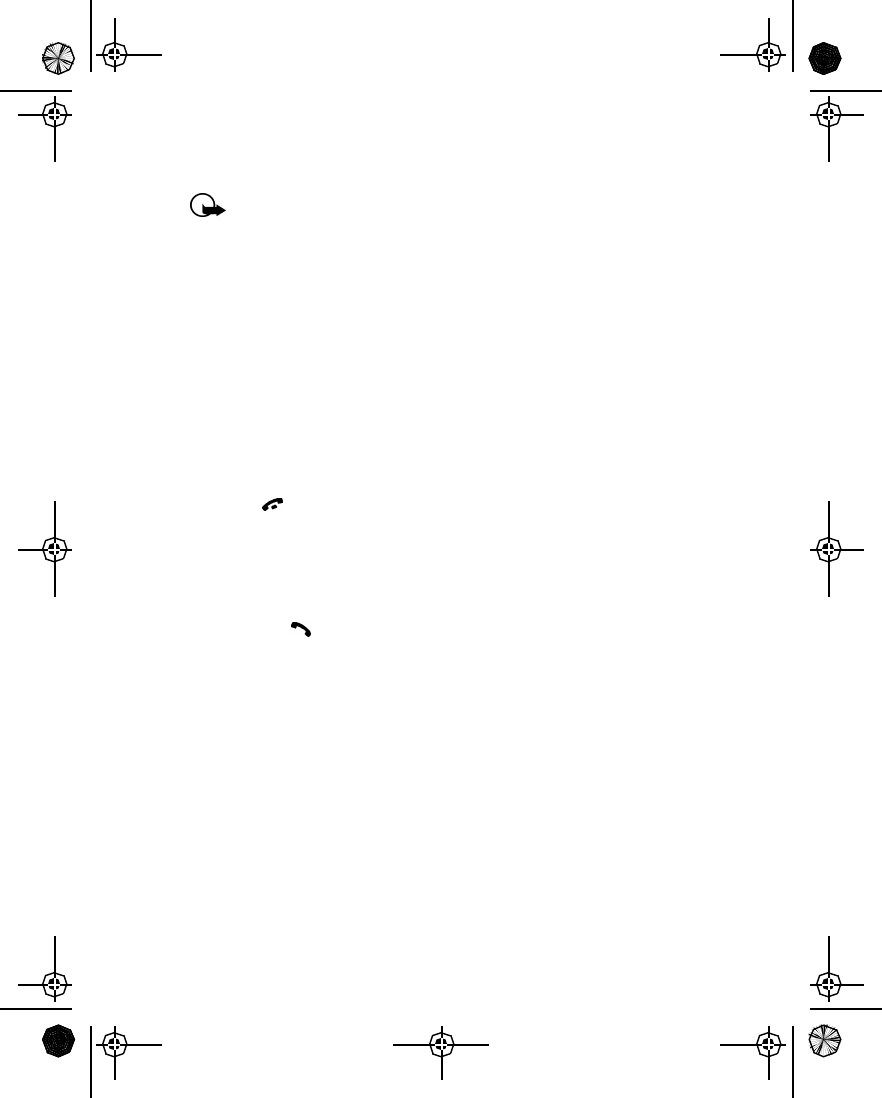
[ 102 ]
• MAKE EMERGENCY CALLS
Important:This phone, like any wireless phone, operates using
radio signals, wireless, and landline networks as well as user-
programmed functions. Because of this, connections in all
conditions cannot be guaranteed. Therefore you should never rely
solely upon any wireless phone for essential communications (for
example, medical emergencies).
Emergency calls may not be possible on all wireless phone networks or
when certain network services and/or phone features are in use. Check
with local service providers.
To make an emergency call:
1If the phone is not on, switch it on. Check for adequate signal
strength.
2Press as many times as needed (for example, to exit a call, to exit
a menu, etc.) to clear the display and ready the phone for calls.
3Key in the emergency number for your present location (for example,
911 or other official emergency number). Emergency numbers vary by
location.
4Press the key.
If certain features are in use, (keyguard, etc.) you may first need to turn
those features off before you can make an emergency call. Consult this
user guide and your local wireless service provider.
When making an emergency call, remember to give all the necessary
information as accurately as possible. Remember that your wireless phone
may be the only means of communication at the scene of an accident -
do not end the call until given permission to do so
EN1260.2_Sept_02.book Page 102 Friday, September 6, 2002 4:39 PM
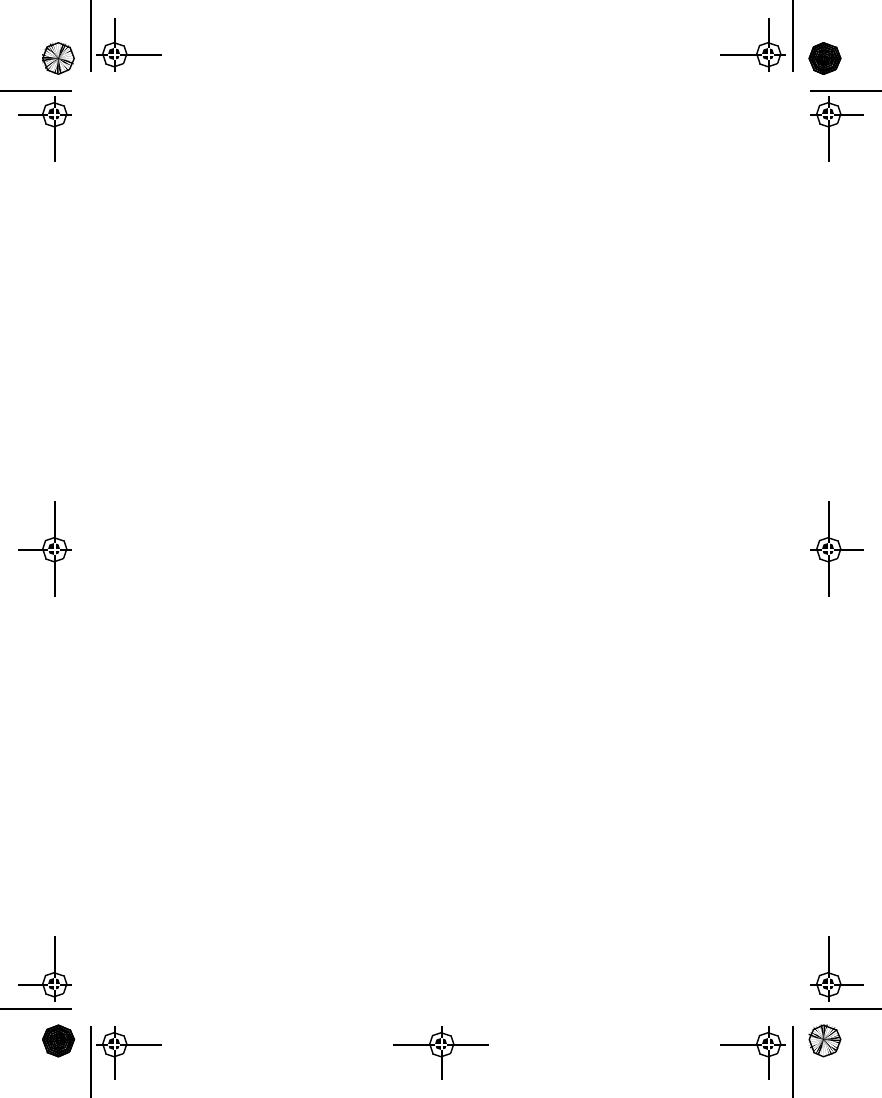
[ 103 ]
Reference information
• CERTIFICATION INFORMATION (SAR)
THIS MODEL PHONE MEETS THE GOVERNMENT'S REQUIREMENTS FOR
EXPOSURE TO RADIO WAVES.
Your wireless phone is a radio transmitter and receiver. It is designed and
manufactured not to exceed the emission limits for exposure to radio
frequency (RF) energy set by the Federal Communications Commission of
the U.S. Government. These limits are part of comprehensive guidelines
and establish permitted levels of RF energy for the general population. The
guidelines are based on standards that were developed by independent
scientific organizations through periodic and thorough evaluation of
scientific studies. The standards include a substantial safety margin
designed to assure the safety of all persons, regardless of age and health.
The exposure standard for wireless mobile phones employs a unit of
measurement known as the Specific Absorption Rate, or SAR. The SAR
limit set by the FCC is 1.6W/kg.* Tests for SAR are conducted using
standard operating positions accepted by the FCC with the phone
transmitting at its highest certified power level in all tested frequency
bands. Although the SAR is determined at the highest certified power
level, the actual SAR level of the phone while operating can be well below
the maximum value. This is because the phone is designed to operate at
multiple power levels so as to use only the power required to reach the
network. In general, the closer you are to a wireless base station antenna,
the lower the power output.
Before a phone model is available for sale to the public, it must be tested
and certified to the FCC that it does not exceed the limit established by
the government-adopted requirement for safe exposure. The tests are
performed in positions and locations (for example, at the ear and worn on
the body) as required by the FCC for each model. The following values are
the highest SAR values for this model phone as reported to the FCC:
EN1260.2_Sept_02.book Page 103 Friday, September 6, 2002 4:39 PM
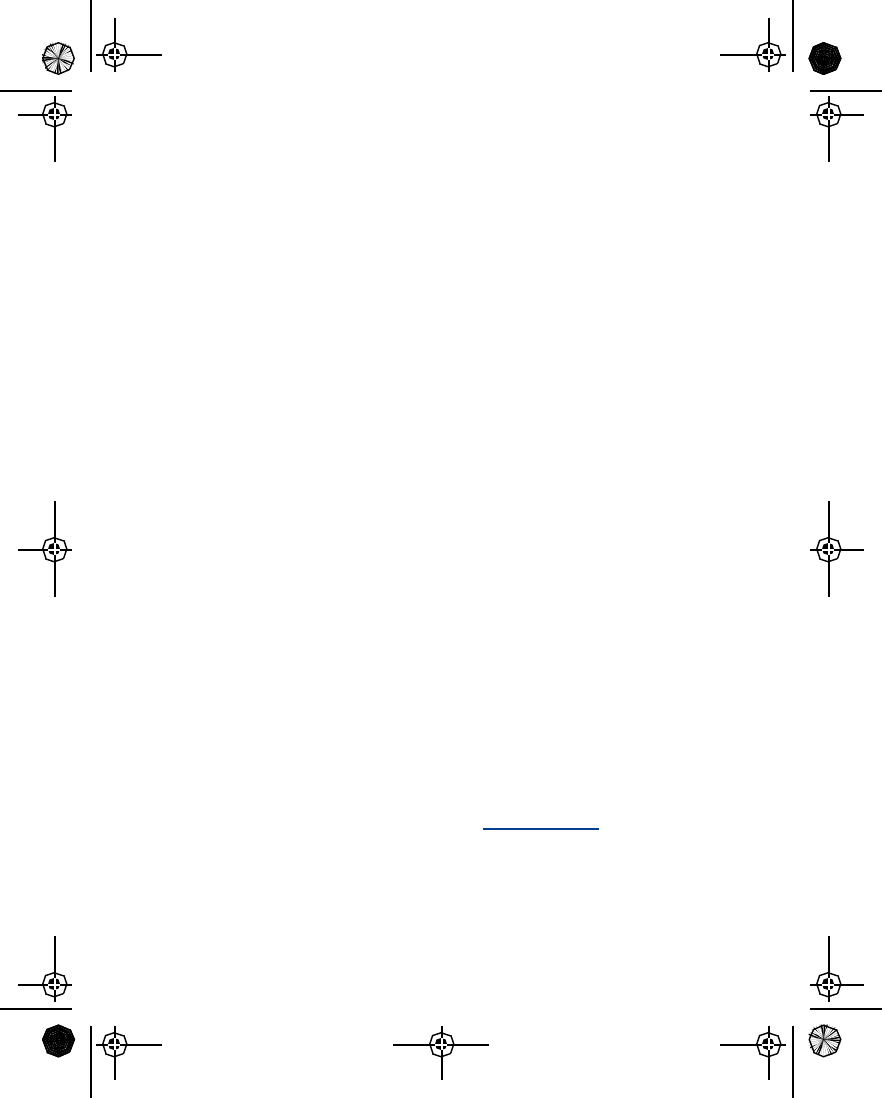
[ 104 ]
When tested for use at the ear -
FCCID # LJPNKW-1 is 1.16 W/kg
FCCID # LJPNKW-1X is 1.17 W/kg
When worn on the body, as described in this user guide:
FCCID # LJPNKW-1 is 0.95 W/kg
FCCID # LJPNKW-1X is 1.02 W/kg
(Body-worn measurements differ among phone models, depending upon
available accessories and FCC requirements).
While there may be differences between the SAR levels of various phones
and at various positions, they all meet the government requirement.
The FCC has granted an Equipment Authorization for this model phone
with all reported SAR levels evaluated as in compliance with the FCC RF
exposure guidelines. SAR information on this model phone is on file with
the FCC and can be found under the Display Grant section of
http://www.fcc.gov/oet/fccid after searching on FCC ID LJPNKW-1 and
LJPNKW-1X.
For body worn operation, this phone has been tested and meets the FCC
RF exposure guidelines when used with the Nokia accessories supplied or
designated for this product. Use of other accessories may not ensure
compliance with FCC RF exposure guidelines.
*In the United States and Canada, the SAR limit for mobile phones used
by the public is 1.6 watts/kilogram (W/kg) averaged over one gram of
tissue. The standard incorporates a substantial margin of safety to give
additional protection for the public and to account for any variations in
measurements. SAR values may vary depending on national reporting
requirements and the network band. For SAR information in other regions
please look under product information at www.nokia.com.
EN1260.2_Sept_02.book Page 104 Friday, September 6, 2002 4:39 PM
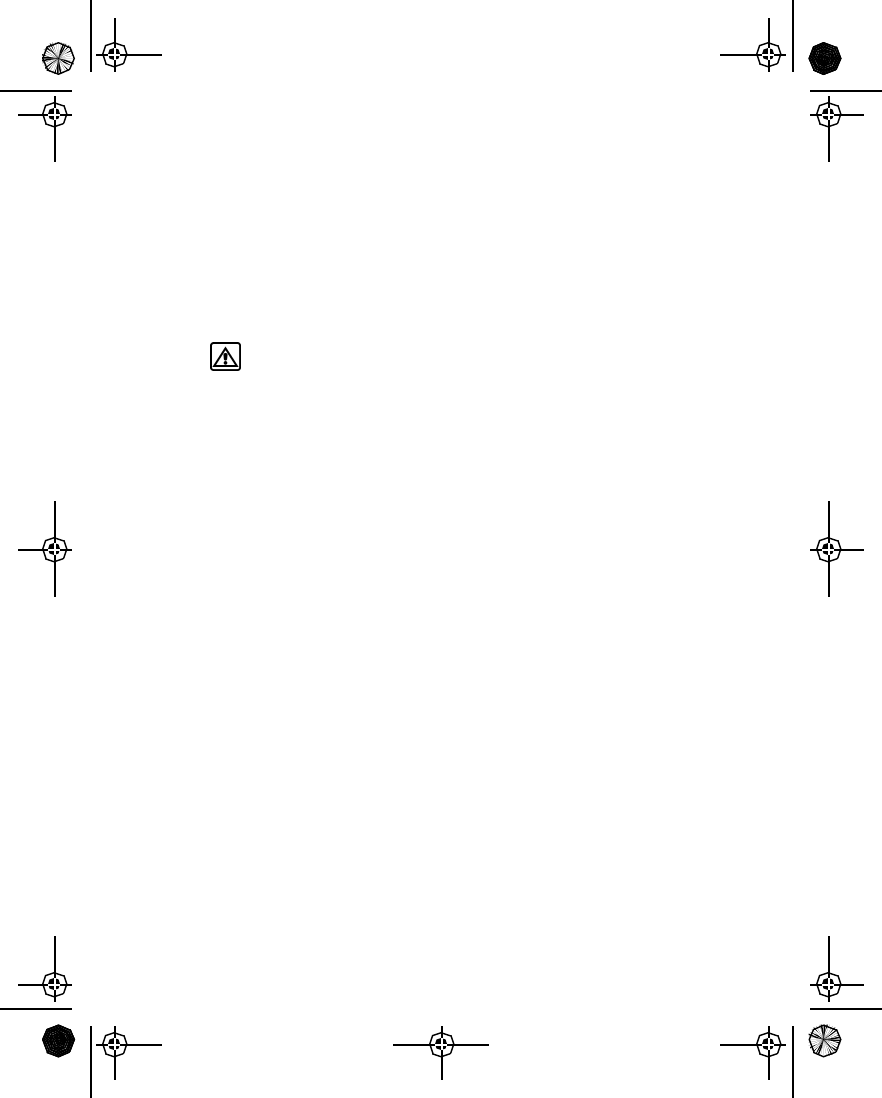
[ 105 ]
Reference information
• ACCESSORY SAFETY
This section provides information about the phone’s batteries, chargers,
and accessories. Be aware that the information in this section is subject
to change as the batteries, chargers, and accessories change.
Check the model number of any charger before use with this phone. This
device is intended for use when supplied with power from an ACP-7U,
ACP-8U, ACP-12U, LCH-9 charger.
Warning: Use only Nokia original accessories, or batteries,
chargers, and accessories approved by Nokia, for use with this
Nokia phone model. The use of any other types may invalidate any
approval or warranty applying to the phone, and may be dangerous.
For availability of approved accessories, please check with your dealer.
When you disconnect the power cord of any accessory, grasp and pull the
plug, not the cord.
When you are not using a charger, disconnect it from the power source.
When the battery is running out of power and your phone only has a few
minutes of talk time remaining, a warning tone sounds and the Battery low
message appears briefly. When no more talk time is left, a warning tone
is sounded and the phone switches itself off.
Practical rules for accessory operation
•Keep all accessories out of reach of small children.
•When you disconnect the power cord of any accessory, grasp and pull
the plug, not the cord.
•Check regularly that any vehicle-installed accessories are mounted
and are operating properly.
EN1260.2_Sept_02.book Page 105 Friday, September 6, 2002 4:39 PM

[ 106 ]
•Installation of any complex car accessories must be made by qualified
personnel only.
•Use only batteries, chargers, and accessories that have been approved
by the phone manufacturer. The use of any other types could
invalidate any approval or warranty applying to the phone and could
be dangerous. Refer to “Accessory safety” on page105 for important
battery usage information.
Batteries
This section provides information about the phone’s battery. Be aware
that the information in this section is subject to change.
Note: Dispose of used batteries in accordance with any local
regulations.
The tables shown in this section provide information about the batteries
that are available for your phone, charging times with the Rapid Travel
Charger (ACP-8U and ACP-12U), the Standard Travel Charger (ACP-7U),
talk times, and standby times. Consult your service provider for more
information.
Charging Times
The charging times listed below are approximate.
Battery option ACP-7U
Charger ACP-8U
Charger ACP-12U
Charger
BMC-3 NiMH Battery
900 mAh up to
4 h
up to
2 h
up to
1 h 40 m
EN1260.2_Sept_02.book Page 106 Friday, September 6, 2002 4:39 PM
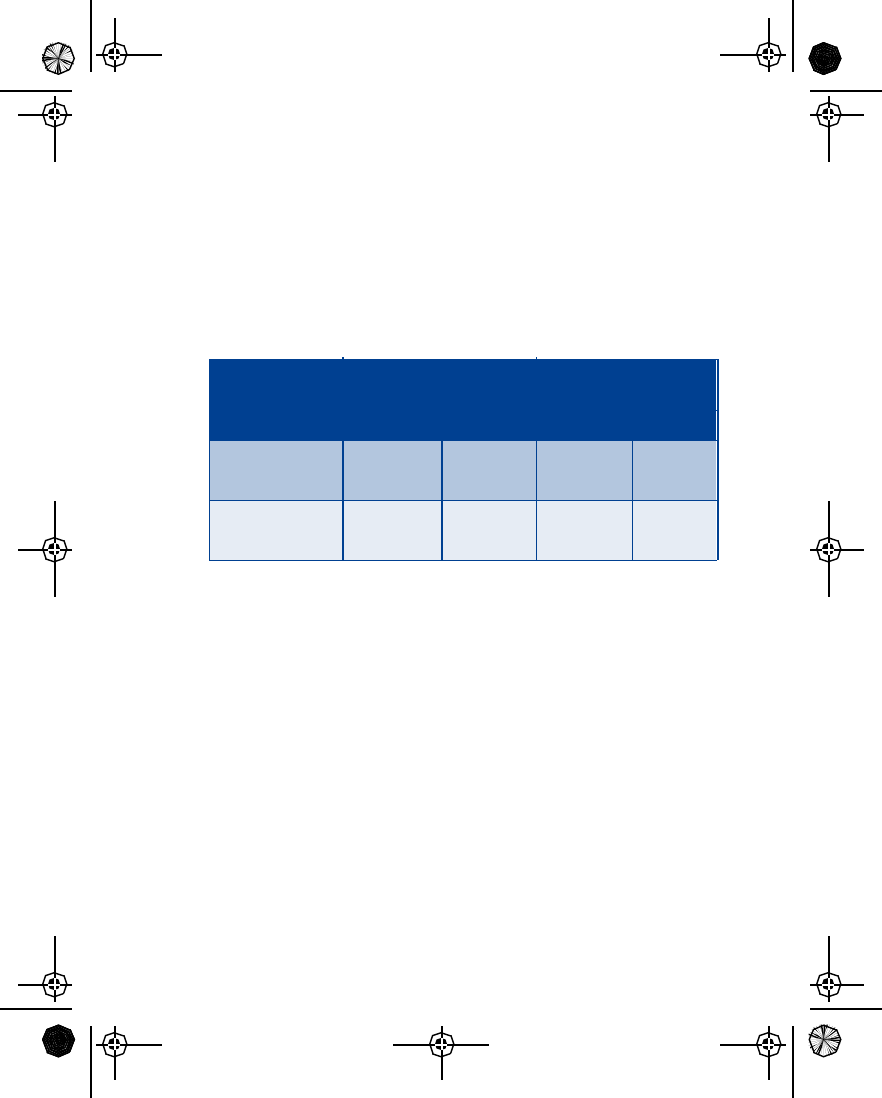
[ 107 ]
Reference information
Standby and Talk Times
Battery talk and standby times are estimates only and depend on signal
strength, network conditions, features used, battery age and condition
(including the effect of charging habits), temperatures to which the
battery is exposed, use in digital mode, and many other factors. Please
note that the amount of time a phone is used for calls will affect its
standby time. Likewise, the amount of time that the phone is turned on
and in standby mode will affect its talk time.
Battery
option Talk time Standby Time
Digital Analog Digital Analog
BMC-3 NiMH
Battery 900 mAh up to
2 h - 5 h
up to
1 h - 2 h
up to
6.5 d - 15 d
up to
1 d - 2 d
BLC-2 Li-ion
Battery 950 mAh up to
2.5 h - 5 h
up to
1 h - 2 h
up to
7 d - 16 d
up to
1 d - 2 d
EN1260.2_Sept_02.book Page 107 Friday, September 6, 2002 4:39 PM
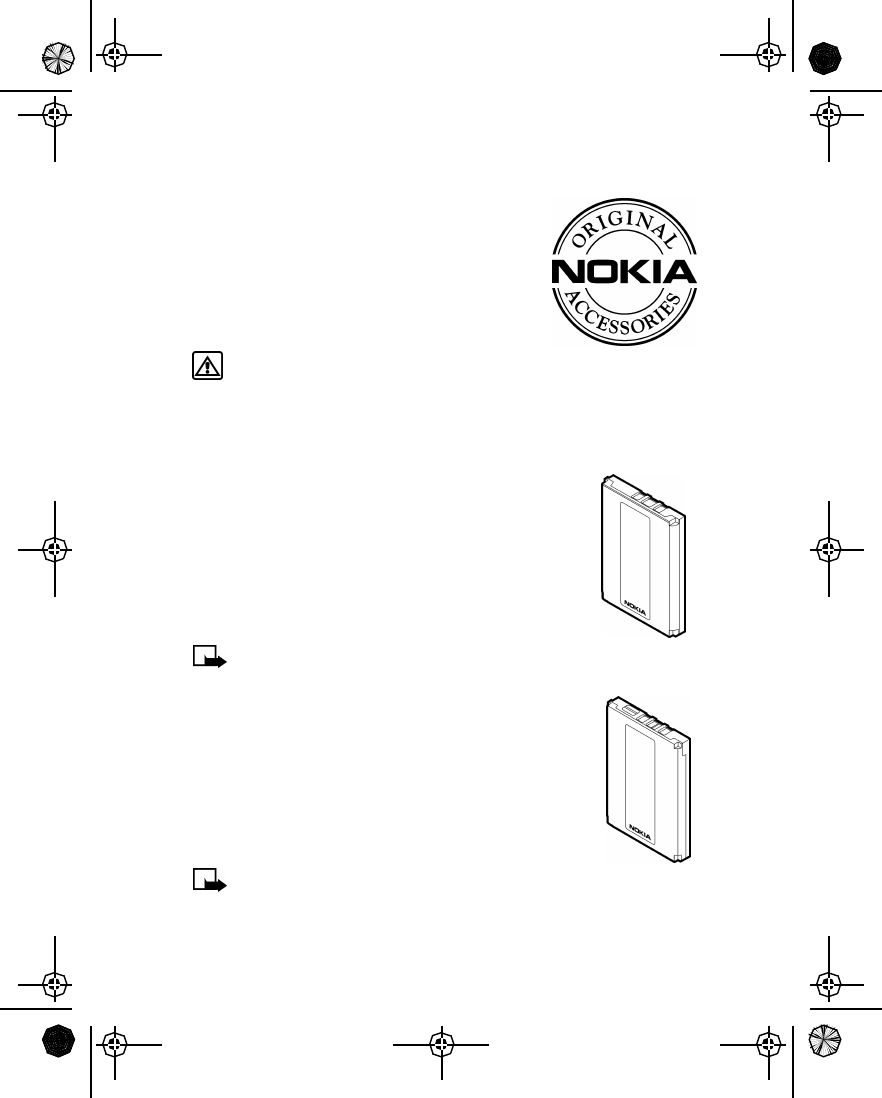
[ 108 ]
• ACCESSORIES
If you want to enhance your phone’s functionality,
a range of accessories is available for you. You can
select any of these items to help accommodate
your specific communication needs. For availability
of these and other accessories, contact your service
provider.
Warning: Use only Nokia original
accessories, or batteries, chargers and accessories approved by
Nokia, for use with this Nokia phone model. The use of any other
types may invalidate any approval or warranty applying to the
phone, and may be dangerous.
900 mAh NiMH Battery (BMC-3)
Provides up to 2 - 5 hours of digital talk time and
up to 6.5 - 15 days of digital standby time.
Provides up to 1 - 2 hours of analog talk time and
up to 1 - 2 days of analog standby time.
Note: Operation times are estimates and may
vary depending on network conditions, charging and phone use.
950 mAh Li-ion Battery (BLC-2))
Provides up to 2.5 - 5 hours of digital talk time and
up to 7 - 16 days of digital standby time.
Provides up to 1 - 2 hours of analog talk time and
up to 1 - 2 days of analog standby time.
Note: Operation times are estimates and may
vary depending on network conditions, charging and phone use.
EN1260.2_Sept_02.book Page 108 Friday, September 6, 2002 4:39 PM

[ 109 ]
Reference information
Standard Travel Charger (ACP-7U)
The Standard Travel Charger is a lightweight
(187 g) and durable AC charger.
To use the Standard Travel Charger, plug it into a
standard 120 V AC wall outlet and connect the
lead from the charger to the base of your phone.
Note: If the battery is completely empty,
you cannot use the phone until it has enough charge to operate.
Rapid Travel Charger (ACP-8U)
The Rapid Travel Charger is a lightweight (100 g) and
durable AC charger. Calls can be made during charging,
even with a fully discharged battery.
To use the Rapid Travel Charger (ACP-8), plug it into a
standard 120 V or 220 V AC wall outlet, and connect the
lead from the charger to the base of your phone.
Approximate charging times for discharged batteries are
shown in “Charging Times” on page106.
Rapid Travel Charger (ACP-12U)
The Rapid Travel Charger is a lightweight and
durable AC charger. Calls can be made during
charging, even with a fully discharged battery.
To use the Rapid Travel Charger (ACP-12U),
plug it into a standard 120 V or 220 V AC wall
outlet, and connect the lead from the charger
to the base of your phone.
EN1260.2_Sept_02.book Page 109 Friday, September 6, 2002 4:39 PM

[ 110 ]
Rapid Cigarette Lighter Charger (LCH-9)
You can charge your phone’s battery from
your vehicle battery by using the Rapid
Cigarette Lighter Charger (LCH-9).
Calls are possible during charging. A green
light indicates that the charger is ready for
charging. The battery charging times are the
same as those for the Rapid Travel Charger (ACP-8).
The input voltage range is from 11 V to 24 V DC, negative grounding.
Avoid prolonged charging with the Rapid Cigarette Lighter Charger (LCH-9)
when the car engine is not running; this could cause your car battery to
drain. Note also, that in some cars, the cigarette lighter plug is not
provided with electricity if the ignition is not switched on.
Spare Battery Charger (DDC-1)
Lightweight and stylish, this charger
provides a convenient way to charge
your spare battery.
Compatible with:
Standard Travel Charger (ACP-7U)
Rapid Travel Charger (ACP-8U)
EN1260.2_Sept_02.book Page 110 Friday, September 6, 2002 4:39 PM
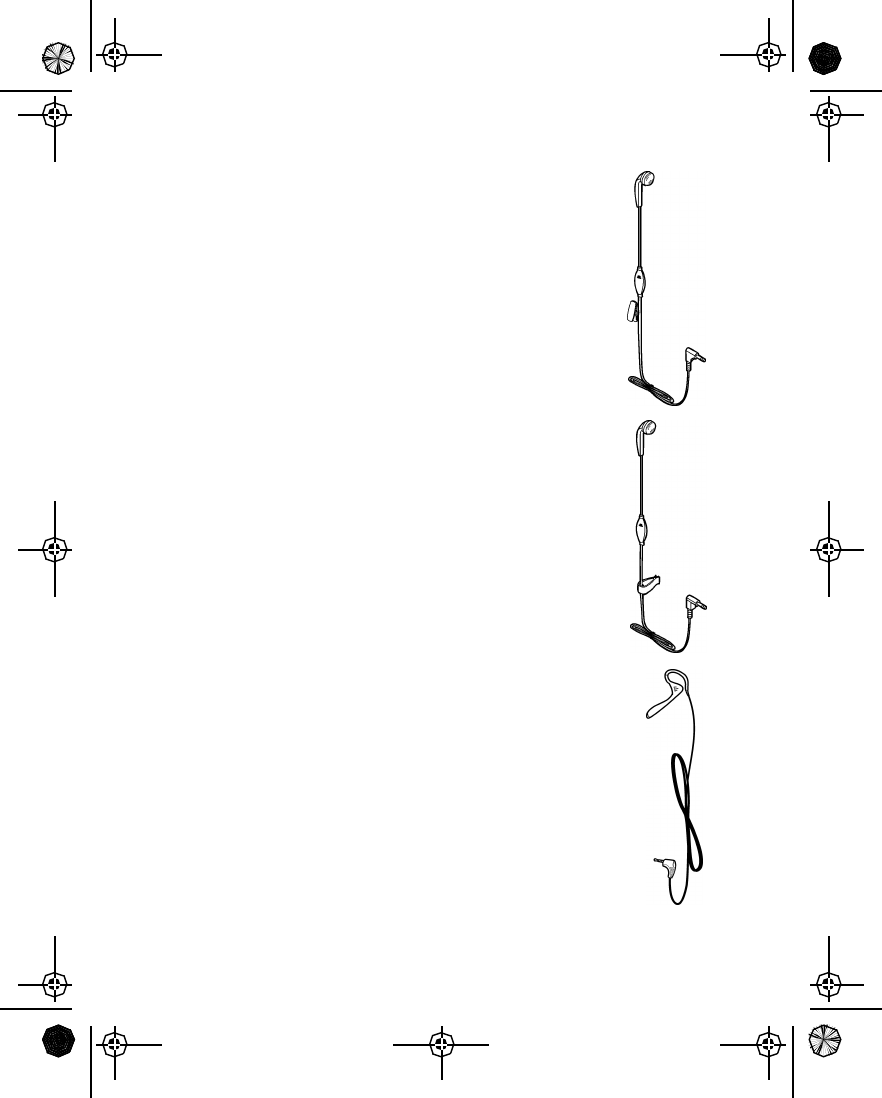
[ 111 ]
Reference information
Headset (HDC-5)
Small and lightweight, the headset allows easy and
convenient handsfree operation. The headset has a foam
earpiece cover for a comfortable fit and has a clip to hold
it firmly in place. This headset’s 4-wire 2.5 mm jack fits
directly into the bottom of the phone. A remote control
button located in the microphone makes the headset
convenient to use while answering or receiving calls.
Headset (HDE-2)
Small and lightweight, the headset allows easy and
convenient handsfree operation. This headset comes with
a clip for a comfortable fit. This headset’s 4-wire 2.5 mm
jack fits directly into the bottom of your phone.
Boom headset (HDB-5)
Compact and functional, the Boom Headset provides you
with convenient, portable handsfree facility. A new and
modern “over the ear” concept with a stylish design and
basic handsfree functionality, including the answer/end
button.
This headset’s 4-wire 2.5 mm jack fits directly into the
bottom of your phone.
EN1260.2_Sept_02.book Page 111 Friday, September 6, 2002 4:39 PM
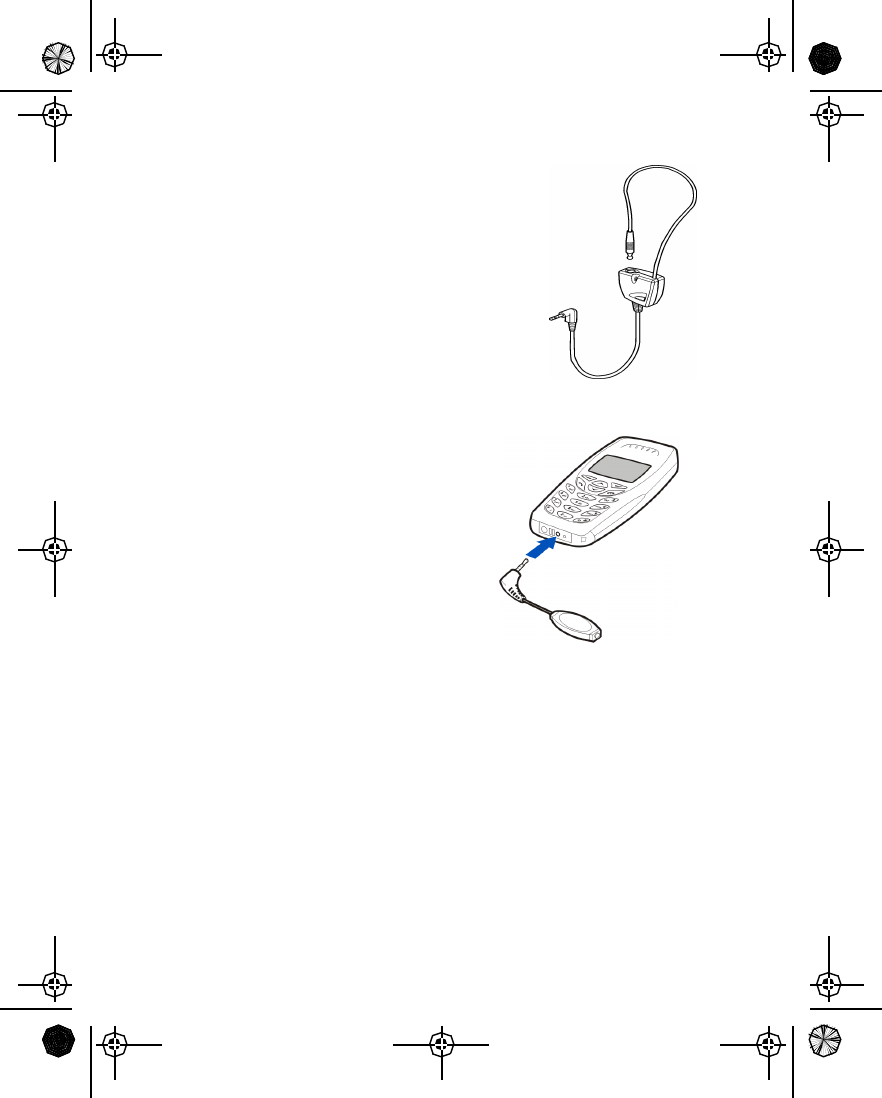
[ 112 ]
Loopset (LPS-3)
With the Nokia Loopset, people who use a T-coil
equipped hearing aid have the freedom to talk on
a digital mobile phone. The loopset goes around
your neck - so it can be worn comfortably and
discreetly.
TTY/TDD Adapter (HDA-9)
The TTY/TDD Adapter is a Nokia
accessory that allows you to connect
your mobile phone to a
Telecommunications Device for the
Deaf (TTY/TDD) to make a call in digital
mode.
WHAT YOU’LL NEED
In addition to the Nokia phone, you’ll
need the following for TTY/TDD
communication.
•A TTY/TDD device that is “cellular ready” or “cellular compatible”
•A cable for connecting the TTY/TDD to your phone, usually supplied by
the manufacturer of the TTY/TDD device.
•The TTY/TDD Adapter (HDA-9), which can be purchased separately as
an accessory at www.nokia.com
TTY/TDD
Adapter
EN1260.2_Sept_02.book Page 112 Friday, September 6, 2002 4:39 PM

[ 113 ]
Reference information
Mobile Holder (MBC-6)
Small and easy to use, the Mobile Holder
provides an ideal place to hold the phone in a
vehicle. The Mobile Holder is easy to attach to
the dashboard via a mounting plate or swivel.
The Mobile Holder is compatible with the Rapid
Cigarette Lighter Charger (LCH-9) and the
Express Car Kit (PPH-1).
Express Car Kit
(CARK 125)
This car kit provides charging
and handsfree functionality.
With excellent audio quality,
the car kit is easy to use and
is compatible with 12 V
systems.
The Express Car Kit Includes a
holder, plug-in handsfree,
external microphone.
EN1260.2_Sept_02.book Page 113 Friday, September 6, 2002 4:39 PM
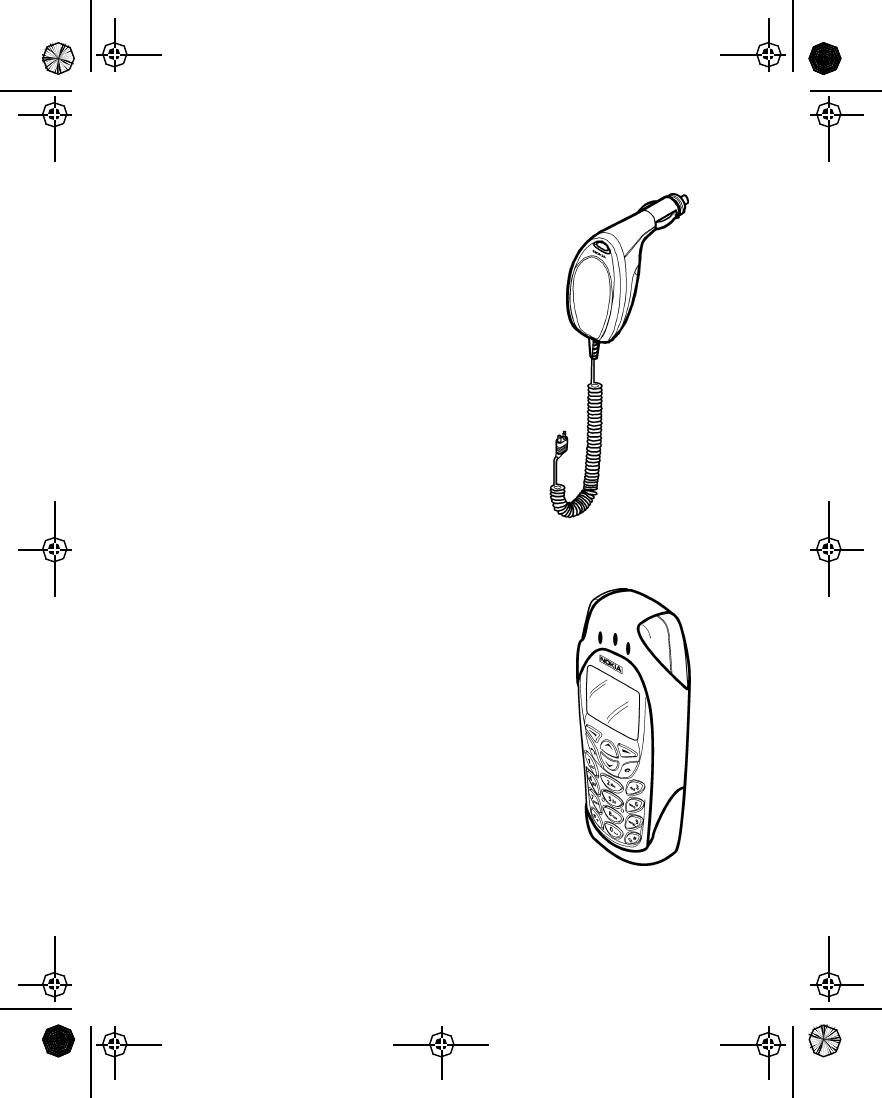
[ 114 ]
Express Car Kit (PPH-1)
The Express Car Kit provides charging and
handsfree functionality. Compatible with 12 V
systems, the Express Car Kit plugs into the
cigarette lighter socket for charging. A green
light indicates readiness for charging. The
Express Car Kit has a built in speaker and uses
the phone’s microphone. The Express Car Kit
also has a connector for an optional external
microphone (HFM-8). The microphone should
be installed 20” apart from the external speaker.
The Express Car Kit requires no screws for
installation and thus can be moved easily from
car to car.
Carry case (CSM-6)
Handsome leather case helps protect your phone
and allows for easy keypad access. The clip attaches
to your belt for convenience. (shown at right)
EN1260.2_Sept_02.book Page 114 Friday, September 6, 2002 4:39 PM
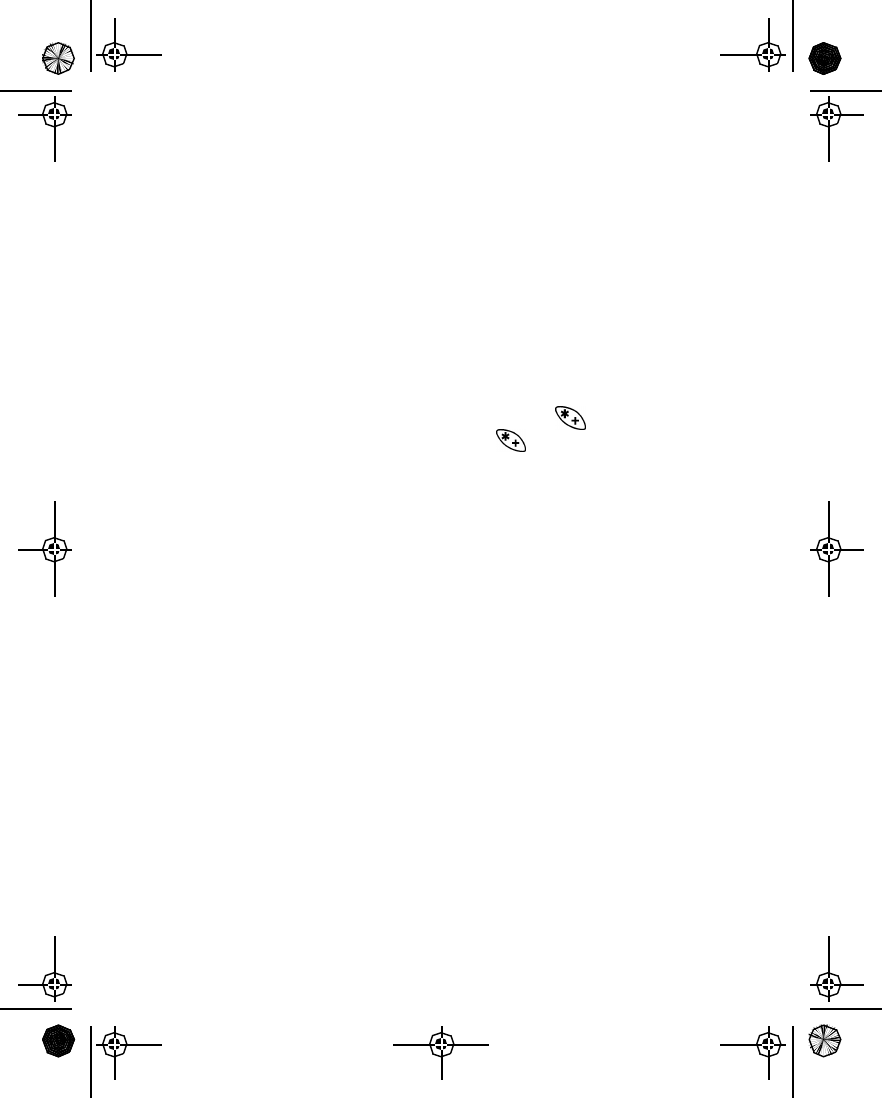
[ 115 ]
Reference information
• FREQUENTLY ASKED QUESTIONS
This section lists and answers the questions phone users most frequently
ask. Some of the answers tell you to use menu shortcuts. For a complete
listing of these shortcuts, refer to “Menu shortcuts” on page25.
Q. What is my security code?
A. The default security code is 12345. However, Nokia recommends that
you change this code immediately. Certain features can be used only
after the correct security code has been successfully entered.
Q. How do I lock and unlock the keypad?
A. You can lock the keypad by pressing Menu > . To unlock the
keypad press Unlock and then press .
The term Keyguard is also used in connection with this feature.
Q. How do I make the ringing louder?
A. Press Menu 3 (Profiles), and scroll through the list of profiles until
you find the one for which you want to set the ringing volume. Then
press Options.
•Highlight Customize and press Select.
•Scroll to Ringing volume, and then press Select.
•Scroll through the options to find the volume level you want and
press Select.
Q. How do I change the ringing tone?
A. Press Menu 3 (Profiles) and scroll through the list of profiles until
you find the one for which you want to set the ringing tone. Then
press Options.
•Highlight Customize and press Select.
•Scroll to Ringing tone, and then press Select.
•Scroll through the options. After you hear the tone you want to
use, press Select.
EN1260.2_Sept_02.book Page 115 Friday, September 6, 2002 4:39 PM
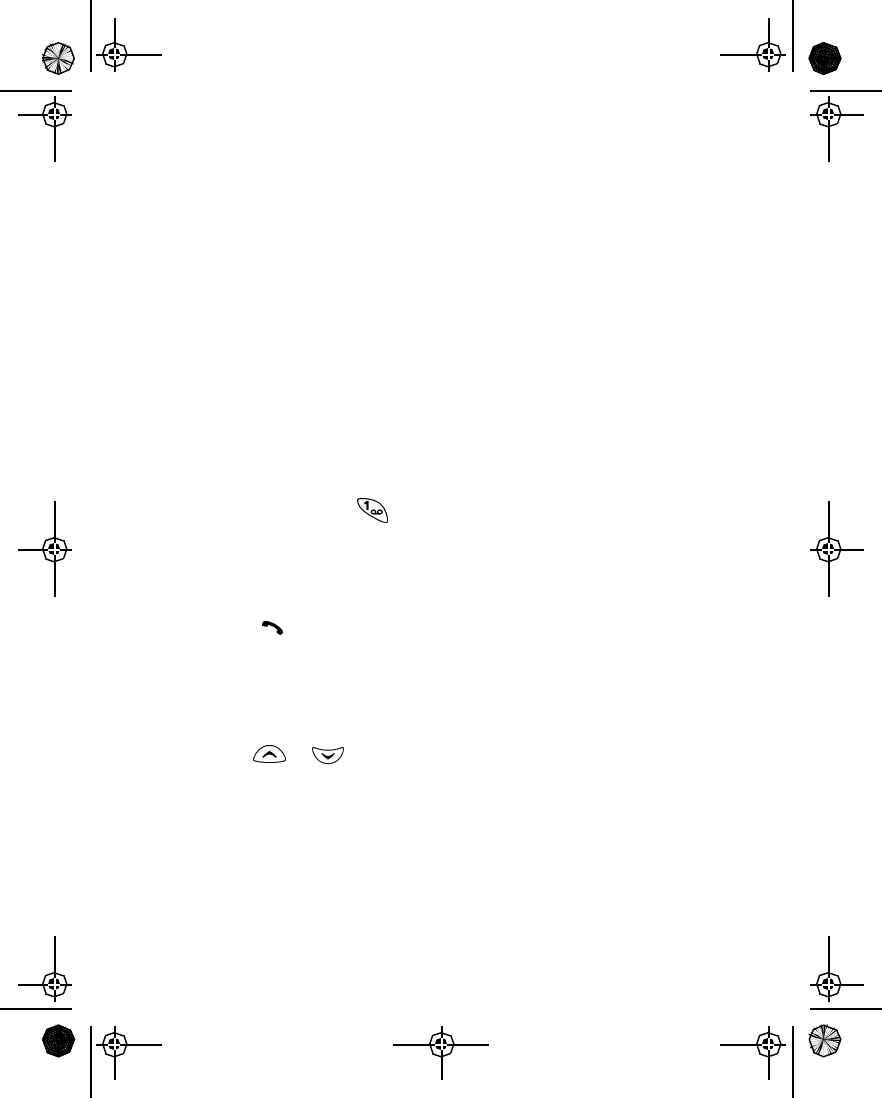
[ 116 ]
Q. How do I store my voice mailbox number?
A. Press Menu 1-8-2 (Messages > Voice messages > Voice mailbox
number). Enter your voice mailbox phone number, and press OK.
The screen tells you that the number is saved.
This voice mailbox number is valid unless your phone number changes.
If your phone number changes, you will have to save a new voice
mailbox number.
Q. How do I call my voice mailbox number (retrieve voice messages)?
A. When your phone alerts you to new voice messages, press Listen and
follow the instructions on the phone. If you’d rather listen to your
messages later, press Exit.
To listen to your voice messages at a later time, perform one of the
following actions:
•Press and hold .
•Press Menu 1-8-1 (Messages > Voice messages > Listen to
voice messages). Follow the voice prompts to review your messages.
Q. How do I redial the last-dialed number?
A. Press twice.
Q. How do I assign a key to 1-touch dialing?
A. Press Names and scroll to 1-touch dialing.
Press Select.
Use or to scroll to the first number that includes the
message (empty) and press Assign.
Retrieve the name/number you want to assign this key and press
Select.
Repeat these steps as many times as necessary.
Q. How do I find out the amount of memory I have used in my phone?
A. Press Names and scroll to Options.
EN1260.2_Sept_02.book Page 116 Friday, September 6, 2002 4:39 PM
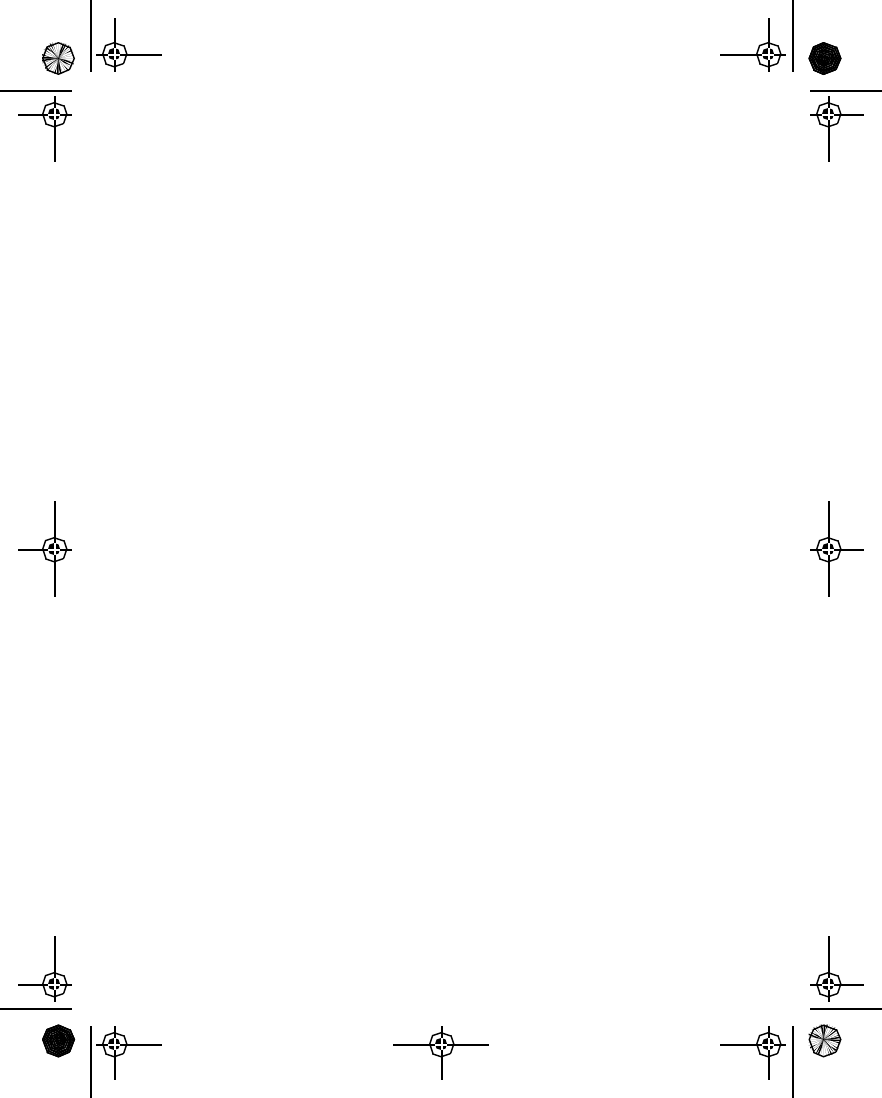
[ 117 ]
Reference information
Press Select. Scroll to Memory status and press Select again. Your
memory status appears.
Q. How do I find my phone’s Model number and ESN number?
A. The model number and ESN numbers are located on a label under the
phone’s battery. Turn your phone off, remove the back cover and then
remove the battery from the phone.
Q. How do I clear my call timers?
A. WARNING: The clearing of call timers cannot be undone.
Press Menu 2-5-3 (Call log > Call timers > Clear timers).
When the security code prompt appears, enter your security code
and press OK.
EN1260.2_Sept_02.book Page 117 Friday, September 6, 2002 4:39 PM

[ 118 ]
• GLOSSARY
Business card A business card is the same as an entry in the phone
book. It may contain a name, phone number, and text
entry. It can also be sent to other devices.
Call forwarding A network services feature you use to forward
incoming calls to another number.
Call lists A list used to track numbers for dialed, received, or
missed calls.
Call log A log that registers information about calls you make
and receive.
Call timers Timers used to track the amount of time you spend
on calls.
Call waiting A network services feature that enables your phone
to beep while you are in the middle of a call. The beep
lets you know that someone else is calling you.
Electronic serial
number (ESN) The identification number that is assigned to the
phone. This number is located under the battery.
In-call options Features available for use while you are in a call.
Keyguard Locks the keypad to prevent accidental key presses.
Keypad tones The tone you hear when you press a key.
Menu A list of choices you can make to change settings on
your phone or use various phone features.
Predictive text A method of entering information in your phone that
uses a dictionary to predict, or guess, what you are
writing.
EN1260.2_Sept_02.book Page 118 Friday, September 6, 2002 4:39 PM
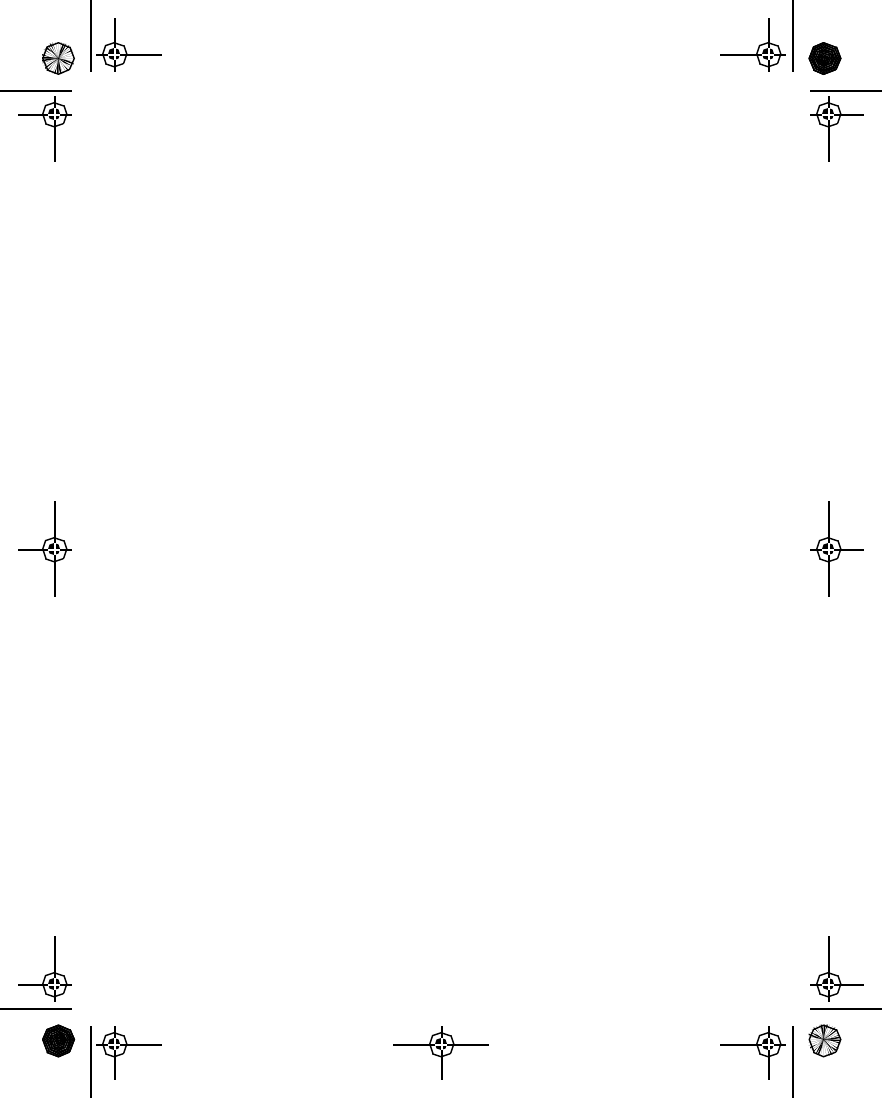
[ 119 ]
Reference information
Profile A group of settings you can use to customize the way
your phone works.
Quick save A fast method for saving a number to the phone
book.
Ringing tone The sound your phone makes when you receive a call.
Ringing tones can be ringing sounds or short tunes.
Scroll bar A bar that appears on the right side of the screen
when you scroll through the main menus.
SMS The quick way to say short message service.
Start screen Your phone’s idle screen.
Voice mail A network services feature that allows people who
call and miss you to leave a voice message in your
voice mailbox.
Warning tones Sounds your phone makes during error conditions,
during confirmations, when the battery is low, and
when you need to recharge the battery.
EN1260.2_Sept_02.book Page 119 Friday, September 6, 2002 4:39 PM
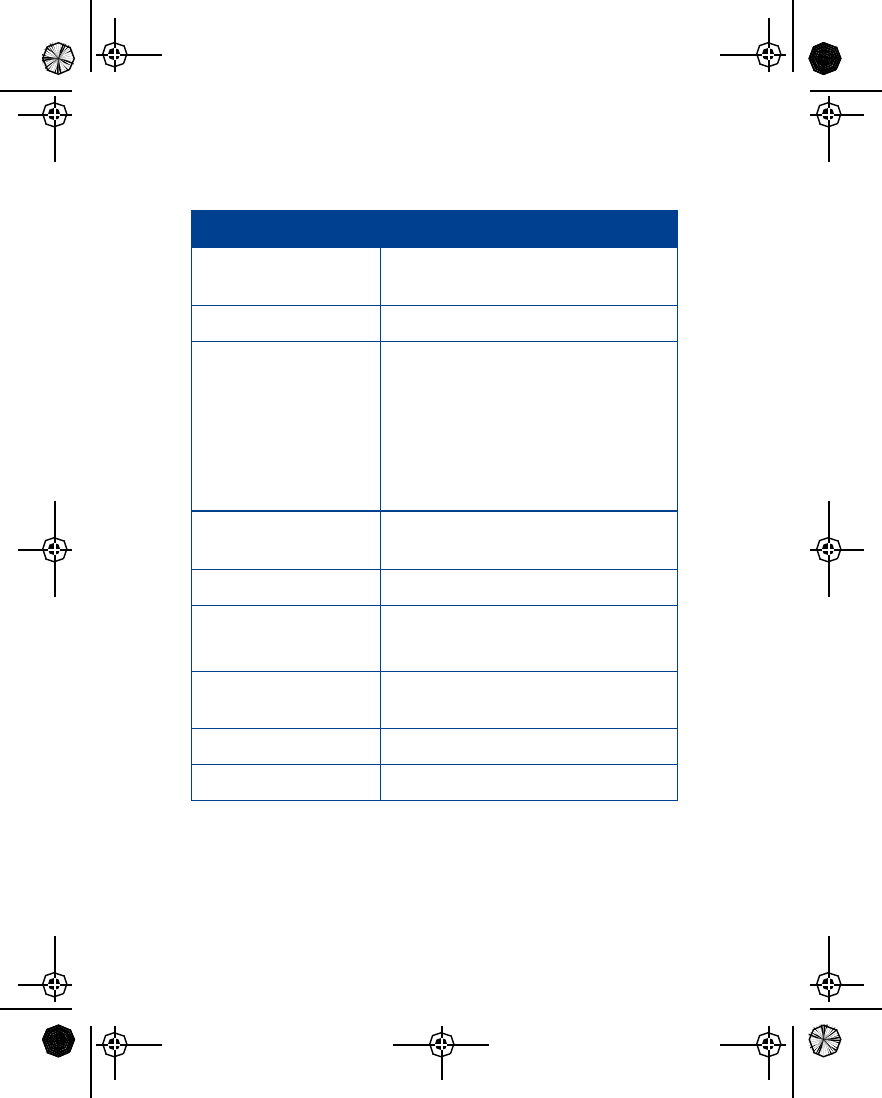
[ 120 ]
• TECHNICAL INFORMATION
Feature Specification
Weight 5.3 oz with BMC-3 900 mAh NiMH
battery
Size 105 cc
Frequency Range Lowband
824.04 - 848.97 MHz (TX)
869.04 - 893.97 MHz (RX)
Highband
1850.04 - 1909.92 MHz (TX)
1930.08 - 1989.96 MHz (RX)
Transmitter Output
Power Up to 600mW
Battery Voltage 3.6 V nominal
Operating Temperature -4°F to + 104°F
(-20°C to + 40°C)
Number of Channels 832 lowband
1997 highband
Phone numbers Up to 3
Memory Locations Up to 200
EN1260.2_Sept_02.book Page 120 Friday, September 6, 2002 4:39 PM
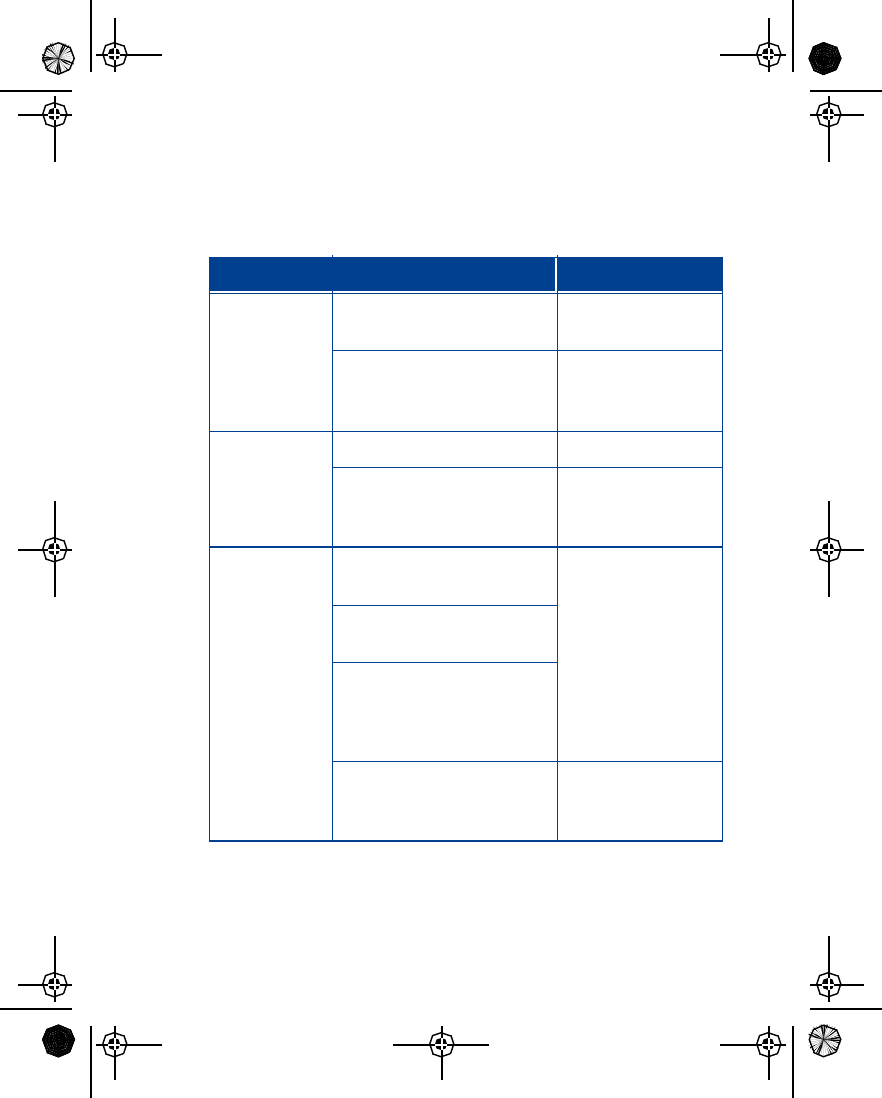
[ 121 ]
Reference information
• TROUBLESHOOTING
This section lists some of the most commonly encountered problems and
provides possible solutions.
Problem Possible cause Possible solution
My phone isn’t
charging. The charger and the phone are
not properly connected. Securely connect the
charger to the phone.
The charger is not properly
plugged in. Ensure that the
charger is plugged in
correctly.
My phone isn’t
making or
answering calls.
The battery is not charged. Charge the battery.
The signal strength is too low. If you are indoors,
move toward a
window.
I can’t listen to
my voice
messages.
You don’t have voice mail
service.
This is a service
provider dependent
feature. Please call
your wireless service
provider.
The voice mail number you
have saved is incorrect.
You have forgotten your
password or are entering in
incorrectly.
Your voice mail number is not
saved in the phone. Refer to “Save the
voice mailbox
number” on page48.
EN1260.2_Sept_02.book Page 121 Friday, September 6, 2002 4:39 PM
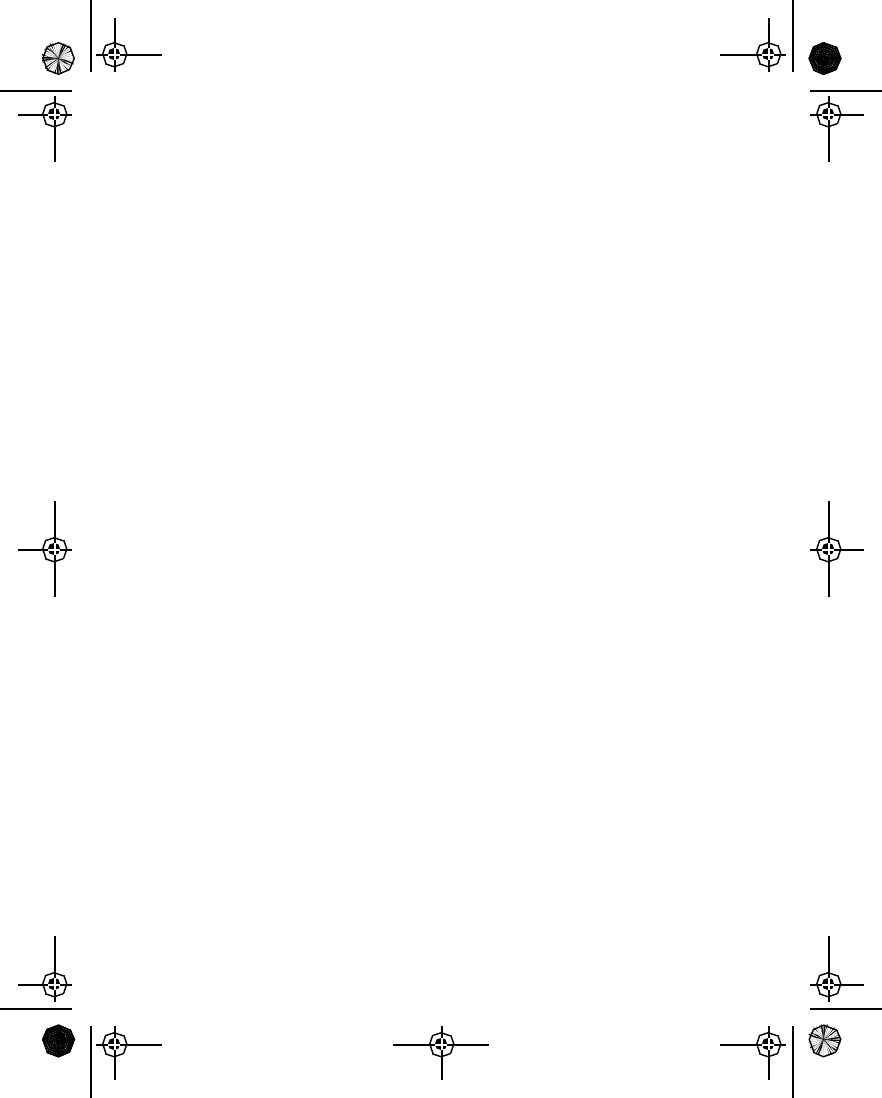
[ 122 ]
Nokia One-Year Limited
Warranty
Nokia Inc. (“Nokia”) warrants that this cellular phone (“Product”) is free
from defects in material and workmanship that result in Product failure
during normal usage, according to the following terms and conditions:
1The limited warranty for the Product extends for ONE (1) year beginning
on the date of the purchase of the Product. This one year period is
extended by each whole day that the Product is out of your possession
for repair under this warranty.
2The limited warranty extends only to the original purchaser (“Consumer”)
of the Product and is not assignable or transferable to any subsequent
purchaser/end-user.
3The limited warranty extends only to Consumers who purchase the
Product in the United States of America.
4During the limited warranty period, Nokia will repair, or replace, at
Nokia’s sole option, any defective parts, or any parts that will not
properly operate for their intended use with new or refurbished
replacement items if such repair or replacement is needed because
of product malfunction or failure during normal usage. No charge
will be made to the Consumer for any such parts. Nokia will also
pay for the labor charges incurred by Nokia in repairing or replacing
the defective parts. The limited warranty does not cover defects in
appearance, cosmetic, decorative or structural items, including
framing, and any non-operative parts. Nokia’s limit of liability under
the limited warranty shall be the actual cash value of the Product at
the time the Consumer returns the Product for repair, determined by
the price paid by the Consumer for the Product less a reasonable
amount for usage. Nokia shall not be liable for any other losses or
damages. These remedies are the Consumer’s exclusive remedies for
breach of warranty.
EN1260.2_Sept_02.book Page 122 Friday, September 6, 2002 4:39 PM

[ 123 ]
Reference information
5Upon request from Nokia, the Consumer must prove the date of the
original purchase of the Product by a dated bill of sale or dated
itemized receipt.
6The Consumer shall bear the cost of shipping the Product to Nokia in
Melbourne, Florida. Nokia shall bear the cost of shipping the Product
back to the Consumer after the completion of service under this
limited warranty.
7The Consumer shall have no coverage or benefits under this limited
warranty if any of the following conditions are applicable:
a) The Product has been subjected to abnormal use, abnormal
conditions, improper storage, exposure to moisture or dampness,
unauthorized modifications, unauthorized connections,
unauthorized repair, misuse, neglect, abuse, accident, alteration,
improper installation, or other acts which are not the fault of
Nokia, including damage caused by shipping.
8The Product has been damaged from external causes such as collision
with an object, or from fire, flooding, sand, dirt, windstorm, lightning,
earthquake or damage from exposure to weather conditions, an Act
of God, or battery leakage, theft, blown fuse, or improper use of any
electrical source, damage caused by computer or internet viruses,
bugs, worms, Trojan Horses, cancelbots or damage caused by the
connection to other products not recommended for interconnection
by Nokia.
b) Nokia was not advised in writing by the Consumer of the alleged
defect or malfunction of the Product within fourteen (14) days
after the expiration of the applicable limited warranty period.
c) The Product serial number plate or the accessory data code has
been removed, defaced or altered.
d) The defect or damage was caused by the defective function of the
cellular system or by inadequate signal reception by the external
antenna, or viruses or other software problems introduced into
the Product.
EN1260.2_Sept_02.book Page 123 Friday, September 6, 2002 4:39 PM

[ 124 ]
9Nokia does not warrant uninterrupted or error-free operation of the
Product. If a problem develops during the limited warranty period, the
Consumer shall take the following step-by-step procedure:
a) The Consumer shall return the Product to the place of purchase
for repair or replacement processing.
b) If “a” is not convenient because of distance (more than 50 miles)
or for other good cause, the Consumer shall ship the Product
prepaid and insured to:
Nokia Inc., Attn: Repair Department
795 West Nasa Blvd.
Melbourne, FL 32901
c) The Consumer shall include a return address, daytime phone
number and/or fax number, complete description of the problem,
proof of purchase and service agreement (if applicable). Expenses
related to removing the Product from an installation are not
covered under this limited warranty.
d) The Consumer will be billed for any parts or labor charges not
covered by this limited warranty. The Consumer will be
responsible for any expenses related to reinstallation of the
Product.
e) Nokia will repair the Product under the limited warranty within
30 days after receipt of the Product. If Nokia cannot perform
repairs covered under this limited warranty within 30 days, or
after a reasonable number of attempts to repair the same defect,
Nokia at its option, will provide a replacement Product or refund
the purchase price of the Product less a reasonable amount for
usage. In some states the Consumer may have the right to a
loaner if the repair of the Product takes more than ten (10) days.
Please contact the Customer Service Center at Nokia at the
telephone number listed at the end of this warranty if you need
a loaner and the repair of the Product has taken or is estimated
to take more than ten (10) days.
f) If the Product is returned during the limited warranty period, but
EN1260.2_Sept_02.book Page 124 Friday, September 6, 2002 4:39 PM
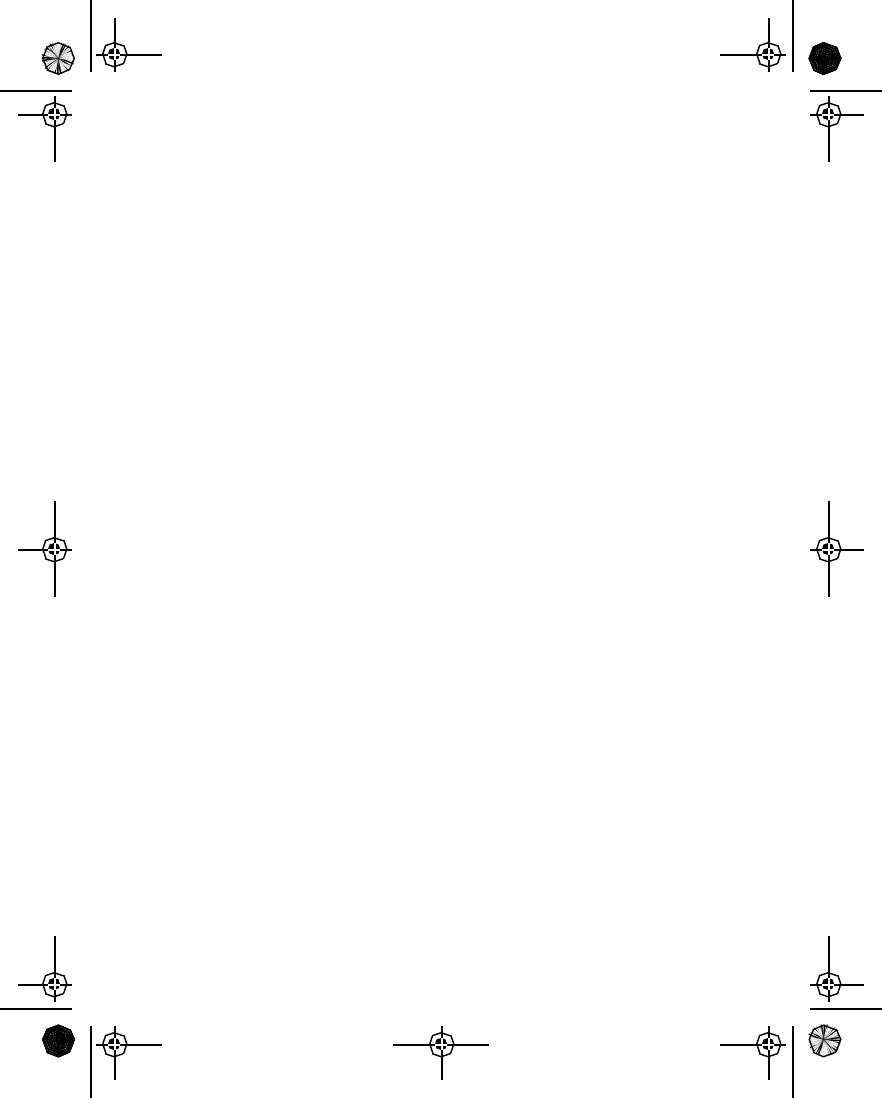
[ 125 ]
Reference information
the problem with the Product is not covered under the terms and
conditions of this limited warranty, the Consumer will be notified
and given an estimate of the charges the Consumer must pay to
have the Product repaired, with all shipping charges billed to the
Consumer. If the estimate is refused, the Product will be returned
freight collect. If the Product is returned after the expiration of
the limited warranty period, Nokia’s normal service policies shall
apply and the Consumer will be responsible for all shipping charges.
10 You (the Consumer) understand that the product may consist of
refurbished equipment that contains used components, some of
which have been reprocessed. The used components comply with
Product performance and reliability specifications.
11 ANY IMPLIED WARRANTY OF MERCHANTABILITY, OR FITNESS FOR A
PARTICULAR PURPOSE OR USE, SHALL BE LIMITED TO THE DURATION
OF THE FOREGOING LIMITED WRITTEN WARRANTY. OTHERWISE, THE
FOREGOING LIMITED WARRANTY IS THE CONSUMER’S SOLE AND
EXCLUSIVE REMEDY AND IS IN LIEU OF ALL OTHER WARRANTIES,
EXPRESS OR IMPLIED. NOKIA SHALL NOT BE LIABLE FOR SPECIAL,
INCIDENTAL, PUNITIVE OR CONSEQUENTIAL DAMAGES, INCLUDING
BUT NOT LIMITED TO LOSS OF ANTICIPATED BENEFITS OR PROFITS,
LOSS OF SAVINGS OR REVENUE, LOSS OF DATA, PUNITIVE DAMAGES,
LOSS OF USE OF THE PRODUCT OR ANY ASSOCIATED EQUIPMENT,
COST OF CAPITAL, COST OF ANY SUBSTITUTE EQUIPMENT OR
FACILITIES, DOWNTIME, THE CLAIMS OF ANY THIRD PARTIES,
INCLUDING CUSTOMERS, AND INJURY TO PROPERTY, RESULTING
FROM THE PURCHASE OR USE OF THE PRODUCT OR ARISING FROM
BREACH OF THE WARRANTY, BREACH OF CONTRACT, NEGLIGENCE,
STRICT TORT, OR ANY OTHER LEGAL OR EQUITABLE THEORY, EVEN IF
NOKIA KNEW OF THE LIKELIHOOD OF SUCH DAMAGES. NOKIA SHALL
NOT BE LIABLE FOR DELAY IN RENDERING SERVICE UNDER THE
LIMITED WARRANTY, OR LOSS OF USE DURING THE PERIOD THAT THE
PRODUCT IS BEING REPAIRED.
12 Some states do not allow limitation of how long an implied warranty
lasts, so the one year warranty limitation may not apply to you (the
EN1260.2_Sept_02.book Page 125 Friday, September 6, 2002 4:39 PM

[ 126 ]
Consumer). Some states do not allow the exclusion or limitation of
incidental and consequential damages, so certain of the above
limitations or exclusions may not apply to you (the Consumer). This
limited warranty gives the Consumer specific legal rights and the
Consumer may also have other rights which vary from state to state.
13 Nokia neither assumes nor authorizes any authorized service center
or any other person or entity to assume for it any other obligation or
liability beyond that which is expressly provided for in this limited
warranty including the provider or seller of any extended warranty or
service agreement.
14 This is the entire warranty between the Nokia and the Consumer, and
supersedes all prior and contemporaneous agreements or understandings,
oral or written, relating to the Product, and no representation,
promise or condition not contained herein shall modify these terms.
15 This limited warranty allocates the risk of failure of the Product
between the Consumer and Nokia. The allocation is recognized by
the Consumer and is reflected in the purchase price.
16 Any action or lawsuit for breach of warranty must be commenced
within eighteen (18) months following purchase of the Product.
17 Questions concerning this limited warranty may be directed to:
Nokia Inc.
Attn: Customer Service
7725 Woodland Center Blvd., Ste. 150
Tampa, FL 33614
Telephone: 1-888-NOKIA-2U (1-888-665-4228)
Facsimile: (813) 287-6612
TTY/TDD Users Only: 1-800-24-NOKIA (1-800-246-6542)
18 The limited warranty period for Nokia supplied attachments and
accessories is specifically defined within their own warranty cards
and packaging.
EN1260.2_Sept_02.book Page 126 Friday, September 6, 2002 4:39 PM
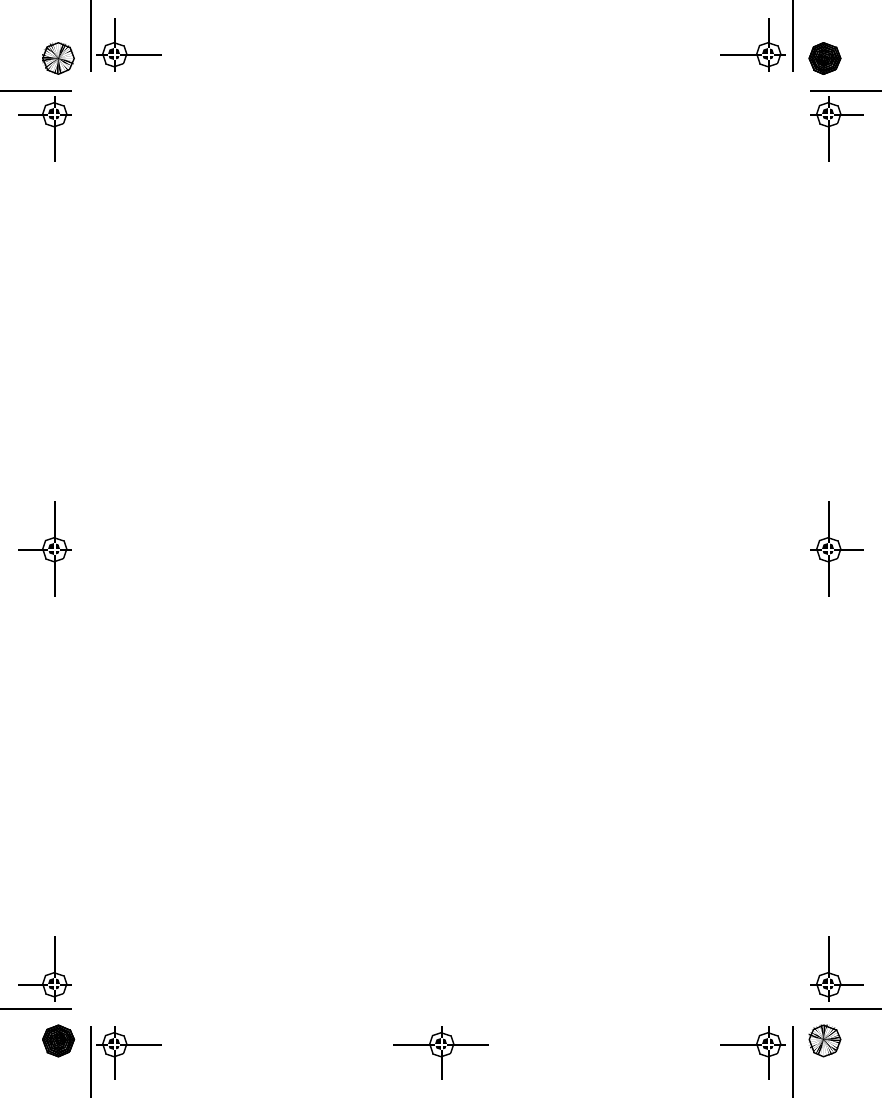
[ 127 ]
Reference information
Manufactured or sold under one or more of the following US patents:
5001372 5371481 5553125 5805084 5893060 6006114 6119002 6229996
5045973 5390223 5594797 5819165 5903839 6026161 6119003 6269331
5101175 5400949 5604921 5822366 5907823 6035194 6128509 6282373
5124672 5416435 5606548 5835858 5914796 6043760 6144243 6285888
5212834 5430740 5613235 5839101 5920826 6049796 6151485 6286122
5230091 5442521 5625274 5842141 5924026 6055439 6151507 6292668
5233634 5446364 5677620 5844884 5924038 6060193 6154457 6308084
5241284 5471655 5692032 5845219 5953665 6084962 6163609 6310609
5241583 5479476 5697074 5857151 5956625 6094587 6164547 6311054
5266782 5487084 5734683 5870683 5987406 6097961 6185295 6314166
5317283 5493255 5760568 5887262 5987639 6097964 6188909 6324412
5335362 5551067 5794142 5892475 5999523 6115617 6219560
Pending:
29158527 29158526
29158528 29158485
29158529 29158524
EN1260.2_Sept_02.book Page 127 Friday, September 6, 2002 4:39 PM
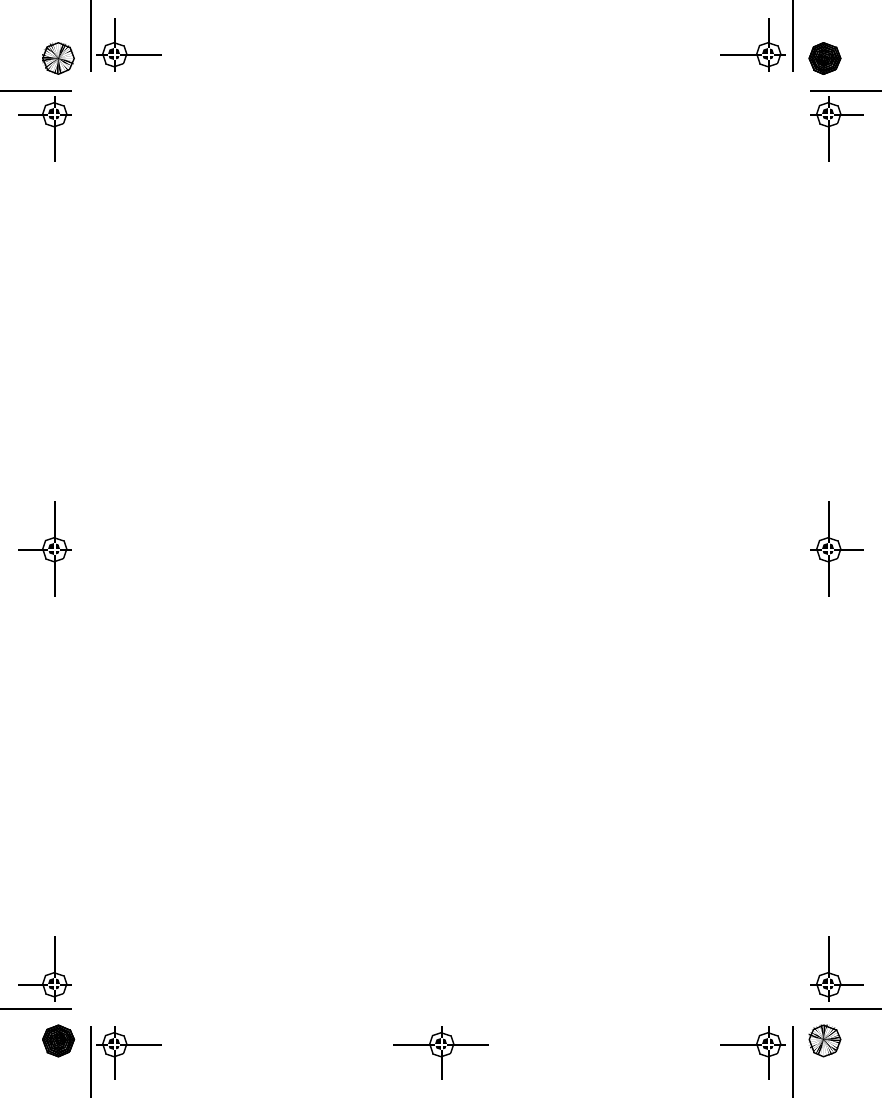
[ 128 ]
EN1260.2_Sept_02.book Page 128 Friday, September 6, 2002 4:39 PM
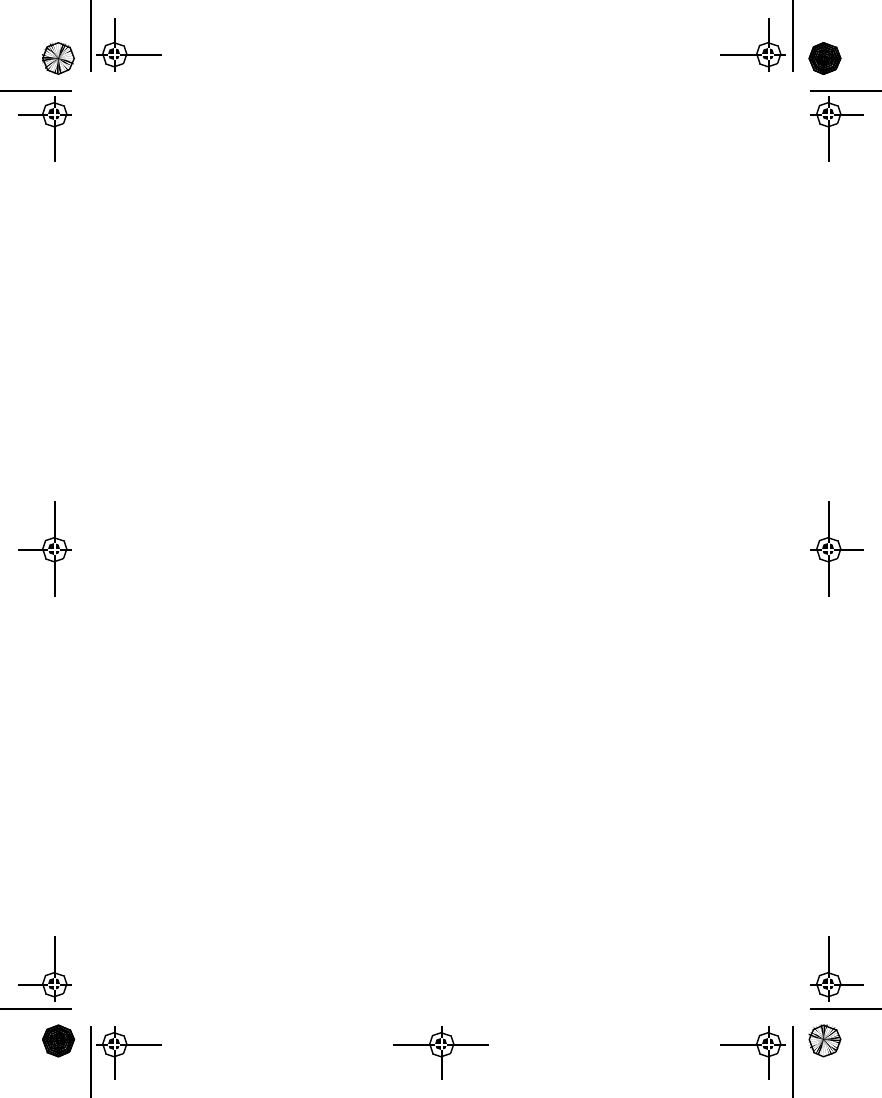
[ 129 ]
Appendix A Message from the CTIA
Appendix A
Message from the CTIA
(Cellular Telecommunications
& Internet Association)
to all users of mobile phones.
© 2001 Cellular Telecommunications & Internet Association. All Rights
Reserved.1250 Connecticut Avenue, NW Suite 800, Washington, DC 20036.
Phone: (202) 785-0081
EN1260.2_Sept_02.book Page 129 Friday, September 6, 2002 4:39 PM
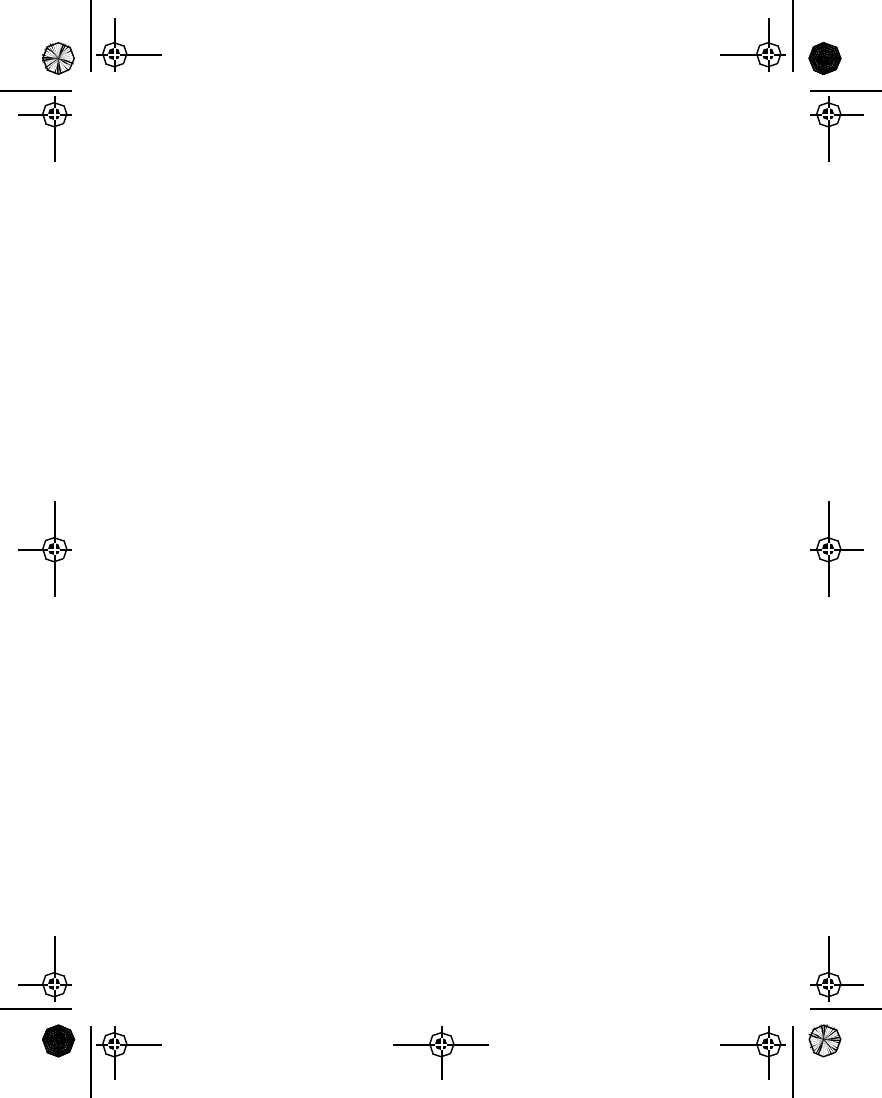
[ 130 ]
Safety is the most important call you will ever make.
A Guide to Safe and Responsible Wireless Phone Use
Tens of millions of people in the U.S. today take advantage of the unique
combination of convenience, safety and value delivered by the wireless telephone.
Quite simply, the wireless phone gives people the powerful ability to communicate
by voice--almost anywhere, anytime--with the boss, with a client, with the kids,
with emergency personnel or even with the police. Each year, Americans make
billions of calls from their wireless phones, and the numbers are rapidly growing.
But an important responsibility accompanies those benefits, one that every wireless
phone user must uphold. When driving a car, driving is your first responsibility. A
wireless phone can be an invaluable tool, but good judgment must be exercised at
all times while driving a motor vehicle--whether on the phone or not.
The basic lessons are ones we all learned as teenagers. Driving requires alertness,
caution and courtesy. It requires a heavy dose of basic common sense---keep your
head up, keep your eyes on the road, check your mirrors frequently and watch out
for other drivers. It requires obeying all traffic signs and signals and staying within
the speed limit. It means using seatbelts and requiring other passengers to do the
same.
But with wireless phone use, driving safely means a little more. This brochure is a
call to wireless phone users everywhere to make safety their first priority when
behind the wheel of a car. Wireless telecommunications is keeping us in touch,
simplifying our lives, protecting us in emergencies and providing opportunities to
help others in need.
When it comes to the use of wireless phones, safety is your most important call.
Wireless Phone "Safety Tips"
Below are safety tips to follow while driving and using a wireless phone which
should be easy to remember.
1Get to know your wireless phone and its features such as speed dial and redial.
Carefully read your instruction manual and learn to take advantage of valuable
features most phones offer, including automatic redial and memory. Also, work
to memorize the phone keypad so you can use the speed dial function without
taking your attention off the road.
2When available, use a hands free device. A number of hands free wireless phone
accessories are readily available today. Whether you choose an installed
mounted device for your wireless phone or a speaker phone accessory, take
advantage of these devices if available to you.
3Position your wireless phone within easy reach. Make sure you place your
wireless phone within easy reach and where you can grab it without removing
your eyes from the road. If you get an incoming call at an inconvenient time, if
possible, let your voice mail answer it for you.
4Suspend conversations during hazardous driving conditions or situations. Let
the person you are speaking with know you are driving; if necessary, suspend
EN1260.2_Sept_02.book Page 130 Friday, September 6, 2002 4:39 PM
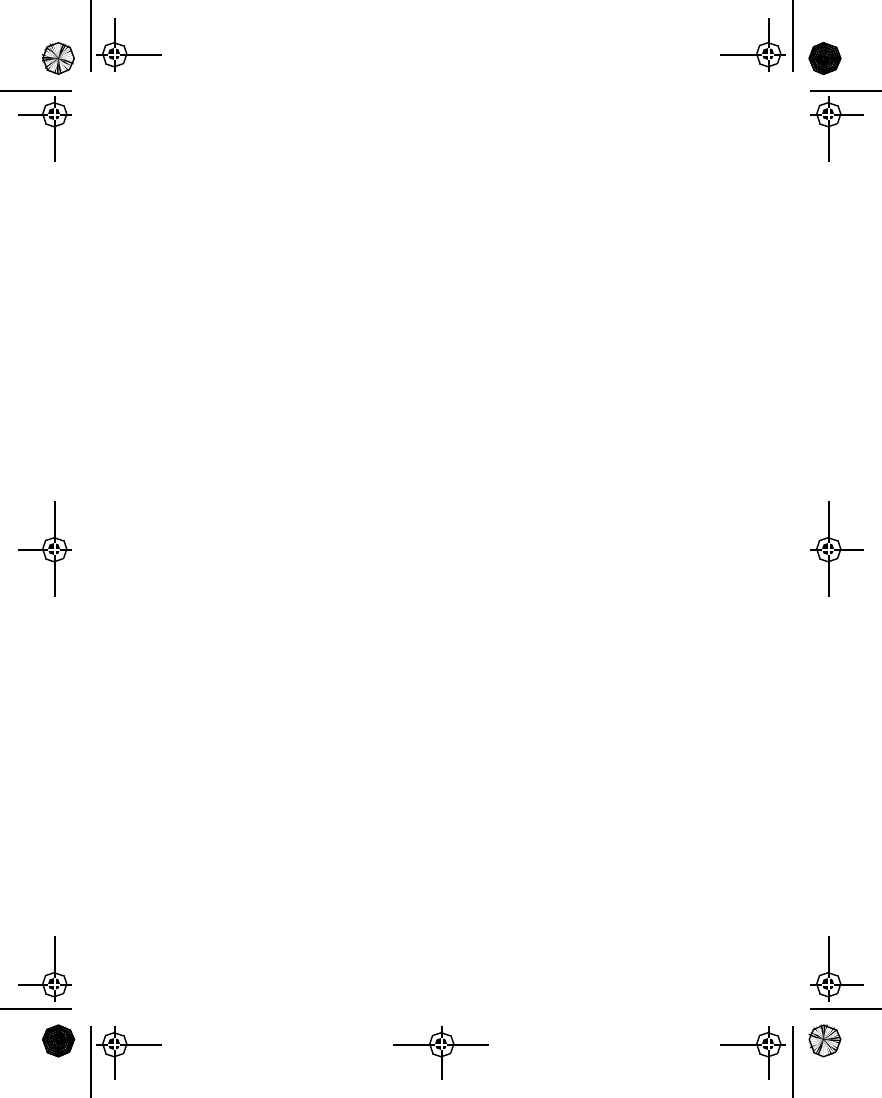
[ 131 ]
Appendix A Message from the CTIA
the call in heavy traffic or hazardous weather conditions. Rain, sleet, snow and
ice can be hazardous, but so is heavy traffic. As a driver, your first responsibility
is to pay attention to the road.
5Do not take notes or look up phone numbers while driving. If you are reading
an address book or business card, or writing a "to do" list while driving a car,
you are not watching where you are going. It’s common sense. Don’t get caught
in a dangerous situation because you are reading or writing and not paying
attention to the road or nearby vehicles.
6Dial sensibly and assess the traffic; if possible, place calls when you are not
moving or before pulling into traffic. Try to plan your calls before you begin
your trip or attempt to coincide your calls with times you may be stopped at a
stop sign, red light or otherwise stationary. But if you need to dial while driving,
follow this simple tip--dial only a few numbers, check the road and your
mirrors, then continue.
7Do not engage in stressful or emotional conversations that may be distracting.
Stressful or emotional conversations and driving do not mix--they are
distracting and even dangerous when you are behind the wheel of a car. Make
people you are talking with aware you are driving and if necessary, suspend
conversations which have the potential to divert your attention from the road.
8Use your wireless phone to call for help. Your wireless phone is one of the
greatest tools you can own to protect yourself and your family in dangerous
situations--with your phone at your side, help is only three numbers away. Dial
9-1-1 or other local emergency number in the case of fire, traffic accident, road
hazard or medical emergency. Remember, it is a free call on your wireless
phone!
9Use your wireless phone to help others in emergencies. Your wireless phone
provides you a perfect opportunity to be a "Good Samaritan" in your
community. If you see an auto accident, crime in progress or other serious
emergency where lives are in danger, call 9-1-1 or other local emergency
number, as you would want others to do for you.
10 Call roadside assistance or a special wireless non-emergency assistance number
when necessary. Certain situations you encounter while driving may require
attention, but are not urgent enough to merit a call for emergency services. But
you still can use your wireless phone to lend a hand. If you see a broken-down
vehicle posing no serious hazard, a broken traffic signal, a minor traffic accident
where no one appears injured or a vehicle you know to be stolen, call roadside
assistance or other special non-emergency wireless number.
Careless, distracted individuals and people driving irresponsibly represent a hazard
to everyone on the road. Since 1984, the Cellular Telecommunications Industry
Association and the wireless industry have conducted educational outreach to
inform wireless phone users of their responsibilities as safe drivers and good
citizens. As we approach a new century, more and more of us will take advantage
of the benefits of wireless telephones. And, as we take to the roads, we all have a
responsibility to drive safely.
The wireless industry reminds you to use your phone safely when driving.
EN1260.2_Sept_02.book Page 131 Friday, September 6, 2002 4:39 PM

[ 132 ]
For more information, please call 1-888-901-SAFE.
For updates: http://www.wow-com.com/consumer/issues/driving/
articles.cfm?ID=85
© 2001 Cellular Telecommunications & Internet Association. All Rights
Reserved.1250 Connecticut Avenue, NW Suite 800, Washington, DC 20036. Phone:
(202) 785-0081
EN1260.2_Sept_02.book Page 132 Friday, September 6, 2002 4:39 PM
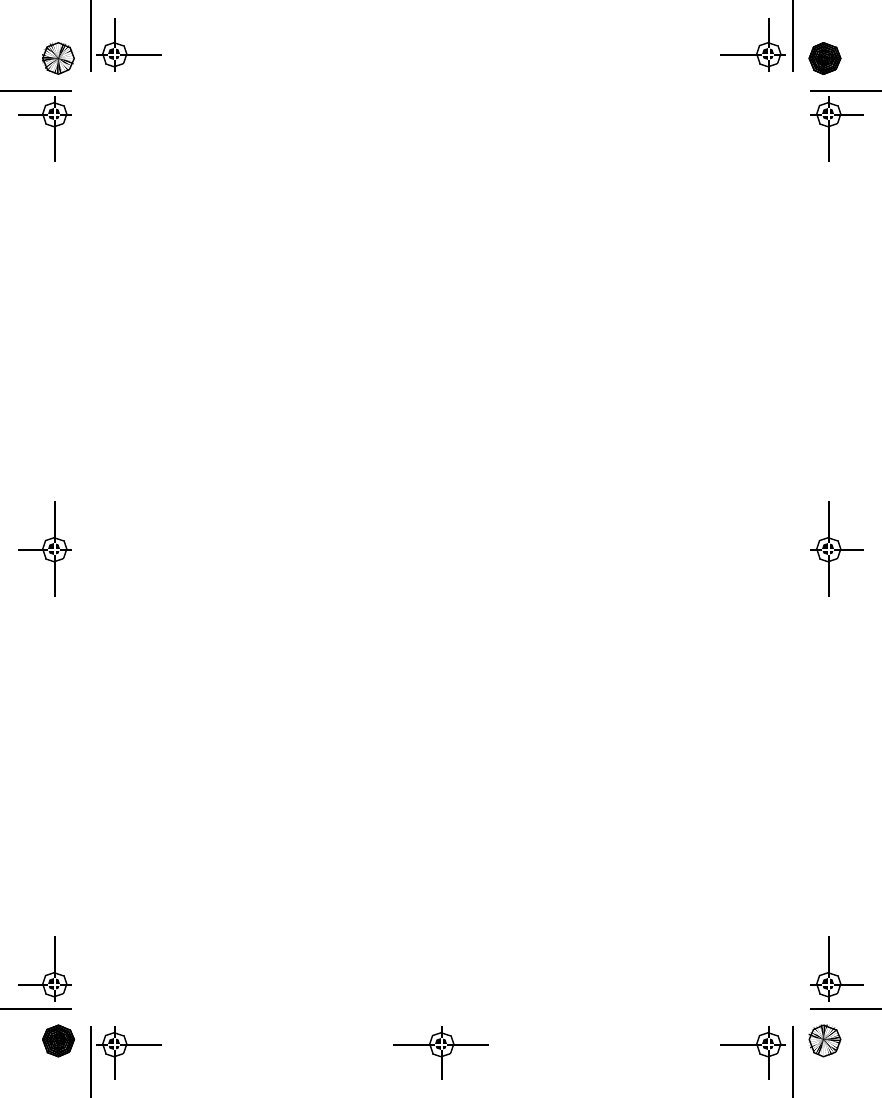
[ 133 ]
Appendix B Message from the FDA
Appendix B
Message from the FDA
(U.S. Food and Drug
Administration)
to all users of mobile phones.
July 18, 2001......... For updates: http://www.fda.gov/cdrh/phones
EN1260.2_Sept_02.book Page 133 Friday, September 6, 2002 4:39 PM

[ 134 ]
Consumer Update on Wireless Phones
U.S. Food and Drug Administration
1. Do wireless phones pose a health hazard?
The available scientific evidence does not show that any health problems are associated with
using wireless phones. There is no proof, however, that wireless phones are absolutely safe.
Wireless phones emit low levels of radiofrequency energy (RF) in the microwave range while
being used. They also emit very low levels of RF when in the stand-by mode. Whereas high
levels of RF can produce health effects (by heating tissue), exposure to low level RF that does
not produce heating effects causes no known adverse health effects. Many studies of low level
RF exposures have not found any biological effects. Some studies have suggested that some
biological effects may occur, but such findings have not been confirmed by additional research.
In some cases, other researchers have had difficulty in reproducing those studies, or in
determining the reasons for inconsistent results.
2. What is FDA's role concerning the safety of wireless phones?
Under the law, FDA does not review the safety of radiation-emitting consumer products such
as wireless phones before they can be sold, as it does with new drugs or medical devices.
However, the agency has authority to take action if wireless phones are shown to emit
radiofrequency energy (RF) at a level that is hazardous to the user. In such a case, FDA could
require the manufacturers of wireless phones to notify users of the health hazard and to repair,
replace or recall the phones so that the hazard no longer exists.
Although the existing scientific data do not justify FDA regulatory actions, FDA has urged the
wireless phone industry to take a number of steps, including the following:
•Support needed research into possible biological effects of RF of the type emitted by
wireless phones;
•Design wireless phones in a way that minimizes any RF exposure to the user that is not
necessary for device function; and
•Cooperate in providing users of wireless phones with the best possible information on
possible effects of wireless phone use on human health.
FDA belongs to an interagency working group of the federal agencies that have responsibility
for different aspects of RF safety to ensure coordinated efforts at the federal level. The
following agencies belong to this working group:
•National Institute for Occupational Safety and Health
•Environmental Protection Agency
•Federal Communications Commission
•Occupational Safety and Health Administration
•National Telecommunications and Information Administration
The National Institutes of Health participates in some interagency working group activities, as
well.
FDA shares regulatory responsibilities for wireless phones with the Federal Communications
Commission (FCC). All phones that are sold in the United States must comply with FCC safety
guidelines that limit RF exposure. FCC relies on FDA and other health agencies for safety
questions about wireless phones. FCC also regulates the base stations that the wireless phone
networks rely upon. While these base stations operate at higher power than do the wireless
phones themselves, the RF exposures that people get from these base stations are typically
thousands of times lower than those they can get from wireless phones. Base stations are thus
not the subject of the safety questions discussed in this document.
EN1260.2_Sept_02.book Page 134 Friday, September 6, 2002 4:39 PM
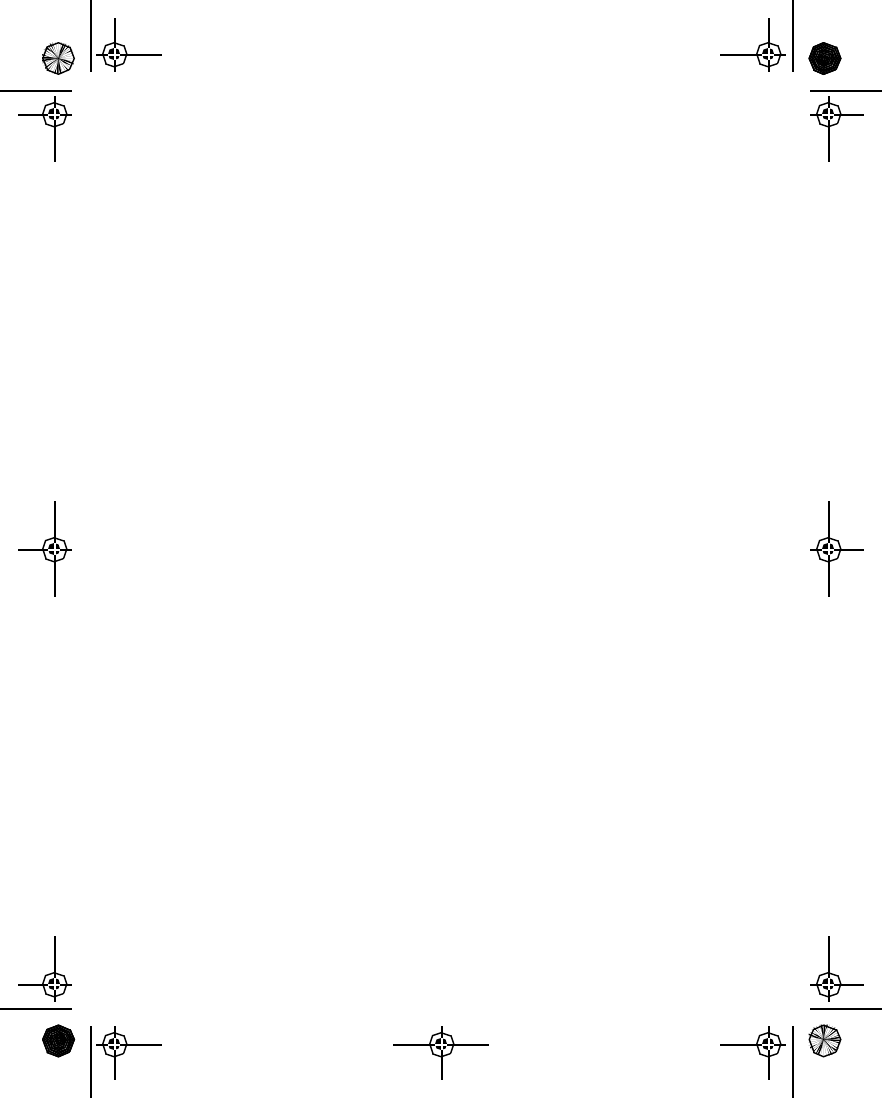
[ 135 ]
Appendix B Message from the FDA
3. What kinds of phones are the subject of this update?
The term wireless phone refers here to hand-held wireless phones with built-in antennas, often
called cell mobile or PCS phones. These types of wireless phones can expose the user to
measurable radiofrequency energy (RF) because of the short distance between the phone and
the user’s head. These RF exposures are limited by Federal Communications Commission
safety guidelines that were developed with the advice of FDA and other federal health and
safety agencies. When the phone is located at greater distances from the user, the exposure to
RF is drastically lower because a person's RF exposure decreases rapidly with increasing
distance from the source. The so-called cordless phones; which have a base unit connected to
the telephone wiring in a house, typically operate at far lower power levels, and thus produce
RF exposures far below the FCC safety limits.
4. What are the results of the research done already?
The research done thus far has produced conflicting results, and many studies have suffered
from flaws in their research methods. Animal experiments investigating the effects of
radiofrequency energy (RF) exposures characteristic of wireless phones have yielded conflicting
results that often cannot be repeated in other laboratories. A few animal studies, however, have
suggested that low levels of RF could accelerate the development of cancer in laboratory
animals. However, many of the studies that showed increased tumor development used animals
that had been genetically engineered or treated with cancer-causing chemicals so as to be pre-
disposed to develop cancer in the absence of RF exposure. Other studies exposed the animals
to RF for up to 22 hours per day. These conditions are not similar to the conditions under which
people use wireless phones, so we don’t know with certainty what the results of such studies
mean for human health.
Three large epidemiology studies have been published since December 2000. Between them, the
studies investigated any possible association between the use of wireless phones and primary
brain cancer, glioma, meningioma, or acoustic neuroma, tumors of the brain or salivary gland,
leukemia, or other cancers. None of the studies demonstrated the existence of any harmful
health effects from wireless phone RF exposures. However, none of the studies can answer
questions about long-term exposures, since the average period of phone use in these studies was
around three years.
5.What research is needed to decide whether RF exposure from wireless
phones poses a health risk?
A combination of laboratory studies and epidemiological studies of people actually using
wireless phones would provide some of the data that are needed. Lifetime animal exposure
studies could be completed in a few years. However, very large numbers of animals would be
needed to provide reliable proof of a cancer promoting effect if one exists. Epidemiological
studies can provide data that is directly applicable to human populations, but 10 or more years
follow-up may be needed to provide answers about some health effects, such as cancer. This is
because the interval between the time of exposure to a cancer-causing agent and the time
tumors develop - if they do - may be many, many years. The interpretation of epidemiological
studies is hampered by difficulties in measuring actual RF exposure during day-to-day use of
wireless phones. Many factors affect this measurement, such as the angle at which the phone is
held, or which model of phone is used.
6. What is FDA doing to find out more about the possible health effects
of wireless phone RF?
FDA is working with the U.S. National Toxicology Program and with groups of investigators
around the world to ensure that high priority animal studies are conducted to address
important questions about the effects of exposure to radiofrequency energy (RF).
EN1260.2_Sept_02.book Page 135 Friday, September 6, 2002 4:39 PM
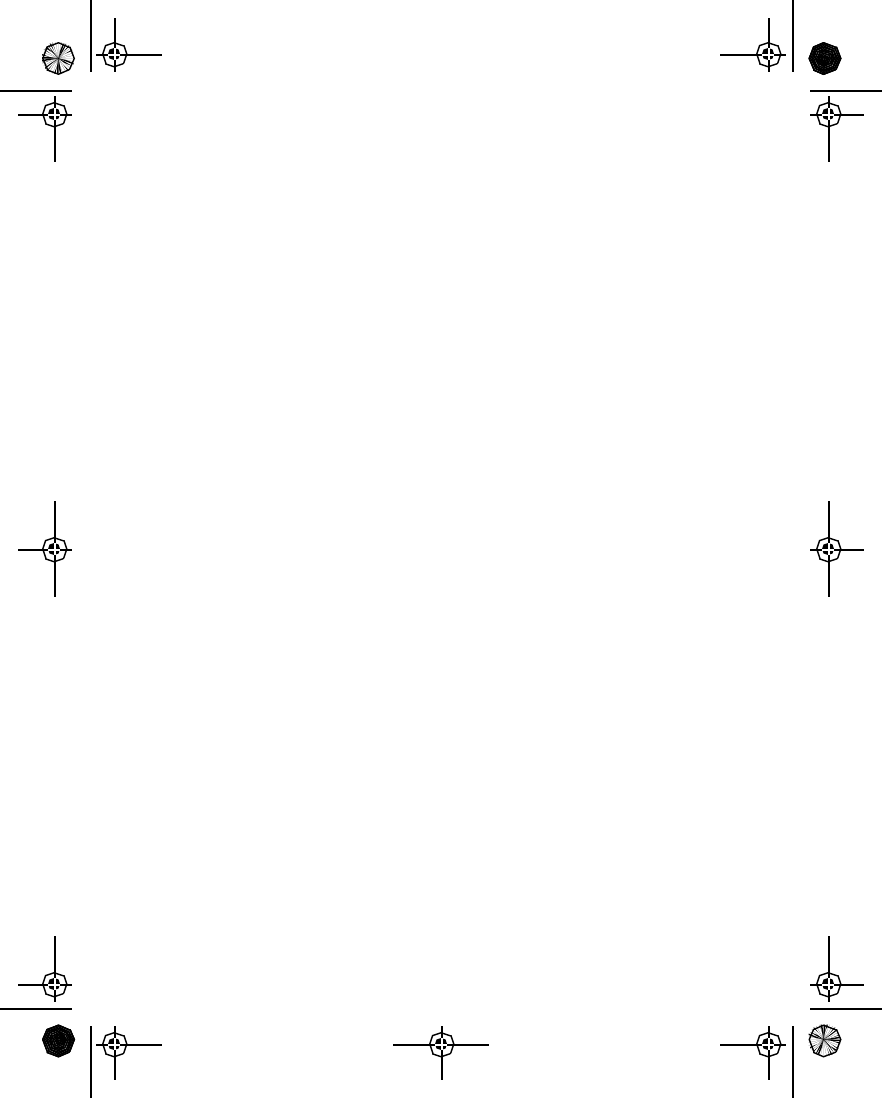
[ 136 ]
FDA has been a leading participant in the World Health Organization International
Electromagnetic Fields (EMF) Project since its inception in 1996. An influential result of this
work has been the development of a detailed agenda of research needs that has driven the
establishment of new research programs around the world. The Project has also helped develop
a series of public information documents on EMF issues.
FDA and the Cellular Telecommunications & Internet Association (CTIA) have a formal
Cooperative Research and Development Agreement (CRADA) to do research on wireless
phone safety. FDA provides the scientific oversight, obtaining input from experts in
government, industry, and academic organizations. CTIA-funded research is conducted
through contracts to independent investigators. The initial research will include both
laboratory studies and studies of wireless phone users. The CRADA will also include a broad
assessment of additional research needs in the context of the latest research developments
around the world.
7. How can I find out how much radiofrequency energy exposure I can
get by using my wireless phone?
All phones sold in the United States must comply with Federal Communications Commission
(FCC) guidelines that limit radiofrequency energy (RF) exposures. FCC established these
guidelines in consultation with FDA and the other federal health and safety agencies. The FCC
limit for RF exposure from wireless telephones is set at a Specific Absorption Rate (SAR) of 1.6
watts per kilogram (1.6 W/kg). The FCC limit is consistent with the safety standards developed
by the Institute of Electrical and Electronic Engineering (IEEE) and the National Council on
Radiation Protection and Measurement. The exposure limit takes into consideration the body’s
ability to remove heat from the tissues that absorb energy from the wireless phone and is set
well below levels known to have effects.
Manufacturers of wireless phones must report the RF exposure level for each model of phone
to the FCC. The FCC website (http://www.fcc.gov/oet/rfsafety) gives directions for locating the
FCC identification number on your phone so you can find your phone’s RF exposure level in
the online listing.
8. What has FDA done to measure the radiofrequency energy coming
from wireless phones?
The Institute of Electrical and Electronic Engineers (IEEE) is developing a technical standard
for measuring the radiofrequency energy (RF) exposure from wireless phones and other
wireless handsets with the participation and leadership of FDA scientists and engineers. The
standard, Recommended Practice for Determining the Spatial-Peak Specific Absorption Rate
(SAR) in the Human Body Due to Wireless Communications Devices: Experimental
Techniques, sets forth the first consistent test methodology for measuring the rate at which RF
is deposited in the heads of wireless phone users. The test method uses a tissue-simulating
model of the human head. Standardized SAR test methodology is expected to greatly improve
the consistency of measurements made at different laboratories on the same phone. SAR is the
measurement of the amount of energy absorbed in tissue, either by the whole body or a small
part of the body. It is measured in watts/kg (or milliwatts/g) of matter. This measurement is
used to determine whether a wireless phone complies with safety guidelines.
9. What steps can I take to reduce my exposure to radiofrequency
energy from my wireless phone?
If there is a risk from these products--and at this point we do not know that there is--it is
probably very small. But if you are concerned about avoiding even potential risks, you can take
a few simple steps to minimize your exposure to radiofrequency energy (RF). Since time is a key
factor in how much exposure a person receives, reducing the amount of time spent using a
wireless phone will reduce RF exposure.
EN1260.2_Sept_02.book Page 136 Friday, September 6, 2002 4:39 PM
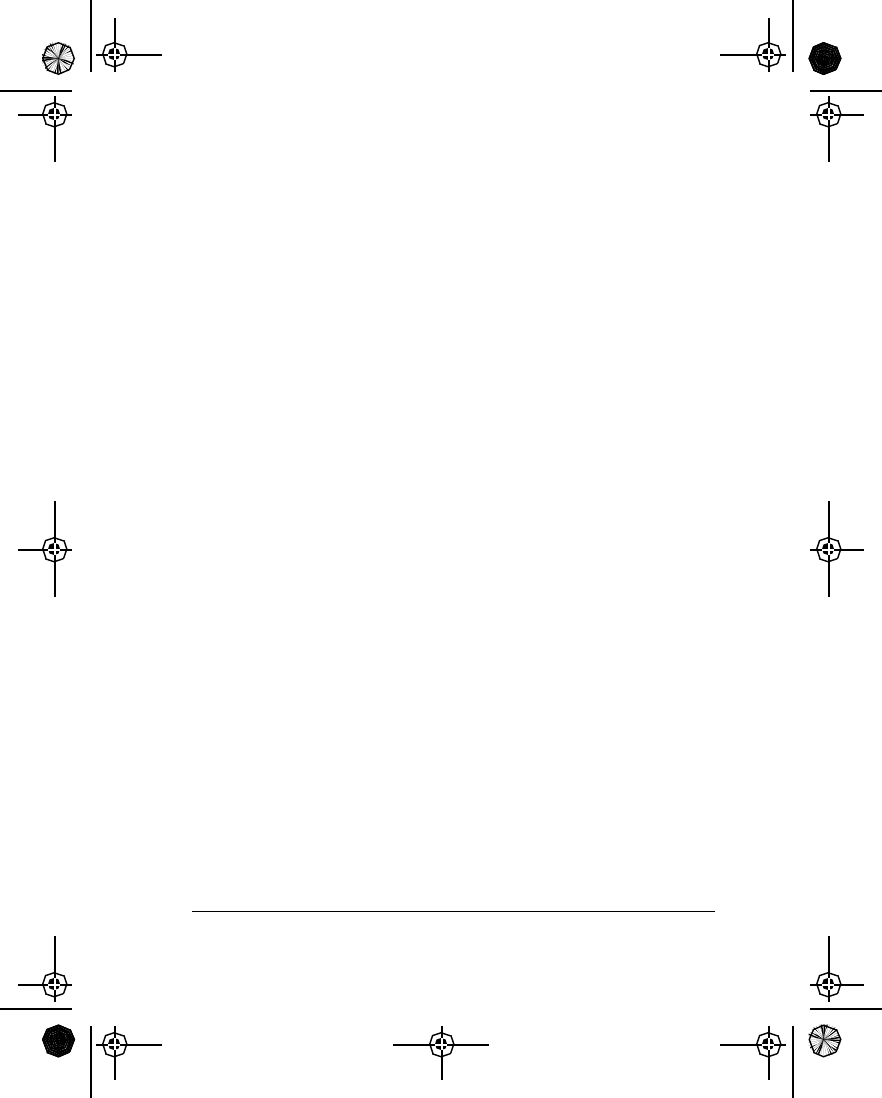
[ 137 ]
Appendix B Message from the FDA
If you must conduct extended conversations by wireless phone every day, you could place
more distance between your body and the source of the RF, since the exposure level drops off
dramatically with distance. For example, you could use a headset and carry the wireless phone
away from your body or use a wireless phone connected to a remote antenna.
Again, the scientific data do not demonstrate that wireless phones are harmful. But if you are
concerned about the RF exposure from these products, you can use measures like those
described above to reduce your RF exposure from wireless phone use.
10. What about children using wireless phones?
The scientific evidence does not show a danger to users of wireless phones, including children
and teenagers. If you want to take steps to lower exposure to radiofrequency energy (RF), the
measures described above would apply to children and teenagers using wireless phones.
Reducing the time of wireless phone use and increasing the distance between the user and the
RF source will reduce RF exposure.Some groups sponsored by other national governments
have advised that children be discouraged from using wireless phones at all. For example, the
government in the United Kingdom distributed leaflets containing such a recommendation in
December 2000. They noted that no evidence exists that using a wireless phone causes brain
tumors or other ill effects. Their recommendation to limit wireless phone use by children was
strictly precautionary; it was not based on scientific evidence that any health hazard exists.
11. What about wireless phone interference with medical equipment?
Radiofrequency energy (RF) from wireless phones can interact with some electronic devices.
For this reason, FDA helped develop a detailed test method to measure electromagnetic
interference (EMI) of implanted cardiac pacemakers and defibrillators from wireless
telephones. This test method is now part of a standard sponsored by the Association for the
Advancement of Medical instrumentation (AAMI). The final draft, a joint effort by FDA,
medical device manufacturers, and many other groups, was completed in late 2000. This
standard will allow manufacturers to ensure that cardiac pacemakers and defibrillators are safe
from wireless phone EMI. FDA has tested hearing aids for interference from handheld wireless
phones and helped develop a voluntary standard sponsored by the Institute of Electrical and
Electronic Engineers (IEEE). This standard specifies test methods and performance
requirements for hearing aids and wireless phones so that no interference occurs when a person
uses a compatible phone and a accompanied hearing aid at the same time. This standard was
approved by the IEEE in 2000.
FDA continues to monitor the use of wireless phones for possible interactions with other
medical devices. Should harmful interference be found to occur, FDA will conduct testing to
assess the interference and work to resolve the problem.
12. Where can I find additional information?
For additional information, please refer to the following resources:
•FDA web page on wireless phones
http://www.fda.gov/cdrh/phones/index.html
•Federal Communications Commission (FCC) RF Safety Program
http://www.fcc.gov/oet/rfsafety
•International Commission on Non-Ionizing Radiation Protection
http://www.icnirp.de
•World Health Organization (WHO) International EMF Project
http://www.who.int/emf
•National Radiological Protection Board (UK)
http://www.nrpb.org.uk/
July 18, 2001For updates: http://www.fda.gov/cdrh/phones
EN1260.2_Sept_02.book Page 137 Friday, September 6, 2002 4:39 PM

[ 138 ]
EN1260.2_Sept_02.book Page 138 Friday, September 6, 2002 4:39 PM

[ 139 ]
Index
A
accessibility
alternate formats 5
contact 5
features 15
loopset 15
web site 15
accessories
boom headset (HDB-5) 111
car kit (PPH-1) 114
carry case (CSM-6) 114
charger (ACP-12U) 109
charger (ACP-7U) 109
charger (ACP-8U) 109
charger (LCH-9) 110
headset (HDC-5) 111
headset (HDE-2) 111
mobile holder (MBC-6) 113
reference information 108
safety information 105
settings 63
spare battery charger (DDC-1)
110
accessory
TTY adapter 112
active call options 68
adapter
for TTY connection 112
alarm clock 85
phone off 86
set 85
snooze 85
turn off 86
antenna
contact 8
location 8
performance 8
proper position 8
automatic redial 76
B
back cover
attaching 9
removing 9
battery
charging 10
charging time 106
important information 11
initial charging 11
install 8
prolong life 11
reference information 105
remove 9
standby time 107
talk time 107
business cards 86
delete 87
receive 87
save 87
send 86
EN1260.2_Sept_02.book Page 139 Friday, September 6, 2002 4:39 PM

[ 140 ]
C
call duration
viewing 46
call forwarding 72
activate 73
feature codes 72
call log
about 42
clear lists 44
dialed calls 44
missed calls 43
options 42
received calls 43
call timers 45
clear timers 46
current call timer 46
call waiting 73
activate 74
answer 74
feature code 74
manage calls 74
storing the feature code 74
calls
answer 20
automatic redial 76
conference 70
duration of 46
end 19
forward 72
make 18
redial last 20
silence 20
speed dialing 77
touch tones 78
car charger 110
car kit 114
automatic answer 64
default profile 65
set the lights 64
carry case 114
change
1-touch dialing numbers 77
earpiece volume 20
letter case 31
message alert tone 62
phone book view 40
profile name 63
ringing tone 61
ringing volume 61
security code 82
time format 65
charge the battery 10
charger
ACP-12U 109
ACP-7U 109
ACP-8U 109
connecting 10
information 105
clear call lists 44
clock 65
alarm 85
automatic update 66
set the time 65
show/hide 67
EN1260.2_Sept_02.book Page 140 Friday, September 6, 2002 4:39 PM

[ 141 ]
time format 65
conference calls 70
contact Nokia 14
cover
attaching 9
removing 9
customer care 14
D
definition of terms 118
dialed calls
erasing 44
viewing 44
display language 65
download
ringing tones 87
user guide 5
E
e-mail messages 56
emergency calls
making 102
things to remember 102
with keypad locked 81
entering
e-mail addresses 38
names and numbers 38
text 30
erase
call lists 44
messages from folders 51
phone book entries 40
text messages 54
F
folders
about 50
archive 51
erase messages from 51
inbox 50
outbox 51
four-way scrolling 33
frequently asked questions 115
G
games 93
Pairs II 95
Snake II 94
Space Impact 94
glossary 118
H
headset
connect 12
HDB-5 111
HDC-5 111
HDE-2 111
make and answer calls 12
hearing impaired solutions 15
help text 23
EN1260.2_Sept_02.book Page 141 Friday, September 6, 2002 4:39 PM
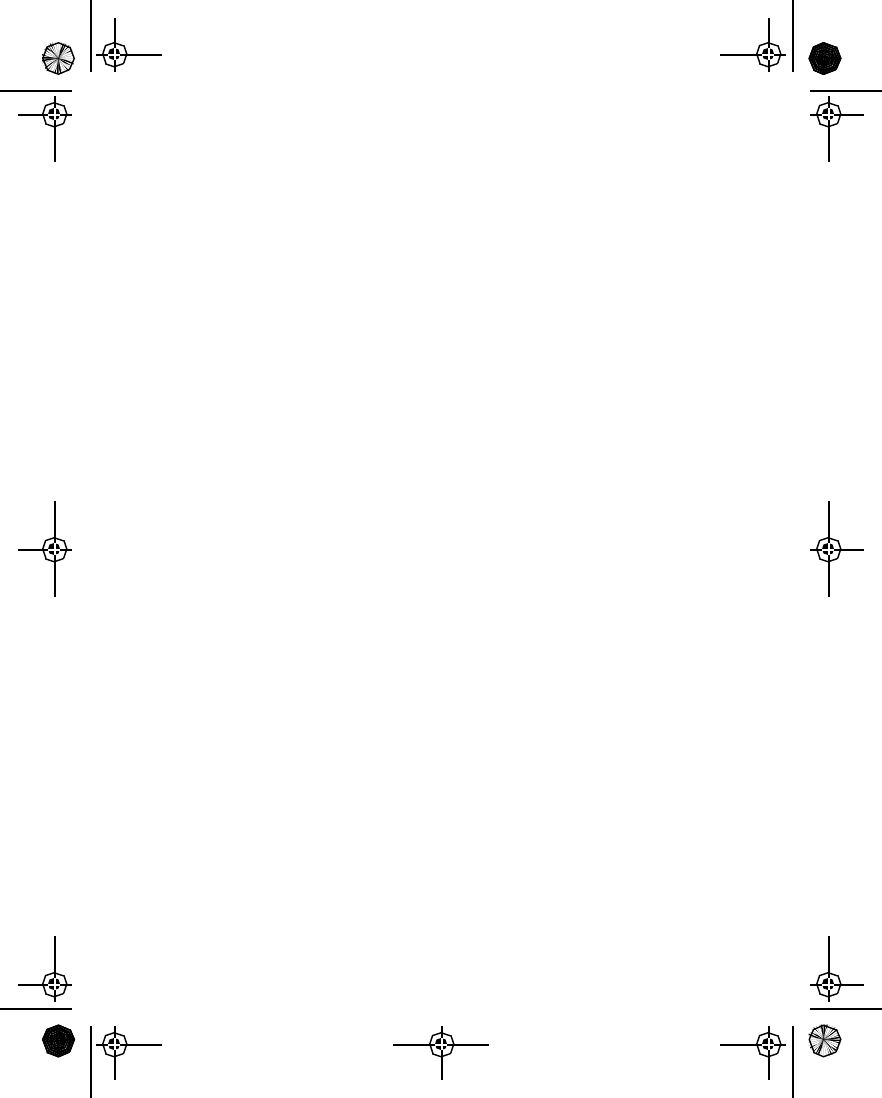
[ 142 ]
I
icons 22
illustrated view
antenna 8
battery install 8
battery removal 9
connect the charger 10
headset connection 12
phone 7
power key 18
in-call options 68
in-phone help 23
international calls
prefix 78
K
Keyguard 81
keypad
illustrated view 7
L
label 14
language setting 65
letters
uppercase and lowercase 31
lithium ion battery 108
lock/unlock the keypad 81
loopset 15
how it works 16
set for use 64
M
memory
phone book 41
text message 54
menu shortcuts
about 24
list of 25
menu tips 25
menus 24
messages
alert tone 62
check voice mail 47
e-mail 56
picture 54
read 52
text 51
text entry 30
write and send 52
missed calls
erasing 44
viewing 43
mobile holder 113
N
network search 80
network services 6
Nokia
accessories 108
customer care center 14
warranty 122
EN1260.2_Sept_02.book Page 142 Friday, September 6, 2002 4:39 PM

[ 143 ]
O
one-touch dialing 77
P
personalization 59
phone
illustrated 7
menus 24
register 6
switch on/off 18
warranty 122
phone book
enter e-mail addresses 38
erase entries 40
memory status 41
menu 29
menu options 29
new entry 38
quick access 19
scrolling view 40
picture messages 54
power 18
predictive text 34
turn off 35
turn on 34
prepaid 89
add money to account 90
check balance 90
saving access numbers 91
profiles
accessory settings 63
customize 60
selecting 60
punctuation 33
R
received calls
erasing 44
viewing 43
reference information 96
ringing
options 60
tone 61
volume 61
ringing tones
change 61
download 87
receiving 88
save 88
S
safety guidelines 1
save
e-mail addresses 38
names and numbers 38
ringing tones 88
text messages 51
voice mailbox number 48
scroll keys 23
search for network 80
security code 82
EN1260.2_Sept_02.book Page 143 Friday, September 6, 2002 4:39 PM
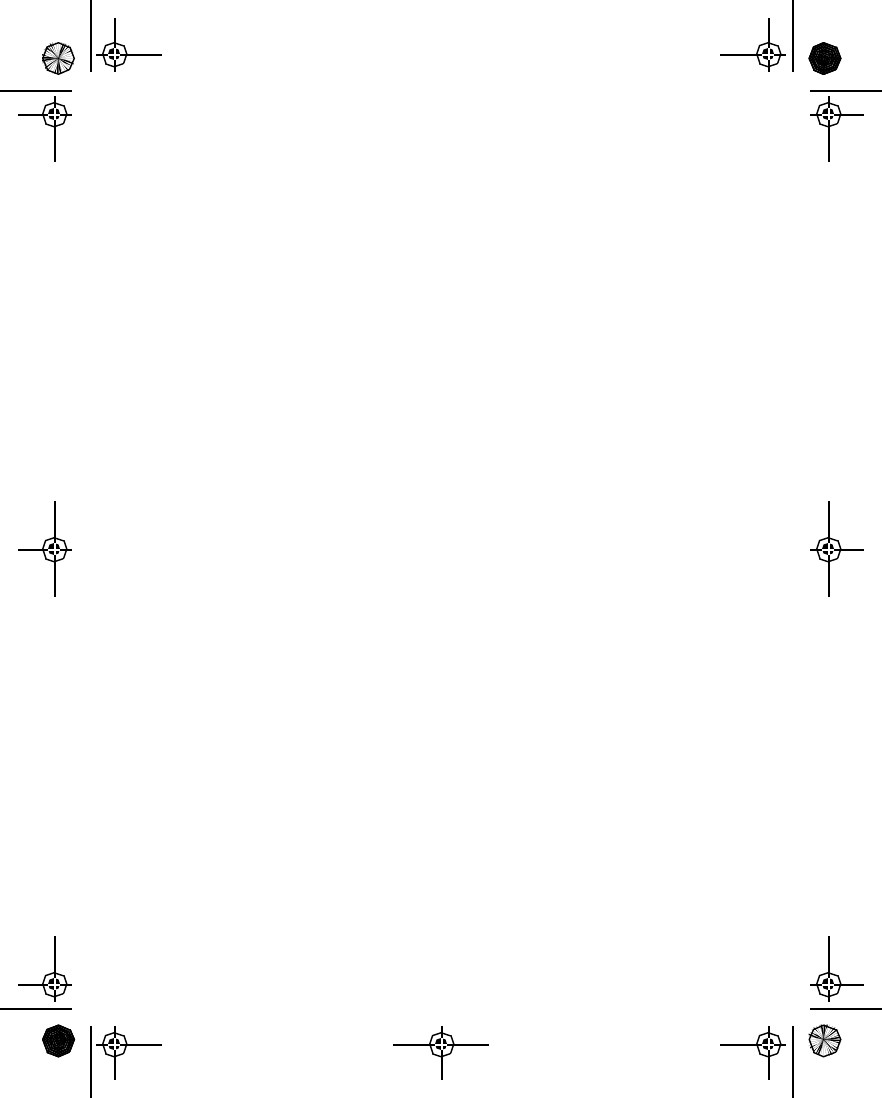
[ 144 ]
service provider
signing up 6
special characters
available 33
four-way scrolling 33
standby time 107
start screen 20
strings, touch tone 79
symbols 33
T
talk time 107
text messages 51
length 49
recipients 49
time 65
automatic update 66
select the format 65
set the clock 66
timers
check 45
clear 46
current call 46
touch tones
length 79
manual 78
sending 79
setting 78
storing 79
storing with numbers 79
troubleshooting 121
TTY 16
TTY adapter 112
TTY communication 112
turn the phone on/off 18
U
unlock the keypad 81
user guide
interactive 5
updates 5
V
view
call duration 45
clock on start screen 67
dialed calls 44
missed calls 43
picture messages 55
received calls 43
received messages 52
special characters 33
voice mail 47
listen to messages 48
messages 47
save number 48
volume
earpiece 20
keypad tones 62
ringing 61
W
warning tones 63
EN1260.2_Sept_02.book Page 144 Friday, September 6, 2002 4:39 PM

[ 145 ]
warranty 122
web sites
accessibility information 15
register your phone 6
user guides 5
write and send a message 52
EN1260.2_Sept_02.book Page 145 Friday, September 6, 2002 4:39 PM
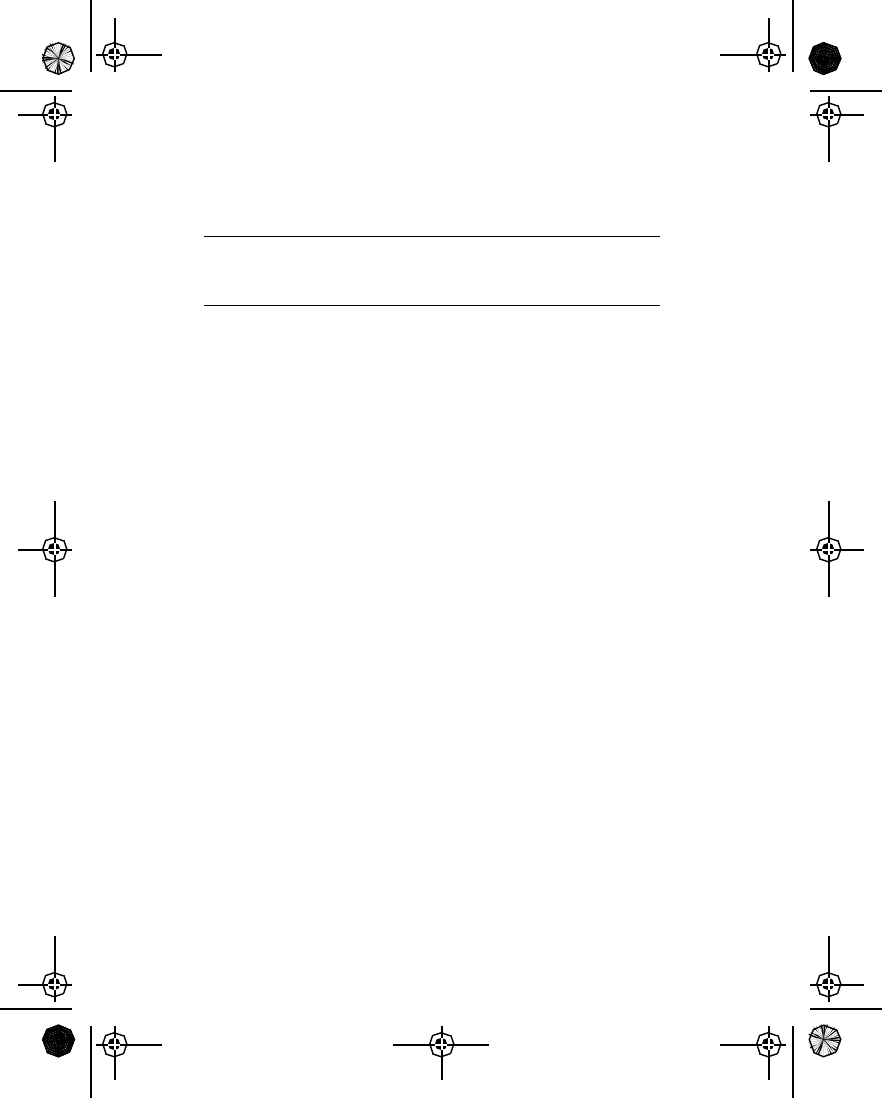
[ 146 ]
Para obtener un manual del usuario en español favor de
llamar o enviar un fax al teléfono 1-888-NOKIA-2U,
fax 813-249-9619.
EN1260.2_Sept_02.book Page 146 Friday, September 6, 2002 4:39 PM